Form 6-K ANGLOGOLD ASHANTI LTD For: Apr 08

UNITED STATES
SECURITIES AND EXCHANGE COMMISSION
WASHINGTON, DC 20549
FORM 6-K
REPORT OF FOREIGN PRIVATE ISSUER
PURSUANT TO RULE 13a-16 OR 15d-16 OF
THE SECURITIES EXCHANGE ACT OF 1934
Report on Form 6-K dated March 31, 2015
Commission File Number 1-14846
AngloGold Ashanti Limited
(Name of registrant)
76 Jeppe Street
Newtown, 2001
(P.O. Box 62117, Marshalltown, 2107)
South Africa
(Address of principal executive offices)
Indicate by check mark whether the registrant files or will file annual reports under cover of Form
20-F or Form 40-F.
20-F or Form 40-F.
Form 20-F X Form 40-F
Indicate by check mark if the registrant is submitting the Form 6-K in paper as permitted by
Regulation S-T Rule 101(b)(1):
Regulation S-T Rule 101(b)(1):
Yes
No X
Indicate by check mark if the registrant is submitting the Form 6-K in paper as permitted by
Regulation S-T Rule 101(b)(7):
Regulation S-T Rule 101(b)(7):
Yes
No X
Indicate by check mark whether the registrant by furnishing the information contained in this Form
is also thereby furnishing the information to the Commission pursuant to Rule 12g3-2(b) under the
Securities Exchange Act of 1934.
is also thereby furnishing the information to the Commission pursuant to Rule 12g3-2(b) under the
Securities Exchange Act of 1934.
Yes
No X
Enclosure: ANGLOGOLD ASHANTI INTEGRATED REPORT FOR THE YEAR ENDED
DECEMBER 31, 2014

INTEGRATED
REPORT
REPORT
2014
A TRULY
GLOBAL
PRODUCER OF GOLD

OUR
MISSION
To create value for our shareholders,
our employees and our business and
social partners through safely and
responsibly exploring, mining and
marketing our products. Our primary
focus is gold, but we will pursue
value creating opportunities in other
minerals where we can leverage our
existing assets, skills and experience
to enhance the delivery of value.

OUR VISION
OUR VALUES
Safety is our first value.
We place people first and correspondingly put the highest priority on safe and healthy practices and systems of work. We are responsible for seeking out new and innovative ways to prevent injury and illness in our business and to ensure that our workplaces are free of occupational injury and illness. We live each day for each other and use our collective commitment, talents, resources and systems to deliver on our most important commitment .... to care.
We treat each other with dignity and respect.
We believe that individuals who are treated with respect and who are entrusted to take responsibility, respond by giving their best. We seek to preserve people’s dignity, their sense of self-worth in all our interactions, respecting them for who they are and valuing the unique contribution that they can make to our business success. We are honest with ourselves and others, and we deal ethically with all of our business and social partners.
We value diversity.
We aim to be a global leader with the right people for the right jobs. We promote inclusion and team work, deriving benefit from the rich diversity of the cultures, ideas, experiences and skills that each employee brings to the business.
We are accountable for our actions and
undertake to deliver on our commitments.
undertake to deliver on our commitments.
We are focused on delivering results and we do what
we say we will do. We accept responsibility and hold
ourselves accountable for our work, our behaviour,
our ethics and our actions. We aim to deliver high
performance outcomes and undertake to deliver on
our commitments to our colleagues, business and
social partners, and our investors.
We want the communities and societies in
which we operate to be better off for
AngloGold Ashanti having been there.
which we operate to be better off for
AngloGold Ashanti having been there.
We uphold and promote fundamental human rights where we do business. We contribute to building productive, respectful and mutually beneficial partnerships in the communities in which we operate. We aim to leave a legacy of enduring value.
We respect the environment.
We are committed to continually improving our processes in order to prevent pollution, minimise waste, increase our carbon efficiency and make efficient use of natural resources. We will develop innovative solutions to mitigate environmental and climate risks.
To be the
LEADING
mining company
1
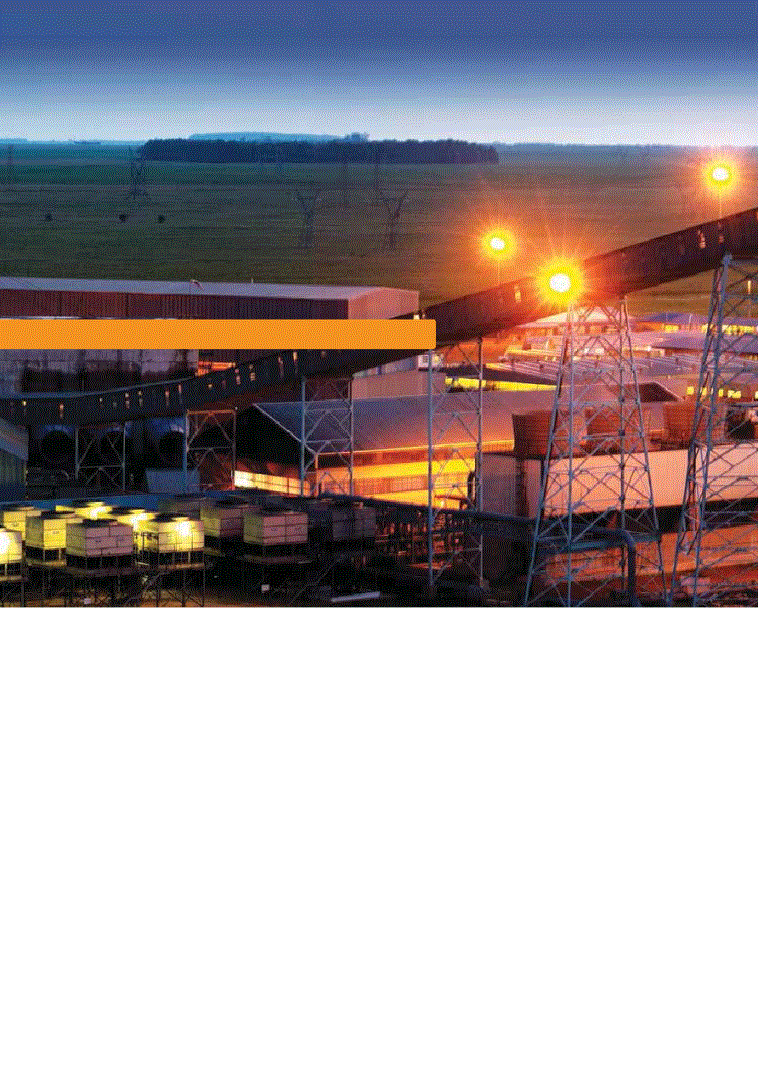
CONTENTS
P4-13
INTRODUCTION
4
Our 2014 suite of
reports
reports
5
Scope and boundary
of report
of report
7
Directors’ statement of
responsibility
responsibility
8
Chairman’s letter
P14-25
BUSINESS CONTEXT
15
Corporate profile
18
Business model
20
Timeline of corporate
activity
activity
22
Analysis of our external
environment
environment
P26-41
STRATEGY
27
Our strategy
28
Performance against
strategic objectives
strategic objectives
30
Managing and
mitigating risks
mitigating risks
37
Stakeholder
engagement and
materiality
engagement and
materiality
SUSTAINABLE
FREE CASH FLOW
IMPROVEMENTS
AND RETURNS
OUR STRATEGY
P42-63
LEADERSHIP
43
CEO’s review and
strategic outlook
strategic outlook
46
CFO’s report
51
Letter from Chairman
of the Audit and Risk
Committee
of the Audit and Risk
Committee
52
Board of directors
58
Executive management
60
Managing our human
resources
resources
INTEGRATED REPORT
2014
2
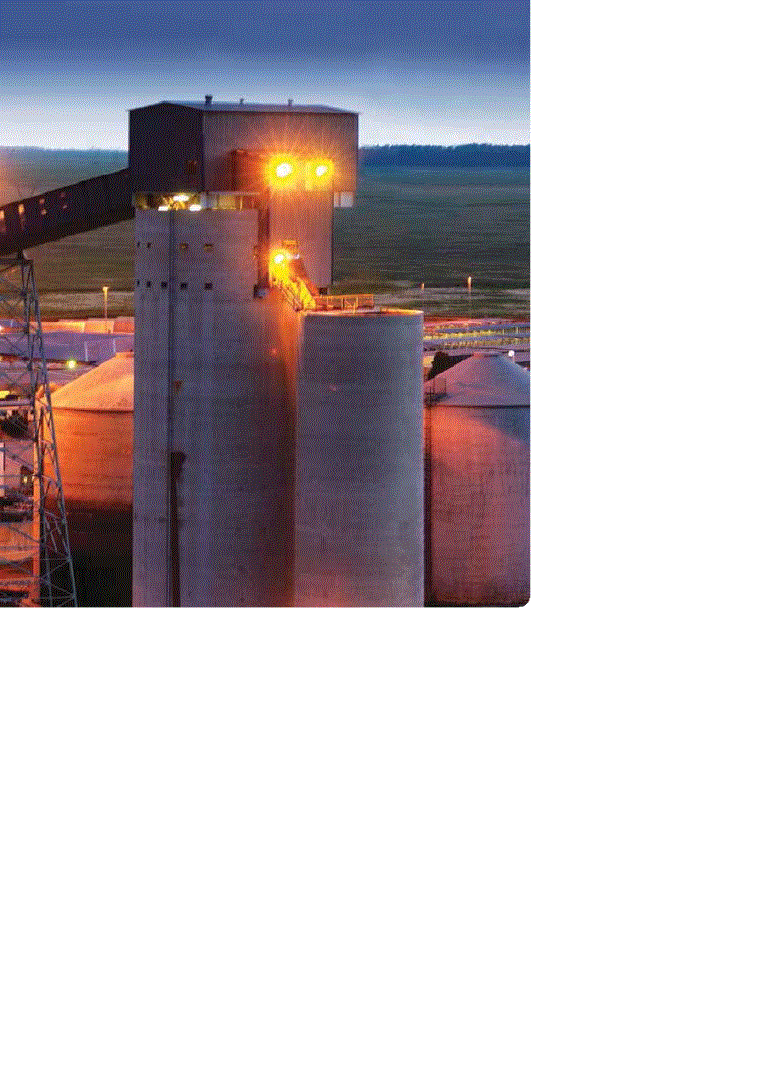
P137-145
SHAREHOLDER
AND CORPORATE
INFORMATION
AND CORPORATE
INFORMATION
138
Shareholder information
142
Glossary of terms and
abbreviations
abbreviations
144
Forward-looking
statements
statements
145
Administration
We strive to
generate free cash
flow and returns
to shareholders,
after funding
our investment
requirements and
servicing our debt.
generate free cash
flow and returns
to shareholders,
after funding
our investment
requirements and
servicing our debt.
P119-136
ACCOUNTABILITY
120
Corporate governance
130
Remuneration and
performance
performance
136
Approvals and
assurances
assurances
P64-118
PERFORMANCE REVIEW
65
Highlights of the year
66
Five-year summaries:
financial
financial
69
Economic value-added
statement
statement
70
Regional reviews
94
Mineral Resource and
Ore Reserve overview
Ore Reserve overview
100
Five-year statistics: by
operation
operation
111
Planning for the future
118
One-year outlook
3

Our primary
platform for reporting
is our online reporting website
www.aga-reports.com
THE
2014
SUITE OF REPORTS INCLUDES:
OUR 2014 SUITE OF REPORTS
>IR
Integrated Report 2014
>SDR
Sustainable Development Report 2014*
>R&R
Mineral Resource and Ore Reserve Report 2014
>AFS
Annual Financial Statements 2014
>OPS
Operational Profiles 2014**
>NOM
Notice of Annual General Meeting and Summarised
Financial Information 2014 (Notice of Meeting)
Financial Information 2014 (Notice of Meeting)
*
This report is an online report. A summary
report is available as a PDF.
report is available as a PDF.
** The operational profiles will be available on
the website by the end of April 2015.
INTEGRATED REPORT
2014
4

SCOPE AND BOUNDARY OF REPORT
This Integrated Report 2014 is the primary report in our suite of reports
for the financial year 2014. This report provides a concise overview
of the performance of AngloGold Ashanti Limited (AngloGold Ashanti) –
both financial and non-financial – in terms of our strategic objectives.
It also explains the interdependence of the financial and non-financial
aspects of our business.
for the financial year 2014. This report provides a concise overview
of the performance of AngloGold Ashanti Limited (AngloGold Ashanti) –
both financial and non-financial – in terms of our strategic objectives.
It also explains the interdependence of the financial and non-financial
aspects of our business.
While the 2014 suite of reports covers the period from 1 January to 31 December 2014,
also noted are material events that have occurred subsequent to the year end and up to the
reports’ approval by the board on 19 March 2015.
To facilitate communication with its stakeholders, AngloGold Ashanti has a dedicated annual
reporting website, www.aga-reports.com, which hosts online versions of the integrated and
sustainable development reports as well as PDFs of the full suite of reports. In compliance
with stock exchange requirements and legislation, the Notice of Meeting has been posted
to shareholders.
COMPILATION OF THIS INTEGRATED REPORT
In compiling this report, we have been guided by the International Integrated Reporting
Committee’s framework on integrated reporting. The related principles, concepts and content
elements have been adapted to meet our specific operating and business circumstances. This
report depicts an holistic account of our business – both the financial and non-financial objectives
and our performance against them – and describes our vision for the future. We have identified
and engaged a diverse range of stakeholders during the year and their inputs have shaped the
content of this report.
We have also taken account of those issues that are considered most important to the group’s
future sustainability. These issues were identified by means of a combined assurance process
and by taking into account the views expressed by our stakeholders. Underpinning this report
is a discussion of risks and material issues. For a detailed discussion of AngloGold Ashanti’s
material sustainability issues during the reporting period, please refer to the Sustainable
Development Report 2014 (
>SDR
).
AngloGold Ashanti is committed to the progressive implementation of integrated reporting
at all levels of our business. Under the guidance of the Audit and Risk Committee (Audit
Committee), a combined assurance model was adopted by AngloGold Ashanti to provide a
co-ordinated approach to all assurance activities and to facilitate group-wide integration by
leveraging the various controls, governance and assurance processes. Although normally
part of the process, during 2014, technical assurances were excluded from the coordinated
combined assurance reviews.
All operations within AngloGold Ashanti were subjected to risk-based, integrated, combined
assurance reviews focusing on commercial, safety and sustainability aspects of the business.
The outcome of these reviews, as well as the independent technical reviews conducted,
provided reasonable assurance to allow the board, on the recommendation of the Audit and Risk
Committee, to determine the effectiveness of the group’s system of internal controls. This report
has also been produced in line with the recommendations of the King Report on Governance for
South Africa 2009 (King III) and the Listings Requirements of the Johannesburg Stock Exchange
(JSE), the base of our primary listing.
INTRODUCTION
“
This report depicts
an holistic account
of our business and
describes our vision
for the future.
of our business and
describes our vision
for the future.
”
Note: AngloGold Ashanti reports
its group financial information in
US dollars ($) in all its reporting
and so, unless otherwise stated,
the use of ‘$’ refers to US dollars.
its group financial information in
US dollars ($) in all its reporting
and so, unless otherwise stated,
the use of ‘$’ refers to US dollars.
5

SCOPE AND BOUNDARY OF REPORT
continued
BOUNDARY OF REPORT
This Integrated Report 2014 (>IR)
covers our global operations and while we have a diverse range of stakeholders, each with their own specific information requirements, this report is aimed primarily at investors and the providers of capital. Stakeholders are referred to other reports in this suite and the >SDR, in particular, for additional non-financial information. In addition, individual business profiles reviewing our performance at an operational level are available at www.aga-reports.com.
The content of this integrated report is based on our overarching strategy, the primary aim of which is to create value by generating sustainable free cash flow improvements and returns. It describes what we have done to create value and achieve our stated strategic objectives in the past year, what we have used to do this, what impact we have had in so doing, the risks we have faced, what circumstances have affected our ability to generate value and how well we have performed towards our goal of creating value.
Our Annual Financial Statements 2014 (>AFS) are prepared in accordance with International Financial Reporting Standards (IFRS) and our Mineral Resource and Ore Reserve Report 2014 (>R&R) information is in line with the SAMREC and JORC codes. As this is a group-level report, operational targets and performance are discussed at a regional rather than operational level, although some operational detail is provided where appropriate. Detailed information, including maps of our exploration activities with respect to both our greenfields and brownfields studies, is available on the AngloGold Ashanti website, www.anglogoldashanti.com.
Our reports cover all operations and entities in which the group has a controlling interest and which are under our management. We do not report on non-financial information for our Morila and Kibali operations, which are managed and operated by our joint venture partner Randgold Resources Limited.
Information relating to joint ventures and other interests is provided for context and where this is deemed to be material. Production and capital expenditure are expressed on an attributable basis, unless otherwise indicated. Employee data, average workforce data, including employees and contractors, are reported for AngloGold Ashanti with joint ventures being reported on an attributable basis. Although the employee and workforce data reported includes both our employees and contractors, AngloGold Ashanti does not directly employ a contractor workforce.
CORPORATE CHANGES DURING 2014
In response to the sharp drop in gold prices in 2013, AngloGold Ashanti underwent significant restructuring to address its cost base. In 2014 we continued to evaluate options to reduce costs and improve margins, with a view to addressing overall debt levels, by employing a range of interventions including continued rigorous focus on costs and the active management of the portfolio to improve its overall quality. This portfolio management led to a number of key operational decisions, including initiation of the process to close the Yatela mine in Mali; the sale of the Navachab mine in Namibia after it was deemed non-core; progression of the
REPORT AUDIENCE
While the primary audience of this
report is the providers of financial
capital, which is in line with the
International Integrated Reporting
Framework’s guidelines, this is not
exclusively so. These providers of
capital include shareholders (both
direct and indirect), financiers and
potential investors. Other interested
parties and other stakeholders such
as our employees, government, non-
government organisations (NGOs)
and business and social partners are
encouraged to review this report in
conjunction with other reports in our
2014 suite of reports. In particular,
the
report is the providers of financial
capital, which is in line with the
International Integrated Reporting
Framework’s guidelines, this is not
exclusively so. These providers of
capital include shareholders (both
direct and indirect), financiers and
potential investors. Other interested
parties and other stakeholders such
as our employees, government, non-
government organisations (NGOs)
and business and social partners are
encouraged to review this report in
conjunction with other reports in our
2014 suite of reports. In particular,
the
>SDR
discusses AngloGold
Ashanti’s performance in terms
of non-financial data. Refer to the
Scope and Boundary of that report
at www.aga-reports.com/14/sdr/
reporting/scope-boundaries
of non-financial data. Refer to the
Scope and Boundary of that report
at www.aga-reports.com/14/sdr/
reporting/scope-boundaries
INTEGRATED REPORT
2014
6

DIRECTORS’ STATEMENT OF RESPONSIBILITY
life-extending projects at Mponeng Phase 1 and at Cripple Creek & Victor; and the transition
of the Obuasi mine in Ghana to limited operations mode, a decision which resulted in the
retrenchment of the workforce and the cessation of underground mining while a feasibility
study on a mechanised mine is being completed. Cost management activities necessitated
retrenchments contributing to the 13% decline in the average number of our workforce during
the year.
EVENTS SUBSEQUENT TO YEAR END
Post year end, AngloGold Ashanti announced that plans were underway to consider a joint
venture or sale for value of the Cripple Creek & Victor mine in the United States and to consider
the sale for value of its interests in the Sadiola and Yatela mines in Mali. For further details, see
page 50 in the CFO’s report
>IR
.
APPROVALS AND ASSURANCE
Following the recommendation of the Audit Committee, AngloGold Ashanti’s suite of 2014
reports for the year ended 31 December 2014, including the
>AFS
, were reviewed and
approved by the board of directors on 19 March 2015.
In accordance with the Companies Act No. 71 of 2008, as amended, the Annual Financial
Statements 2014 were audited by the company’s independent external auditors, Ernst & Young
Inc., whose unqualified audit opinion may be found on page 41
>AFS
. Certain sustainability
information in our reports has been assured by Ernst & Young Inc., whose combined reasonable
and limited assurance statement may be found in the
>SDR
.
INTRODUCTION
It is the responsibility of the Board of Directors of AngloGold Ashanti to
ensure the integrity of the Integrated Report 2014.
ensure the integrity of the Integrated Report 2014.
The board has reviewed this Integrated Report 2014 and in its opinion, this report addresses
all material issues and presents fairly the integrated performance of the organisation and
its impacts.
This report has been prepared in line with best practice pursuant to the recommendations of
the King III Code (principle 9.1).
Sipho M Pityana
Wiseman Nkuhlu
Chairman
Deputy Chairman
Srinivasan Venkatakrishnan
Christine Ramon
Chief Executive Officer
Chief Financial Officer
19 March 2015
7

CHAIRMAN’S LETTER
In reflecting on what has been a challenging year for the gold market in
general, it is worth casting one’s mind back to the achievements of the past
24 months as we’ve sought to ensure the sustainability of the business.
general, it is worth casting one’s mind back to the achievements of the past
24 months as we’ve sought to ensure the sustainability of the business.
Over this period, the management team at AngloGold Ashanti has taken decisive action to
weather a turbulent market, notably by making deep and sustainable cuts on all expenditure
and improving the quality of the portfolio by bringing into production two new, low-cost mines
while making the difficult decision to close and sell others. The effectiveness of this endeavour
is evidenced by the 22% drop in all-in costs in 2014. All of this has been done while recording
our best ever safety performance. These impressive achievements were realised through
management’s resolute application of the necessary discipline.
In October 2014 I took part in a dialogue between a number of Christian churches and the mining
industry, “The ecumenical reflections on mining”, that was held at Lambeth Palace in London. It
was a culmination of an initiative by AngloGold Ashanti in 2013, which saw us deliberate, together
with other mining houses and the Vatican, to open a frank conversation about responsible mining
and shared value; the latter embracing the concept that business competitiveness and social
and community wellbeing are inter-dependent. These initiatives coincide with the UN initiative
to develop a set of sustainable development goals (SDGs). All these deliberations bring into
sharp focus the central question in our world, our societies and our enterprise: Can we positively
contribute to the sustainable development of both the eco-system and the people? Our values
at AngloGold Ashanti unambiguously mandate us to do so.
This conversation took place in the midst of commodity market stagnation at best, deterioration
at worst. The year 2014 saw continuing decline in the gold market, with the average gold price
received at $1,264/oz, almost 10% below the 2013 price of $1,401/oz and 24% below the
2012 equivalent. The decline in the currencies in most of our operating economies has done no
more than maintain local gold prices, and this, in an environment of increasing energy, labour
and other costs.
The Lambeth discussion, not unjustifiably, focused on the negative legacy of the industry
as “a ruthless extractor of value with harmful consequences for communities”. It is a legacy
that, as a new generation of leaders in the industry, we must acknowledge as part of our
determination to fashion a different outcome, one that will result in all stakeholders viewing us
as a reliable partner in the realisation of the SDGs. However, we also recognise that our ability
to play such a role will always depend on ensuring that mining is a viable enterprise from which
shareholders can earn reasonable returns. Achieving this depends on the combined efforts of
all stakeholders in a relationship of mutual trust.
Notwithstanding some negative legacies, mining has also been a positive contributor to low and
middle income economies. A recent research publication of the International Council on Mining
and Metals (ICMM), of which we are a founding member, has developed a Mining Contribution
Index, which you will find of great interest. Our operating jurisdictions: the Democratic Republic
of the Congo (DRC), Guinea and Tanzania are in the top 25 countries, with Colombia not far
behind. The table and graph clearly show how this manifests in some of the countries in which
we operate.
DELIVERING RETURNS
We are encouraged by our shareholders’ support of both our company strategy and our vision
of shared value and responsible mining. In striving to generate free cash flow and positive
sustainable returns to shareholders, we continue to deliver on the fundamentals of our strategy,
the key objectives of which are clearly articulated in both the CEO’s and the CFO’s reports and
covered in detail in this report.
Sipho M Pityana
Chairman
“
The management
team at AngloGold
Ashanti has taken
decisive action to
weather a turbulent
market.
Ashanti has taken
decisive action to
weather a turbulent
market.
”
INTEGRATED REPORT
2014
8
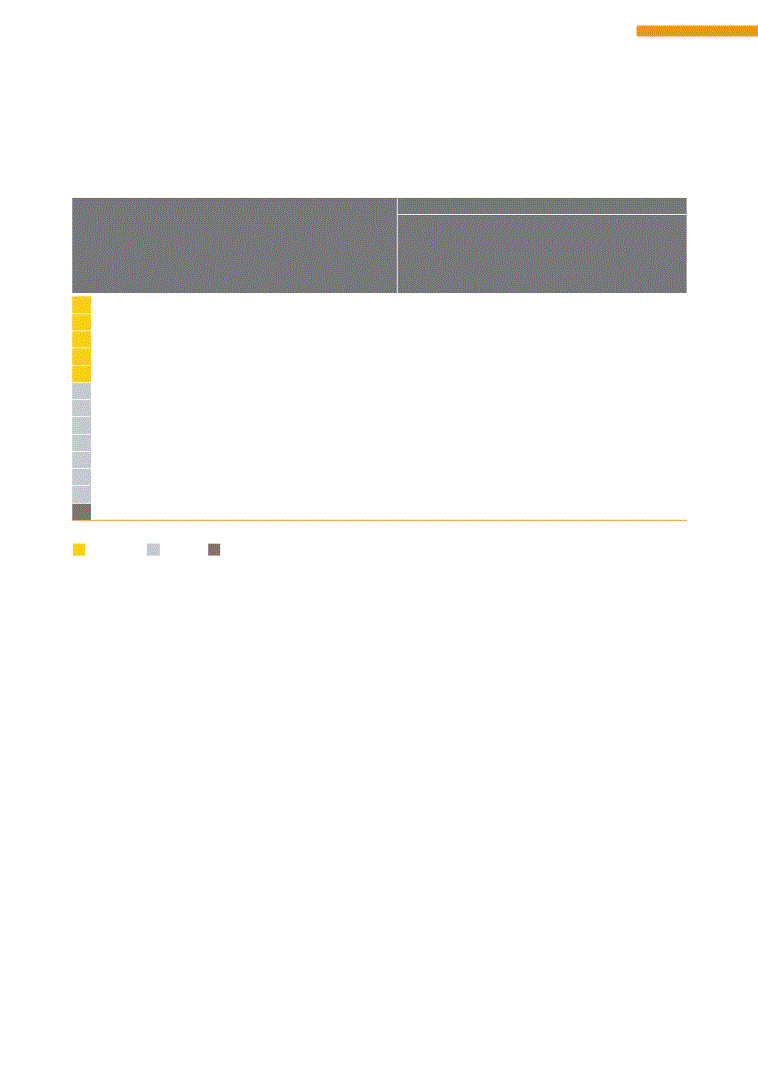
Our new operations that started pouring gold in 2013, Kibali in the DRC and Tropicana in
Australia, are now a year old and together contributed 595,000oz in 2014, making significant
contributions to cash flow. For the first time, the DRC project is making a positive contribution
to our business and to that economy. Australia contributed 14% of our gold production,
compared with 8% previously. However, the precipitous fall in gold prices over the past two
years meant we have had to withdraw from our Mongbwalu project in the DRC. We are grateful
to the government of the DRC for its cooperation in this regard. In Namibia, we sold a non-
core asset, the Navachab mine, as a result of a review of our portfolio. In Mali, we are also at
an advanced stage of disposing off the assets. We have progressed discussions as promised
to shareholders, to either joint venture or sell our interest in Cripple Creek & Victor in the US.
This, at the same as we continue to consider other asset sale options. In all these processes,
we have worked closely with the relevant stakeholders to take care of mutual interests to the
extent possible. We are appreciative for the cooperation of all concerned.
We have had to take different decisions to reposition our persistently loss making, yet high-
grade ore body, Obuasi mine in Ghana. This entailed the retrenchment of the entire labour force.
The mine is currently at limited operation mode, while we conduct a feasibility study that will
consider transforming Obuasi into a modern, mechanised operation. As we look at the options
available to finance and operate Obuasi into the future, we are also exploring options to reduce
risk while maintaining exposure to the upside of this resource by considering a joint venture
with another industry or financial partner. We would not have achieved the progress we have
made in this initiative without the support, understanding and encouragement of stakeholders;
particularly the trade unions, government and the community. We remain confident that this
partnership will carry us to the critical stage that will lead to the reopening and improved
operation of this excellent asset.
Mining Contribution Index by country
Mining Contribution Index calculation
Country by MCI ranking
Population
growth
2000 - 2012
(%)
Human
Development
Index (HDI)
Export
contribution
from metals
and coal
(%)
Change
in export
contribution
2007 – 2012
(% of %)
2012 metals
and coal
production
value
(% of GDP)
Mining
Contribution
Index (MCI)
4. DRC
40
0.34
81.5
12.4
18.0
95.88
7. Guinea
31
0.39
60.1
9.1
34.7
94.79
13. Australia
19
0.93
57.3
8.9
10.0
89.86
21. Namibia
19
0.62
53.4
1.8
11.6
82.51
24. Tanzania
40
0.49
35.3
4.3
8.9
81.81
35. Colombia
20
0.71
19.9
2.8
3.5
78.00
36. Brazil
14
0.74
17.3
5.0
3.0
75.31
59. South Africa
19
0.66
38.8
(6.5)
17.1
62.43
60. Mali
45
0.41
42.3
(9.3)
20.7
62.27
62. Ghana
35
0.57
17.6
(0.7)
12.5
62.08
65. Argentina
11
0.81
6.8
2.0
0.9
61.59
67. United States
11
0.91
7.7
1.5
0.8
60.88
82. Russian Federation
(2)
0.78
9.6
(0.7)
4.4
54.39
Mining contribution index score
Above 80
60-80
40-60
“
We have worked
closely with the
relevant stakeholders
to take care of mutual
interests to the extent
possible. We are
appreciative for the
cooperation of all
concerned.
relevant stakeholders
to take care of mutual
interests to the extent
possible. We are
appreciative for the
cooperation of all
concerned.
”
Source: The role of mining in national economies (2
nd
edition),
ICMM (available at http://www.icmm.com/document/7950)
INTRODUCTION
9
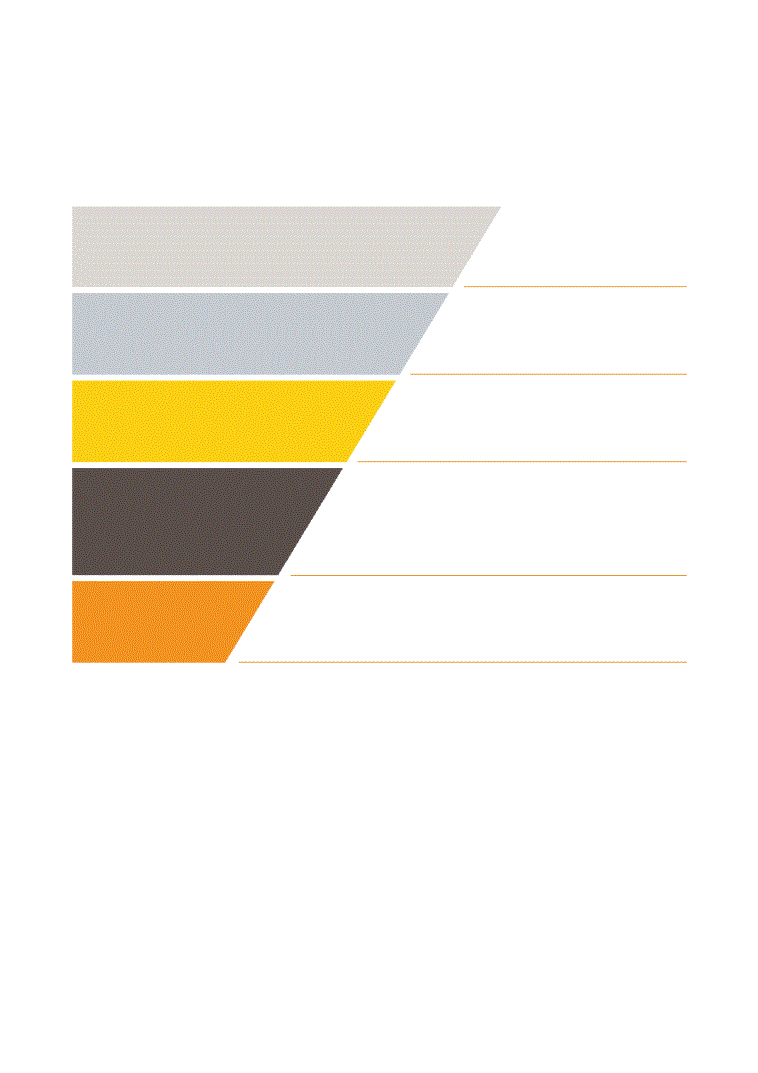
CHAIRMAN’S LETTER
continued
All of these measures are designed to ensure that the company works toward operating only
top class assets across diverse geographies where we are able to effectively bring to bear our
technology, skills and financial capabilities. We have increased gold production while delivering
good savings, through focused cost management initiatives, including significant reductions
in staff numbers, particularly at corporate, regional and country offices. Although we have
simultaneously exited a few exploration sites, we have significantly reduced exploration spend,
and we have made good progress in our exploration portfolio. In Colombia, we have been
successful in delineating a number of gold and copper-gold ore bodies resulting in a set of
opportunities too extensive for AngloGold Ashanti to undertake alone. Consequently, we are
exploring opportunities for partnerships or sale for value where we believe our assets stand to
make a positive contribution to the country’s mining landscape.
There has been good progress from our Technology and Innovation Consortium, with the goal
of extracting otherwise sterilised gold reserves in South Africa from support pillars and enabling
mining beyond current depths of about 4,000m. Nonetheless, South Africa’s mining industry is
in desperate need of a new strategy that defines its role and place in the country’s agenda for
growth. We must not lose out on future commodity booms. The leaders of industry, government
and the trade unions owe it to the country to show urgency in developing such a strategy, rather
than indulging in a fratricidal inward-looking fight to the finish. Our position in the international
mining leadership stakes has already declined. The cost this time may be the industry itself.
FOREIGN DIRECT INVESTMENT (FDI)
Mining FDI often dominates the total flow of FDI in low-income economies
that have only limited other attractions for international capital
60-90%
of total FDI
30-60%
of total exports
3-20%
of government revenues
3-10%
of total national income
1-2%
of total employment
EXPORTS
Mineral exports can rapidly rise to be a major share of total
exports in low-income agrarian economies even when
starting from a low base
GOVERNMENT REVENUE
Mineral taxation has become a very significant source
of total tax revenues in many low-income economies
with limited tax-raising capacity
NATIONAL INCOME (GDP AND GNI)
Modern-day mineral processing technology
is sophisticated and highly capital intensive;
locations are centralised as a result and
most upstream value addition takes place
outside the mine-host country
EMPLOYMENT
Mine employment on its own is
usually small relative to the total
national labour force
Macro-level contributions of mining in low- and middle-income countries
Source: ICMM (various years) and Oxford Policy Management (various years).
“
We are encouraged
that the South
African Minister of
Mineral Resources
shares our view that
policy uncertainty is
undesirable.
African Minister of
Mineral Resources
shares our view that
policy uncertainty is
undesirable.
”
INTEGRATED REPORT
2014
10

The South African gold industry needs rationalisation in order to realise economies of scale,
optimise the search for new technologies, and to enable a paradigm shift to a better educated
and skilled workforce, capable of higher productivity and wage levels earned in a healthier
and safer mining environment. Failure to do this will shorten its already dwindling future and
compromise jobs and economic growth. These considerations were at the heart of our
restructuring proposal of 2014 which took into account broader developments in the sector.
HEALTH AND SAFETY
Our commitment to confront the negative legacy of the industry’s past has positioned our
business well and seen us protect the interests of our stakeholders very well. We have
been able to do this because we are not just about compliance, but about lifting our values.
Mines that were once prone to high injuries and fatalities now enjoy record breaking safety
performance. This is despite the earthquake that struck some of our South African mines
in August. In the last five years, the number of fatalities has dropped from 15 in 2010 to
six in 2014. Four of the 2014 fatalities were in South Africa’s ultra-deep level mines. We
are saddened by those deaths, in respect of which I convey our heartfelt condolences to
the families, friends, communities and colleagues of Mncedi Ponti, Mafikizolo Sikhumbuzo
Ngwenya, Thembinkosi Dubazane, and Lwazi Bovungana from the South African operations
and Luiz Alberto Santos Cerqueira, and Thiago Luiz de Oliveira from Brazil. Although we are
encouraged by our progress in this regard, one death on any of our mines is one too many
and we cannot rest until all of our operations are completely safe.
We have over the years made great progress in establishing a healthier work environment,
from our groundbreaking HIV prevention and treatment work, to significant reductions in the
incidence of occupational lung disease, thanks to improved underground dust management,
vastly improving living conditions in company-provided accommodation. In fact, together with
Anglo American, Gold Fields, Harmony and Sibanye Gold, we announced in November 2014
an industry working group to address issues relating to fair compensation and medical care
for occupational lung disease (OLD). The companies have begun to engage all stakeholders
on these matters, including government, organised labour, other mining companies and legal
representatives of claimants who have filed legal suits against the companies. We are seeking a
comprehensive solution which deals both with the legacy compensation issues and future legal
frameworks, and which, while being fair to employees, also ensures the future sustainability of
companies in the industry.
EMPOWERMENT
Guided by the spirit of an industry agreed Mining Charter, AngloGold Ashanti can proudly
claim to have played a central part in deracialising patterns of ownership in the South African
economy resulting in one of our beneficiaries of this programme becoming the country’s first
black billionaire. This at the same time as we ensured a successful Employee Share Ownership
Scheme (ESOP), a procurement programme aimed at mainstreaming black and women
suppliers as well as a range of enterprise development initiatives. The renovated employee
accommodation is a far cry from the old hostels that were an assault on the human dignity of
our workers. We remain committed to improve the living conditions of our employees including
a search for a solution to the negative consequences of the migrant labour system, initiatives to
address employee indebtedness, where irresponsible lenders and debt administrators severely
curtail their spending power.
This inclusive approach is delivered in varied ways in different jurisdictions often guided by
prevailing policy frameworks. Our leadership appointments and talent management for
instance, whilst single mindedly driven by the principle of merit and best person for the job,
we have been able to address expectations for localisation and employment equity with great
success. This is even though we recognise the need for an improvement in the number of
African women in the executive leadership.
“
The leaders of
industry, government
and the trade unions
owe it to the country...
[to develop a] new
strategy that defines
its role and place in
the country’s agenda
for growth.
and the trade unions
owe it to the country...
[to develop a] new
strategy that defines
its role and place in
the country’s agenda
for growth.
”
INTRODUCTION
11

CHAIRMAN’S LETTER
continued
In the review of the Mining Charter, while we are encouraged by the progress made in the
professional assessment towards the commonly agreed industry transformation agenda, we
trust that the outcome of this will be used objectively and fairly to ensure that those that
have thus far failed to comply are brought along. For reasons already discussed, we would
strongly advise against a shifting of the goal posts on empowerment. We are encouraged
that the South African Minister of Mineral Resources shares our view that policy uncertainty
is undesirable. In a similar vein, we trust that the previous agreements reached between
government and the Chamber of Mines in respect of the Mineral and Petroleum Resources
Development Amendment Bill, which the President recently returned to South Africa’s National
Assembly, will be maintained.
ARTISANAL SMALL-SCALE MINERS
Regulatory certainty is required in other jurisdictions as well to enable us to pursue our vision
of shared value in mining. This is particularly so with regard to artisanal and small-scale mining
(ASM). As AngloGold Ashanti we regard ASM as a legitimate entrepreneurial activity. After
all, in many cases these are miners we found engaged in tenements we were allocated, and
long after we will have left they will remain active. The absence of a permissive regulatory
regime in some jurisdictions may inadvertently criminalise a legitimate economic activity. In
communities where we operate, the company supports a formalisation of the ASM sector
wherever possible. This affords us an opportunity to empower these entrepreneurs to embrace
healthy and safe practices, protective of the environment and also adhere to decent work
standards that we encourage.
In the Americas, our engagements with the ASM, for instance in the Gramalote concession,
included establishing alternative livelihoods, including employment with the company, driven
through a co-existence initiative, to promote the formalisation of the ASM activities and the use
of improved technology for the artisanal extraction of gold, allowing for higher yields and lower
impacts on the environment, as well as the integral development of the value chain.
At Geita, through a multi-stakeholder partnership initiative, together with the government of
Tanzania and the World Bank, we have established a management advisory group that will
pilot an operation in Lwamgasa village, whose aim is the formalisation of the ASM sector
as a long-term sustainable solution. The pilot project was launched in September 2014 and
it is anticipated that the geological evaluation will be completed in 2015, after which the
construction of the small-scale mine will commence. This will be accompanied by training of
the miners in safer methods of mining, mercury-free gold processing and other approaches
that are more efficient, safer and environmentally friendly.
LABOUR RELATIONS
We pride ourselves on the positive relations we have usually enjoyed with our employees and
their representative unions in the various jurisdictions. As a result of this relationship, great strides
have been made in an industry that had a reputation of repression and unbridled exploitation.
Today the entry level wages of our South African workers compare favourably to those of other
industrial sectors. However, the differential between the lowest and the highest paid employee
is disturbingly high. This is an untenable structural problem that requires carefully considered
and sustainable resolution. We support the government initiated engagement process on
labour relations that is led by Deputy President Cyril Ramaphosa and involves business, labour,
government and community. Its purpose is to find solutions to this challenge as well as that of
adversarial labour relations that are sometimes characterised by violence and unusually long
strikes. AngloGold Ashanti has made a significant contribution to the discourse by allowing me
to convene during June a colloquium of the country’s leading labour relations thinkers whose
conclusions have helped shape the engagements.
“
Our company needs
to modernise its
operating methods, in
order to survive and in
order to ensure a fair
shareholder return.
operating methods, in
order to survive and in
order to ensure a fair
shareholder return.
”
INTEGRATED REPORT
2014
12

The biennial gold industry wage negotiations that get underway later in the first half of 2015 will
take place against this background, which will be compounded by inter-union rivalry. Widely
canvassed measures to stem violence that often accompanies some of the strike action will
not have been agreed by the time of the forthcoming bargaining season. We trust, nonetheless,
that the bargaining will be approached in a constructive and peaceful way by all sides.
Much hard work has been done in the gold sector to ensure that the institutionalised system
of centralised collective bargaining, which has served the industry well for more than three
decades, will continue to do so. Collective bargaining is an essential feature of any market
economy, and it invariably includes elements of conflict. However, employers and employees
need always to bear in mind that they have a common interest in minimising, or even avoiding,
the losses through resorting to strike action that always accrue to all, including those who are
not directly part of the employment relationship, as the platinum strike demonstrated so starkly.
CONCLUSION
Every one of the issues dealt with in this letter – a fair return to shareholders, employee and
labour relations, health and safety, technological advancement, ASM, transformation, mining
and society – bring home the complex and interrelated set of responsibilities that the board
and management of a modern, and modernising, mining company faces. Our industry offers
the potential to help lift the poorest societies out of poverty. It has done so in many parts of
the world in recent decades. But companies have a responsibility to ensure they do so in a
responsible way, even – perhaps especially – in locations where government regulation or its
implementation is inadequate to ensure company contribution to shared value and respect for
human rights.
Our company needs to modernise its operating methods, in order to survive and in order to
ensure a fair shareholder return. But it needs to do so with awareness of, and appropriate
responsibility for, the interests and rights of those affected by our activities – employees, host
communities and governments. We need always to engage frankly with those stakeholders
with a view to a fair sharing of the value generated by our activities. We need always to be
aware of and honest about the trade-offs that tough decisions will require. The trade-offs, for
example, between pressure for better wages, jobs and technological advancement in labour
intensive environments as at our South African mines is a matter that should be at the forefront
of the minds of the leaders of business and labour. AngloGold Ashanti has always sought to
be at the cutting edge of the thinking about these issues. We seek to continue to play this role.
I welcome to the board Christine Ramon, who was appointed CFO with effect from October
2014. She is a seasoned CFO with an impressive depth of experience and will add an important
dimension to our board and to the executive. I thank Richard Duffy, the company’s previous
CFO, who had a long and distinguished career with the company. We are deeply grateful to
Richard for the outstanding work he did over the 13 months of his reign. I wish him well and all
the best in his future endeavours. I also welcome to the board Albert Garner, Maria Richter and
Dave Hodgson. Dave was chief operating officer at our company until his retirement in 2005.
Finally, I want to acknowledge the extraordinary job that our CEO, Srinivasan Venkatakrishnan
– Venkat – and his team continue to do in these most challenging times. I take this opportunity
to also express my gratitude to my fellow board members, who have supported me throughout
the year, and with whom we continue efforts to improve the company’s value proposition for
our shareholders and all stakeholders.
Sipho M Pityana
Chairman
19 March 2015
“
...great strides
have been made
in an industry that
had a reputation
of repression
and unbridled
exploitation
in an industry that
had a reputation
of repression
and unbridled
exploitation
”
INTRODUCTION
13
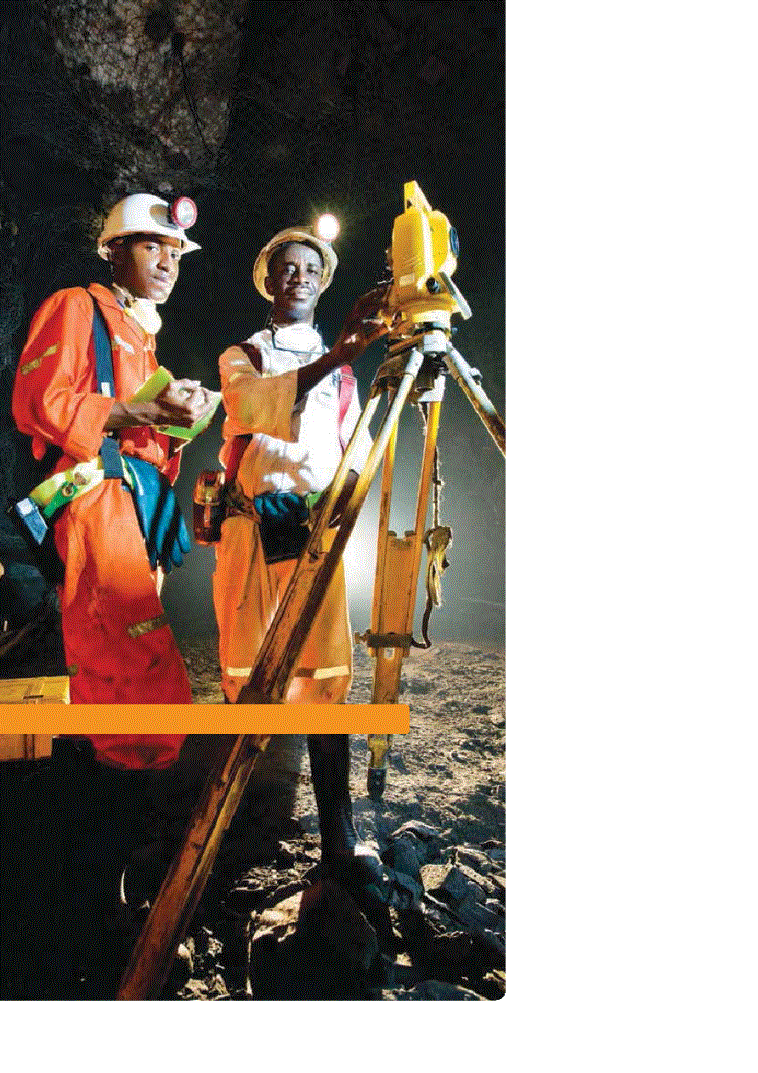
P14-25
15
Corporate profile
18
Business model
20
Timeline of corporate activity
22
Analysis of our external
environment
environment
OUR LEGACY
IS ONE OF
CREATING
VALUE
We strive to create
sustainable long-
term value for our
shareholders and all
other stakeholders.
sustainable long-
term value for our
shareholders and all
other stakeholders.
BUSINESS CONTEXT
INTEGRATED REPORT
2014
14
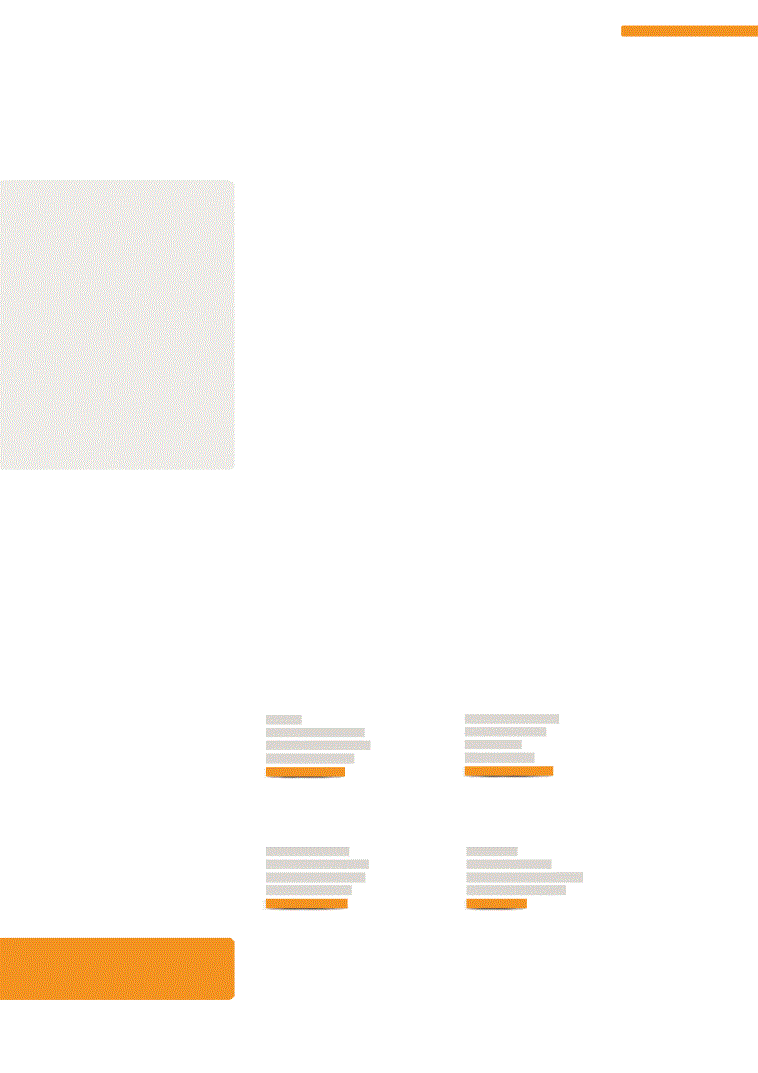
AngloGold Ashanti is a global gold mining company with a geographically
diverse, world-class portfolio of operations and projects. Headquartered
in Johannesburg, South Africa, AngloGold Ashanti is the third largest
gold mining company in the world, measured by production.
diverse, world-class portfolio of operations and projects. Headquartered
in Johannesburg, South Africa, AngloGold Ashanti is the third largest
gold mining company in the world, measured by production.
Our portfolio of 20 operations in 10 countries and a group of greenfield projects in Colombia
is supported by a focused exploration programme. It comprises long-life, relatively low-cost
assets with differing ore body types located in key gold-producing regions. A number of these
assets are strongly leveraged to energy costs and currencies.
We work across the full spectrum of the mining value chain and are concerned with the impact
of our activities on the varied and many communities and environments in which we operate.
Our goal is to create sustainable value for our shareholders, employees, and social partners
through safe and responsible mining practices and capital discipline.
Over the past two years, AngloGold Ashanti has transformed its business for improved
efficiency and competitiveness and to deliver a record safety performance alongside production
growth, reduced operating and overhead costs and improved cash flows. We will continue
to aggressively identify and implement further operational efficiencies, reduce overhead
structures, improve capital discipline and pursue other initiatives to improve underlying
business performance. The company will also accelerate actions – including reducing debt,
simplifying its portfolio and investigating options to unlock value from the Colombian portfolio
– to strengthen its balance sheet.
Our organisational and management structure is aligned with global best corporate governance
practices. Group support functions include planning and technical, strategy, sustainability,
finance, human resources, legal and stakeholder relations. The planning and technical function
focuses on the management of opportunities and the maintenance of long-term optionality in the
business through a range of activities which includes brownfields and greenfields exploration,
innovative research and technology development with a focus on mining excellence.
CORPORATE PROFILE
BUSINESS CONTEXT
See map overleaf for
location of operations
location of operations
to create value is based
on five strategic pillars
aimed at generating
sustainable free cash
flow improvements
and returns.
on five strategic pillars
aimed at generating
sustainable free cash
flow improvements
and returns.
For further detail regarding
value creation and our strategic
performance, see Our business
model on pages 18 and 19, and
Our strategy, on page 27
value creation and our strategic
performance, see Our business
model on pages 18 and 19, and
Our strategy, on page 27
.
OUR
STRATEGY
“
AngloGold Ashanti
is an independent
gold producer with
a diverse spread
of shareholders
comprising the
world’s largest
financial institutions.”
gold producer with
a diverse spread
of shareholders
comprising the
world’s largest
financial institutions.”
Annual production
(Moz)
10
11
12
13
11
12
13
14
4.5
4.3
3.9
4.1
4.4
Annual capital expenditure*
($bn)
10
11
12
13
11
12
13
14
1.02
1.69
2.32
1.99
1.21
* Includes equity-accounted investments
Annual gold income
($bn)
10
11
12
13
11
12
13
14
5.33
6.57
6.35
5.50
5.22
Average gold price received
($/oz)
10
11
12
13
11
12
13
14
561
1,576
1,664
1,401
1,264
15
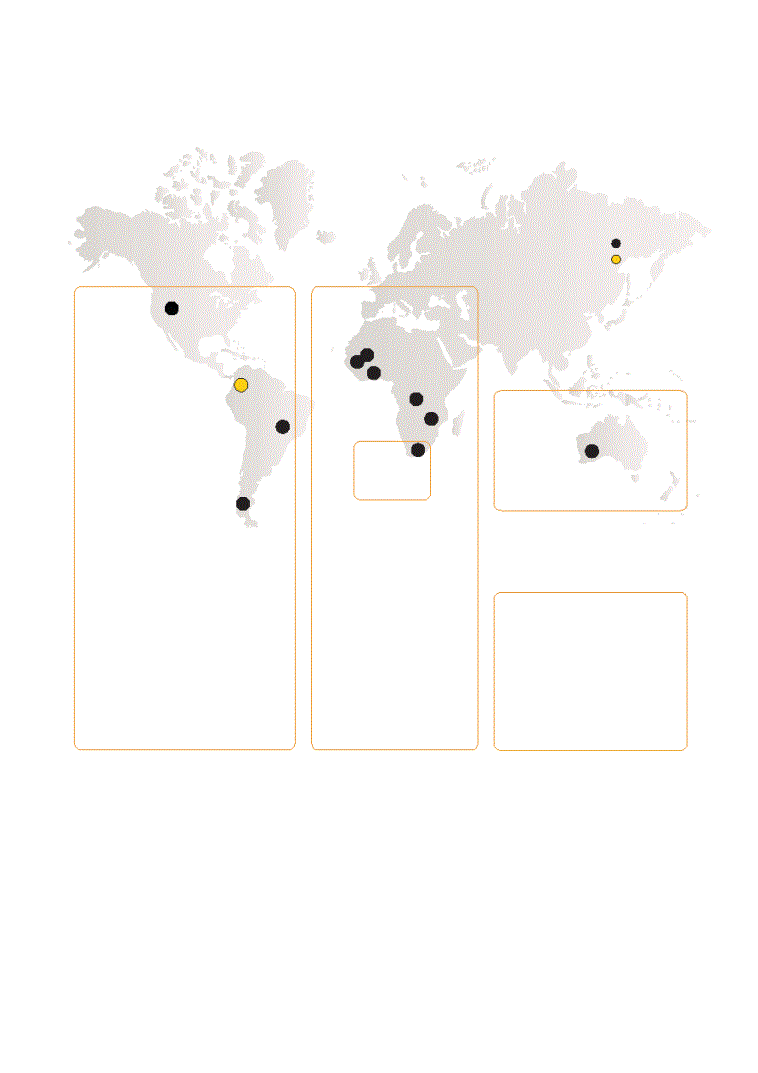
CORPORATE PROFILE continued
4
7
6
10
9
2
3
1
11
8
5
1 Argentina
Cerro Vanguardia (92.5%)
2 Brazil
Serra Grande
AGA Mineração
3 Colombia
Gramalote (51%)
La Colosa
Quebradona
(1)
(Nuevo Chaquiro) (89.75%)
4 United States
Cripple Creek & Victor (CC&V)
10 South Africa
Vaal River
Great Noligwa
(4)
Kopanang
Moab Khotsong
West Wits
Mponeng
TauTona
Surface Operations
(5)
11 Australia
Sunrise Dam
Tropicana (70%)
5 Guinea
Siguiri (85%)
6 Mali
Morila (40%)
(2)
Sadiola (41%)
Yatela (40%)
(3)
7 Ghana
Iduapriem
Obuasi
Obuasi
8 DRC
Kibali (45%)
(2)
9 Tanzania
Geita
LEGEND
Operations
Projects
SOUTH
AFRICA
AFRICA
AMERICAS
CONTINENTAL
AUSTRALASIA
SOUTH
AFRICA
AFRICA
Percentages indicate the ownership interest held by AngloGold Ashanti, whether directly or indirectly. All operations are 100%-owned unless otherwise indicated.
(1)
Nuevo Chaquiro is the deposit within the Quebradona project.
(2)
Both Morila and Kibali are managed and operated by Randgold Resources Limited.
(3)
Mining has ceased at the Yatela mine which is in closure process.
(4)
The process of integrating Great Noligwa into Moab Khotsong began in 2014 and these operations will be treated as one cash-generating unit
from 1 January 2015.
from 1 January 2015.
(5)
For the purposes of this report, Surface Operations includes First Uranium SA, which owns Mine Waste Solutions (MWS). MWS is managed and
operated as a separate cash-generating unit.
operated as a separate cash-generating unit.
LOCATION OF ANGLOGOLD ASHANTI’S
OPERATIONS AND ADVANCED PROJECTS
INTEGRATED REPORT
2014
16

OPERATIONS
Our operations are grouped regionally as follows:
•
South Africa (Vaal River, West Wits and Surface Operations)
•
Continental Africa (Democratic Republic of the Congo, Ghana, Guinea, Mali and Tanzania)
•
Americas (Argentina, Brazil and the United States)
•
Australasia (Australia)
EXPLORATION
Exploration is aimed at providing an organic growth pipeline thereby creating significant value
for the company.
Greenfields and brownfields exploration takes place in both established and new gold-
producing regions through managed and non-managed joint ventures, strategic alliances and
wholly-owned ground holdings. Our world-class discoveries include La Colosa, Gramalote
and Quebradona (Nuevo Chaquiro) in Colombia and Tropicana in Australia.
SHAREHOLDERS
AngloGold Ashanti is an independent gold producer, with a diverse spread of shareholders
comprising the world’s largest financial institutions. The Government of Ghana holds a 1.58%
interest in the company.
The respective national governments hold direct interests in our operating subsidiary in Guinea
and joint ventures in the DRC and Mali. In Argentina, the province of Santa Cruz has an interest
in the Cerro Vanguardia operation.
The primary listing of the company’s ordinary shares is on the JSE in South Africa. Its
ordinary shares are also listed on the New York, Australian and Ghana stock exchanges.
More detailed information on our stock exchanges listings is provided in the section on
Shareholder Information on page 138.
At the end of December 2014, AngloGold Ashanti had 404,010,360 ordinary shares in issue
and a market capitalisation of $3.51bn (2013: $4.73bn). Post year-end, at 19 March 2015, the
date of approval of this report by the board, the market capitalisation was $3.80bn.
PRODUCT
While gold is the principal product, depending on local geological characteristics, several
by-products are also produced. These are silver in Argentina, uranium in South Africa and
sulphuric acid in Brazil. In compliance with all applicable legislations, great care is taken to
ensure the safe production, transportation and storage of uranium and sulphuric acid, which
are potentially hazardous.
Once mined, the gold ore is processed into doré (unrefined gold bars) on site and then
dispatched to precious metals refineries for refining to a purity of at least 99.5%, in accordance
with the standards of ‘good delivery’ as determined by the London Bullion Market Association
(LBMA). This refined gold is then sold directly to bullion banks.
Geographic distribution of shareholders
as at 31 December 2014
•
United States
49
•
South Africa
25
•
United Kingdom
9
•
Rest of Europe
5
•
Singapore
2
•
Ghana
2
•
Australia
1
•
Rest of world
7
%
BUSINESS CONTEXT
17

BUSINESS MODEL
Creating value and maximising sustainable free cash flow
As a gold mining company, AngloGold Ashanti is in the
business of:
business of:
•
exploring for and assessing ore bodies to mine
•
accessing and mining those ore bodies
which are economically viable
•
processing the ore to extract gold
(and other by-products) by targeting
high-quality ounces
high-quality ounces
•
marketing the gold produced
The operational costs incurred in this process include
investing in machinery and equipment, skills enhancement,
technology development and application, and development
of our Mineral Resource and Ore Reserve.
investing in machinery and equipment, skills enhancement,
technology development and application, and development
of our Mineral Resource and Ore Reserve.
Our current business strategy is aimed at maximising
sustainable free cash flow. In response to a declining gold
price – by 24% over the last two years – and to improve
free cash flow and returns, there has been an intense focus
on profitable production which increased for the second
consecutive year in 2014. Hand-in-hand with this has been
a strong focus on optimising overhead costs and capital
expenditure. To this end, the company embarked on a
restructuring and business rationalisation programme, now
in its second year, to reduce cost and improve efficiencies.
sustainable free cash flow. In response to a declining gold
price – by 24% over the last two years – and to improve
free cash flow and returns, there has been an intense focus
on profitable production which increased for the second
consecutive year in 2014. Hand-in-hand with this has been
a strong focus on optimising overhead costs and capital
expenditure. To this end, the company embarked on a
restructuring and business rationalisation programme, now
in its second year, to reduce cost and improve efficiencies.
For additional information on our strategy, its aims and
targets and how we performed against these, refer to
pages 27-29 of this report.
targets and how we performed against these, refer to
pages 27-29 of this report.
102.2Mt
Ore treated/milled
The volumes of ore mined and treated at our mining
operations rose by 5% in 2014 from 97.1Mt in 2013.
operations rose by 5% in 2014 from 97.1Mt in 2013.
58,057
People
The average number of people employed by AngloGold
Ashanti declined by 13% in 2014, a consequence of
the company’s rationalisation process, the sale of the
Navachab mine and the transition of Obuasi in Ghana to
limited operating status.
Ashanti declined by 13% in 2014, a consequence of
the company’s rationalisation process, the sale of the
Navachab mine and the transition of Obuasi in Ghana to
limited operating status.
$92m
Corporate and marketing costs
An aggressive cost management initiative successfully
resulted in an overall reduction of 54% year-on-year
in overhead costs. This contributed to a decline in all-in
sustaining costs of 13% to $1,026/oz.
resulted in an overall reduction of 54% year-on-year
in overhead costs. This contributed to a decline in all-in
sustaining costs of 13% to $1,026/oz.
$158m
*
Expensed exploration and evaluation costs
Exploration and evaluation costs declined by 47% in
2014 as a result of a focus on key targeted jurisdictions,
aimed at supporting a focused, high-quality project and
exploration portfolio.
2014 as a result of a focus on key targeted jurisdictions,
aimed at supporting a focused, high-quality project and
exploration portfolio.
$1.2bn
*
Capital expenditure
Optimisation of capital expenditure continued whilst
maintaining the long-term sustainability of the business.
While capital expenditure was 39% lower in 2014,
investment in key projects like the expansions at CC&V
in the United States and Mponeng in South Africa, as
well as the continued development of the underground
mine at Kibali in the DRC, were maintained. Capital
expenditure also continued on ore reserve development,
the production ramp-up at Tropicana and Kibali, and on
the reef-boring initiative in South Africa to enable safe
extraction of ultra-deep ore bodies and pillars that would
otherwise not be viable to mine.
maintaining the long-term sustainability of the business.
While capital expenditure was 39% lower in 2014,
investment in key projects like the expansions at CC&V
in the United States and Mponeng in South Africa, as
well as the continued development of the underground
mine at Kibali in the DRC, were maintained. Capital
expenditure also continued on ore reserve development,
the production ramp-up at Tropicana and Kibali, and on
the reef-boring initiative in South Africa to enable safe
extraction of ultra-deep ore bodies and pillars that would
otherwise not be viable to mine.
* Includes equity-accounted investments
AngloGold Ashanti’s core strategic focus is to
generate sustainable free cash flow by focusing
on five key business objectives, namely: people,
safety and sustainability; ensuring financial
flexibility; actively managing all expenditures;
improving the quality of our portfolio; and
maintaining long-term optionality.
generate sustainable free cash flow by focusing
on five key business objectives, namely: people,
safety and sustainability; ensuring financial
flexibility; actively managing all expenditures;
improving the quality of our portfolio; and
maintaining long-term optionality.
OUR
PROCESS
INPUTS
INTEGRATED REPORT
2014
18

To achieve our strategy to improve sustainable
free cash flow generation, we have focused on the
production of high-quality ounces from the ore mined
and treated. In 2014, gold production increased by
8%. Around 97% of our revenue is generated by
free cash flow generation, we have focused on the
production of high-quality ounces from the ore mined
and treated. In 2014, gold production increased by
8%. Around 97% of our revenue is generated by
gold sales.
In 2014, we produced an attributable:
4.4Moz
(2013: 4.1Moz)
Gold
3.5Moz
(2013: 3.3Moz)
Silver
1.3Mlb
(2013: 1.4Mlb)
Uranium
192t
(2013: 191t)
Sulphuric acid
Productivity levels are measured to monitor our output
efficiency. All elements of the business maintained a
sharp focus on cost control to augment productivity gains.
efficiency. All elements of the business maintained a
sharp focus on cost control to augment productivity gains.
9.64oz/TEC
(2013: 8.14oz/TEC)
Productivity
In the course of conducting its business, AngloGold
Ashanti’s activities have an impact on the people it
employs and whose safety is paramount, on the land
disturbed by mining, and on the consumption of scarce
resources such as water and energy, which in turn has
an impact on the environment.
Ashanti’s activities have an impact on the people it
employs and whose safety is paramount, on the land
disturbed by mining, and on the consumption of scarce
resources such as water and energy, which in turn has
an impact on the environment.
6
(2013: 8)
Number of fatalities
7.36
*
(2013: 7.48)
Safety – all injury frequency rate per million
hours worked
hours worked
* 7.15: Adjusted for earthquake impact
$851m
(2013: $728m)
Discounted cost of future rehabilitation
65.0ML
(2013: 64.8ML)
Water used
31.8PJ
(2013: 32.7PJ)
Energy used
4.6Mt CO
2
e
(2013: 4.5Mt CO
2
e)
GHG emissions
$5,218m
(2013: $5,497m)
Gold income
The increase in production helped somewhat to offset the
decline in price received, thereby reducing the impact on
gold income.
decline in price received, thereby reducing the impact on
gold income.
$1,665m
(2013: $1,667m)
Adjusted EBITDA
The intense focus on costs and productivity, among
other factors, helped to maintain adjusted EBITDA
despite the lower gold price.
other factors, helped to maintain adjusted EBITDA
despite the lower gold price.
$3,133m
(2013: $3,105m)
Debt
Net debt to adjusted EBITDA at current levels is about 1.88
times, which is well within covenant limits of 3.5 times
(2013: 1.86 times) and little changed on the previous year,
despite the lower gold price.
times, which is well within covenant limits of 3.5 times
(2013: 1.86 times) and little changed on the previous year,
despite the lower gold price.
THIS ENABLED THE FOLLOWING:
$251m
(2013: $247m)
Interest paid
$1,588m
(2013: $1,593m)
Wages and salaries paid
$778m
(2013: $840m)
Payments to government
$14.8m
(2013: $22.5m)
Community investment
OUTPUTS
IMPACTS
OUTCOMES
BUSINESS CONTEXT
19
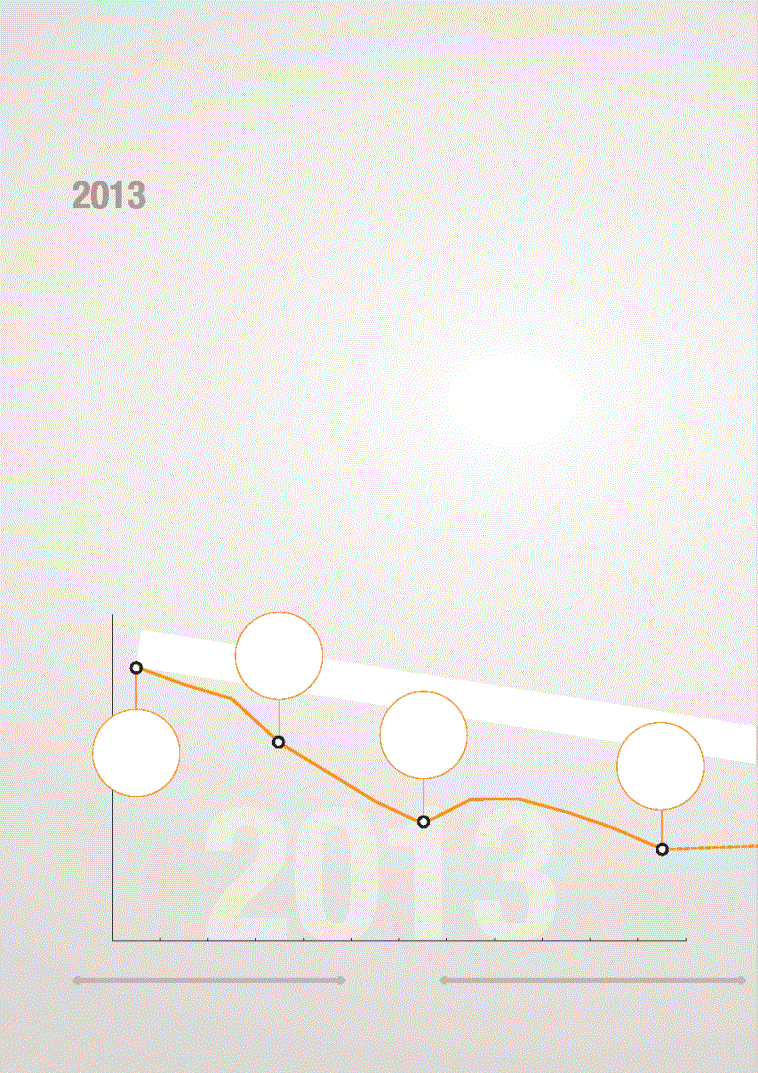
Average monthly gold price
($/oz)
2013: average gold price
$1,401
Jan
Feb
Mar
May
Jun
Jul
Aug
Sep
Oct
Nov
Dec
Apr
1,000
1,100
1,200
1,300
1,400
1,500
1,600
1,700
1,800
APRIL:
JULY:
$1,224
DECEMBER:
$1,285
Source: Bloomberg
$1,485
$1,671
JANUARY:
MAY: CORPORATE ROLES
STREAMLINED
Changes to executive part of initiative to
streamline corporate and regional
structures. A simpler strategy based on
five key focus areas developed to
improve sustainable free cash flow
generation
streamline corporate and regional
structures. A simpler strategy based on
five key focus areas developed to
improve sustainable free cash flow
generation
MAY: NEW CEO
Srinivasan Venkatakrishnan
appointed CEO
appointed CEO
JUNE: IMPAIRMENT
Significant impairment of $2.9bn (pre-tax),
owing to adverse changes in macroeconomic
conditions and sharp fall in gold price
owing to adverse changes in macroeconomic
conditions and sharp fall in gold price
JUNE: CFO APPOINTED
Richard Duffy appointed CFO
JUNE: FORMAL COST
CUTTING PROGRAMME
Project 500, a formal cost-cutting
programme, implemented to reduce
costs by $500m in an 18-month period.
The resulting review of expenditure led
to significant cuts in corporate costs,
expensed exploration and capital
expenditure
programme, implemented to reduce
costs by $500m in an 18-month period.
The resulting review of expenditure led
to significant cuts in corporate costs,
expensed exploration and capital
expenditure
AUG: BANKING COVENANT
RELAXED
Bankers successfully petitioned to
temporarily relax banking covenant
from 3 times net debt to adjusted
EBITDA to 4.5 times for two testing
periods
temporarily relax banking covenant
from 3 times net debt to adjusted
EBITDA to 4.5 times for two testing
periods
AUG: FOCUS ON
FINANCIAL FLEXIBILITY
To ensure flexibility of the balance sheet,
a seven-year bond with an aggregate
value of $1.25bn and bearing interest of
8.5% was issued, enabling us to repay in
advance the $732.5m convertible bond
due for redemption in May 2014
a seven-year bond with an aggregate
value of $1.25bn and bearing interest of
8.5% was issued, enabling us to repay in
advance the $732.5m convertible bond
due for redemption in May 2014
JULY:
COST
OPTIMISATION
Organisational and cost optimisation
review leads to the first round of
voluntary retrenchments
review leads to the first round of
voluntary retrenchments
SEPT: WAGE
NEGOTIATIONS
CONCLUDED
CONCLUDED
Biennual wage negotiations concluded
after a three-day strike at Vaal River
operations
after a three-day strike at Vaal River
operations
SEPT: YATELA CLOSURE
Closure of the Yatela mine in Mali
announced
announced
SEPT: FIRST GOLD
POURED
Kibali and Tropicana pour first gold
NOV: MOLOTO AUDIT
The Moloto Audit of compliance with
South African Mining Charter targets
completed. All targets met by end 2014
South African Mining Charter targets
completed. All targets met by end 2014
DEC:
AMERICAS RECORD
Region produces 1Moz for first time in a
calender year
calender year
TIMELINE OF CORPORATE ACTIVITY
2013 – 2014
INTEGRATED REPORT 2014
20

2014: average gold price
$1,264
Average monthly gold price
($/oz)
Jan
Feb
Mar
May
Jun
Jul
Aug
Sep
Oct
Nov
Dec
Apr
1,000
1,100
1,200
1,300
1,400
1,500
$1,200
DECEMBER:
$1,336
MARCH:
$1,311
JULY:
FEB: NEW CHAIRMAN
Sipho Pityana appointed chairman on
resignation of Tito Mboweni
resignation of Tito Mboweni
JUNE: NAVACHAB SOLD
Sale of the Navachab mine in Namibia
concluded – all conditions precedent met
and monies paid
concluded – all conditions precedent met
and monies paid
MAY: OBUASI SPECIAL
PROJECT LAUNCHED
Announced that Obuasi would be
managed as a special project to address
operational challenges
managed as a special project to address
operational challenges
AUG: EARTHQUAKE
In South Africa, earthquake halts
production at Moab Khotsong and Great
Noligwa for several days; 3,300 people
brought safely to surface
production at Moab Khotsong and Great
Noligwa for several days; 3,300 people
brought safely to surface
AUG: RAND REFINERY
LOAN FUNDING
A $44m shareholder funding loan facility
extended to Rand Refinery as a
precautionary measure following
accounting records and inventory
discrepancies encountered after the
implementation of a new software
system. Funding drawn down in
December 2014
extended to Rand Refinery as a
precautionary measure following
accounting records and inventory
discrepancies encountered after the
implementation of a new software
system. Funding drawn down in
December 2014
AUG: THIS IS GOLD
Launch of This is Gold, a collaborative
initiative aimed at providing insight into
the South African gold sector
initiative aimed at providing insight into
the South African gold sector
SEPT: PROPOSED
CORPORATE
RESTRUCTURING
RESTRUCTURING
A corporate restructuring and capital
raising announced. This was withdrawn
following extensive engagement with
shareholders
raising announced. This was withdrawn
following extensive engagement with
shareholders
SEPT: 224 FATALITY
FREE DAYS
The longest fatality-free period – 224
days – in company’s history and more
than a year without a fall-of-ground
fatality, despite the earthquake
days – in company’s history and more
than a year without a fall-of-ground
fatality, despite the earthquake
SEPT: SELF-HELP STEPS TO
DELEVERAGE
Prioritisation of measures to reduce debt
over the medium term including improved
efficiencies and potential joint ventures or
asset sales for full value
over the medium term including improved
efficiencies and potential joint ventures or
asset sales for full value
SEPT: BANKING
COVENANTS AND NEW
FACILITIES ARRANGED
FACILITIES ARRANGED
Revolving credit facility maturity profiles
successfully extended. Banking
covenants eased from 3 times net debt:
adjusted EBITDA to 3.5 times, with
one-time waiver to 4.5 times
successfully extended. Banking
covenants eased from 3 times net debt:
adjusted EBITDA to 3.5 times, with
one-time waiver to 4.5 times
NOV: NUEVO CHAQUIRO
Maiden Mineral Resource released for
Nuevo Chaquiro, a copper-gold
porphyry-style deposit located in the
Quebradona project area in Colombia
Nuevo Chaquiro, a copper-gold
porphyry-style deposit located in the
Quebradona project area in Colombia
OCT: CFO APPOINTED
Christine Ramon appointed CFO,
replacing Richard Duffy
replacing Richard Duffy
NOV: OCCUPATIONAL
LUNG DISEASE
A collaborative initiative launched to
seek a comprehensive solution to issues
relating to compensation and medical
care for occupational lung disease in
South African gold mining industry
seek a comprehensive solution to issues
relating to compensation and medical
care for occupational lung disease in
South African gold mining industry
DEC: SAFETY
ACHIEVEMENT
For the first time in company history, the
Continental Africa region completes a full
year with no fatal accidents
Continental Africa region completes a full
year with no fatal accidents
DEC: LIMITED
OPERATIONS AT OBUASI
Mine development suspended and
underground production halted.
Retrenchments completed with
agreement from unions
underground production halted.
Retrenchments completed with
agreement from unions
2014
BUSINESS CONTEXT
21

SEE MAP
We identify, prioritise, address and review external factors with a bearing
on our ability to deliver our strategic objectives.
on our ability to deliver our strategic objectives.
This enables us to highlight emerging issues that influence our short- and long-term economic
viability and the sustainability of our business. Here we analyse those issues in our external
environment – the gold market, stakeholder expectations, competition for resources and
infrastructure, and health and safety – that are expected to continue to influence AngloGold
Ashanti’s performance.
THE GOLD MARKET
The Federal Reserve’s monetary policy and the end of quantitative easing continued
to depress the gold price in 2014, as the prospect of higher interest rates reduced the
need for safe-haven investments. Demand for physical bars and coins had declined in
2013, in part as investors digested their heavy buying in 2012 and early 2013. Investors
began a sell off of their gold holdings in the second half of 2013 and this continued into
2014. In particular, liquidations from exchange traded funds (ETFs) resulted in ETF gold
holdings declining by almost 160t, significantly less than the 903t of liquidation in 2013.
ETFs have now lost a third of their holdings since their peak at the end of 2012, when
they held 89Moz (2,778t). Slowing growth in China, deflation in Japan and prospects
for monetary stimulus in Europe helped to boost the attractiveness of the US dollar,
which in turn weighed on gold.
In contrast, central banks remained steady net buyers of gold, a trend that has lasted
several years, with net purchases of 14Moz in 2014 (2013: 13Moz). Russia’s central bank
started to accumulate domestically produced metal as Ukraine-related sanctions hindered
normal gold exports.
Jewellery demand was largely sustained during 2014 at 7Moz (2,153t) level. Indian demand
in the latter half of the year took up most of the slack occasioned by slower Chinese
demand. This followed the lifting of import restrictions by the Indian government. The
Chinese jewellery market has been consolidating after the exceptional growth of 2013 and
as warehouse stocks of bullion continued to be drawn down. Apart from the United States
and UK, where economies have been recovering and lifting jewellery demand, demand in
much of the rest of the world has tended to be weaker.
ANALYSIS OF OUR EXTERNAL ENVIRONMENT
Our gold is sold in:
1
South Africa
2
United States
3
Australia
4
Asia
5
UK
6
Europe
“
Demand for
physical bars and
coins declined in
2014, in part as
investors digested
their heavy buying
in 2012 and early
2013.”
coins declined in
2014, in part as
investors digested
their heavy buying
in 2012 and early
2013.”
2014
Jan 2013
Dec 2014
Average monthly gold price ($/oz)
(January 2013 to December 2014)
1,000
1,250
1,500
1,750
INTEGRATED REPORT 2014
22

SEE MAP
3
5
6
1
SEE MAP
EXTERNAL
ENVIRONMENT
CAPITAL MARKETS
Access to capital markets is a fundamental requirement for any company. Investors (mostly investment funds but also individuals)
provide the lifeblood of capital to listed enterprises around the world, either by buying securities in the secondary markets,
or by participating in primary placements of equity or debt as companies look to raise money for specific initiatives. Equity
market conditions are currently challenging for gold producers, particularly for those in emerging markets as funds in these
markets have seen withdrawal of cash by their own investors. The sharp decline in gold prices and the resultant contraction in
producers’ margins have hurt gold funds’ performance resulting in declining
valuations and investor redemptions. Against the backdrop of low
equity valuations for gold producers and the amount required
for the transaction proposed in September, shareholders
declined the proposal to inject $2bn into the company
to facilitate the debt reduction required to split the
company. This prompted the decision to withdraw
the proposal and remain a single entity, and to
deleverage the balance sheet, generating cash
from internal sources, including fundamental
cost savings, joint ventures and/or asset
sales, for full value.
REGULATORY UNCERTAINTY
The public burden placed on the mining
industry has risen progressively over the
past decade.
In South Africa:
•
The enactment of the amended
Mineral and Petroleum Resources
Development Act (MPRDA) has been
delayed, and it has been returned to
Parliament for review. The gold industry,
through the Chamber of Mines, has
been in discussions with government.
•
The Mining Charter, which gives effect to
the MPRDA and is aimed at transforming
the mining industry to redress historical
imbalances, reached the end of the
second five-year commitment period at
the end of 2014. All of our operations
were audited and were commended
for the work done towards achieving
targets by the end of 2014.
In Argentina, regulatory concerns
around import restrictions, together
with inflationary pressures, continue to
have an operational impact.
AngloGold Ashanti’s listings:
1
JSE
9
Ghana
7
NYSE
3
Australia
ENERGY CONSTRAINTS
As the gold mining sector is a significant user of
energy, a stable and affordable power supply is critical.
•
A directive to curtail energy usage in Ghana is not expected to affect operations
as Obuasi’s transition to limited operating status will greatly reduce usage and
Iduapriem continues to optimise energy consumption.
•
South Africa’s national power utility’s generating capacity is severely constrained,
and is expected to remain under pressure for several more years. Planned
power outages are scheduled to continue until at least April 2015. Operations
engage directly with Eskom to manage outages and to participate in demand-
side management to reduce peak flow. The company is a member of the
Energy Intensive Users Group and collaborates with the Chamber of Mines
and other stakeholders to support the national electricity network and ensure
minimal disruptions. Back-up generators help to ensure employee safety during
outages and prevent infrastructural damage. We have implemented measures
underground, on surface and in residences to limit energy usage.
Constraints in:
1
South Africa
9
Ghana
BUSINESS CONTEXT
23

SEE MAP
SOCIAL LICENCE TO OPERATE
The sustainability of our business is influenced by public acceptance of our activities – the
company must earn and maintain its social licence to operate through constructive and
transparent communication and engagement.
AngloGold Ashanti strives to contribute positively to the communities and societies in
which we operate, thus contributing towards their sustainable future. Our aim during the
life of operations is to put in place the foundations of this future, by engaging with local
communities, local and national governments and other stakeholders and by being in
partnership with them. This we do by:
•
Investing in communities
•
Promoting local procurement
•
Focusing on local employment and skills development
In Ghana in particular, extensive engagements involved government, employees, unions,
regulators, communities and other stakeholders to address the operational and socio-
economic challenges at Obuasi and the mine’s transition to limited operating status while a
new development plan is finalised. A multi-stakeholder working group was established to
engage on the measures needed to return Obuasi to long-term viability. Significant progress
had been made by year-end on determining the interventions needed to transform Obuasi
into a modern, productive and cost-effective operation and how those interventions should
be implemented. The Amendment to Programme of Mining Operations, which details
technical, environmental, financial and social details around the transition, was submitted in
July 2014 and was approved by the Ghanaian Government in November. This programme
will enable the company to complete the feasibility study, carry out any necessary
engagements with potential partners and conclude a way forward for the Obuasi mine.
ARTISANAL AND SMALL-SCALE MINING
Artisanal and small-scale mining (ASM) is a feature of gold mining regions around the world.
While legal ASM is provided for in the legislative framework of most mining countries and
has the potential to provide livelihoods, we distinguish between legal and illegal ASM. The
presence of artisanal and small-scale miners can lead to illegal and criminal third-party
activity on or around our operations and often presents increased and complex challenges
to safety and security.
Much work has been done in and around our operations to ensure we work with the
communities to deal with illegal ASM while working on forging partnerships where possible
with legal ASM, which are a legitimate entrepreneurial activity. To protect our assets, our
employees, the environment and local communities, we work with authorities to act against
illegal ASM activity on our sites. We seek to address illegal ASM activity through strategic
and security interventions and by taking action that is appropriate in terms of the law
and in accordance with international principles of human rights, including the Voluntary
Principles on Security and Human Rights (VPSHR) and their rules of engagement, and the
UN Guiding Principles on Business and Human Rights. We have undertaken a number of
key initiatives including the development of a guidance framework on how to manage ASM
issues, from the implementation of capital projects to the identification of generic regional
ASM risks and their control measures.
ANALYSIS OF OUR EXTERNAL ENVIRONMENT continued
“
The company
must earn and
maintain its social
licence to operate.”
maintain its social
licence to operate.”
“
Where possible,
our company
supports the
formalisation of
the ASM sector.”
supports the
formalisation of
the ASM sector.”
ASM is most
prevalent in:
prevalent in:
10
Colombia
11
Brazil
12
Ghana
13
Guinea
14
DRC
16
Tanzania
Extensive community
engagement:
engagement:
10
Colombia
12
Ghana
15
South Africa
16
Tanzania
INTEGRATED REPORT 2014
24

13
10
11
17
12
16
15
SEE MAP
EXTERNAL
ENVIRONMENT
LABOUR RELATIONS
During the year, the South African platinum sector endured an
unprecedented five-month strike related to wage negotiations.
The second year of a two-year wage agreement in the gold sector
began in June 2014 without industrial action, although the 2013
agreement remains subject to an appeal to the Labour Court by
the Association of Mineworkers and Construction Union (AMCU). That
agreement was signed by the gold producers and three unions, NUM,
UASA and Solidarity, representing 72% of employees in the sector at the
time, and was extended to all employees irrespective of their union affiliation.
The 2013 agreement included a commitment to address employee indebtedness and in
particular as related to emolument attachment orders (EAOs) and other aspects of employees’ personal
financial management. Given their stable employment, mineworkers are vulnerable to exploitation by
unscrupulous lenders. Excessive levels of indebtedness affect employees’ ability to flourish and fund their future. Much work was
done in 2014 to develop and implement an initiative, Masidibanise Izandla, (‘let’s put our hands together’) to provide financial
guidance, advice and support to employees. The next round of wage negotiations in South Africa’s gold mining sector is expected
to begin in early 2015. The companies will again engage employees, through their organised labour representatives, in centralised
collective bargaining to find a mutually acceptable outcome that provides a salary adjustment that is both affordable for the
gold producers and adequate to their staff. It will be imperative for unions and companies to agree a link between higher pay
and improved productivity levels, given the threat that diminishing productivity poses to the long-term viability of this industry in
South Africa. AngloGold Ashanti will, as always, focus on ensuring peace and stability during this
engagement with its employees.
Employee and union engagement at our other operations had positive outcomes. For instance, at
Obuasi in Ghana, where the retrenchment of the entire workforce, with the full support of organised
labour, was the principle labour issue, and in Argentina, where the increasingly difficult economic
environment had the potential to affect relations with employees.
In:
12
Ghana
15
South Africa
17
Argentina
In:
12
Ghana
13
Guinea
15
South Africa
HEALTH AND SAFETY
Safety is not only our first value, it is our priority. Efforts to improve safety performance in 2014 were directed at deepening our
understanding of how risks develop at our operations and at identifying the pathways – or sequences of events – which result
in safety incidents. This included a focus on major hazard management – identifying and monitoring critical controls, instituting
measures to reduce and control deviations, and continuing to build organisational safety capability and capacity.
In the course of conducting our business, employees may also be exposed to various health hazards. We actively manage
these risks to ensure that our workplaces are free of occupational illness. To that end in South Africa, AngloGold Ashanti,
Anglo American South Africa, Gold Fields, Harmony and Sibanye Gold announced in November 2014 that they had
formed an industry working group to address issues relating to compensation and medical care for occupational lung
disease in the gold mining industry in South Africa. Engagement has begun with all stakeholders, including government,
organised labour, other mining companies and legal representatives of claimants who have
filed legal suits against the companies. Essentially, the companies are seeking a
comprehensive solution regarding the legacy compensation issues and future
legal frameworks, which, while being fair to employees, also ensures the
future sustainability of the industry.
Health-related community challenges include HIV/Aids in South Africa
and malaria in much of the Continental Africa region. More recently, in
2014, the outbreak of the Ebola virus disease in Guinea resulted in
the exploration programme in the vicinity of Siguiri being suspended.
BUSINESS CONTEXT
25
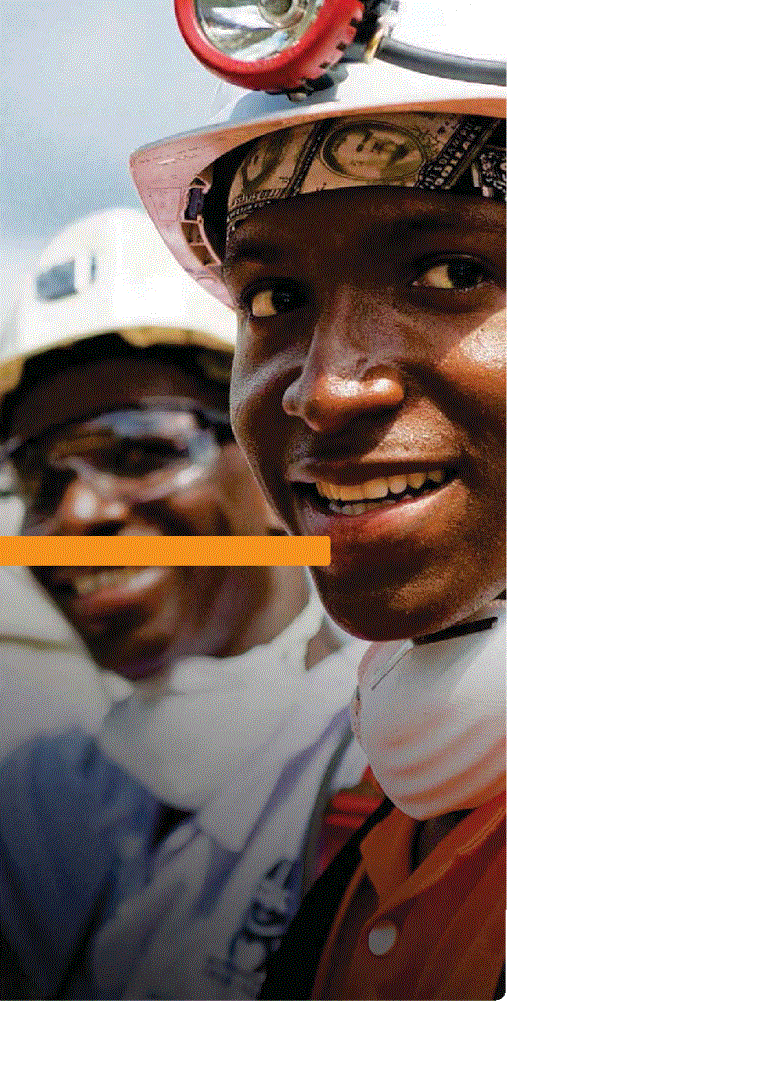
P26-41
27
Our strategy
28
Performance against
strategic objectives
strategic objectives
30
Managing and
mitigating risks
mitigating risks
37
Stakeholder engagement
and materiality
and materiality
TOWARDS
VALUE
CREATION
THROUGH
CREDIBLE AND
SUSTAINABLE
BUSINESS
In this section, we explain
our strategy and our
performance against our
strategic objectives, and
the impact of our risks
and material issues.
our strategy and our
performance against our
strategic objectives, and
the impact of our risks
and material issues.
STRATEGY
INTEGRATED REPORT
2014
26
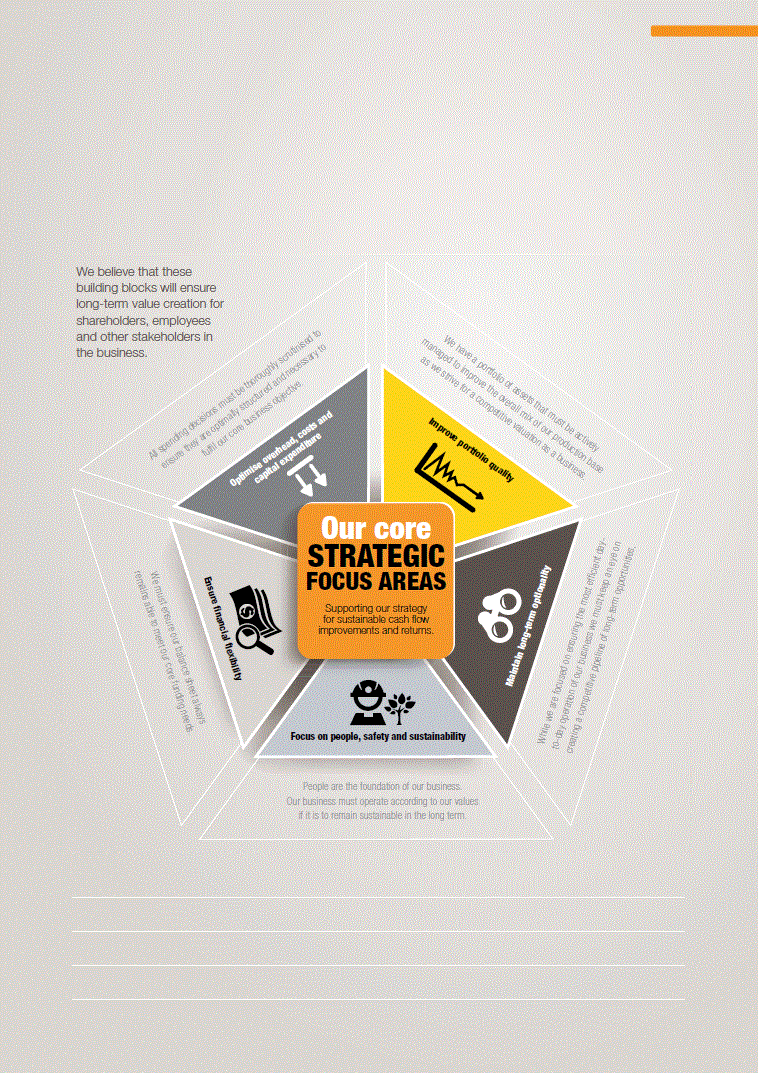
STRATEGY
AngloGold Ashanti’s core strategic focus is to generate sustainable free cash flow by focusing on five
key business objectives, namely: people, safety and sustainability; ensuring financial flexibility; actively
managing all expenditures; improving the quality of our portfolio; and maintaining long-term optionality.
key business objectives, namely: people, safety and sustainability; ensuring financial flexibility; actively
managing all expenditures; improving the quality of our portfolio; and maintaining long-term optionality.
ANGLOGOLD ASHANTI’S INVESTMENT CASE:
1.
High-quality portfolio of long-life, pure gold assets with
strong leverage to energy and currencies
4.
Balance sheet flexibility – appropriate liquidity, covenant
and maturities
2.
Prioritising margins over production growth – focus on
cost and capital discipline
5.
Decisive, proactive balance sheet management;
prioritising self-help measures to deleverage
3.
Decisive strategic response to a lower gold price –
business plans adjusted and exploration curtailed
6.
Well-developed engagement model ensures strong
stakeholder relationships and licence to operate
OUR STRATEGY
27

10
11
12
13
11
12
13
14
Expensed exploration and evaluation costs*
($m)
205
313
461
296
158
10
11
12
13
11
12
13
14
Net debt to adjusted EBITDA
(times)
0.68
0.19
0.81
1.86
1.88
10
11
12
13
11
12
13
14
Net debt
($m)
1,288
610
2,061
3,105
3,133
10
11
12
13
11
12
13
14
Production
(Moz)
4.5
4.3
3.9
4.1
4.4
Average gold price received
($/oz)
10
11
12
13
11
12
13
14
561
1,576
1,664
1,401
1,264
* Includes equity-accounted investments
STRONG
momentum maintained
in the drive to achieve our five strategic objectives
Improve portfolio quality
The gold price continued to decline in 2014. Focus on improving the
quality of the portfolio was sustained, while maintaining cash flows and
improving returns remained priorities. Production increased for the
second consecutive year, due in large part to Tropicana and Kibali each
having had their first full year of production. In line with our aim to
simplify our portfolio and focus on quality ounces, the closure of Yatela
was progressed, Navachab was sold, the CC&V expansion project was
advanced, and operations at Obuasi in Ghana were significantly
downscaled while a feasibility study is conducted on its future viability.
A maiden Mineral Resource for the Nuevo Chaquiro deposit in
Colombia was announced.
Ensure financial flexibility
Our prudent approach to managing
the balance sheet and reducing
exposure to financial risk yielded
positive results. Self-help measures
were implemented to enable
deleveraging and to increase covenant
headroom. The debt maturity profile
was extended, maintaining good
liquidity from multiple sources.
Maintain long-term
optionality
optionality
Again, the tight rein on capital
expenditure continued. Following exits
from non-core jurisdictions, exploration
focused on more prospective areas in
Australia, Colombia and Guinea. In
addition to the savings achieved in 2013,
additional savings were realised in 2014.
In 2014, AngloGold Ashanti
reported the second year of
improved operational
performance, together with a
record safety performance.
We will maintain the emphasis
on containing costs and the
culling of marginal production
if necessary.
reported the second year of
improved operational
performance, together with a
record safety performance.
We will maintain the emphasis
on containing costs and the
culling of marginal production
if necessary.
PERFORMANCE AGAINST STRATEGIC OBJECTIVES
INTEGRATED REPORT 2014
28
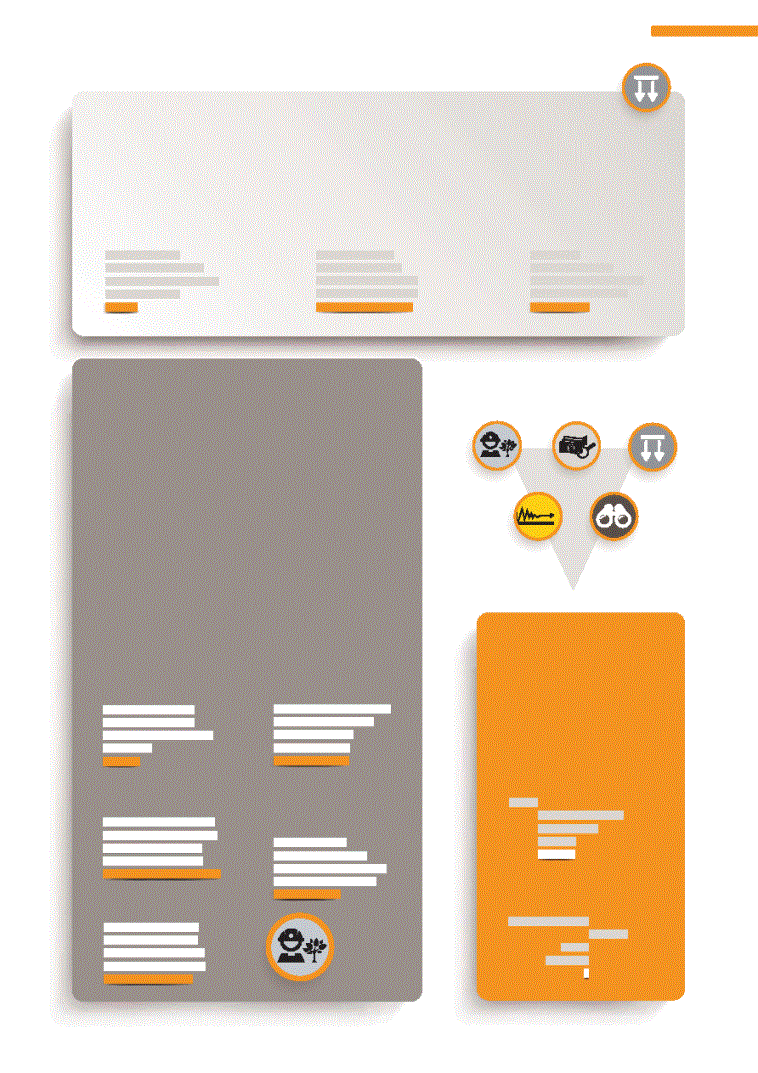
10
11
12
13
11
12
13
14
Number of fatalities
15
15
15
18
8
6
10
11
12
13
11
12
13
14
Productivity
(oz/TEC)
9.15
9.32
8.07
8.14
8.14
9.64
10
11
12
13
11
12
13
14
All injury frequency rate
(per million hours worked)
9.76
11.50
7.83
7.48
7.36*
* 7.15 adjusted for earthquake impact
10
11
12
13
11
12
13
14
Community investment
($000)
16,080
20,612
24,907
22,536
14,799
10
11
12
13
11
12
13
14
Number of employees
62,046
61,242
61,242
65,822
66,434
58,057
10
11
12
13
11
12
13
14
Total cash costs
($/oz)
638
703
829
830
787
10
11
12
13
11
12
13
14
Cash flow from operating activities
($m)
(942)
2,813
1,969
1,246
1,220
10
11
12
13
11
12
13
14
Free cash flow
($m)
(1,979)
960
(672)
(1,058)
(112)
10
11
12
13
11
12
13
14
Corporate and overhead costs
($/oz)
49
64
74
49
21
10
11
12
13
11
12
13
14
Capital expenditure*
($bn)
1.02
1.69
2.32
1.99
1.21
* Includes equity-accounted investments
DELIVERING
on our strategy
resulted in:
+
+
+
Optimise overhead, costs and capital expenditure
Costs improved significantly across every metric during 2014, the result of continued focus on all expenditures and
disciplined allocation of capital. All-in sustaining costs, which capture direct operating costs and sustaining capital, as well
as corporate overheads and exploration, fell 13% to $1,026/oz in 2014 compared with $1,174/oz in 2013. All-in costs,
which also include capital expenditure on projects, dropped 22% over the same period, to $1,148/oz from $1,466/oz the
previous year.
Focus on people, safety and sustainability
People are the business, whether they be employees, host
communities or other stakeholders affected by our activities. Our
aim to drive sustainable cash flow improvements through our
operations depends on our ability to operate safely, to operate with
the cooperation and consent of our host communities and
governments, and to remain careful stewards of the environment
notwithstanding the invasive nature of mining. With these
fundamental points guiding us at all times, we recorded the best
ever safety performance in AngloGold Ashanti’s history while also
posting a record environmental performance, measured by the
number of reportable incidents logged during the year. Furthermore,
achieving our business objectives enables us to contribute to local
socio-economic development, albeit at a lower level in 2014,
reflecting deterioration in market conditions. While we’re immensely
proud of the progress we have made in core sustainability areas, we
remain mindful of the fact that there is no room for complacency as
we seek to achieve our ultimate goal of zero harm in the workplace
and minimising our impact on the environment.
communities or other stakeholders affected by our activities. Our
aim to drive sustainable cash flow improvements through our
operations depends on our ability to operate safely, to operate with
the cooperation and consent of our host communities and
governments, and to remain careful stewards of the environment
notwithstanding the invasive nature of mining. With these
fundamental points guiding us at all times, we recorded the best
ever safety performance in AngloGold Ashanti’s history while also
posting a record environmental performance, measured by the
number of reportable incidents logged during the year. Furthermore,
achieving our business objectives enables us to contribute to local
socio-economic development, albeit at a lower level in 2014,
reflecting deterioration in market conditions. While we’re immensely
proud of the progress we have made in core sustainability areas, we
remain mindful of the fact that there is no room for complacency as
we seek to achieve our ultimate goal of zero harm in the workplace
and minimising our impact on the environment.
+
+
STRATEGY
29

MANAGING AND MITIGATING RISKS
Strategically managing threats and capitalising on opportunities
“
At AngloGold
Ashanti, we recognise that risk is a factor in all business and operational activities and, furthermore, that threat and opportunity are both facets of risk.”
Severity
Likelihood
Top group risks heat map
Strategic
Operational
External
Material risks identified
1
2
3
4
5
7
11
10
9
8
6
12
13
16
17
19
18
14
15
Obuasi
Growth
Reliability
Technology
Competetiveness
Reserves
Financial
Covenant and debt
Labour
Health
Power
Inflation
Country
Commodities and currencies
Skills
Regulatory
Operational and safety
Ebola
Social licence to operate
Risk and its identification, assessment, management and mitigation are fundamental to our business. All aspects of the risk management process underpin the execution of our strategy and planning for the future.
Hand-in-hand with this risk assessment process is the identifying of opportunities so as to
harness and capitalise on these for the benefit of all stakeholders. Once they have been
evaluated, significant risks and opportunities are prioritised and managed within the group’s
risk framework.
OUR PRINCIPAL RISKS
AngloGold Ashanti’s major risks are classified in terms of three aspects as follows:
•
Strategic risks are those taken voluntarily after consideration of risk-versus-reward to
achieve AngloGold Ashanti’s strategic objectives.
•
Operational risks are preventable risks resulting from employees’ undesirable and unauthorised
actions as well as from breakdowns in routine operational processes and human error.
•
External risks are those emanating from uncertain and uncontrollable events.
Risks assessments are undertaken annually. The risks discussed here were identified, reviewed
and assessed by the Executive Committee.
Full details and the status of each of the risks are monitored on a continuing basis. The
information provided for each risk includes details of the: risk context and background; risk
performance indicators; mitigation plans; expected outcome and residual risks; expected
dates for completion of mitigation measures; possible root causes and consequences; and
mitigatory and preventative controls. This information is updated and provided twice a year to
the Audit and Risk Committee.
TOP GROUP RISKS
The top group risks are depicted in the graphic below which maps the severity and
likelihood of the top risks. The risks depicted are those that are considered to be within
the ‘likelihood’ range of ‘almost impossible’ to ‘almost certain’ and ‘consequence’ of
‘moderate’ to ‘extreme’ should they materialise.
INTEGRATED REPORT
2014
30
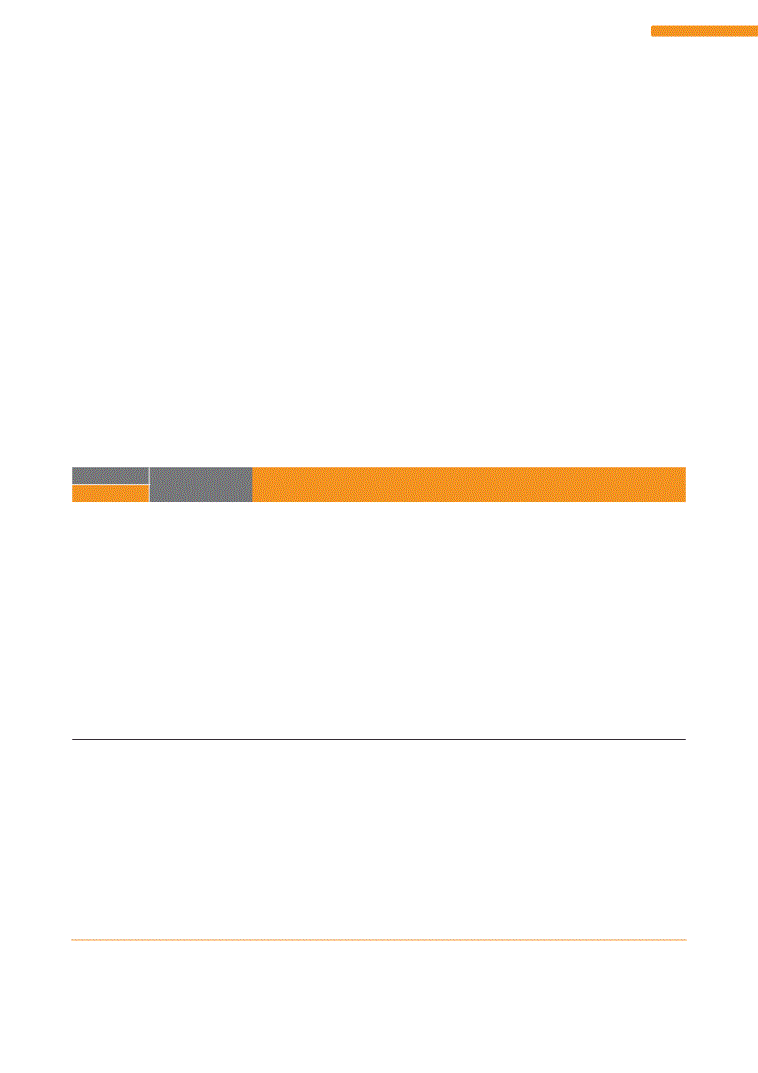
Our risks and their time horizons
We have categorised our risks in terms of their expected time horizons. Those with an imminent
(short-term) horizon are more likely to occur within around 12 months. Those categorised as
medium-term risks are considered to have a one- to three-year time horizon.
The cumulative impact of a number of these and other risks, should they materialise
simultaneously or in succession, as well as the possible magnitude and velocity of the risks, is
of major concern. Such an occurrence would be likely to cause significant headwinds that could
adversely impact the implementation of AngloGold Ashanti’s strategy, despite the successes
achieved to date, and could potentially threaten AngloGold Ashanti’s liquidity and viability.
The table below lists the top risks – both imminent and medium-term – to the group, ranked
from highest to lowest in terms both of the potential severity of the consequence of each risk
and the likelihood of that risk arising.
‘Top’ risks as at year-end 2014
Risk ranking
2014
Type
Potential risk
1
Strategic
Protracted financial pressure on the business from the depressed gold price coupled with
high debt and declining grades and consequential rise in unit costs as assets mature **
2
External
Adverse gold and commodity prices, and currency movements *
3
Strategic
Inability to develop projects to bring the Ore Reserve to account **
4
External
Covenant compliance and inability to reduce debt *
5
External
Protracted labour-related stoppages in South Africa *
6
Operational
Operational and safety underperformance negatively impacting improved track record **
7
External
Legacy occupational and community health compensation claims/litigation **
8
Strategic
Inability to remain competitive impacting the long-term investment case *
9
External
Elevated country risk profile in core production areas **
10
Operational
Input cost inflation exceeding cost containment and productivity strategies **
11
External
Security of power supply and rising cost of power in South Africa *
12
Strategic
Failure to successfully operationalise (ATIC) technology step-change **
13
Operational
Asset integrity failures and compromised reliability at South African operations *
14
Strategic
Failure to demonstrate and/ or realise business case for Obuasi redevelopment *
15
External
Unfavourable regulatory environment changes *
16
Operational
Critical skills and talent retention *
17
External
Failure to acquire or loss of ‘social licence to operate’ *
18
Strategic
Lack of strategic growth projects to renew portfolio **
19
External
Operational disruption in West Africa resulting from Ebola virus disease **
* Denotes a risk with an imminent time horizon
** Denotes a risk with a medium-term time horizon
STRATEGY
31
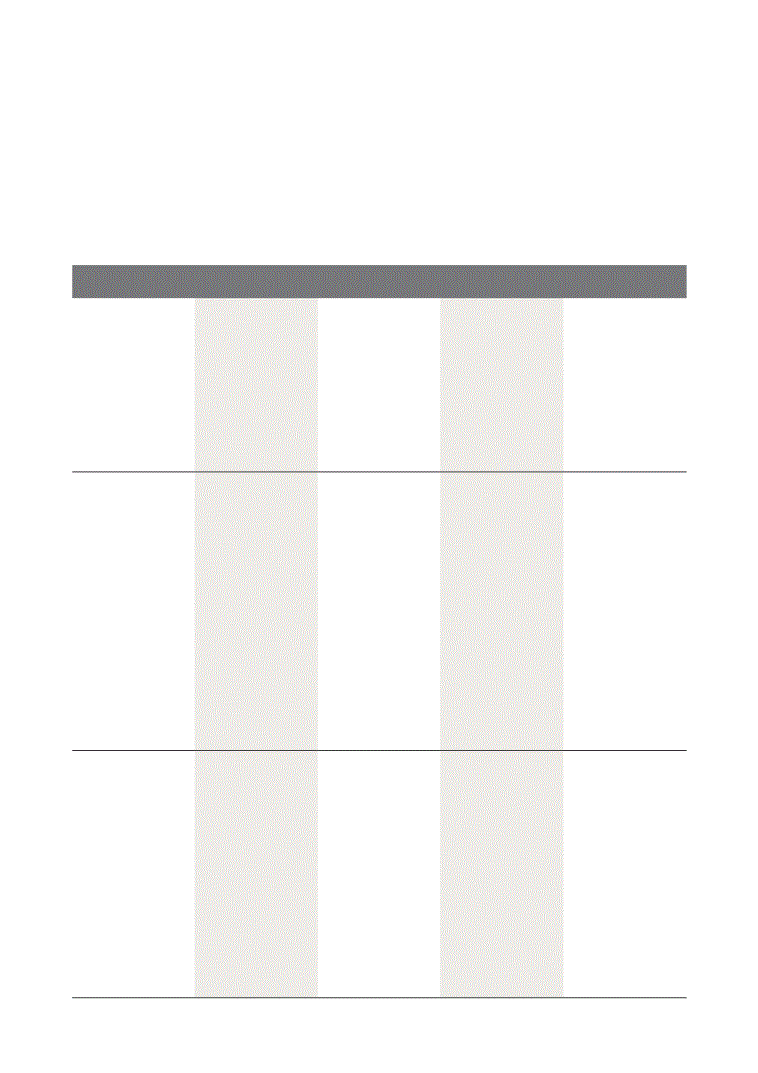
MANAGING AND MITIGATING RISKS continued
Strategically managing threats and capitalising on opportunities
MITIGATION OF RISKS
Action plans to mitigate the risks identified have been put in place. The mitigation measures associated with the top five imminent risks
are detailed in the table below.
Mitigation of top five imminent risks
Risk
(ranking)
Potential consequences
Mitigation action plan
Expected outcome and
residual risk
Progress/current status
Adverse gold and
commodity prices, and
currency movements
a
(2)
•
Inadequate free cash
flow/liquidity/credit
rating impact
•
Inability to develop
strategic growth and
development projects
to bring reserves to
account
•
Lower market
capitalisation
•
Credible track record
of cost control and
solid delivery
•
Ongoing cost control
measures
•
Business planning and
portfolio optimisation
•
Asset sales
•
Access capital markets
•
Potential impact on
valuation
•
Altered asset portfolio
•
Premature closure
or moth-balling
of operations and
reduced production
profile
•
Elevated debt
•
Inability to pay
dividends
•
In progress
Covenant compliance
and inability to reduce
debt
b
(4)
•
Balance sheet stress
•
Raised cost of capital
•
Equity overhang
•
Inability to develop
strategic growth and
development projects
•
Impeded portfolio
options
•
Breach of debt
covenants
•
Proactive and
timely approach to
refinancing of facilities
•
Diversified sources/
facility tenor
•
Self-help measures to
generate cash from
internal sources to
reduce debt. Includes
optimising mine plans
for cash generation,
focus on high-margin
production, pursuing
efficiencies across
the portfolio and
considering potential
asset sales or joint
ventures for full value
•
Reduced costs
and restructured
organisation
•
Optimised portfolio
•
Potential impact on
valuation
•
Reduced production
profile
•
Severe capital
constraints
•
Inability to pay
dividends
•
Debt refinancing
(complete)
•
Additional mitigation
measures commenced
and in progress as the
gold price declined
sharply towards the
end of 2014
Protracted labour-
related stoppages
in South Africa
c,d
(5)
•
Production stoppages
and losses leading to
liquidity crisis
•
Intimidation of
employees and
violence and damaged
assets
•
Compromised safety
and operational
conditions
•
Lower market
capitalisation
•
Organisational
restructuring
•
Legal strategies
•
Three-tier union and
employee consultation
process/ media
•
Recognition
agreements
•
Wage increases
extended to all
employees
•
Union/government
facilitation
•
SASRIA insurance
•
Restructuring
•
Two-year wage
agreement with higher
input costs/wages
•
Inter-union tensions
exacerbated by
competition for
majority representation
at all South African
gold mines
•
Restructuring
occasioned by cost and
gold price pressures
•
Ongoing litigation
•
Current labour law
review and Mining
Charter imperatives
•
AMCU’s Labour Court
Appeal (Q4 2015)
•
Labour Court review
of dismissed Moab
Khotsong employees
•
Wage negotiations
(mid-2015)
a
>IR: Refer to discussion on
the gold market on page 22
b
>AFS: Refer to group note
27 on group borrowings
(page 105)
(page 105)
c
>IR: Engagement with
organised labour on pages
39-40
39-40
d
>SDR: Refer to the
discussion on labour relations
at www.aga-reports.com/
14/sdr/material-issues/
stakeholder-engagement/
organised-labour
at www.aga-reports.com/
14/sdr/material-issues/
stakeholder-engagement/
organised-labour
INTEGRATED REPORT 2014
32
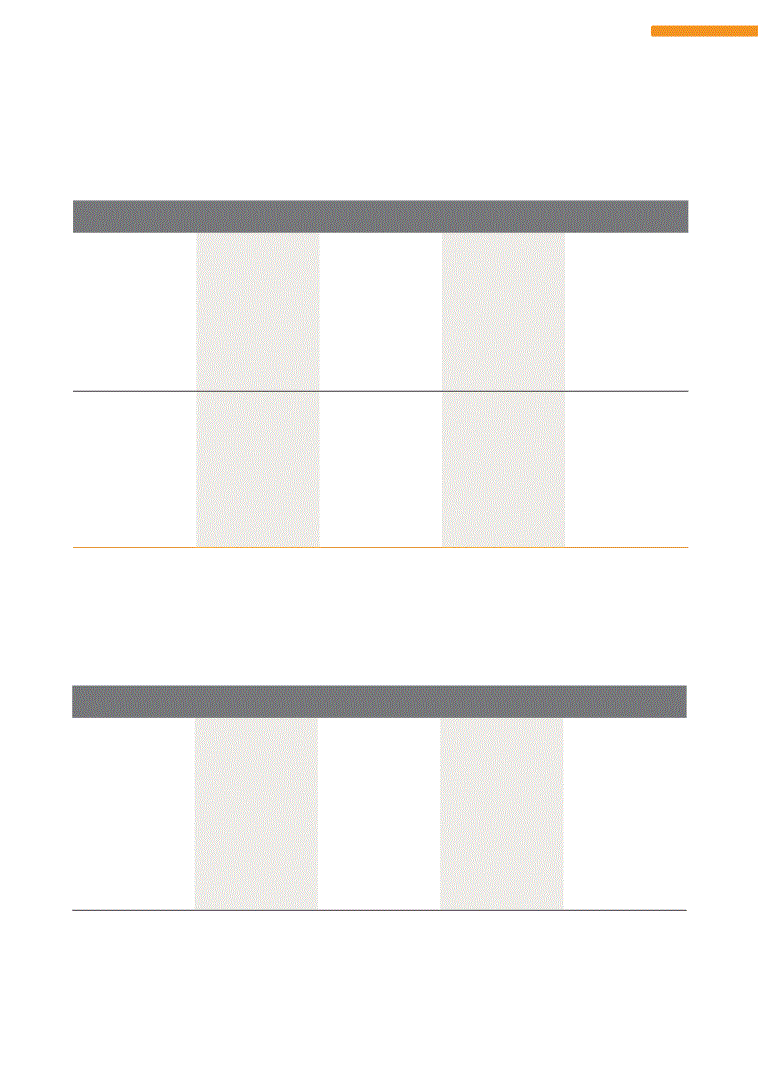
The mitigation measures associated with the top five medium-term risks are as follows:
Mitigation of top five medium-term risks
Risk
(ranking)
Potential consequences
Mitigation action plan
Expected outcome and
residual risk
Progress/current status
Protracted financial
pressure on business
from depressed gold
price coupled with high
debt and rapidly rising
costs of mature asset
portfolio
(1)
•
Inadequate free cash
flow/ liquidity
•
Inability to develop
strategic growth and
development
•
Low market
capitalisation
•
Credit rating impact
•
Premature closure
•
Cost reduction,
restructuring and
business plan review
•
Portfolio optimisation
•
Refinancing banking
facilities with looser
covenants
•
Credible cost control/
delivery
•
Access capital markets
•
Joint ventures and
asset sales
•
Potential impact on
valuation
•
Altered asset portfolio
•
Reduced production
profile
•
Elevated debt levels
•
Inability to pay
dividends
•
Continued focus on
optimising balance
sheet structure to
maintain financial
flexibility
•
Active cost
management
continues to counter
weaker gold price
Mitigation of top five imminent risks continued
Risk
(ranking)
Potential consequences
Mitigation action plan
Expected outcome and
residual risk
Progress/current status
Inability to remain
competitive impacting
long-term investment
case
e
(8)
•
Market capitalisation
reduction
•
Inability to reduce debt
•
Inadequate cash flow
and liquidity
•
Premature closure
or mothballing of
operations
•
Lack of strategic
growth projects
•
Credible track record
of cost control and
solid delivery
•
Ongoing cost control
measures
•
Business planning and
portfolio optimisation
•
Asset sales
•
Access capital markets
•
Improved market
capitalisation and
asset portfolio
•
Premature closure or
mothballing/reduced
production profile
•
Reduced debt levels
•
Inability to pay
dividends
•
In progress
Security of power
supply and rising cost
of power in South
Africa
f, g
(11)
•
Production losses
•
Inadequate free cash
flow/liquidity/credit
rating impact
•
Lower market
capitalisation
•
Compromised safety
•
Increased operational
costs
•
Flooding of workings
•
Power saving and
reduction initiatives
•
Proactive and
continuous
engagement with
Eskom
•
Emergency response
plans
Over the next three to
five years:
•
Frequent load-
shedding disrupting
production
•
Potential for complete
loss of power for ‘days
at a time’ as Eskom
protects the national
grid
•
Ongoing
•
No ability to cater for
complete, prolonged
power loss from the
grid
e
>IR:
Refer to section entitled Planning for future from page 111
f
>SDR:
Energy usage, efficiency and security at www.aga-reports.com/14/sdr/material-issues/environmental-stewardship/energy
g
>IR:
Discussion on energy constraints on page 23
STRATEGY
33
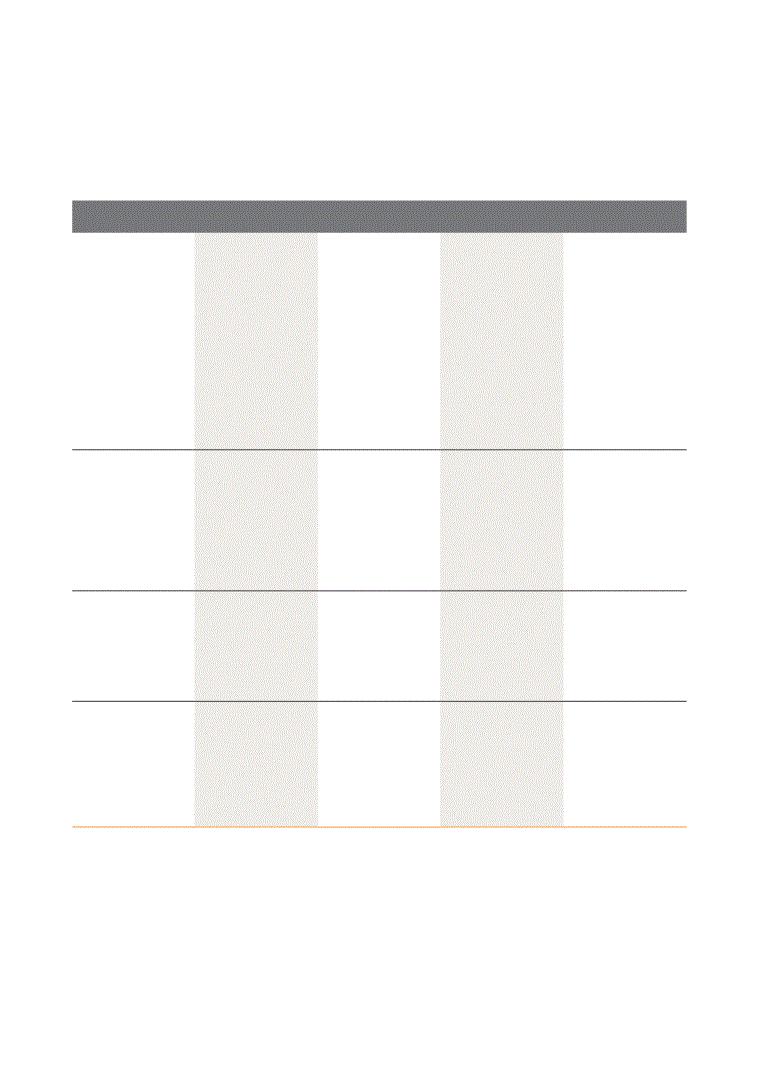
MANAGING AND MITIGATING RISKS continued
Strategically managing threats and capitalising on opportunities
Mitigation of top five medium-term risks continued
Risk
(ranking)
Potential consequences
Mitigation action plan
Expected outcome and
residual risk
Progress/current status
Inability to develop
projects to bring the Ore
Reserve to account
(3)
•
Ore Reserve write-
down and market
capitalisation decline
•
Production profile
and business plan
reduction
•
Loss of tenements
•
Premature mine
closure or mothballing
•
Identification of joint
venture partnerships
and alternative funding
•
Focused exploration
funding for critical
operations
•
Business planning and
portfolio optimisation
•
South Africa reef-
boring programme
•
Expansion and/or life
extension projects at
CC&V and Mponeng
•
Obuasi feasibility study
•
Ore Reserve decreases
and impairments
•
Loss of growth
opportunity and
returns via potentially
having to partner at
less than optimal value
•
In progress and
ongoing
•
Completion dates
uncertain
Operational and safety
underperformance
negatively impacting
improved track
record
a, b
(6)
•
Reduced cash flow
and decreased liquidity
•
Decline in investor
confidence
•
Credit ratings impact
•
Restricted ability to
invest in strategic
growth and
development projects
•
Business planning and
portfolio optimisation
•
Organisational
restructuring
•
Project 500
•
Robust safety systems
and leadership,
training, KPIs, and
bow-tie controls
•
Improved ability to
deliver on business
plans and market
guidance
•
Improved asset
portfolio
•
Declining Ore Reserve
•
Initial phase of Project
500 complete and
targets achieved
•
Ongoing
•
Project 500 team to
continue searching for
additional savings and
efficiency opportunities
Legacy occupational
and community health
compensation claims/
litigation
c, d
(7)
•
Financial impact
•
Market capitalisation
reduction
•
Reputational damage
•
Impacted employee
well-being
•
Defend claims
•
Industry-wide
project to assist with
compensation and
relief
•
Gold Working Group
•
Court ruling in favour
of AngloGold Ashanti
•
Comprehensive
solution involving all
stakeholders
•
Identification of
suitable alternatives
•
Indeterminate
•
Pursuing legal defence
of claims
Elevated country
risk profile in core
production areas
e, f
(9)
•
Adverse impact on
business plan delivery
•
Reduced market
capitalisation
•
Increased costs and
cash flow impact
•
Portfolio review
•
Focused exploration
•
Host government
and local community
engagement
•
Emergency evacuation
plans
•
Risk management
•
Balanced and diverse
portfolio
•
Moderation of host
government demands
and legislation
•
Indeterminate and
ongoing
a
>SDR: Improving safety performance at www.aga-reports.com/14/sdr/material-issues/safety-health/safety-performance
b
>IR: Refer to the discussion on safety performance in the regional review on pages 70 to 93
c
>SDR: Building workplaces free of occupational illness at www.aga-reports.com/14/sdr/material-issues/safety-health/occupational-illness#
d
>AFS: Refer to group note 36 on contingencies and contractual commitments on page 131
e
>SDR: Engaging with stakeholders, communities and governments at www.aga-reports.com/14/sdr/material-issues/stakeholder-engagement/
f
>IR: Refer to the regional review on pages 70 to 93
INTEGRATED REPORT 2014
34
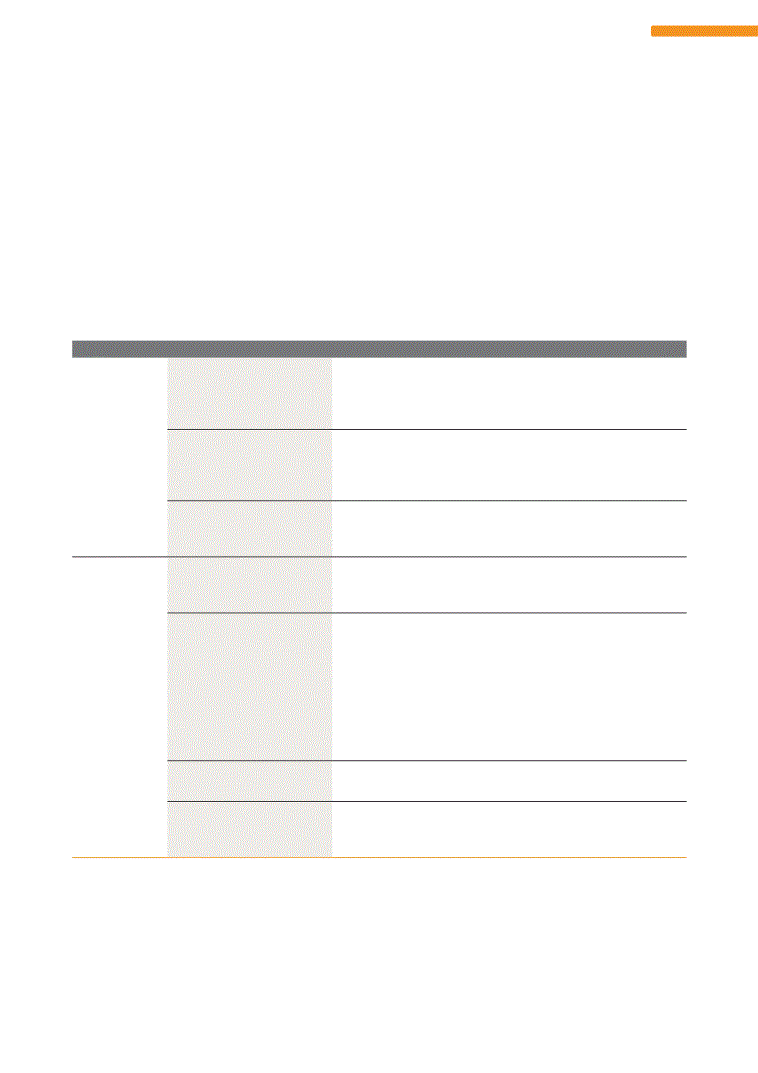
TOP GROUP OPPORTUNITIES
We recognise that identifying and managing opportunities is an important component of risk
management. The company identifies suitable opportunities, endeavouring to exploit, harness,
or maximise them with the aim of creating value from mitigating our risks. The following table
lists our key opportunities along with the strategy for each.
Top group opportunities
Type
Opportunity
Strategy
Operational
Benefits from increase in gold
price enhanced by cost reduction
•
Actively improve the quality of the portfolio
•
Focus on margins through initiatives to improve all-in sustaining costs
and all-in costs, including Project 500
•
Improve leverage to the gold price
Technology step-change in
South Africa
•
AngloGold Ashanti Technology and Innovation Consortium (ATIC)
•
Proof of concept work relating to geological drilling, reef boring, ultra-
high strength backfill and haulage boring machines
•
Stakeholder identification and engagement
a
Benefits from weaker currencies
and lower oil price
•
Demonstrate leverage at operations most exposed to declining
currencies
•
Demonstrate leverage at operations that use most oil/diesel
Strategic
Colombia
•
Revised tenements strategy with focused exploration funding
•
Work to ensure that ‘social licence to operate’ is realised
•
Partnering options
b
Obuasi
•
Maintain integrity of site and infrastructure during limited operations
phase
•
Deliver feasibility study; refine to ensure optimal returns from high-
margin, mechanised operation
•
Ensure buy-in for redevelopment from all stakeholders including
government
•
Ensure optimal regulatory and fiscal environment
•
Test market for potential, value-creating joint venture and find optimal
funding structure
Business planning and portfolio
optimisation processes
•
Sound business planning with top-down goals
•
Portfolio rationalisation and optimisation
Asset sale or joint venture for
full value
•
Potential to realise full value in cash for sale or joint venture of operating
asset
•
Increased ability to deleverage in a value-enhancing manner
STRATEGY
a
>IR:
Refer to the discussion on technology and innovation in Planning for the future on pages 111 to 117
b
>IR:
Refer to the Americas regional review on page 88 to 93
35
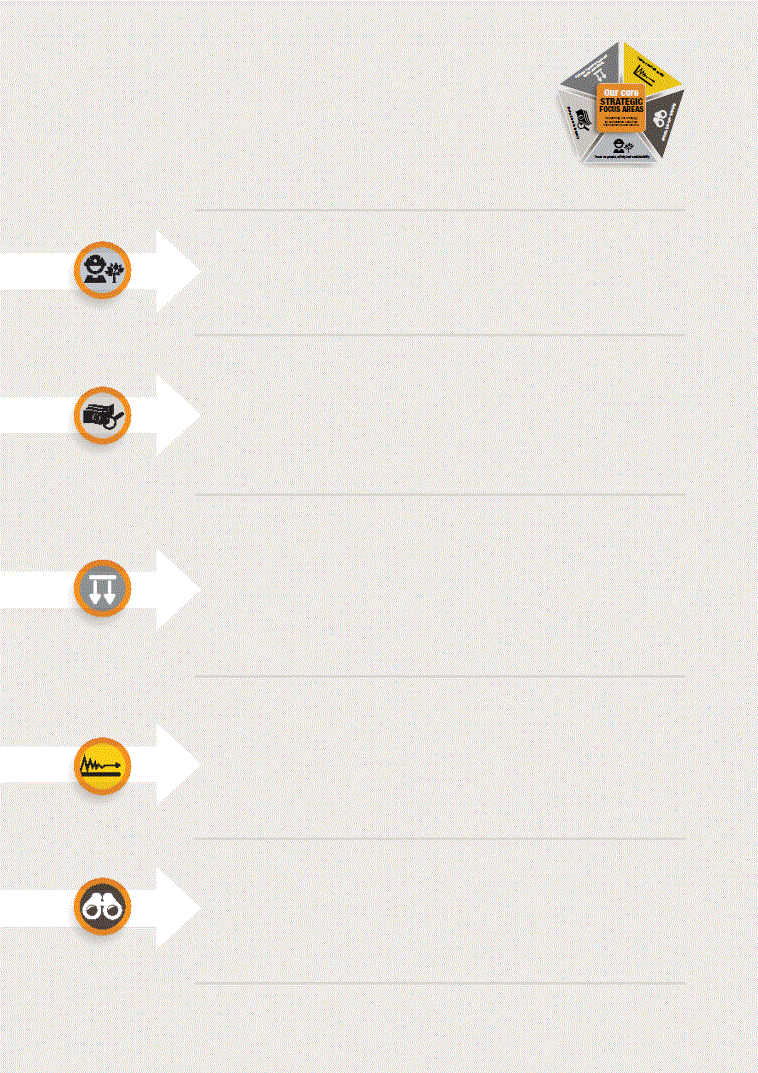
Focus on people, safety and sustainability
•
Operational and safety underperformance negatively impacting improved track record (6)
•
Protracted labour-related strikes
1
(5)
•
Critical skills and talent retention
2
(16)
•
Failure to acquire or loss of ‘social licence to operate’ (17)
•
Legacy occupational and community health compensation claims/litigation (7)
Ensure financial flexibility
•
Adverse gold and commodity, and currency movements (2)
•
Protracted financial pressure on business from depressed gold price coupled with high debt and
rising costs of mature asset portfolio (1)
•
Covenant compliance and inability to reduce debt (4)
•
Protracted labour-related strikes (5)
•
Legacy occupational and community health compensation claims/litigation (7)
•
Operational and safety underperformance negatively impacting improved track record (6)
Optimise overhead, costs and capital expenditure
•
Protracted labour-related strikes (5)
•
Failure to demonstrate and/or realise business case for Obuasi redevelopment (14)
•
Security of power supply and rising cost of power in South Africa (11)
•
Unfavourable regulatory environment changes
3
(15)
•
Operational and safety underperformance negatively impacting improved track record (6)
•
Input cost inflation exceeding cost containment and productivity strategies (10)
•
Asset integrity failures and compromised reliability at South African operations (13)
•
Operational disruption in West Africa resulting from outbreak of Ebola virus disease
4
(19)
Improve portfolio quality
•
Adverse gold, commodity and currency movements (2)
•
Inability to remain competitive impacting long-term investment case (8)
•
Protracted labour-related strikes (5)
•
Inability to develop projects to bring the Ore Reserve to account (3)
•
Lack of strategic growth projects (18)
•
Legacy occupational and community health compensation claims/litigation (7)
•
Failure to successfully operationalise ATIC technology step-change (12)
Maintain long-term optionality
•
Adverse gold, commodity and currency movements (2)
•
Inability to remain competitive impacting long-term investment case (8)
•
Inability to develop projects to bring the Ore Reserve to account (3)
•
Failure to demonstrate and/ or realise business case for Obuasi redevelopment (14)
•
Lack of strategic growth projects (18)
•
Elevated country risk in core production areas (9)
RISKS BY STRATEGIC OBJECTIVE
(Risk ranking as per page 31)
MANAGING AND MITIGATING RISKS continued
Strategically managing threats and capitalising on opportunities
1
>SDR: Implementing business strategy through people
2
>SDR
3
>SDR: Monitoring and respecting regulatory change
4
>SDR: Delivering a health value proposition to communities
INTEGRATED REPORT
2014
36
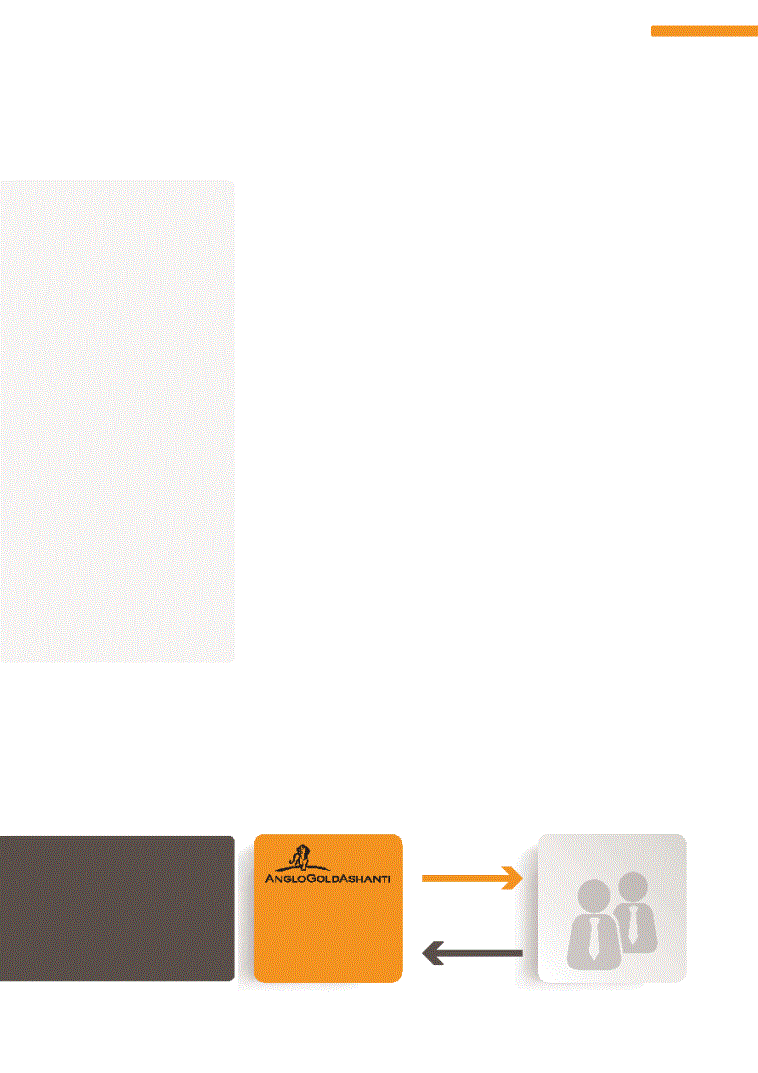
STRATEGY
Effective engagement is a prerequisite to our establishing mutually-
beneficial relationships with stakeholders. These relationships, we
believe, are essential in maintaining our social licence to operate.
beneficial relationships with stakeholders. These relationships, we
believe, are essential in maintaining our social licence to operate.
AngloGold Ashanti has a wide range of stakeholders. Relationships with communities,
government and regulators, employees, both individually and through affiliations such as
organised labour, community-based organisations (CBOs) and non-governmental organisations
(NGOs) are some of the most critical to our business.
Engagement takes place at a group level with stakeholders whose interests require them
to have an overview of the business as a whole, such as investors, employees, organised
labour unions, the media, regulatory authorities and certain government and civic organisation
representatives. At an operating level, each site is responsible for defining its stakeholders
and for understanding the impact of operations on these stakeholders and of their potential
influence on the business. Engagement begins from early stages of exploration and continues
through to closure.
CRITICAL AREAS OF ENGAGEMENT
We have identified a range of stakeholders with whom we engage in respect of their diverse
issues and inputs. We aim to be continuously proactive in our engagement with stakeholders
and responsive to their issues and concerns as they arise. Our long-term objective is to create
value for all our stakeholders including shareholders, employees, business and social partners
by safely and responsibly exploring and mining as we work to deliver sustainable improvement
in free cash flow and returns to all our stakeholders. As several operations approach the end
of their operating lives, engagement around closure becomes increasingly important, as has
happened at Yatela in Mali.
While much of our engagement with government and regulatory authorities takes place
individually and on company-specific issues, AngloGold Ashanti has also been active in various
industry bodies in all countries of operation, in support of industry positions on topics such as
legislation and regulation surrounding the mining sector.
A key focus for mining companies in these discussions is to promote regulatory certainty in
relation to the sector. Uncertainty regarding the regulatory or legislative horizon fuels negative
media comment, damages investor sentiment, and is ultimately harmful to the industry.
STAKEHOLDER ENGAGEMENT AND MATERIALITY
Our stakeholders
We define our stakeholders
as persons or groups who are
directly or indirectly affected
by our operations or projects or
whose interests in our operations
or projects can influence their
outcome. These include:
•
Locally-affected communities
and individuals and their formal
and informal representatives as
well as civic, non-governmental
and religious organisations
and other groups with special
interests
•
Government, politicians and
regulatory authorities
•
Employees and their families,
and labour unions
•
The media
•
Suppliers, joint venture partners
and business peers
•
The investment community,
including shareholders, current
investors, potential investors
and financiers
Engagement
Stakeholder engagement is
a two-way process, involving
communication by the company to
stakeholders and by stakeholders
to the company. The icons
alongside represent the flow of
communication.
a two-way process, involving
communication by the company to
stakeholders and by stakeholders
to the company. The icons
alongside represent the flow of
communication.
Stakeholders
AngloGold Ashanti
Inward
Outward
37

Summary of critical areas of stakeholder engagement
Stakeholder group and engagement
Issues raised
Impact on stakeholder group and
impact on company
Locally affected communities and individuals and their formal and informal representatives as well as civic and religious
organisations and other groups with special interests
Detailed mapping of stakeholders is being undertaken at
sites where information is not currently available, inaccurate
or outdated. We are gathering and organising data relating to
our interactions with communities (commitments, complaints
and grievances, resettlement processes and socio-economic
baseline assessments) and improving measures for evaluating
the effectiveness of community engagement processes.
We frequently build our own capacity and strive to build that
of communities, local and national authorities. We allocate
financial and human resources to working with communities to
ensure that they are empowered with information, consulted
on operational issues that may affect them and can effectively
provide input on their concerns and expectations in relation to
mining sector development.
Refer to the section titled Analysis of our external environment
(pages 22 – 25) for more information on active engagements
conducted in 2014.
•
Community investment
•
Local procurement
•
Infrastructure
development and
benefit sharing
•
Impact of restructuring
and closures
•
Environmental and
health impacts
•
Resettlement and
compensation
•
Competition for land
use, water and energy
•
ASM and illegal mining
Outward:
Unregulated and unplanned
impacts on communities could result
in loss of temporary and permanent
access to land and heritage as well
as livelihoods, and could have a
negative impact on health and well-
being. Through engagement, our
operations could have an immediate
and long-term positive impact on the
socio-economic development and
sustainability of communities and
livelihoods.
Inward:
Conflict with communities
could delay or impede access to
projects and operations, resulting
in financial and other losses, and
reputational damage. Through
engagement, the company earns its
licence to operate.
Government, politicians and regulatory authorities
We continually engage with governments on an ongoing basis
in all of the regions in which we operate. Substantial direct
payments are made to governments including taxes and royalties.
In 2014, payments made in the form of taxes and royalties
totalled $355m. We strive for transparency in all payments to
government, in support of the objectives of the Extractive Industry
Transparency Initiative (EITI) and in line with our values. In October
2014, a revised policy relating to political party donations was
implemented. The policy seeks to ensure that the process of
making donations to political parties is supported by a strong
business case. During 2014, AngloGold Ashanti contributed
$800,000 towards the democratic elections in Brazil and just
under $300,000 to elections in Colombia. All donations are
governed by AngloGold Ashanti’s values and compliance policies,
including its Policy on Anti-Bribery and Anti-Corruption, and
comply with any and all currently applicable laws and regulations
in the jurisdictions in which the donations are made, including
the US Foreign Corrupt Practices Act, and any other regulatory
requirements to which the company may be subject.
•
Safety and
environmental
performance
•
Regulatory compliance
•
Taxes
•
Security of tenure
•
Benefits of mining
•
Labour relations
•
Local development
•
Housing and living
conditions
•
Wage negotiations and
industry’s economic
position
•
Safety, security and
stability
Outward:
A key concern of
governments is the need to ensure
that the benefits of mining flow
through to the state at national, local
and community levels. In addition to
jobs, taxes, royalties and investment,
the benefits of mining at a local
level include employment, skills
development, local procurement
and infrastructure and service
development.
Inward:
Engagement is aimed at
establishing regulatory certainty
so as to create an environment
conducive for mining sector
investment and development.
STAKEHOLDER ENGAGEMENT AND MATERIALITY continued
INTEGRATED REPORT 2014
38

Stakeholder group and engagement
Issues raised
Impact on stakeholder group and
impact on company
Employees and their families, and labour unions
Engagement with employees is a two-way platform of
communication and is critical to ensuring increased
productivity, to maintaining a strategic focus and to motivating
employees to give of their best. Engagement is undertaken on
a wide range of issues, many of which are specific to the local
context. In South Africa, for example, employee indebtedness
is a continuing priority, while in Ghana, the focus has been
to invest in employee education and training to empower
retrenched employees.
communication and is critical to ensuring increased
productivity, to maintaining a strategic focus and to motivating
employees to give of their best. Engagement is undertaken on
a wide range of issues, many of which are specific to the local
context. In South Africa, for example, employee indebtedness
is a continuing priority, while in Ghana, the focus has been
to invest in employee education and training to empower
retrenched employees.
In late 2014, a global employee engagement survey was
conducted. Areas highlighted included a firm belief in the company’s
values while those requiring attention and possibly intervention
were ethics, managerial effectiveness in developing trust, as well
as senior leadership practices, where employees would like to
see greater consistency between what is said and what is done.
Feedback on the survey results has been shared with employees.
Areas requiring improvement are being addressed.
conducted. Areas highlighted included a firm belief in the company’s
values while those requiring attention and possibly intervention
were ethics, managerial effectiveness in developing trust, as well
as senior leadership practices, where employees would like to
see greater consistency between what is said and what is done.
Feedback on the survey results has been shared with employees.
Areas requiring improvement are being addressed.
Union representation at AngloGold Ashanti operations is high
– between 60% and 100% – with the exception being those
in Australia and in the United States, where organised labour
structures are not commonplace at our operations. Where
organised labour structures are in place, we engage positively
with the relevant union structures to seek mutually-beneficial
outcomes to issues raised. We comply with local legal and
regulatory frameworks as well as with international codes,
including those of the International Labour Organization (ILO).
– between 60% and 100% – with the exception being those
in Australia and in the United States, where organised labour
structures are not commonplace at our operations. Where
organised labour structures are in place, we engage positively
with the relevant union structures to seek mutually-beneficial
outcomes to issues raised. We comply with local legal and
regulatory frameworks as well as with international codes,
including those of the International Labour Organization (ILO).
In South Africa, we continued to bring our employees’
organised labour representatives into a more meaningful
dialogue on key business issues, with a particular emphasis
on the economics of the industry and specific operations, the
gold market and the legal framework for the country’s industrial
relations. We have agreed with all union leadership for a core
leadership team from each union to undertake an entry-level
management course at a local university during 2015. In
addition to these initiatives, we identified the need for a more
direct dialogue between our employees in South Africa and
senior management. To this end, the CEO, the COO: South
Africa and various general managers undertook mass meetings
at each of the South Africa business units for the first time in
the company’s history, an exercise that took over a week to
complete and covered several thousand employees at each
mine, plant and support business.
organised labour representatives into a more meaningful
dialogue on key business issues, with a particular emphasis
on the economics of the industry and specific operations, the
gold market and the legal framework for the country’s industrial
relations. We have agreed with all union leadership for a core
leadership team from each union to undertake an entry-level
management course at a local university during 2015. In
addition to these initiatives, we identified the need for a more
direct dialogue between our employees in South Africa and
senior management. To this end, the CEO, the COO: South
Africa and various general managers undertook mass meetings
at each of the South Africa business units for the first time in
the company’s history, an exercise that took over a week to
complete and covered several thousand employees at each
mine, plant and support business.
•
Employee safety and
health
•
Wages and benefits
•
Accommodation and
living conditions
•
Employee
indebtedness
•
Job security
Outward:
Improved safety, health
and well-being have marked impacts
on employees and their families. By
understanding and aligning with the
corporate strategy, employees have
access to development and career
fulfilment, as well as job security.
Unprotected industrial action may
have negative consequences as the
company will not compromise on
ensuring the safety of its employees
and its assets.
Inward:
Improved safety and
health performance has a positive
impact on the company. Employee
engagement has a positive impact
on productivity. Good labour
relations reduces the potential for
industrial action and promotes a
collaborative approach to problem
solving in the workplace.
STRATEGY
39

Stakeholder group and engagement
Issues raised
Impact on stakeholder group and
impact on company
Employees and their families, and labour unions continued
This was done not only to thank our colleagues for an exemplary
safety performance and to apprise them of operational and
strategic developments in the business, but also to open the floor
to all questions in an exchange that in each case lasted several
hours. Informal feedback received to date shows that the exercise
was useful for all concerned and will be continued in the new year
to help improve communication and ensure a clear and consistent
picture of the business – with its opportunities and challenges – is
shared by everyone in the region.
safety performance and to apprise them of operational and
strategic developments in the business, but also to open the floor
to all questions in an exchange that in each case lasted several
hours. Informal feedback received to date shows that the exercise
was useful for all concerned and will be continued in the new year
to help improve communication and ensure a clear and consistent
picture of the business – with its opportunities and challenges – is
shared by everyone in the region.
The labour relations climate at Obuasi in Ghana remained peaceful
through the retrenchment process that preceded the transition
to limited operations. This was due in large part to the extensive
and open dialogue with all stakeholders, including employees,
their families, their organised labour representatives, community
and religious leaders, civic organisations and elected officials at
local and national government level. We were at pains to provide
an unvarnished picture of the state of the Obuasi mine, the issues
that had led to its poor operational and financial performance
over the past decade, and the plan to restore it to its place as an
important economic engine for the Ashanti region, and for Ghana
as a whole.
through the retrenchment process that preceded the transition
to limited operations. This was due in large part to the extensive
and open dialogue with all stakeholders, including employees,
their families, their organised labour representatives, community
and religious leaders, civic organisations and elected officials at
local and national government level. We were at pains to provide
an unvarnished picture of the state of the Obuasi mine, the issues
that had led to its poor operational and financial performance
over the past decade, and the plan to restore it to its place as an
important economic engine for the Ashanti region, and for Ghana
as a whole.
No days were lost to labour relations disputes across the
portfolio. This was a significant achievement, given the
challenges of the labour relations environment in South Africa in
particular, as well as the business challenges posed by the low
gold price environment.
portfolio. This was a significant achievement, given the
challenges of the labour relations environment in South Africa in
particular, as well as the business challenges posed by the low
gold price environment.
The media
We seek to engage regularly (at least quarterly) and transparently
with local and international media.
•
Operational
performance and
business sustainability
•
Labour relations
•
Safety and health
performance
•
Gold market
Outward: Engagement can enhance
understanding of the company, and
promote accurate reporting and
constructive relationships.
Inward: Successful engagement will
enhance the company’s reputation.
Suppliers, joint venture partners and business peers
We seek collaborative and mutually beneficial relationships.
•
Impact of restructuring
and closures
•
Ongoing financial
commitments
•
Modernisation and
innovation
•
Local procurement
Outward and Inward: Stable,
long-term and mutually beneficial
relationships. Development and
support of local suppliers.
STAKEHOLDER ENGAGEMENT AND MATERIALITY continued
INTEGRATED REPORT 2014
40
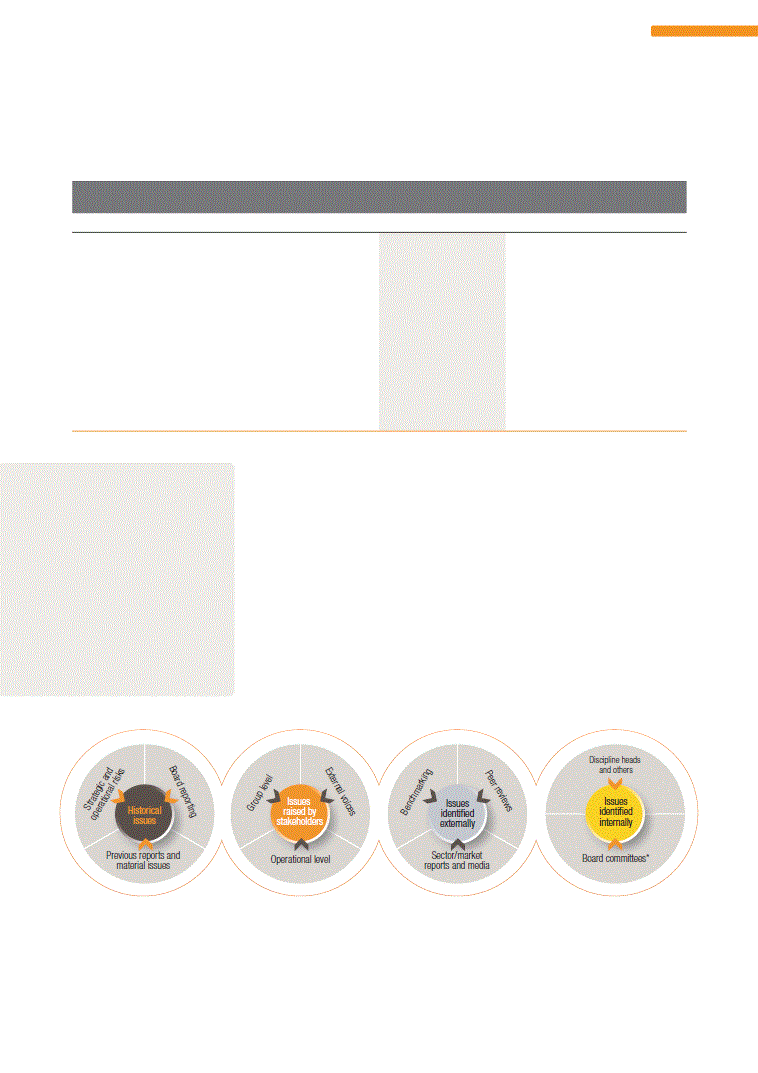
Stakeholder group and engagement
Issues raised
Impact on stakeholder group and
impact on company
Financiers, investors and potential investors
We communicate regularly with our shareholders, investors,
potential investors and the providers of capital, in person and
by email, at our quarterly and annual results presentations,
conference calls, site visits, investor conferences and at one-on-
one meetings.
Underscoring this communication is compliance with the
regulations of the various exchanges on which we are listed.
•
Operational
performance and
business sustainability
•
Financial performance
•
Labour relations
•
Safety performance
•
Regulatory issues
•
Shareholder returns
•
Rehabilitation provision
Outward: Engagement can enhance
the valuation and credit rating of our
company and our access to cost-
efficient capital.
Inward: During 2014, successfully
arranged new facilities with extended
maturity profiles and the easing of
banking covenants. A proposed
corporate restructuring and capital
raising transaction were cancelled
after extensive engagement with and
feedback from shareholders.
For further information on our stakeholder engagement see >SDR at www.aga-reports.com/14/sdr/.
MATERIALITY AND REPORTING
Selecting the issues for inclusion in our reporting is challenging in a company of the size and
diversity of AngloGold Ashanti. Our approach to content selection builds on an understanding
of the major challenges faced during the year and includes a reflection on what we seek to
achieve through our reporting and who we see as the primary audience. For the >IR, this
primary audience is the providers of capital.
The materiality process adopted is based on guidance provided by the International Integrated
Reporting Council (IIRC), of which AngloGold Ashanti is a pilot member, and of the Global
Reporting Initiative’s (GRI) G4 guidelines, as well as the AccountAbility AA1000 Stakeholder
Engagement Standard. The process involved gathering data from stakeholder engagements
which have taken place across the organisation to identify the issues of greatest concern.
Surveys within the company and with external stakeholders provided insight into their views
of our reporting.
The Audit and Risk Committee and
the Social, Ethics and Sustainability
Committee have reviewed the issues
identified, as well as the final report,
to determine whether:
• the material issues for reporting
the Social, Ethics and Sustainability
Committee have reviewed the issues
identified, as well as the final report,
to determine whether:
• the material issues for reporting
represented a balanced and
comprehensive view of the critical
areas of concern for the business
and for stakeholders
comprehensive view of the critical
areas of concern for the business
and for stakeholders
•
there were additional or emerging
issues not identified but which
should be included
should be included
See also the >SDR at www.aga-
reports.com/14/sdr/material-issues.
STRATEGY
* These committees are the Audit and Risk and the Social, Ethics and Sustainability committees.
41
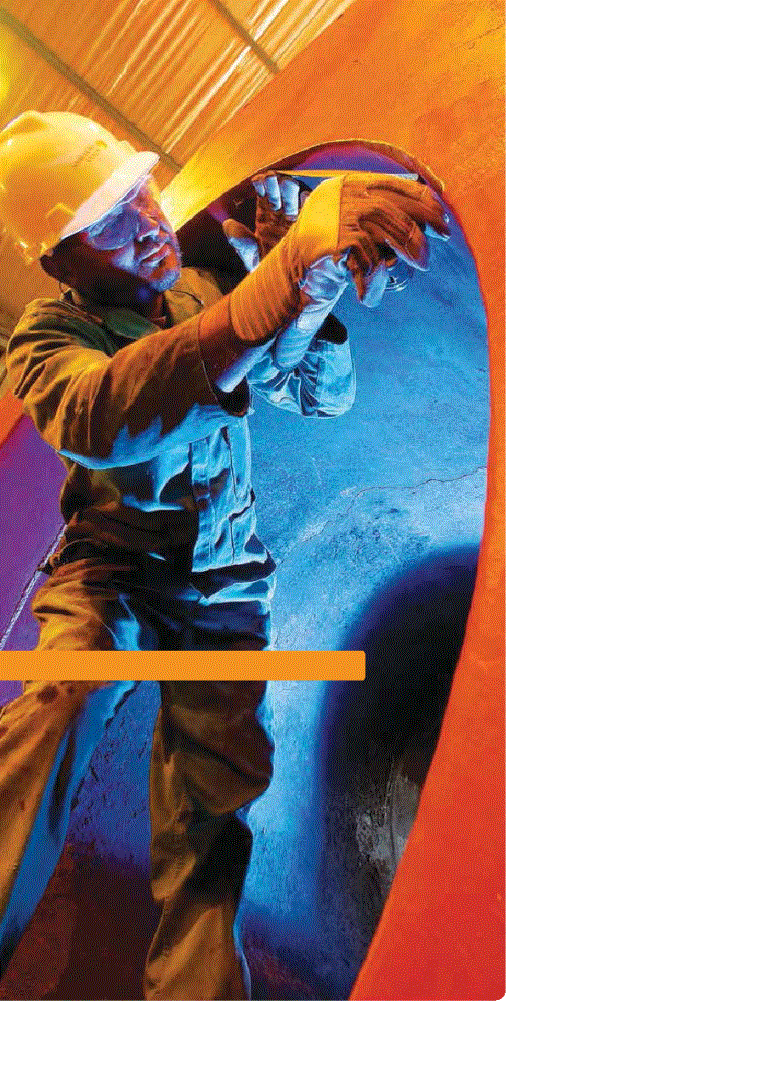
P42-63
43
CEO’s review and strategic
outlook
outlook
46
CFO’s report
52
Board of directors
58
Executive management
60
Managing our human
resources
resources
A DECISIVE
STRATEGIC
RESPONSE
TO A LOWER
GOLD PRICE
In this section, senior
members of the
organisation review
AngloGold Ashanti’s
performance for the year
and the steps taken to
achieve our strategic
objectives. Also discussed
is the outlook for
the company.
members of the
organisation review
AngloGold Ashanti’s
performance for the year
and the steps taken to
achieve our strategic
objectives. Also discussed
is the outlook for
the company.
LEADERSHIP
INTEGRATED REPORT
2014
42

CEO’S REVIEW AND STRATEGIC OUTLOOK
Fellow shareholders and stakeholders,
After another eventful year, it is useful to reflect on how far we have
come in the past two years in particular, and how well AngloGold Ashanti
has responded to the immense challenges faced by our industry.
come in the past two years in particular, and how well AngloGold Ashanti
has responded to the immense challenges faced by our industry.
I write this year’s letter with optimism for what the coming years have in store for our company’s
fortunes, and trust you will share these sentiments after reflecting on an impressive slate
of achievements.
Our strategy that was built on five pillars namely – a strong foundation of safety, people and
sustainability; financial flexibility; optimising expenditure; improving the quality of the portfolio;
and preserving long-term optionality – continues to enable us to improve sustainable free
cash flow and returns. We are on course to become a stronger, more cost focused and
responsive company that can provide the gold price leverage that investors in the sector
are seeking.
Operating in a business fighting a downturn, caused by a sharp fall in the price of its outputs,
is always challenging. After the drop in the gold price in 2013 we needed to take quick,
decisive action to reduce spending and increase not only the quantity, but also the quality of
our production. We did just that, while maintaining our long-term potential and improving our
industry-leading safety record. This team’s achievements of the past two years – to name only a
few – are significant:
•
In safety and across all sustainability disciplines, we delivered our best ever two years in
the company’s history, with strong gains across all metrics. We reduced fatal accidents by
two-thirds in 2013 and by a further 25% in 2014, creating new milestones across all mines
and regions. Year-on-year we had 20% fewer injuries, which is a remarkable achievement.
In addition, we ended 2014 with the fewest number of reportable environmental incidents
recorded in the company’s history and we have continued to improve our relationships with
host communities and governments.
•
After a decade of shrinking production, our team has delivered the first two consecutive
years of production growth of some 12% when compared to our 2012 base and 8% when
compared to 2013. We also delivered two significant growth projects on time and on
budget. While this growth was encouraging, it bears repeating that our ongoing focus will be
to enhance margins of a quality production base.
•
We have delivered a sustainable step reduction in costs, regardless of which metric
one views – whether it be operating costs, overheads, capital expenditure or expensed
exploration. Our all-in sustaining costs for 2014 at $1,026/oz dropped 13% from $1,174/oz
in 2013. All-in costs fell 22% to $1,148/oz over the same period.
•
Turning to portfolio improvement, we commissioned two new projects on time and on budget
and sold Navachab (one of our non-core mines). Importantly, we successfully planned for,
and implemented the transition of Obuasi to limited operations phase, a much needed and
bold decision to stem significant cash outflows and start in earnest the process to reposition
that operation as a potential future growth engine of our group.
•
We delivered the maiden Mineral Resource from the 23Moz (gold equivalent) Nuevo Chaquiro
deposit in Colombia.
•
For eight consecutive quarters, we have delivered on our production, cost and capital
expenditure guidance presented to the market. This is unprecedented.
•
Finally, we have, despite a 10% fall in the gold price, turned around the free cash flow of the
business from a significant cash outflow in 2013 to a positive cash flow (before certain once-
off payments) in 2014.
Srinivasan Venkatakrishnan (Venkat)
Chief Executive Officer
LEADERSHIP
“
I write this year’s
letter with optimism for
what the coming years
have in store for our
company’s fortunes,
and trust you will
share these sentiments
after reflecting on an
impressive slate
of achievements.”
what the coming years
have in store for our
company’s fortunes,
and trust you will
share these sentiments
after reflecting on an
impressive slate
of achievements.”
43
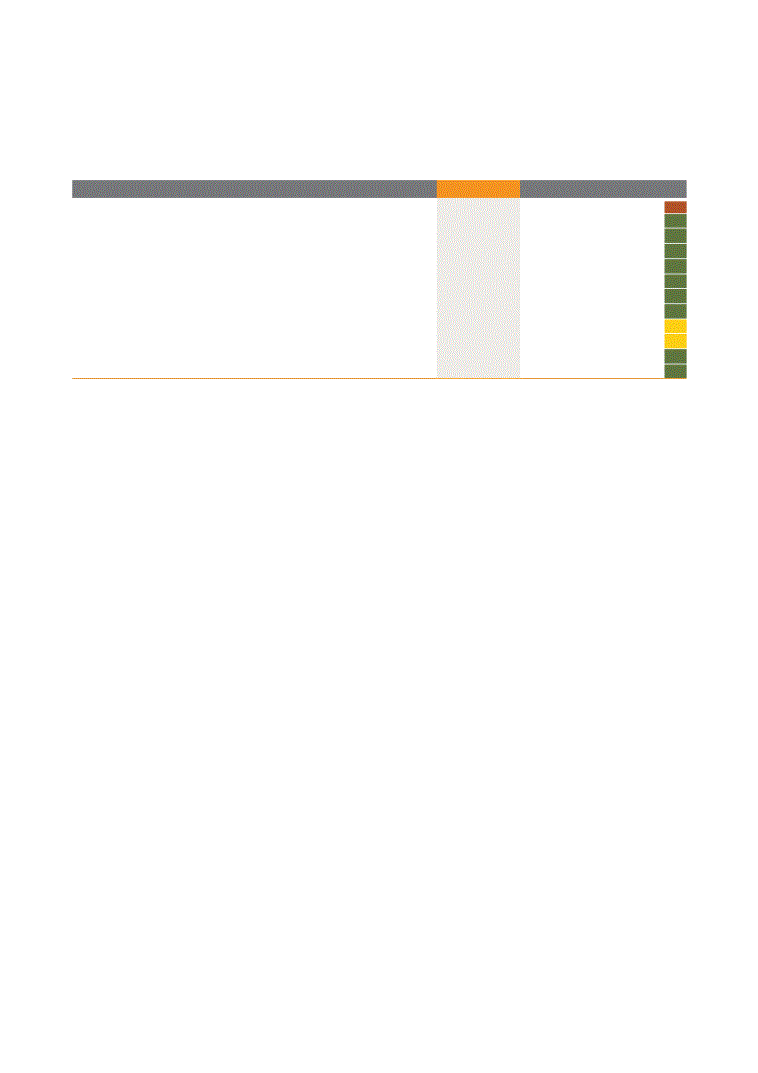
Particulars
2014
2013
Change
Gold price received
$/oz
1,264
1,401
(10%)
Gold production
000oz
4,436
4,105
8%
Total cash costs
$/oz
787
830
(5%)
Corporate and marketing costs
$m
92
201
(54%)
Exploration and evaluation costs
$m
144
255
(44%)
Capital expenditure
(1)
$m
1,209
1,993
(39%)
All-in sustaining costs
$/oz
1,026
1,174
(13%)
All-in costs
(2)
$/oz
1,148
1,466
(22%)
Cash inflow from operating activities
$m
1,220
1,246
(2%)
Adjusted EBITDA
$m
1,665
1,667
0%
Free cash outflow
$m
(112)
(1,058)
89%
Free cash inflow/(outflow)
(3)
$m
142
(1,058)
113%
(1)
Includes equity-accounted investments.
(2)
World Gold Council standard, excludes stockpiles written off.
(3)
Excluding Obuasi redundancies and Rand Refinery loan.
These results show rigorous cost management, disciplined capital allocation and, above all,
expert operational management by our teams on the ground with good support from other
disciplines. In achieving these outcomes we have honoured commitments to our longstanding
supporters and investors and defied the sceptics who believed this performance could not
be sustained. In this regard, I would like to thank our Chairman, Board of Directors, my
colleagues on the Executive Committee and especially every employee in AngloGold Ashanti
for the hard work that resulted in these remarkable achievements and consistency.
expert operational management by our teams on the ground with good support from other
disciplines. In achieving these outcomes we have honoured commitments to our longstanding
supporters and investors and defied the sceptics who believed this performance could not
be sustained. In this regard, I would like to thank our Chairman, Board of Directors, my
colleagues on the Executive Committee and especially every employee in AngloGold Ashanti
for the hard work that resulted in these remarkable achievements and consistency.
We bid a fond farewell to Richard Duffy who left us as CFO in 2014 after a long and distinguished
career with AngloGold Ashanti and wish him well in all his future endeavours. At the same time,
we are pleased to welcome Christine Ramon as CFO. Christine comes with an impressive
pedigree in senior professional and executive positions, both in South Africa and abroad.
career with AngloGold Ashanti and wish him well in all his future endeavours. At the same time,
we are pleased to welcome Christine Ramon as CFO. Christine comes with an impressive
pedigree in senior professional and executive positions, both in South Africa and abroad.
You will recall our announcement on 10 September 2014 of our intention to engage
shareholders in a plan to split the company into separate South African and international
components (the latter to be listed in London). The plan was to have been facilitated
by a $2bn rights offer which would have left the South African vehicle debt free and the
international vehicle with a level of borrowings it could sensibly service, albeit with residual
debt guarantees from the South African company. (Details of the plan and its rationale can
be read here http://www.anglogoldashanti.com/en/Media/Special/CountryCheck.html). This
was one of a range of strategic options that were open to us, and was one we believed
would liberate significant value over the long term by creating two investment vehicles,
each with distinct qualities and asset portfolios. Following consultations with our investors
we withdrew the proposal given that the equity injection required to facilitate the split was
deemed too onerous. We remain a unified entity with a diverse portfolio of gold-producing
assets and exploration prospects, and have in place a strategy to reduce debt, principally
from internal sources.
shareholders in a plan to split the company into separate South African and international
components (the latter to be listed in London). The plan was to have been facilitated
by a $2bn rights offer which would have left the South African vehicle debt free and the
international vehicle with a level of borrowings it could sensibly service, albeit with residual
debt guarantees from the South African company. (Details of the plan and its rationale can
be read here http://www.anglogoldashanti.com/en/Media/Special/CountryCheck.html). This
was one of a range of strategic options that were open to us, and was one we believed
would liberate significant value over the long term by creating two investment vehicles,
each with distinct qualities and asset portfolios. Following consultations with our investors
we withdrew the proposal given that the equity injection required to facilitate the split was
deemed too onerous. We remain a unified entity with a diverse portfolio of gold-producing
assets and exploration prospects, and have in place a strategy to reduce debt, principally
from internal sources.
As we now look to 2015 and beyond, I am optimistic of what we can deliver as a company to our
colleagues, shareholders and the broader stakeholder group. Despite our defensive approach in
the last two years, let us not forget that we have not only grown production for the first time, but
also increased margins. We now need to position the group on this strong foundation to show
visibility both in terms of further quality long-term growth and value creation – and we will do that.
As we start 2015, our priorities over the next few years will include:
colleagues, shareholders and the broader stakeholder group. Despite our defensive approach in
the last two years, let us not forget that we have not only grown production for the first time, but
also increased margins. We now need to position the group on this strong foundation to show
visibility both in terms of further quality long-term growth and value creation – and we will do that.
As we start 2015, our priorities over the next few years will include:
•
Safety and health: Improving safety and health at every level in order to achieve our ultimate
goal of zero harm and, in so doing, eliminating the disruptions that poor safety records bring
to affected operations. We remember our colleagues who passed away during the year and
remain committed to employing all effort and technology as we strive to achieve zero harm.
to affected operations. We remember our colleagues who passed away during the year and
remain committed to employing all effort and technology as we strive to achieve zero harm.
•
Environment and communities: Continuing to forge closer partnerships with our host
communities and improving our environmental performance and compliance to ensure we
maintain our licence to operate for our mutual benefit.
maintain our licence to operate for our mutual benefit.
CEO’S REVIEW AND STRATEGIC OUTLOOK continued
“
I would like to
thank our Chairman,
Board of Directors,
my colleagues on the
Executive Committee
and especially every
employee in AngloGold
Ashanti for the hard
work that resulted
in these remarkable
achievements and
consistency.”
Board of Directors,
my colleagues on the
Executive Committee
and especially every
employee in AngloGold
Ashanti for the hard
work that resulted
in these remarkable
achievements and
consistency.”
INTEGRATED REPORT 2014
44

•
People: Developing our team of top talent across all disciplines, so that we have the right
people, and in some cases new entrants to inject fresh thinking into certain roles, to help
deliver the value creation needed. I remain acutely aware of the retrenchments undertaken
over the past two years, a necessary action in the market environment in which we found
ourselves, and I realise how difficult these were for all concerned. For those that remain, we
are focused on fostering cohesion and developing our teams across the business.
people, and in some cases new entrants to inject fresh thinking into certain roles, to help
deliver the value creation needed. I remain acutely aware of the retrenchments undertaken
over the past two years, a necessary action in the market environment in which we found
ourselves, and I realise how difficult these were for all concerned. For those that remain, we
are focused on fostering cohesion and developing our teams across the business.
•
Production and costs: Realising our planned production and cost targets for 2015 and
beyond, which will require everyone in this business to remain vigilant in keeping productivity
and efficiency at the forefront of everything we do. Achieving our cost and production
budgets, every month and every quarter, remains critical.
beyond, which will require everyone in this business to remain vigilant in keeping productivity
and efficiency at the forefront of everything we do. Achieving our cost and production
budgets, every month and every quarter, remains critical.
•
Balance sheet flexibility: As we have mentioned since the latter part of 2014, we will work
actively to reduce our net debt levels over the next two to three years to provide the company
with greater financial flexibility. But in doing so, we will not act in haste nor compromise long-term
value. As one of a number of options in this regard, we have initiated a plan to identify a joint
venture partner or purchaser in respect of our interests in the CC&V mine in the United States.
with greater financial flexibility. But in doing so, we will not act in haste nor compromise long-term
value. As one of a number of options in this regard, we have initiated a plan to identify a joint
venture partner or purchaser in respect of our interests in the CC&V mine in the United States.
•
Providing clearer visibility to longer-term growth and value creation: We will build on
the production and margin growth that we have delivered, and continue to focus on key
differentiating characteristics of our portfolio, including:
the production and margin growth that we have delivered, and continue to focus on key
differentiating characteristics of our portfolio, including:
•
South Africa: Our South African assets need to deliver to their full potential. We will need
to show that our sustainable cash generation ability from these assets will continue to
outpace our peers, given the superior quality and unique long-life nature of our asset
base. Our South African reef-boring technology also provides us with a strong positive
differentiator which we aim to ramp up to show value creation from our asset base.
to show that our sustainable cash generation ability from these assets will continue to
outpace our peers, given the superior quality and unique long-life nature of our asset
base. Our South African reef-boring technology also provides us with a strong positive
differentiator which we aim to ramp up to show value creation from our asset base.
•
CC&V expansion: With the high-grade mill spinning for the first time in early 2015, the
mine life extension for this mine is firmly on the horizon, consolidating a much sought after
tier-one asset in a prized geography.
mine life extension for this mine is firmly on the horizon, consolidating a much sought after
tier-one asset in a prized geography.
•
Obuasi: Despite its disappointing history, we should not underestimate what this asset
has to offer as a growth engine for the group. Having moved the asset to limited operating
phase and having begun to shed legacy cost structures that crippled the mine, our focus
now has moved into delivering a feasibility study that will position the underground mine
to being a more focused, efficient, mechanised, high-grade operation with an attractive
cost structure and returns. The coming years will represent a critical inflection point for this
mine as it attempts to transition into a tier-one asset.
has to offer as a growth engine for the group. Having moved the asset to limited operating
phase and having begun to shed legacy cost structures that crippled the mine, our focus
now has moved into delivering a feasibility study that will position the underground mine
to being a more focused, efficient, mechanised, high-grade operation with an attractive
cost structure and returns. The coming years will represent a critical inflection point for this
mine as it attempts to transition into a tier-one asset.
•
Other life-extension opportunities in our international portfolio: The 2014 planning
process showed us what levers we could pull to generate value regarding investment in
value-creating mine-life extensions at our other operations, particularly those in Australia,
Tanzania, the DRC, Ghana, Guinea and Brazil. We will continue to explore these options
and view them through the prism of capital discipline.
process showed us what levers we could pull to generate value regarding investment in
value-creating mine-life extensions at our other operations, particularly those in Australia,
Tanzania, the DRC, Ghana, Guinea and Brazil. We will continue to explore these options
and view them through the prism of capital discipline.
•
Optionality from Colombia: 2015 remains a critical year for us and further opportunities
will be explored in developing the Colombian portfolio.
will be explored in developing the Colombian portfolio.
•
Exploration: Over the last two years we have had to cut our spending and land holding
significantly, focusing on the most prospective geology and jurisdictions in the portfolio.
It is a necessary trade-off in prevailing market conditions. Against the back drop of our
improved operating portfolio, we will continue to refine our exploration programme with a
sharper focus and strict return requirements in our key operating countries.
significantly, focusing on the most prospective geology and jurisdictions in the portfolio.
It is a necessary trade-off in prevailing market conditions. Against the back drop of our
improved operating portfolio, we will continue to refine our exploration programme with a
sharper focus and strict return requirements in our key operating countries.
Clearly, there remains much for us still to do. The team here is well placed to deliver on our
vision of creating a focused portfolio of lower-cost, long-life, high-quality assets that will enable
us to achieve sustainable cash flow improvements and returns. We will continue to keep you
apprised of important developments throughout the course of the year.
vision of creating a focused portfolio of lower-cost, long-life, high-quality assets that will enable
us to achieve sustainable cash flow improvements and returns. We will continue to keep you
apprised of important developments throughout the course of the year.
Best regards
Srinivasan Venkatakrishnan
Chief Executive Officer
Chief Executive Officer
19 March 2015
“
Clearly, there remains
much for us still to
do, but the team
here is well placed
to demonstrate again
that it can deliver
excellence.”
do, but the team
here is well placed
to demonstrate again
that it can deliver
excellence.”
45

CFO’S REPORT
Delivered on consistent production and cost guidance amidst
continuing adverse market conditions. Our focus remains on
strengthening the balance sheet in the medium term and creating a
prudent buffer for volatility.
continuing adverse market conditions. Our focus remains on
strengthening the balance sheet in the medium term and creating a
prudent buffer for volatility.
HIGHLIGHTS
•
Production of 4.436Moz – up 8% year-on-year
•
Total cash costs of $787/oz – 5% lower year-on-year
•
All-in sustaining cost of $1,026/oz – 13% lower year-on-year
•
Capital expenditure of $1.2bn – 39% below 2013
•
Exploration and evaluation costs $144m – 44% lower year-on-year
•
Adjusted EBITDA stable at $1,665m despite a 10% drop in gold price
•
Self-help measures progressed to deleverage in medium term
•
Free cash outflow shows strong improvement to $112m from $1,058m
EXECUTIVE SUMMARY
The year under review was marked by a further fall in the gold price, which decreased by
$137/oz or 10% over the course of the year. The impact of the drop in the gold price has been
proactively managed and the 2014 results reflect consistent operational and cost performance.
It is the second consecutive year of growth in gold production, with an overall 8% increase
being recorded year-on-year. At the same time, all-in sustaining costs per ounce improved by
13% year-on-year.
Significantly lower year-on-year total cash and all-in sustaining costs were achieved through
the combination of production and overall cost improvements reflecting the first full year of
operations at our two new low-cost mines (Kibali and Tropicana). In addition, our efforts to
tackle costs across a broad front underpinned the improvement in margins, through the Project
500 (P500) initiative, reductions in direct operating costs, corporate overheads and exploration
costs, and strict capital allocation.
We continue to focus on ‘self-help measures’ in three areas:
•
Review of the asset portfolio while actively seeking joint-venture partnerships in Colombia
and at Obuasi as well as pursuing the potential sale or joint venture of an operating asset
•
Cash flow improvements through the optimisation of business plans and consolidation of
regional hubs
•
Leverage to exploit weaker currencies, and the consequently higher price in terms of these
currencies, and lower fuel prices.
Christine Ramon
Chief Financial Officer
INTEGRATED REPORT 2014
46

LEADERSHIP
One of our five core strategic focus areas is to ‘ensure financial flexibility’ which means
structuring our balance sheet to allow us to meet our core funding requirements and to provide
a reasonable buffer for gold price volatility as well as other adverse unforeseen events. To
ensure continued flexibility in the debt maturities schedule, refinancing of the group’s revolving
credit facilities (RCFs) was completed mid-year. The new $1bn RCF and A$500m RCF were
agreed during July 2014 for a further five-year period. In addition, a looser financial covenant
was concluded, with the net debt to adjusted EBITDA covenant at 3.5 times (previously 3
times), with one six month period waiver of up to 4.5 times, subject to certain conditions. The
$ and A$ RCFs have also been priced tightly, to reflect the current financial market conditions.
The looser covenant is also applicable to the ZAR RCF.
AngloGold Ashanti’s credit rating was reviewed by both Moody’s Investor Service and
Standard and Poor’s (S&P), to Baa3 with a negative outlook and BB+ with a negative outlook,
respectively. The Moody’s rating places the company at the lowest level of investment credit
grade and S&P has the company at the top level of sub-investment credit grade. These ratings
remained unchanged.
The group’s balance sheet is highly geared and efficiently structured and the debt has long-
dated maturities. Apart from the R750m bond maturing in 2016 and the R1.5bn RCF which
matures in December 2018, the earliest international bond maturity date is in April 2020. The
high-yield bond ($1.25bn: 8.5%) issuers’ call can only be exercised from July 2016 onwards, at
the group’s discretion, allowing sufficient time for the group to explore any ‘self-help measures’
ahead of any options around refinancing or early redemption being assessed. The conclusion
of a potential asset sale and joint venture partnerships should help the group determine
whether or not to exercise the high yield bond call option.
Net debt and gold price
($bn)($/oz)
•
Kibali/Tropicana – developed
•
MWS/Serra Grande – acquired
0.0
0.5
1.0
1.5
2.0
2.5
3.0
3.5
3.13
3.11
2.06
0.61
1.29
10
11
12
13
14
500
1,000
1,500
2,000
Net debt
Gold price
0.0
0.5
1.0
1.5
2.0
2.5
3.0
0
1
2
3
1.22
1.25
1.97
2.81
1.67*
10
11
12
13
14
Cash flow from operating activities
Capital expenditure
Cash flow from operating activities
and total capital spend
and total capital spend
($bn)
* Excludes hedge buy-back costs
47
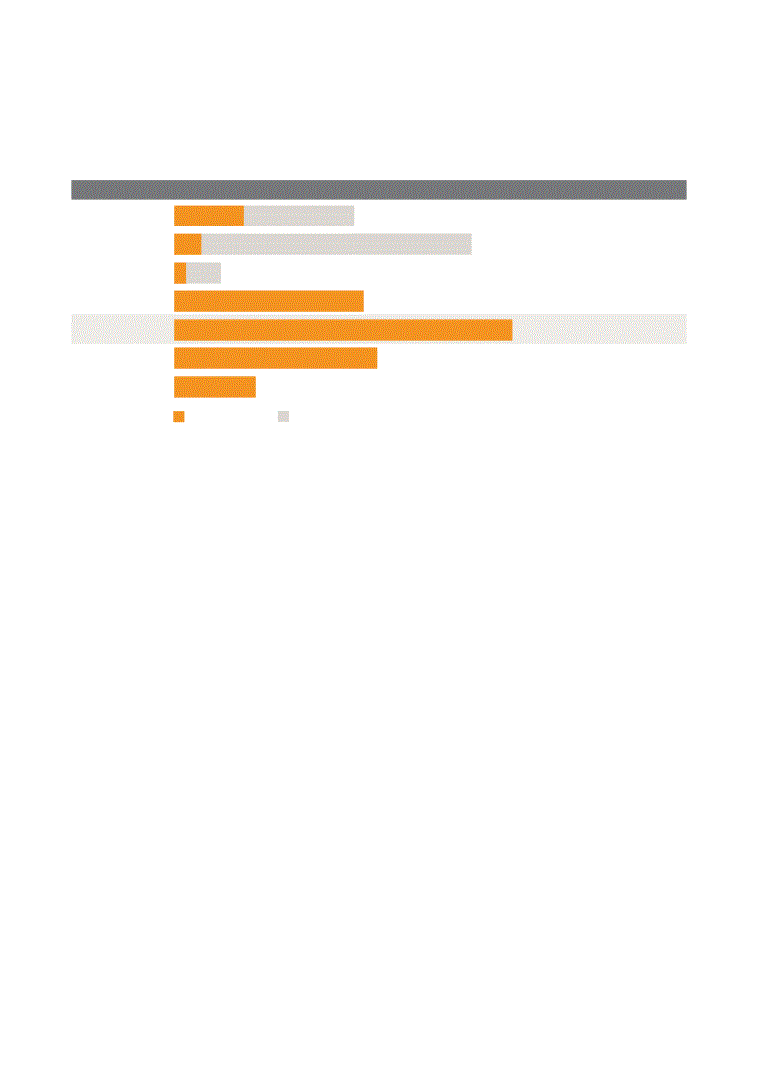
CFO’S REPORT continued
Our medium term leverage target is 1.5 times net debt to adjusted EBITDA. We would like
to reduce our debt by approximately $1bn to take us to our comfort threshold which would
include a reasonable buffer for volatility, including the gold price risk and production disruptions.
Our aim is to achieve this debt reduction through a variety of ‘self-help measures’ as elaborated
above. Importantly we are under no external pressure to achieve this. This is an aspirational
target that can be achieved over the next few years.
Delivery against 2014 financial objectives
Continue to maintain sufficient balance sheet liquidity and flexibility in a
lower gold price environment
lower gold price environment
The temporary relaxation of the banking covenant of 4.5 times net debt to adjusted EBITDA
expired with the June 2014 testing period, while the $ and A$ revolving credit facilities are set
to mature within the next five-year period. The group therefore moved prudently and proactively
to manage its financial flexibility and steps taken in this regard included:
•
Successful re-financing in July 2014 of the group’s RCFs for another five years, including
the $1bn RCF (which was due to mature in July 2017) and the A$500m RCF (replacing the
previous A$600m RCF which was due to mature in December 2015)
•
Improved financial flexibility – the new banking covenant of 3.5 times – previously 3 times net
debt to adjusted EBITDA (with a one six month period waiver of up to 4.5 times subject to
certain conditions) – is applicable to all of the group’s RCFs. This adds further flexibility to the
balance sheet liquidity especially in the light of the ongoing gold price volatility and prevailing
labour uncertainty in South Africa
Debt type
International debt facilities US$m*
Maturity date
Base currency
A$ RCF*
Jul 2019
AUD
US$ RCF
Jul 2019
USD
ZAR RCF*
Dec 2018
ZAR
5.375% bond
Apr 2020
USD
8.500% bond
Jul 2020
USD
5.125% bond
Aug 2022
USD
6.50% bond
Apr 2040
USD
Drawn amount
Facility amount
*
Excludes DMTNP and local bond amounts outstanding at 31 December of $80m, ZAR calculated at R11.6/$, A$ facility calculated at A$0.8/$.
408
257
1,000
700
1,250
750
300
130
100
700
1,250
750
300
43
INTEGRATED REPORT 2014
48

LEADERSHIP
•
Managed net debt levels in 2014 – the group’s net debt to adjusted EBITDA covenant
ratio was 1.88 times at year end and was in line with the 1.86 of a year earlier, despite the
reduction in the gold price, additional funding required for the Obuasi redundancies and a
loan to Rand Refinery. Subsequent to year end, external audit procedures confirmed that
the gold gap at Rand Refinery has not increased. Therefore any additional loan funding
requirements from shareholders are not envisaged at this stage.
Maintaining our focus on the management of costs to deliver competitive
all-in sustaining and all-in costs and continuing to target sustainable cash
generation
all-in sustaining and all-in costs and continuing to target sustainable cash
generation
Management’s initiatives to deliver on competitive all-in sustaining and all-in costs included:
•
The initial stated purpose of P500 was to deliver specific targeted cost reductions. These have
now been achieved and exceeded, and are reconciled with the financial reporting systems
•
The organisational redesign was completed and corporate costs as well as exploration costs
were significantly reduced from 2013’s levels
•
Capital expenditure has reduced by 39% compared to 2013 reflecting project completion
and capital prioritisation
•
We delivered free cash flow of $142m for 2014 which excludes the proceeds of $105m from
the sale of Navachab, despite a 10% drop in the gold price compared to 2013, before taking
into account the once-off non-operational cash outflows relating to the Obuasi redundancy
payments and the Rand Refinery loan funding.
Our 2015 objectives
Looking ahead to 2015, the key financial objectives are to:
•
Continue to focus on self-help measures (including the potential sale or joint venture of an
operating asset) to deleverage the balance sheet in order to maintain sufficient liquidity and
flexibility in a lower gold price environment
•
Focus on financial and project risk mitigation by seeking joint venture partners for Colombia
and Obuasi
•
Review the asset portfolio with a view to rebalancing the portfolio with more-profitable ounces
•
Maintain our focus on cost and capital discipline to deliver competitive all-in sustaining costs
and all-in costs
•
Continue to target sustainable cash generation. For 2015, significant cost reductions have
been included in the annual business plans.
We are expecting our debt levels to remain steady at the end of 2015, taking into account our
estimated production, planned expenditures at budgeted exchange rates and commodity and
fuel price assumptions, although it may increase slightly in the first half due to free cash flow
profiling in South Africa from production and capital expenditure fluctuations. This excludes any
proceeds from asset sales or joint venture partnerships that we may consider pursuing or the
impact of any operational or other disruptions.
49

In addition to a strong leverage to the gold price, our group’s operations also leveraged to
both the weaker average global currencies and the lower average oil price, which benefits our
cash costs. In 2014, the drop in the gold price was partially offset by weaker global currencies
and the lower average oil price. In addition, the combination of just over 70% of the group’s
adjusted EBITDA from our international operations emphasises our geographical diversification
and resilience to unforeseen production disruptions in the South African region.
Events subsequent to year end
AngloGold Ashanti currently considers joint venturing or selling its interest in the
CC&V mine
The company has initiated a plan to identify a joint venture partner or a purchaser in respect of its
interest in the CC&V mine in Colorado in the United States for full value. The CC&V gold mine is
a surface mining operation which provides oxidised ore to a crusher and valley leach facility, one
of the largest in the world. It is included in the Americas reporting segment and was acquired by
AngloGold Ashanti in 1999. The mine produced 211,000 ounces of gold in 2014. There can be
no assurance, however, that a sale and purchase agreement for this transaction will be entered
into or that any sales transaction will be completed.
AngloGold Ashanti currently considers selling its interests in Société d’Exploitation
des Mines d’Or de Sadiola S.A. (Sadiola) and Société d’Exploitation des Mines d’Or de
Yatela S.A. (Yatela)
The company currently intends to dispose of its 41% stake in Sadiola and its 40% stake in
Yatela. The mines are both situated in western Mali and are included in the Continental Africa
reporting segment. The Sadiola and Yatela mines produced 85,000 and 11,000 attributable
ounces of gold, respectively, in 2014.
Management was approached by a potential buyer for both mines who meets management’s
qualifying criteria and has asked for a binding bid. There can be no assurance, however, that
a sale and purchase agreement for these transactions will be entered into or that any sales
transactions will be completed.
ACKNOWLEDGEMENT
I took over the role of Chief Financial Officer at AngloGold Ashanti with effect from 1 October
2014. The transition from my predecessor Richard Duffy was seamless, thanks to a strong and
diligent financial team in the group. Our team, through their understanding of the challenging
economic and financial pressures, has helped us proactively manage the financial position
of the company. In addition, we have been able to deliver quality financial information to our
stakeholders which reflects our objectives and values for long-term success. I would like to
thank our strong and enthusiastic financial team in the group for their ongoing support and look
forward to the year ahead.
Best regards
Christine Ramon
Chief Financial Officer
19 March 2015
CFO’S REPORT continued
INTEGRATED REPORT
2014
50

LETTER FROM CHAIRMAN OF THE AUDIT AND RISK COMMITTEE
On behalf of the Audit and Risk Committee of AngloGold Ashanti, I am
pleased to recommend to shareholders and other stakeholders our >IR.
pleased to recommend to shareholders and other stakeholders our >IR.
It is the Audit and Risk Committee’s principal regulatory duty to oversee the integrity of the
group’s internal control environment and to ensure that financial statements are appropriate
and comply with International Financial Reporting Standards (IFRS) and fairly present the
financial position of the group and company and the results of their operations.
This committee also monitors the integrity of the group’s integrated reporting and annual
financial statements and all factors and risks that may impact on reporting and is satisfied that
these do not conflict with the financial results.
This report has been produced in line with the recommendations contained in King III and has
been guided by the framework published by the International Integrated Reporting Council
(IIRC) in December 2013. AngloGold Ashanti supports the work done by the IIRC and has been
a member of the group of pilot companies that have sought to implement integrated reporting.
This report subscribes to the principles embedded within the IIRC framework.
The company has continued to make progress in its journey towards integrated reporting.
In the year ahead we will continue to focus on the effectiveness of our risk management
processes. We will also continue with the integration of the combined assurance process
within AngloGold Ashanti to ensure value is derived through the various assurance processes.
Rhidwaan Gasant
Chairman: Audit and Risk Committee
19 March 2015
Rhidwaan Gasant
Chairman: Audit and Risk Committee
LEADERSHIP
51

BOARD OF DIRECTORS
AngloGold Ashanti has a unitary board comprising 11 directors – nine
independent, non-executive directors and two executive directors. The
board’s overall aim is to provide strategic leadership in ensuring the long-
term sustainability and success of the business.
independent, non-executive directors and two executive directors. The
board’s overall aim is to provide strategic leadership in ensuring the long-
term sustainability and success of the business.
BOARD COMMITTEES
INDEPENDENT
NON-EXECUTIVE
DIRECTORS
NON-EXECUTIVE
DIRECTORS
SM Pityana (Chairman)
LW Nkuhlu (Deputy Chairman)
A Garner *
R Gasant
DL Hodgson
NP January-Bardill
MJ Kirkwood
M Richter *
RJ Ruston
LW Nkuhlu (Deputy Chairman)
A Garner *
R Gasant
DL Hodgson
NP January-Bardill
MJ Kirkwood
M Richter *
RJ Ruston
AUDIT AND RISK
COMMITTEE
COMMITTEE
R Gasant **
A Garner
LW Nkuhlu
MJ Kirkwood
M Richter
RJ Ruston
A Garner
LW Nkuhlu
MJ Kirkwood
M Richter
RJ Ruston
ASSURANCE
Internal Audit
Combined Assurance
Combined Assurance
RISK MANAGEMENT
GLOBAL IT STEERING
COMMITTEE
COMMITTEE
External Audit
SOX Compliance
Ore Reserve and
Mineral Resource
Mineral Resource
SOCIAL, ETHICS AND
SUSTAINABILITY
COMMITTEE
SUSTAINABILITY
COMMITTEE
NP January-Bardill **
DL Hodgson
SM Pityana
S Venkatakrishnan
DL Hodgson
SM Pityana
S Venkatakrishnan
INVESTMENT
COMMITTEE
COMMITTEE
RJ Ruston **
A Garner
R Gasant
DL Hodgson
LW Nkuhlu
KC Ramon
A Garner
R Gasant
DL Hodgson
LW Nkuhlu
KC Ramon
REMUNERATION AND
HUMAN RESOURCES
COMMITTEE
MJ Kirkwood **
NP January-Bardill
LW Nkuhlu
SM Pityana
M Richter
HUMAN RESOURCES
COMMITTEE
MJ Kirkwood **
NP January-Bardill
LW Nkuhlu
SM Pityana
M Richter
NOMINATIONS
COMMITTEE
COMMITTEE
SM Pityana **
MJ Kirkwood
LW Nkuhlu
MJ Kirkwood
LW Nkuhlu
EXECUTIVE
COMMITTEE
S Venkatakrishnan **
KC Ramon
I Boninelli
CE Carter
GJ Ehm
RW Largent
DC Noko
MP O’Hare
ME Sanz
COMMITTEE
S Venkatakrishnan **
KC Ramon
I Boninelli
CE Carter
GJ Ehm
RW Largent
DC Noko
MP O’Hare
ME Sanz
EXECUTIVE DIRECTORS
S Venkatakrishnan
Chief Executive Officer
Chief Executive Officer
KC Ramon
Chief Financial Officer
Chief Financial Officer
BOARD OF DIRECTORS
** Denotes committee chairman
* Appointed on 1 January 2015
Membership of the board and its committees
INTEGRATED REPORT 2014
52

INDEPENDENT NON-EXECUTIVE CHAIRMAN
Sipho Pityana (55)
BA (Hons), MSc, Dtech (Honoris)
Initially appointed an independent non-executive director on 13 February 2007. Appointed
Chairman on 17 February 2014
Chairman:
•
Nominations Committee
Member:
•
Remuneration and Human Resources Committee
•
Social, Ethics and Sustainability Committee
Sipho Mila Pityana is the Chairman of the Board of Directors, having assumed this role in
February 2014. Sipho has extensive business experience having served in both an executive
and non-executive capacity on several JSE listed boards of companies as well as running
his own company, Izingwe Capital Proprietary Limited, which he chairs. He is chairman of
the JSE-listed Onelogix and of Munich Reinsurance of Africa and a director of a number of
manufacturing companies including Aberdare Cables. He also served on the boards of Bytes
Technology Group, Afrox, SPESCOM the Old Mutual Leadership Group and Scaw Metals. He
previously worked as an executive director of Nedcor Investment Bank and managing director
of Nedbank.
In addition to his private sector track record, Sipho has extensive public sector experience
and international exposure. He was the first Director General of the Department of Labour in a
democratic South Africa. As the Foreign Affairs Director General he represented South Africa
in various international fora including the United Nations, African Union, Commonwealth and
the International Labour Organization. He was one of the founding members of the governing
body of the Commission for Conciliation, Mediation and Arbitration (CCMA) and Convenor of
the South African government delegation to the National Economic Development and Labour
Council (Nedlac). He is a member of the Advisory Council of the Council for the Advancement
of the South African Constitution (CASAC).
DEPUTY CHAIRMAN AND LEAD INDEPENDENT DIRECTOR
Wiseman Nkuhlu (70)
BCom, CA (SA), MBA
Appointed to the board on 4 August 2006, resigned on 30 April 2009 and re-appointed
on 1 June 2009
Member:
•
Audit and Risk Committee
•
Investment Committee
•
Nominations Committee
•
Remuneration and Human Resources Committee
Wiseman Nkuhlu was first appointed to the board on 4 August 2006 and resigned on
30 April 2009. He was re-appointed to the board on 1 June 2009, appointed Lead Independent
Director from February 2014 and Deputy Chairman from March 2014.
LEADERSHIP
53

BOARD OF DIRECTORS continued
Prof Nkuhlu, a respected South African academic, educationist, professional and business
leader, served as Economic Adviser to the former President of South Africa, Mr Thabo
Mbeki, and as Chief Executive of the Secretariat of the New Partnership for Africa’s
Development (Nepad) from 2000 to 2005. From 1989 to 2000, he served as a director
on a number of major South African companies or subsidiaries, including Standard Bank,
South African Breweries, Old Mutual, Tongaat, Hulett, BMW and JCI. Prof Nkuhlu was
president of the South African Institute of Chartered Accountants from 1998 to 2000
and principal and vice chancellor of the University of Transkei from 1987 to 1991. He is
currently a member of the Board of the Ethics Institute of South Africa, Datatec Limited, the
Nepad Business Foundation and the Chartered Director Governing body of the Institute
of Directors in South Africa. He was elected president of the Geneva-based International
Organisation of Employees (IOE) in May 2008 and served for two years. Lastly, he is a
trustee of the International Financial Reporting Standards Foundation which provides
oversight of the accounting standard setting operations of the International Accounting
Standards Board (IASB).
EXECUTIVE DIRECTORS
Srinivasan Venkatakrishnan (Venkat) (49)
BCom, ACA (ICAI)
Chief Executive Officer
First appointed to the board on 1 August 2005 and as CEO on 8 May 2013
Member:
•
Social, Ethics and Sustainability Committee
Venkat was appointed CEO on 8 May 2013, after holding the position of joint acting CEO from
April of that year. He was previously Chief Financial Officer (CFO) at Ashanti Goldfields until its
merger with AngloGold in May 2004, creating what is now AngloGold Ashanti. Venkat became
CFO of the combined entity shortly after the merger and joined the board on 1 August 2005.
He is chairman of the Executive Committee and also a member of the Social, Ethics and
Sustainability Committee.
In his role as CFO, he oversaw funding for all of AngloGold Ashanti’s operating activities,
giving him a detailed knowledge of all of our mines and operating jurisdictions. He is a
member of the Financial Reporting Investigation Panel, an advisory panel of the JSE. He
was the executive responsible for eliminating a 12Moz hedge book, generating significant
value for the company, and was the key executive behind rebuilding the balance sheet
through a series of successful debt financings that introduced long-term tenor and more
favourable funding terms to the company’s credit profile. During Venkat’s first year as CEO
of AngloGold Ashanti, two new mines were commissioned on time and ahead of budget,
the company achieved its best ever safety performance and a significant restructuring was
undertaken of operating and overhead costs in order to focus the business on delivery of
sustainable free cash flow and returns. Venkat was also previously a director of corporate
reorganisation services at Deloitte & Touche in London.
BOARD
CHARACTERISTICS
Composition by HDSA* status
•
HDSA
45
•
Non-HDSA
10
•
Non-South Africans
45
%
*
Historically disadvantaged South African as
defined in terms of the Mining Charter
Length of service on the board
•
Less than two years
36
•
Between two and six years
46
•
More than six years
18
%
Nationality
•
South African
55
•
North American
27
•
British
9
•
Indian/British
9
%
INTEGRATED REPORT
2014
54
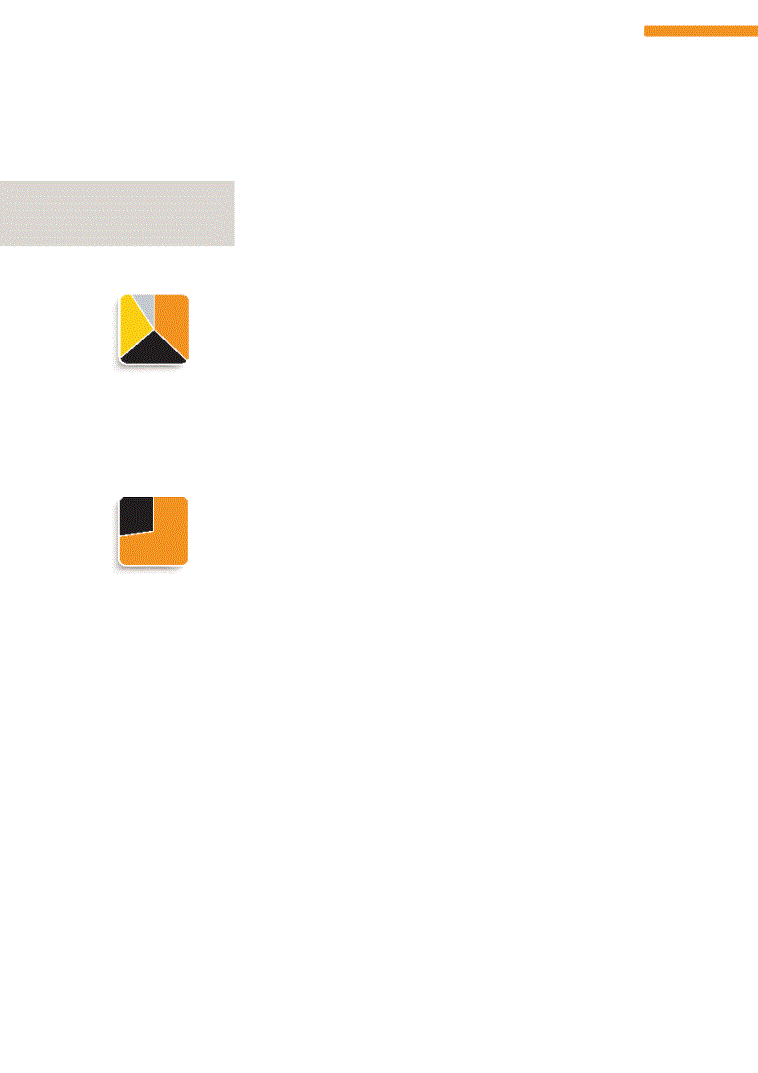
Christine Ramon (47)
BCompt (Hons), CA (SA), Senior Executive Programme
Chief Financial Officer
Appointed to the board as CFO on 1 October 2014
Member:
•
Investment Committee
Christine joined AngloGold Ashanti as CFO and executive director with effect from 1 October
2014, in compliance with the JSE Listings Requirements. Christine has held senior financial
management and executive positions in various companies, in particular as CFO and executive
director of Sasol Limited from 2006 to 2013. Prior to this, she was CEO of Johnnic Holdings
Limited, having previously served as its financial director. Currently, she is a non-executive
director on the boards of MTN Group Limited and Lafarge (France). She previously served on
the boards of Transnet SOC Limited and Johnnic Communications Limited.
Christine is a member of the South African Institute of Chartered Accountants and the Association
for the Advancement of Black Accountants of South Africa. She served previously as a member
of the Standing Advisory Committee to the International Accounting Standards Board and
currently serves as Deputy Chair of the Financial Reporting Standards Council of South Africa.
Christine’s current portfolio includes finance and treasury, insurance services, internal audit,
taxation and information technology.
INDEPENDENT NON-EXECUTIVE DIRECTORS
Albert Garner (59)
BSE, Aerospace and Mechanical Sciences
Appointed to the board on 1 January 2015
Member:
•
Audit and Risk Committee
•
Investment Committee
Albert Garner has extensive experience in capital markets, corporate finance and mergers and
acquisitions having worked with Lazard Frères & Co., LLC for 35 years in various leadership
positions. He is one of the most senior bankers at Lazard, currently leading their special
committee practice and chairing their fairness opinion committee. He formerly led Lazard’s
corporate finance practice. Albert became a general partner in 1989 and is now Vice Chair –
US Investment Banking. Over the past 10 years he has advised and acted as lead adviser to
more than 50 companies and their boards of directors on transformative transactions.
Rhidwaan Gasant (55)
CA (SA)
Appointed to the board on 12 August 2010
Chairman:
•
Audit and Risk Committee
Member:
•
Investment Committee
Rhidwaan Gasant is the former Chief Executive Officer of Energy Africa Limited, and sits on the
boards of international companies and chairs the Audit and Risk Committees of international
companies in the MTN Group. He is currently Chief Executive Officer of Rapid African Energy
Holdings, a start-up oil and gas exploration company, focused on Africa.
LEADERSHIP
Industry sector experience
•
Executive management
37
•
Mining
27
•
Finance
27
•
Mining/finance
9
%
Gender
•
Male
73
• Female
27
%
55

BOARD OF DIRECTORS continued
Dave Hodgson (67)
MSc (Civil Engineering), MSc (Mining) (Hons), BComm, Advanced Management Programme
Appointed to the board on 25 April 2014
Member:
•
Investment Committee
•
Social, Ethics and Sustainability Committee
Dave Hodgson formerly held a series of senior and executive positions over three decades
with the Anglo American and De Beers group of companies, and also held the post of Chief
Operating Officer of AngloGold Ashanti from November 2001 through to his retirement in
April 2005. In addition, he has held non-executive directorships at Moto Gold Mines Limited,
Uranium One Inc., Goliath Gold Mining Limited, Auryx Gold Corporation, Montero Mining and
Exploration Limited, and Acacia Mining.
Nozipho January-Bardill (64)
BA, MA Applied Linguistics, Dipl Human Resources Development
Appointed to the board on 1 October 2011
Chairman:
•
Social, Ethics and Sustainability Committee
Member:
•
Remuneration and Human Resources Committee
Nozipho January-Bardill was an Executive Director, Corporate Affairs and spokesperson of
the MTN Group where she also served on the boards of a number of operations in the MTN
footprint. She is a former South African Ambassador to Switzerland, Lichtenstein and the
Holy See, and former Deputy Director General, Human Capital Management and Head of the
Foreign Service Institute in the then Department of Foreign Affairs (now DIRCO).
She is currently the founder and executive director of Bardill & Associates, a consulting company
focusing on strategic communications, high-level government relations, stakeholder management
and gender equality in the workplace. She serves on the board of Credit Suisse Securities,
Johannesburg and is also a member of the United Nations Expert Committee on the Elimination of
Racial Discrimination and was recently appointed Interim Chief of Staff of UN Women in New York.
Michael Kirkwood (67)
AB, Economics & Industrial Engineering
Appointed to the board on 1 June 2012
Chairman:
•
Remuneration and Human Resources Committee
Member:
•
Audit and Risk Committee
•
Nominations Committee
Michael Kirkwood is a highly experienced and respected former international banker, having
worked at the highest levels of Citigroup during his 30-year career with the bank. He is currently
chairman of Circle Holdings PLC and a senior adviser (former chairman) of Ondra Partners
LLP. He formerly served on the boards of Kidde plc, UK Financial Investments Ltd, Eros
International plc and as deputy chairman on PwC’s Advisory Board. He also previously served
as chairman of British American Business Inc., as president and a fellow of The Chartered
Institute of Bankers and as deputy chairman of the British Bankers Association.
INTEGRATED REPORT 2014
56

Maria Richter (60)
BA, Juris Doctor
Appointed to the board on 1 January 2015
Member:
•
Audit and Risk Committee
•
Remuneration and Human Resources Committee
Maria Richter is an experienced FTSE 100 non-executive director who has served on a
diverse range of UK and International boards. She previously served on the board of National
Grid plc in the UK from 2003 to July 2014 where she was the chairperson of the finance
committee and member of the audit and nominations committees. She currently sits on the
boards of Rexel Group, France, a global leader in the professional distribution of energy
products and services, and Bessemer Trust, a US wealth management company, and
is a member of the audit and compensation committees of Rexel and the remuneration
committee of Bessemer Trust. She also serves on the board of Pro Mujer International, a
women’s microfinance network and is chairman of the board of trustees of Pro Mujer UK.
Maria’s professional career spanned 1980 to 2002 during which time she served in various
positions at the former Dewey Ballantine, Prudential, Salomon Brothers Inc. and Morgan
Stanley & Co.
Rodney Ruston (64)
MBA Business, BE (Mining)
Appointed to the board on 1 January 2012
Chairman:
•
Investment Committee
Member:
•
Audit and Risk Committee
Rodney Ruston holds a degree in mining engineer and an MBA and has over 35 years
of business experience during which he has led private and publicly-listed companies
in the resources, oil and gas and construction industries. His international experience
as the chief executive of a heavy construction supply contractor coupled with chief
executive roles with operating resource companies provides the board with a broad
based director, who can provide insight and advice on the full range of domestic and
international activities in the AngloGold Ashanti business. Rodney is currently the chief
executive of County Coal Limited, a start-up Australian listed company, which he joined
in July 2012. He was previously chief executive officer and President of North American
Energy Partners Inc., a large Canadian mining and construction contracting company,
which he took public with a listing on the NYSE and the TSX. Prior to that he was
managing director of Ticor Ltd, an Australian-based titanium producer with operations in
Australia and South Africa.
COMPANY SECRETARY
Maria Sanz Perez (49)
BCom LLB, H Dip Tax, Admitted Attorney
Executive Vice President: Legal, Commercial and Governance and Company Secretary
Refer to page 123 for a description of the responsibilities of the company secretary.
LEADERSHIP
57

AngloGold Ashanti’s executive management team (Executive Committee)
comprises nine members of whom two are executive directors. This
committee oversees the day-to-day management of the group’s
activities and is supported by country and regional management teams
as well as by group corporate functions.
comprises nine members of whom two are executive directors. This
committee oversees the day-to-day management of the group’s
activities and is supported by country and regional management teams
as well as by group corporate functions.
EXECUTIVE DIRECTORS
Srinivasan Venkatakrishnan (Venkat) (49)
BCom, ACA (ICAI)
Chief Executive Officer
Venkat was appointed as CEO in May of 2013, having been joint CEO (with Tony O’ Neill) from
April of the same year. He had previously been CFO since 2005. Venkat reports to the board
and is responsible for creating, communicating and implementing the organisation’s vision,
mission and strategy. His extensive knowledge of the company and its international portfolio of
assets serves him well in this capacity.
Christine Ramon (47)
BCompt (Hons), CA (SA), Senior Executive Programme
Chief Financial Officer
Christine was appointed an executive director and CFO with effect from 1 October 2014.
Her far-reaching experience in senior financial management and executive positions in various
companies, including having been the CFO and an executive director of Sasol Limited from
2006 to 2013, stand her in good stead in the management of her current portfolio which
includes overseeing finance and treasury, insurance services, internal audit, taxation and
information technology.
SENIOR MANAGEMENT
Mike O’Hare (55)
BSc (Min. Eng.)
Chief Operating Officer – South Africa
As the Chief Operations Officer – South Africa, Mike’s portfolio includes three operating areas
(West Wits, Vaal River and Surface Operations). He also leads the company’s innovative
technology project in South Africa. He has 38 years’ experience in mining, having joined Anglo
American in 1977, and has knowledge and skills of deep underground mining that are highly
regarded globally.
Italia Boninelli (58)
MA (Psychology), Post Graduate Diploma in Labour Relations
Executive Vice President – People and Organisational Development
Holding the portfolio of Human Resources, Italia is responsible for the global people strategy at
AngloGold Ashanti where it is well recognised that ‘people are the business, and our business is
people’. With more than 25 years’ experience in human resources across a variety of industries,
including mining, manufacturing, healthcare and banking, Italia brings a wealth of knowledge,
particularly in the labour field, which is crucial to domestic and international operations. She joined
the group in 2010 and is responsible for building a highly engaged and productive workforce.
EXECUTIVE MANAGEMENT
EXECUTIVE
MANAGEMENT
MANAGEMENT
CHARACTERISTICS
Nationality
•
South African
56
•
American
11
•
Australian
11
•
Spanish
11
•
Indian/British
11
%
Length of service at AngloGold Ashanti
•
Less than three years
22
•
Between three and 15 years
33
•
More than 15 years
45
%
INTEGRATED REPORT
2014
58
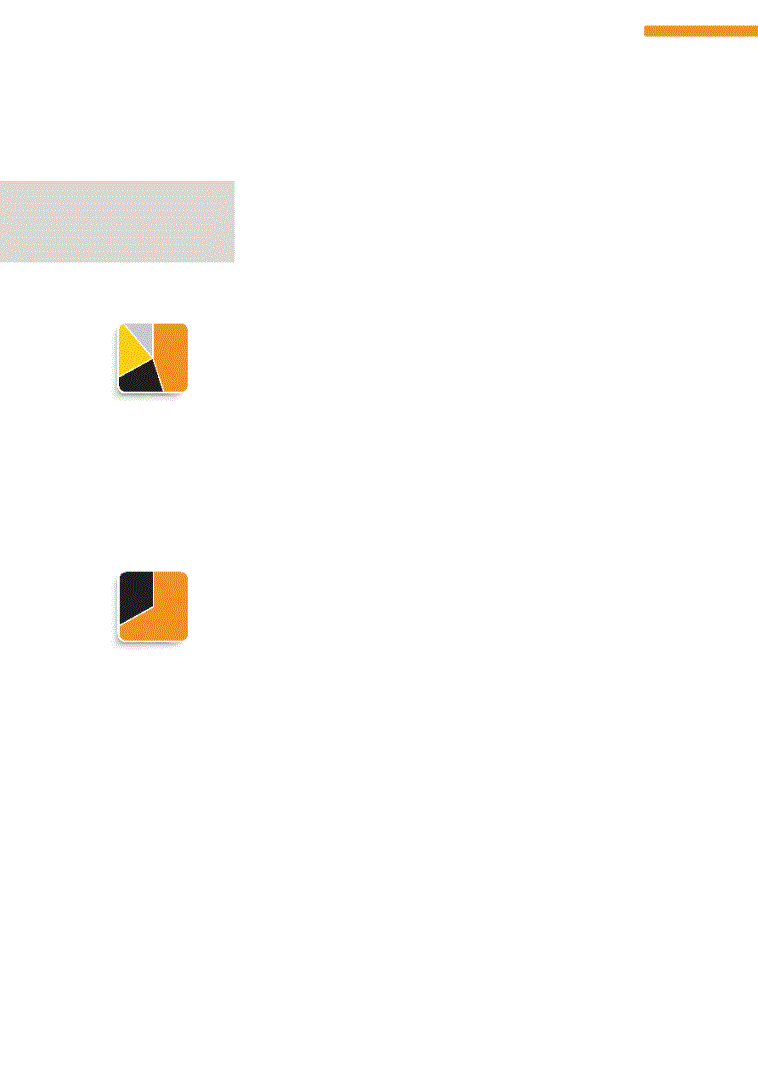
Charles Carter (52)
BA (Hons), DPhil, EDP
Executive Vice President – Strategy and Business Development
Charles is responsible for group strategy, business development, corporate finance, investor
relations and communications portfolios. He has worked in the mining industry in South Africa
and the Americas for more than 24 years and has had responsibility for a range of additional
portfolios that include human resources, risk management, business planning and executive
responsibility for the company’s business in Colombia.
Graham Ehm (58)
BSc Hons, MAusIMM, MAICD
Executive Vice President – Planning and Technical
Graham, who has multi-commodity experience, has held senior leadership positions in AngloGold
Ashanti in Tanzania and Australia. His current portfolio entails safety, business process framework
(BPF), risk, asset optimisation, capital investment optimisation and monitoring of projects, studies
and exploration. The Planning and Technical portfolio is his accountability.
Ron Largent (54)
BSc (Min. Eng.), MBA
Chief Operating Officer – International
Ron has more than 30 years’ experience in international mining operations and project
management. He joined the organisation in 1994 as Manager, Gold Operations for Cripple
Creek & Victor, and was promoted to Executive Vice President – Americas in 2007. He was
subsequently promoted to Chief Operations Officer – International in 2013, and his portfolio
was extended to include Continental Africa. Effective January 2014, Australia was also included
in his remit. He is currently accountable for overall strategic and operational responsibilities for
production at the company’s mining operations across four continents and nine countries. In
addition, he leads a team mandated to remove $500m from the group’s operating cost base
within an 18-month period ended December 2014.
David Noko (57)
MBA, Post Graduate Diploma in Company Direction; Higher National Diploma – Engineering
Executive Vice President: Sustainability
David leads the sustainability portfolio which comprises the disciplines of health, the
environment, social and community affairs, corporate social investment, human rights, global
security, stakeholder engagement and government relations. In this role he sets the company
sustainability direction and strategy and positions the company externally as a leader within the
global sustainability landscape. He has extensive experience both within the mining industry
and beyond, having been in leadership roles at South African Breweries, Pepsi Cola, Air Chefs
and De Beers Consolidated Mines Limited prior to joining AngloGold Ashanti in 2012.
Maria Sanz Perez (49)
BCom LLB, H Dip Tax, Admitted Attorney
Executive Vice President: Legal, Commercial and Governance and Company Secretary
Maria partners with the company’s business leaders to ensure AngloGold Ashanti complies with
legal requirements across the group. Other responsibilities are compliance, company secretarial
functions, integrated reporting and corporate cost reduction. She is also accountable for the
legal and commercial aspects of global procurement. Maria has been with the group since 2011
and has worked in similar positions for leading South African companies in her career including
Investec, Sappi and Afrox.
Industry sector experience
•
Mining
45
•
Finance
22
•
Executive management
22
•
Human resources
11
%
Gender
•
Male
67
• Female
33
%
LEADERSHIP
59

MANAGING OUR HUMAN RESOURCES
Our employees are key stakeholders in our business. We recognise that
the sustainability of our business includes/encompasses on our providing
wages, benefits, working conditions and development opportunities that
will attract and retain the right people with the right skills.
the sustainability of our business includes/encompasses on our providing
wages, benefits, working conditions and development opportunities that
will attract and retain the right people with the right skills.
It is one of our core values to treat each other with dignity and respect, believing that individuals
who are treated in such a way respond by giving of their best, which in turn creates both
personal and organisational advantages. To achieve this we seek to ensure that employees are
placed in appropriate roles and are equipped with the right skills and the means to deliver on
goals, as entrenched in the System for People and the groups’ business strategy.
SUSTAINING EMPLOYMENT
In 2014, AngloGold Ashanti employed on average 58,057 people (43,073 permanent
employees and 14,984 contractors) (2013: 66,434 people; 48,159 permanent employees and
18,275 contractors). The dramatic decline in the gold price has led to a change in our business
approach and business model with our business strategy aimed at improving the generation
of sustainable free cash flow and returns by focusing on five key business objectives, namely:
people, safety and sustainability; ensuring financial flexibility; actively managing all expenditures;
improving the quality of the portfolio; and maintaining long-term optionality. This required some
refocusing on core business and costs, and the restructuring of operations.
We embarked on cost improvements at every level of our business. In re-basing our company,
we started at the top of the organisation – rationalising management structures and removing
unnecessary intermediaries and layers.
The greatest impact has been at our corporate offices across the group, in the South Africa
and Continental Africa regions. In consultation with employees, an organisational design review
was conducted and completed at corporate head office and the Continental Africa region’s
office and certain regional and organisational structures located outside of these, aimed at
reducing unnecessary costs by, inter alia:
•
Potentially removing any duplicated roles and accountabilities
•
Potentially eliminating activities that do not provide sufficient value to the business
•
Enhancing cross-functional and divisional activity co-ordination and effectiveness
Employee wages and benefits make up a significant component of our cost base amounting to
39% in 2014 (39% in 2013). In 2014, payments to employees of wages and benefits amounted
to $1,588m (2013: $1,593m).
As part of the P500 initiatives to reduce costs across all operations, all labour plans and
productivity improvement initiatives have been reviewed. New labour modules based on ideal
structures per discipline and utilising analytics on skills profiles and other demographic factors
are being developed, and tested on several mines in the Continental Africa, Americas and
Australasian regions. The interim results of this exercise were presented to the Remuneration
Committee in August 2014 and work is continuing on the practical implementation of the
revised labour plans.
Average number of employees
(employees and contractors)
10
11
12
13
11
12
13
14
13,192
48,854
15,176
46,066
17,993
47,829
18,275
48,159
14,984
43,073
Employees
Contractors
“
In 2014, AngloGold
Ashanti employed
– on average –
58,057 people
(43,073 permanent
employees and 14,984
contractors).”
– on average –
58,057 people
(43,073 permanent
employees and 14,984
contractors).”
INTEGRATED REPORT 2014
60

PEOPLE MANAGEMENT
Our System for People (SP) which provides leadership and supporting management
processes has helped us ensure employees are placed in the right roles, with clearly defined
responsibilities, so that they are able to deliver against our goals.
During 2014, we focused on further integrating the principles governing the SP into our
human resources practices at all levels. These principles reinforce the central role of people in
achieving our business objectives and the value we place on treating one another with dignity
and respect.
Our aim was to simplify our human resources approach, translating it into practical action
which could be easily applied, which emphasised engagement focusing on relationships
and interaction at all levels of the business and which harnessed technology to improve and
streamline people management functions.
Improving engagement processes with all stakeholders has been identified as a key component
of our sustainability strategy and employees are no exception. Several key employee
engagement initiatives were undertaken in 2014, including a group-wide survey and a series of
‘town hall’ meetings with the CEO in the South Africa region.
DIVERSITY
AngloGold Ashanti’s operations span many different regions in a broad range of countries and,
in line with our values, we are committed to creating and preserving diversity in our workplaces.
During 2014, to emphasise and embed the diversity initiatives, a transformation policy was put
in place at a group level with the following objectives:
•
To create an underlying all-inclusive culture based on shared values
•
To put in place the necessary corporate policies and to ensure legislative compliance in
promoting transformation
•
To put in place targeted initiatives to address regional transformation imperatives, for example,
initiatives on issues such as equity ownership and employment equity that are relevant in the
South African regulatory context and localisation programmes in Continental Africa.
Initiatives focusing on increasing local employment and skills development are addressed in
the context of the group’s transformation policy.
In the South African context, the five-year targets for the Mining Charter were met, and this was
achieved through the appropriate talent management initiatives.
TALENT MANAGEMENT AND CAREER DEVELOPMENT
Talent management is embedded in the group’s human resources policies, which allocate
specific roles for mentoring and career development through the organisational structure.
Career development is undertaken in alignment with personal development objectives, which
in turn are consistently with company’s business needs and strategy.
LEADERSHIP
61

MANAGING OUR HUMAN RESOURCES continued
Given the corporate restructuring undertaken to reduce labour overheads at the corporate
office during 2013 and 2014, there was little scope for talent acquisition. However, much
emphasis was placed on succession planning to retain talent and develop employees for more
senior roles.
Succession plans for the senior and executive levels of the organisation were prepared
and presented to the board in November 2014. These plans were developed to address
skills gaps and transformation targets, by putting together individual development plans
for each employee.
An extensive succession planning and talent pool review exercise was carried out in 2014 and
a full set of talent profiles for the extended talent pool was presented to the board in February.
Analytics were developed to report cover ratio and other turnover stats.
The CEO conducted one-on-one discussions with all Executive Committee members and his
subordinates once-removed (SORs). In line with this initiative all Executive Vice Presidents
assisted by their regional HR heads conducted talent discussions with all senior staff, and this
will be cascaded to all levels in 2015. The Long Term Incentive Plan (LTIP) metrics have been
revised to include succession and talent retention measures.
In addition, a development model for growing future general managers was finalised and the
Chairman’s Young Leaders Programme was initiated. This programme will see top technical
talent receiving executive and top management mentoring while they are exposed to multi-
disciplinary projects across our operations internationally, including exchange placements for
exposure in the different regions.
PERFORMANCE MANAGEMENT AND CAPACITY DEVELOPMENT
In line with our aim to harness technology so as to improve and streamline our people
management systems, a new online performance system is currently being introduced. It
was rolled out at the AngloGold Ashanti corporate office in January 2014, prior to its global
implementation during 2015, when it will replace legacy or paper-based systems in all regions.
Some of the benefits we believe will arise from the implementation of the online system are:
•
Enhanced strategic alignment – a common understanding of the organisation’s goals
and how each employee’s work contributes towards the achievement of these common
objectives
INTEGRATED REPORT
2014
62

•
Reduced role ambiguity – clarity regarding the accountabilities of each employee’s role and
a focus on meeting specific performance expectations
•
Increased communication and engagement – with managers offering regular feedback to
subordinates and providing opportunities for them to share their views on how their work is
carried out
•
Improved performance and results – as subordinates are coached by their respective
managers to help them identify ways to improve their own performance as well as the output
of the team
•
Better retention – increasing engagement levels as effective performers are recognised and
rewarded for their contribution to organisational performance.
This new performance management system will enable a more focused approach to
development plans, and the implementation of learning and development activities to address
specific developmental needs.
LABOUR AND HUMAN RIGHTS
We respect fundamental labour rights, including the right to organise and collective bargaining.
With the exception of Australia and the United States, where collective bargaining is not
common in the resources sector, collective bargaining structures are in place at all operations.
In South Africa in particular, collective bargaining is a significant feature of our socio-economic
landscape, and initiatives to sustain and strengthen our collective bargaining structures have
been a priority during the year – see pages 39 and 40.
In 2014, we continued to implement the UN Guiding Principles on Business and Human
Rights to meet our obligations to respect human rights throughout our activities and in our
business relationships. In line with that commitment, we undertook to implement the three key
requirements set out in the Guiding Principles, namely:
•
development of a strong human rights framework anchored around a human rights policy
•
establishment of a process of human rights due diligence which is embedded in our business
processes and risk management framework
•
establishment of operational level grievance mechanisms to address and manage community
complaints and grievances effectively.
LEADERSHIP
63
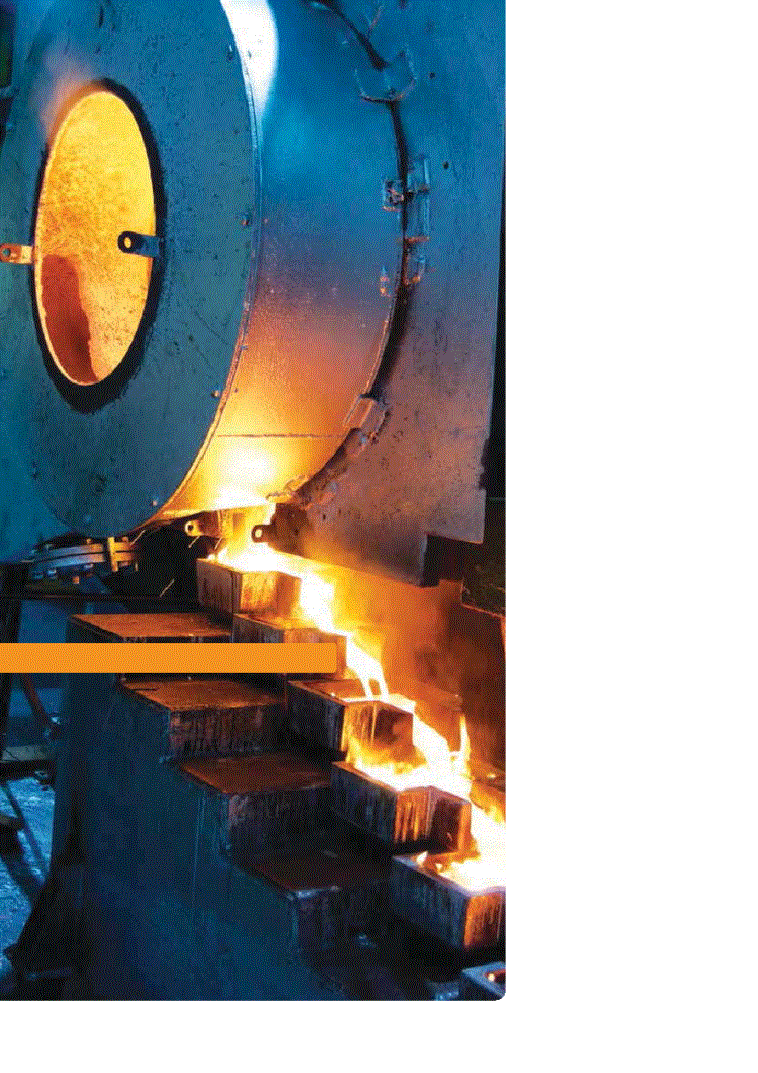
P64-118
65
Highlights of the year
66
Five-year summaries:
financial
financial
69
Economic value-added
statement
statement
70
Regional reviews
94
Mineral Resource and Ore
Reserve overview
Reserve overview
100
Five-year statistics by
operation
operation
111
Planning for the future
118
One-year outlook
FOCUS ON
QUALITY
OUNCES WITH
LONG-TERM
OPTIONALITY
This section reviews our
historical performance
from operational,
financial and sustainability
perspectives.
historical performance
from operational,
financial and sustainability
perspectives.
PERFORMANCE REVIEW
INTEGRATED REPORT
2014
64

Gold production by region
(000oz)
2014
2013
•
South Africa
1,223
1,302
• Continental Africa
1,597
1,460
•
Australasia
620
342
•
Americas
996
1,001
Capital expenditure* by region
($m)
2014
2013
•
South Africa
264
451
•
Continental Africa
454
839
•
Australasia
91
285
•
Americas
394
410
•
Other
6
8
* Includes equity-accounted investments
2013
2014
All-in sustaining costs* by region
($/oz)
1,120
1,064
968
986
1,010
1,202
1,376
970
South Africa
Continental Africa
Australasia
Americas
2013
2014
2013
2014
Water use intensity by region
(kL/t)
0.69
0.71
0.56
0.84
0.45
0.67
1.03
0.44
South Africa
Continental Africa
Australasia
Americas
Energy use intensity by region
(GJ/t)
0.30
0.29
0.29
0.58
0.23
0.38
0.60
0.23
South Africa
Continental Africa
Australasia
Americas
South Africa
Continental Africa
Australasia
Americas
Greenfields exploration
AIFR by region
(per million hours worked)
11.85
1.56
10.73
3.81
3.57
Community investment by region
($m)
($m)
2014
2013
•
South Africa
8.1
8.4
• Continental Africa
3.9
13.3
•
Australasia
0.2
0.5
•
Americas
3.7
5.8
•
Equity-accounted
investments
(1.1)
(5.3)
* Excluding stockpile write-offs
Group:
4.4Moz
Group:
$14.8m
Group:
Group:
$1,026/oz
Group average:
(7.15 adjusted for effect of earthquake)
7.36
Environmental
incidents:
incidents:
5
PRODUCTION
COSTS
CAPITAL
EXPENDITURE
EXPENDITURE
ENVIRONMENT
COMMUNITY
SAFETY
$1.2bn
*
(2013: 4.1Moz)
(2013: $1,174/oz)
(2013:
$22.5m)
$22.5m)
(2013: 10)
(2013: $2.0bn)
(2013: 7.48)
HIGHLIGHTS OF THE YEAR
Gold production increased for the second consecutive year, boosted by the contributions of new
mines, Kibali and Tropicana, which had their first full year of production in 2014. The rationalisation
of corporate structures and marginal production continued with a range of initiatives – including
mine closure and asset sales – to improve the overall quality of the portfolio. Active management of
overhead and operating costs, to generate free cash flow, remained a priority.
mines, Kibali and Tropicana, which had their first full year of production in 2014. The rationalisation
of corporate structures and marginal production continued with a range of initiatives – including
mine closure and asset sales – to improve the overall quality of the portfolio. Active management of
overhead and operating costs, to generate free cash flow, remained a priority.
PERFORMANCE REVIEW
65
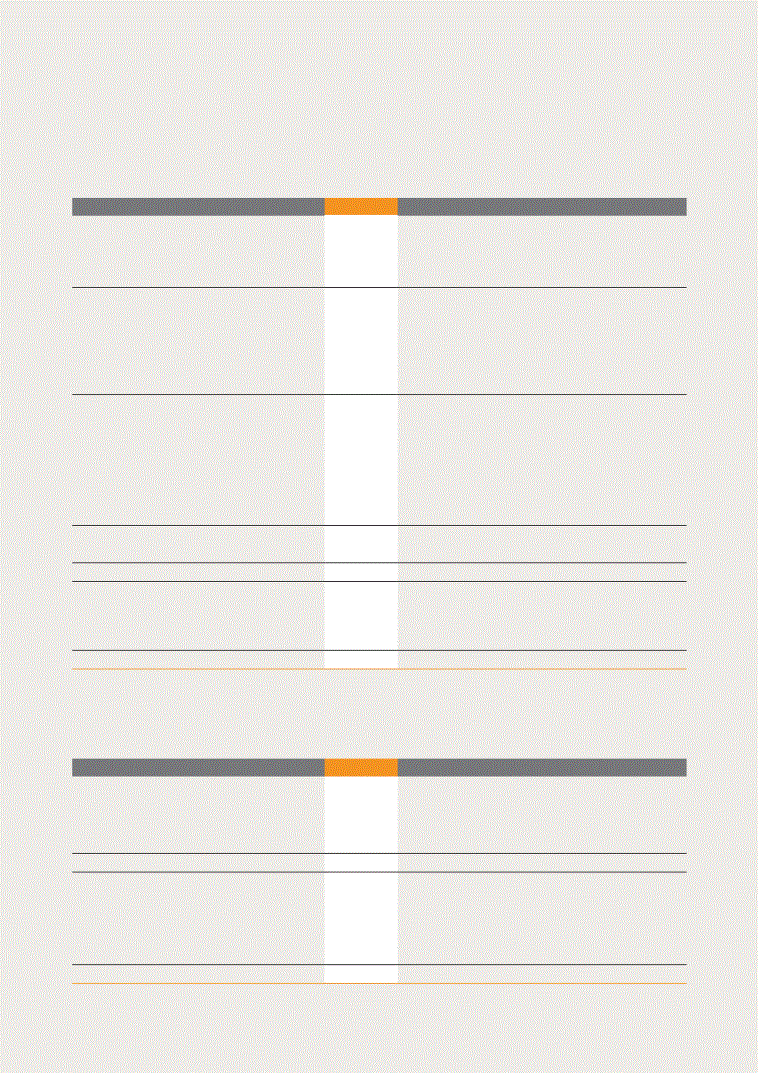
FIVE-YEAR SUMMARIES: FINANCIAL
Summarised group financial results – income statement
US dollar million
2014
2013
2012
2011
2010
Gold income
5,218
5,497
6,353
6,570
5,334
Cost of sales
(4,190)
(4,146)
(3,964)
(3,892)
(3,550)
Gain (loss) on non-hedge derivatives and other
commodity contracts
commodity contracts
15
94
(35)
(1)
(702)
Gross profit
1,043
1,445
2,354
2,677
1,082
Corporate administration, marketing and other
expenses
expenses
(92)
(201)
(291)
(278)
(220)
Exploration and evaluation costs
(144)
(255)
(395)
(279)
(198)
Other operating expenses
(28)
(19)
(47)
(31)
(20)
Special items
(260)
(3,410)
(402)
163
(126)
Operating profit (loss)
519
(2,440)
1,219
2,252
518
Dividends received
–
5
7
–
–
Interest received
24
39
43
52
43
Exchange (loss) gain
(7)
14
8
2
3
Finance costs and unwinding of obligations
(278)
(296)
(231)
(196)
(166)
Fair value adjustments on convertible bonds
(17)
307
245
188
(56)
Share of equity-accounted investments’ (loss) profit
(25)
(162)
(30)
72
63
Profit (loss) before taxation
216
(2,533)
1,261
2,370
405
Taxation
(255)
333
(346)
(737)
(276)
(Loss) profit for the year
(39)
(2,200)
915
1,633
129
Allocated as follows:
Equity shareholders
(58)
(2,230)
897
1,587
76
Non-controlling interests
19
30
18
46
53
(39)
(2,200)
915
1,633
129
Summarised group financial results – statement of financial position
US dollar million
2014
2013
2012
2011
2010
Assets
Tangible and intangible assets
5,088
5,082
8,091
6,755
6,374
Cash and cash equivalents
468
648
892
1,112
575
Other assets
3,578
3,944
3,756
2,882
2,583
Total assets
9,134
9,674
12,739
10,749
9,532
Equity and liabilities
Total equity
2,871
3,107
5,494
5,120
4,113
Borrowings
3,721
3,891
3,583
2,488
2,704
Deferred taxation
567
579
1,084
1,148
900
Other liabilities
1,975
2,097
2,578
1,993
1,815
Total equity and liabilities
9,134
9,674
12,739
10,749
9,532
INTEGRATED REPORT 2014
66
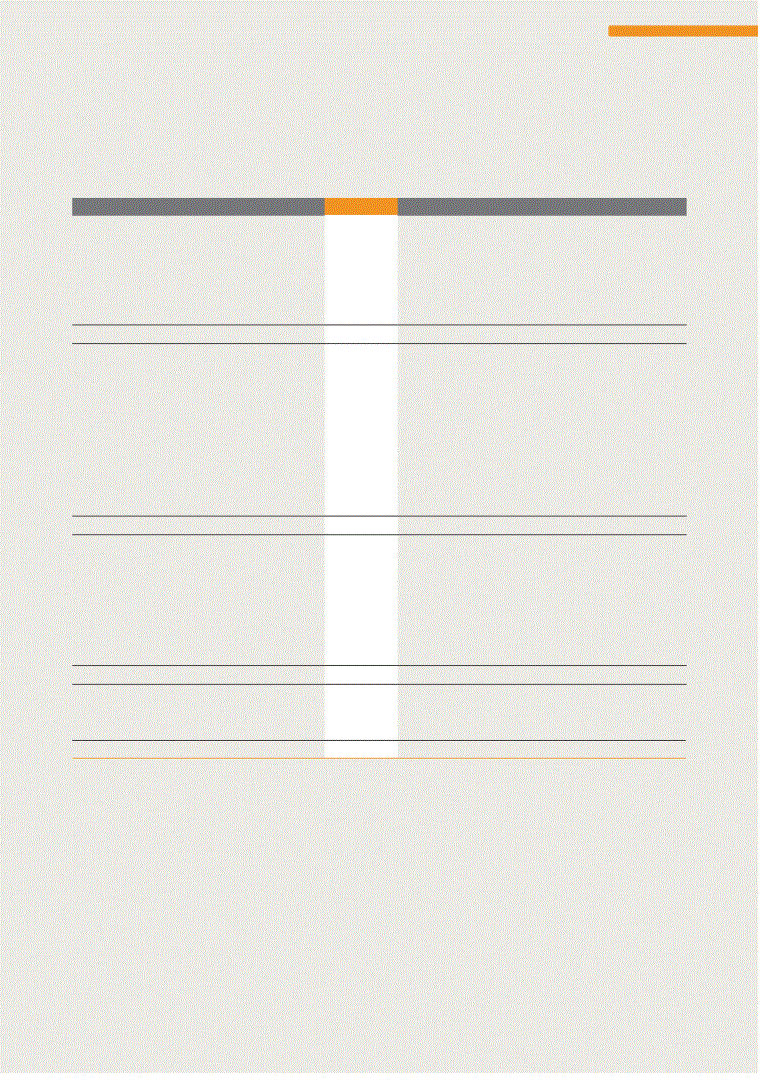
Summarised group financial results – statement of cash flows
US dollar million
2014
2013
2012
2011
2010
Cash flows from operating activities
Cash generated from operations
1,373
1,392
2,350
3,081
1,714
Dividends received from equity-accounted
investments
investments
–
18
72
111
143
Net taxation paid
(153)
(164)
(453)
(379)
(188)
Cash utilised for hedge buy-back costs
–
–
–
–
(2,611)
Net cash inflow (outflow) from operating activities
1,220
1,246
1,969
2,813
(942)
Cash flows from investing activities
Capital expenditure
(1,018)
(1,569)
(2,004)
(1,567)
(973)
Net proceeds (payments) from acquisition and
disposal of subsidiaries, associates and joint ventures
disposal of subsidiaries, associates and joint ventures
40
(464)
(684)
(117)
(44)
Net (payments) proceeds from disposal and
acquisition of investments, associate loans, and
acquisition and disposal of tangible assets
acquisition of investments, associate loans, and
acquisition and disposal of tangible assets
(11)
(8)
(70)
(62)
95
Interest received
21
23
36
39
32
Decrease (increase) in cash restricted for use
24
(20)
(3)
(19)
25
Other
1
(2)
(50)
4
(6)
Net cash outflow from investing activities
(943)
(2,040)
(2,775)
(1,722)
(871)
Cash flows from financing activities
Net proceeds from share issues
–
–
2
9
778
Net (repayments) proceeds from borrowings
(150)
858
1,215
(159)
648
Finance costs paid
(245)
(200)
(145)
(144)
(115)
Dividends paid
(17)
(62)
(236)
(169)
(117)
Acquisition of non-controlling interest
–
–
(215)
–
–
Other
(9)
(36)
(30)
–
–
Net (outflow) inflow from financing activities
(421)
560
591
(463)
1,194
Net (decrease) increase in cash and cash equivalents
(144)
(234)
(215)
628
(619)
Translation
(16)
(30)
(5)
(102)
105
Cash and cash equivalents at beginning of year
628
892
1,112
586
1,100
Cash and cash equivalents at end of year
(1)
468
628
892
1,112
586
(1)
The cash and cash equivalents balance at 31 December 2010 includes cash and cash equivalents included in the statement of financial position as
part of non-current assets held for sale of $11m. The cash and cash equivalent balance at 31 December 2013 includes a bank overdraft included in
the statement of financial position as part of other liabilities of $20m.
part of non-current assets held for sale of $11m. The cash and cash equivalent balance at 31 December 2013 includes a bank overdraft included in
the statement of financial position as part of other liabilities of $20m.
PERFORMANCE REVIEW
67
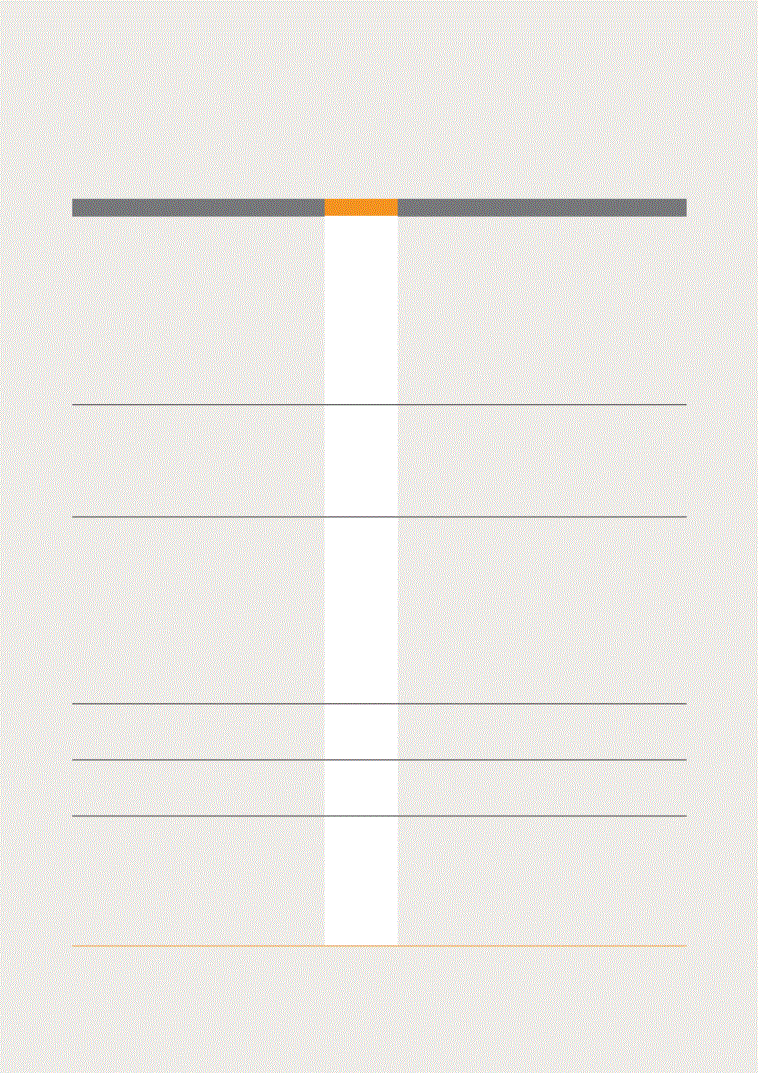
FIVE-YEAR SUMMARIES: FINANCIAL continued
Ratios and statistics
Units
2014
2013
2012
2011
2010
Earnings
Adjusted gross profit (loss)
$m
1,028
1,351
2,389
2,678
(1,191)
Adjusted gross margin
%
20
25
38
41
(51)
Headline (loss) earnings
$m
(79)
78
1,208
1,519
122
Adjusted headline (loss) earnings
$m
(1)
599
988
1,332
(1,758)
Adjusted headline (loss) earnings
excluding hedge buy-back costs
$m
(1)
599
988
1,332
787
Adjusted EBITDA
(1) (2)
$m
1,665
1,667
2,529
3,134
1,897
Adjusted EBITDA margin
(1)
%
32
30
40
48
38
Interest cover
times
7
7
14
22
16
(Loss) earnings per ordinary share
Basic
US cents
(14)
(568)
232
411
20
Diluted
US cents
(14)
(631)
177
355
20
Headline
US cents
(19)
20
312
394
33
Adjusted headline
US cents
0
153
255
345
(473)
Dividends per ordinary share
US cents
–
5
35
49
20
Asset and debt management
Equity
$m
2,871
3,107
6,082
5,880
4,987
Net capital employed
$m
6,640
5,519
8,420
7,444
7,017
Net debt
$m
3,133
3,105
2,061
610
1,288
Net asset value – per share
US cents
711
770
1,580
1,528
1,299
Net tangible asset value – per share
US cents
655
704
1,498
1,473
1,248
Market capitalisation
$m
3,515
4,727
12,025
16,226
18,767
Return on equity
(1)
%
0
18
19
26
20
Return on net capital employed
(1)
%
4
12
15
20
15
Net debt to equity
%
104
100
34
10
26
Gold price
Closing price at year-end
$/oz
1,266
1,411
1,668
1,572
1,227
Average gold price received
$/oz sold
1,264
1,401
1,664
1,576
561
Other
Weighted average number of shares
million
408
393
387
386
372
Issued shares at year-end
million
404
403
385
385
384
Exchange rates
Rand/dollar average
10.83
9.62
8.20
7.26
7.30
Rand/dollar closing
11.57
10.45
8.45
8.04
6.57
Australian dollar/dollar average
1.11
1.03
0.97
0.97
1.09
Australian dollar/dollar closing
1.22
1.12
0.96
0.97
0.98
Brazilian real/dollar average
2.35
2.16
1.95
1.68
1.76
Brazilian real/dollar closing
2.66
2.34
2.05
1.87
1.67
(1)
Excludes hedge buy-back costs in 2010.
(2)
The adjusted EBITDA calculation is based on the formula included in the revolving credit agreements for compliance with the debt covenant formula
as specified in the revolving credit agreements.
as specified in the revolving credit agreements.
INTEGRATED REPORT
2014
68
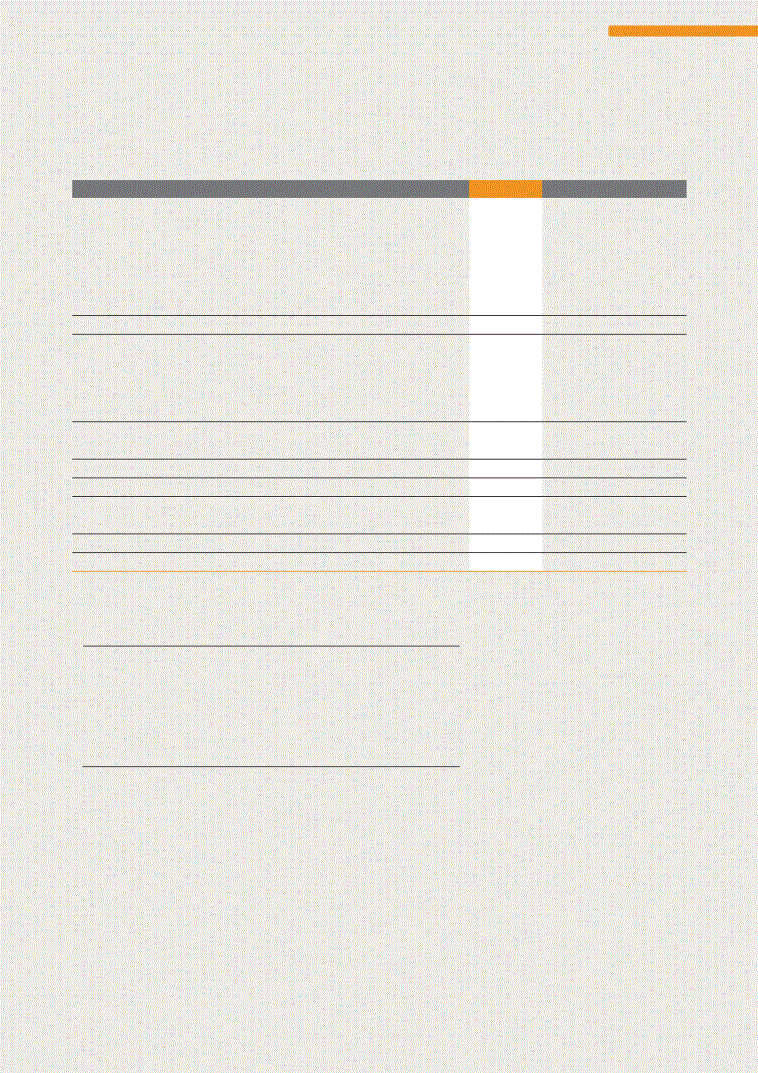
ECONOMIC VALUE-ADDED STATEMENT
For the year ended 31 December
US dollar millions
%
2014
%
2013
Economic value generated
Gold sales and by-product income
(1)
99
5,350
99
5,646
Interest received
1
24
1
39
Royalties received
–
4
–
18
Profit from sale of assets
(2)
–
23
–
2
Income from investments
–
–
–
7
Total economic value generated
100
5,401
100
5,712
Economic value distributed
Operating costs
(3)
46
2,464
43
2,484
Employee salaries, wages and other benefits
30
1,588
28
1,593
Payments to providers of capital
5
278
6
336
– Finance costs and unwinding of obligations
5
278
5
296
– Dividends
–
–
1
40
Corporate taxation
– Current taxation
(4)
3
165
2
134
Community and social investments
(5)
–
14
1
27
Loss from investments
(6)
–
20
–
–
Total economic value distributed
84
4,529
80
4,574
Economic value retained
(7)
16
872
20
1,138
(1)
Gold sales decreased by 5% year-on-year due to a 10% lower average price received of $1,264/oz, partially negated by a 9% increase in the ounces sold.
(2)
Includes a loss on sale of Navachab mine of $2m.
(3)
Includes retrenchment costs at Obuasi of $210m in 2014 (2013: nil).
(4)
Current tax charge (credit) by country is as follows:
US Dollar millions
2014
2013
South Africa
30
(18)
Argentina
24
36
Australia
–
(2)
Brazil
31
56
Ghana
2
1
Guinea
31
22
United States of America
(5)
–
Tanzania
65
32
Other
(13)
7
(5)
Community and social investments exclude expenditure by equity accounted joint ventures.
(6)
Includes $21m loan impairment and $45m net equity losses from Rand Refinery (Pty) Limited.
(7)
Economic value retained excludes impairments and impairment reversals.
PERFORMANCE REVIEW
69

REGIONAL REVIEWS
South Africa
AngloGold Ashanti’s five South African deep-level mines and surface
production facilities are divided into three areas of operation: Vaal
River, West Wits and Surface Operations. At present, these three areas
comprise the following operations:
production facilities are divided into three areas of operation: Vaal
River, West Wits and Surface Operations. At present, these three areas
comprise the following operations:
Vaal River
The Vaal River mining operations comprise three mines located around 170km to 180km from
Johannesburg, near the Vaal River on the Free State-North West Province border. These three
mines, which share a milling and treatment circuit, are:
•
Great Noligwa, a mature operation nearing the end of its life, adjoins Kopanang and Moab
Khotsong in the Free State. The mine primarily exploits the Vaal Reef by means of scattered
mining via a twin-shaft system over three main levels at an average depth of 2,100m.
•
Kopanang is located to the west of neighbour Great Noligwa and bound to the south by the
Jersey Fault. Gold is the primary output, with uranium oxide produced as a by-product, from
a single shaft system to a depth of 2,600m. It almost exclusively exploits the Vaal Reef.
•
Moab Khotsong is AngloGold Ashanti’s newest gold mine in South Africa. Stoping
operations began in November 2003 with full production achieved in 2010. Given the
geological complexity of the Vaal Reef, scattered mining is employed.
West Wits
The two West Wits operations, situated southwest of Johannesburg, on the border between
Gauteng and North West Province, are:
•
Mponeng, the world’s deepest gold mine and our flagship operation in the South Africa
region, exploits the Ventersdorp Contact Reef (VCR) at depths of between 2,400m and
3,900m via a twin-shaft system. Ore is treated and smelted at the mine’s gold plant.
•
TauTona exploits both the Carbon Leader Reef (CLR) and the VCR via a three-shaft system,
supported by secondary and tertiary shafts sinking to depths of between 1,850m and
3,450m. TauTona’s infrastructure is to be used to access the remaining Ore Reserve at
the former Savuka mine. A link between the two mines reduces dependency on a single
infrastructure system, including ore passes. The integration of Savuka into TauTona has
been completed and is expected to extend TauTona’s life of mine. The hoisting of Savuka
ore via TauTona is planned to start in the second quarter of 2015.
Surface Operations
•
Surface Operations extracts gold from marginal ore dumps and tailings storage facilities on
surface at various Vaal River and West Wits operations. The hard rock business processes
hard rock material from underground as well as from marginal ore dumps. Surface Operations
also includes Mine Waste Solutions (MWS) which operates independently and processes
slurry material reclaimed hydraulically from the various tailings storage facilities. Uranium
is produced as a by-product, as is backfill that is used as mining support in underground
mined out areas.
Good progress is being made with the consolidation of the individual operations in each of
these areas into three operating entities so as to eliminate any duplication of services and
management. This consolidation will have both cost and efficiency benefits. As an initial step in
this process, Great Noligwa mine employees have been successfully incorporated with those
of Moab Khotsong. The consolidation of the West Wits mines and of Surface Operations is
expected to follow in due course.
Contribution to regional production – 2014
•
West Wits
45
• Vaal River
37
•
Surface Operations
18
%
Contribution to group production – 2014
•
South Africa
28
• Rest of AngloGold Ashanti
72
%
INTEGRATED REPORT 2014
70
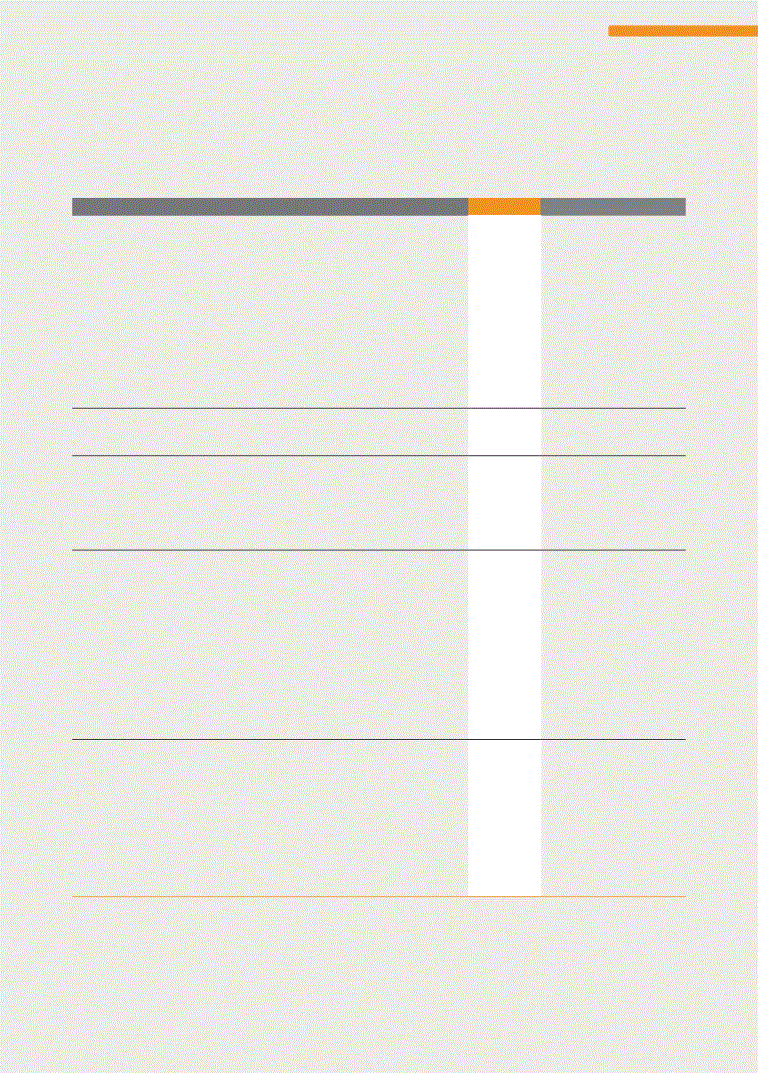
Key statistics
Units
2014
2013
2012
Operational performance
Tonnes treated/milled
Mt
38.4
39.2
22.2
Pay limit
(1)
oz/t
0.39
0.36
0.40
g/t
14.35
13.37
12.41
Recovered grade
(1)
oz/t
0.239
0.204
0.219
g/t
8.19
7.00
7.50
Gold production
000oz
1,223
1,302
1,212
Total cash costs
$/oz
849
850
873
Total production costs
$/oz
1,087
1,070
1,097
All-in sustaining costs
(2)
$/oz
1,064
1,120
1,189
Capital expenditure
$m
264
451
583
Productivity
oz/TEC
4.40
4.47
4.19
Safety
Number of fatalities
4
6
11
AIFR
per million hours worked
11.85
12.63
13.24
People
Average no of employees: Total
29,511
32,406
34,186
– Permanent employees
26,056
28,526
29,740
– Contractors
3,455
3,880
4,446
Employee turnover
%
10
12
8
Training and development expenditure
$m
37.5
45
63
Environment
Total water consumption
ML
27,219
27,228
23,813
Total water use per tonne treated
kL/t
0.71
0.69
1.07
Total energy usage
PJ
11.31
11.80
11.65
Total energy usage per tonne treated
GJ/t
0.29
0.30
0.52
Total greenhouse gas (GHG) emissions
000t CO
2
e
2,981
(3)
3,025
(3)
3,009
Total GHG emissions per tonne treated
t CO
2
e/t
0.08
0.08
0.13
Cyanide used
t
10,100
9,688
6,129
No. of reportable environmental incidents
1
3
10
Total rehabilitation liabilities:
$m
83.5
78.1
148.8
– restoration
$m
12.2
10.0
43.7
– decommissioning
$m
71.3
68.1
105.1
Community and government
Community expenditure
(4)
$m
8.1
8.4
7.7
Payments to government
$m
144
157
251
– Dividends
$m
–
–
–
– Taxation
$m
16
12
81
– Withholding tax (royalties, etc.)
$m
18
12
29
– Other indirect taxes and duties
$m
–
–
1
– Employee taxes and other contributions
$m
100
122
131
– Property tax
$m
5
5
3
– Other (includes skills development)
$m
5
6
6
(1)
Refers to underground operations only.
(2)
Excludes stockpile write-offs.
(3)
The Eskom grid emission factor was revised by the National Business Initiative in consultation with Eskom, leading to a change in the electricity-
related emissions reported for 2012 and 2013. The figure reported for 2012 included Nufcor.
related emissions reported for 2012 and 2013. The figure reported for 2012 included Nufcor.
(4)
Includes corporate social investment expenditure.
PERFORMANCE REVIEW
SOUTH AFRICA
71
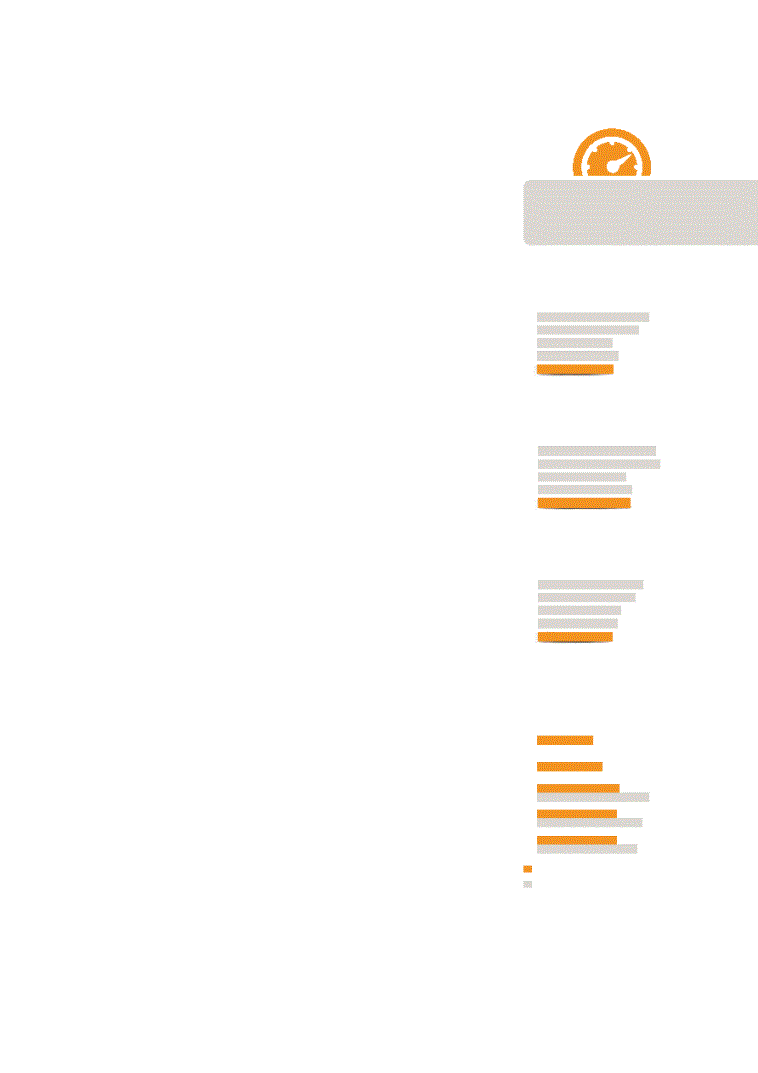
OPERATIONAL PERFORMANCE
Production
Production declined by 6%, predominantly a consequence of safety-related stoppages,
the aftermath of the earthquake experienced on 5 August 2014, and unscheduled shaft
maintenance at Mponeng.
The 5.3 magnitude earthquake affected the Vaal River mines. Production was halted at these
operations for five to ten days to allow for the aftershocks to subside and to undertake repairs
before production resumed. At Mponeng, production was adversely affected by safety-
related stoppages as well as an incident that occurred during shaft slinging, suspending
operations for seven days to allow for significant repair work on damaged shaft steelwork
and to return the shaft to safe levels of service.
Production from Surface Operations was negatively affected by the decreased grade of the
material sourced from the marginal ore dumps. Mining flexibility has been improved to enable
more active blending.
The region’s contribution to group attributable gold production declined to 28% from 32% in
2013. In addition, the Vaal River operations produced 1.3Mlb of uranium.
Costs
The intense focus on cost containment continued in 2014, in line with the Project 500 initiative
to reduce overall group costs by $500m in the 18 months to end 2014, cost reduction initiatives
were undertaken in the region. The emphasis on the management of labour costs, reef mining-
related activities, power consumption, contractors and the implementation of service-optimisation
strategies as well as a robust critical review of commodity- and services-related contracts all
contributed to lower operating costs. Inflationary pressures, which included increases in electricity
tariffs that exceeded inflation, were partially compensated for by cost savings from the Project
500 initiatives and also a weaker local currency. All-in sustaining costs for the year declined for
the second consecutive year, 5% to $1,064/oz.
Growth and improvement
Project Zaaiplaats at Moab Khotsong, which was temporarily halted in 2013, remains on hold.
Additional geological information gathered in the interim reflected a deterioration in the grade
of the project, making it economically unviable at current gold prices.
At Mponeng, phase 1 of the deepening project to access the VCR progressed well. Although
safety stoppages following a shaft incident led to some delays, stoping and ledging operations
have begun. The emphasis in the coming year will be to increase the volume of ore reserve
development so as to open up the high-grade Ore Reserve. Given the slump in the gold price,
phase 2 of this project to access the CLR was delayed slightly in 2014. Critical-path work
continued and included the installation of ventilation and refrigeration infrastructure to enable
the ramp-up to full project execution in 2015, should the capital budget be approved. This
project will also investigate the viability of optimised shift schedules with a view to improving
productivity and speeding up access to the higher-grade areas.
The uranium plant at Mine Waste Solutions (MWS) was successfully completed with the first
deliveries in the fourth quarter of the year. The recovery in the uranium price during the year
was encouraging.
REGIONAL REVIEWS continued
South Africa
KEY PERFORMANCE
INDICATORS
Production
(000oz)
10
11
12
13
11
12
13
14
1,785
1,624
1,212
1,302
1,223
Productivity
(oz/TEC)
10
11
12
13
11
12
13
14
5.63
5.85
4.19
4.47
4.40
AIFR
(per million hours worked)
10
11
12
13
11
12
13
14
16.69
15.57
13.24
12.63
11.85
Total cash costs
All-in sustaining costs
(excluding stockpile write-offs)
(excluding stockpile write-offs)
Total cash costs and all-in
sustaining costs
sustaining costs
(S/oz)
598
1,189
1,120
849
1,064
694
873
850
10
11
12
13
14
INTEGRATED REPORT
2014
72

Mineral Resource and Ore Reserve
As at 31 December 2014, the total Mineral Resource (inclusive of the Ore Reserve) for
the South Africa region was 85.63Moz (2013: 94.27Moz) and the Ore Reserve 27.45Moz
(2013: 30.9Moz). This is equivalent to around 37% and 48% of the group’s total attributable
Mineral Resource and Ore Reserve respectively.
SUSTAINABILITY PERFORMANCE
People
The South Africa region’s workforce averaged 29,511 people in 2014 – 26,056 full-time
employees and 3,455 contractors – as compared to 32,406 in 2013 and 34,186 in 2012
– a decline of 14% in two years. This decline in the workforce was a result of various cost
rationalisation initiatives implemented across the group over the past two years. Productivity
declined to 4.40oz/TEC in 2014 (2013: 4.47oz/TEC).
In the South Africa region, 94% of our workforce is represented by the four industry unions.
Union representation in the South African gold mining industry as a whole is as follows: AMCU
(27%), NUM (54%), Solidarity (2.5%) and UASA (6.5%).
During 2014, work continued with the incorporation of organised labour representatives in
dialogue on business issues. In particular, we have engaged with them on the economics of
our industry, the gold market and on the legal and statutory framework regulating industrial
relations in South Africa. Employee engagement included quarterly briefs by the chief
operations officer on the company’s financial and operational performance. In addition,
to effectively engage on the restructuring processes, the region established a central
restructuring plenary committee and a transformation committee, both aimed at achieving
consensus on various issues and forging improved relations between management and
the unions. AMCU signed a formal recognition agreement with AngloGold Ashanti in the
fourth quarter of the year, and has been fully integrated in all statutory labour committees.
The second year of the current wage agreement became effective on 1 July 2014 with
increases of 6.5% to 7% in wages. In line with the Deputy President’s Stability Agreement
(Framework Agreement for a Sustainable Mining Industry entered into by Organised Labour,
Organised Business and Government) and other items included in the 2013 wage agreement,
we began work on related matters, particularly employee indebtedness. This is a concern
at all levels. According to an audit conducted at mid-year, 1,900 employees in the South
Africa region had at least one garnishee order in force against their wages and salaries. In
terms of the indebtedness initiative, Masidibanise Izandla (‘let’s put our hands together’) the
services of legal firms have been retained to assist employees in their dealings with often
dubious business practitioners, especially credit providers. In addition, dedicated financial
consultants have been employed by the company to provide financial advice and to assist
with debt consolidation and management, and ultimately to eliminate debt altogether. Every
garnishee order in place is being scrutinised as are any instructions for new ones, prior to
their implementation.
The next round of wage negotiations is due to begin early in 2015 as the current wage
agreement comes to an end on 30 June 2015.
PERFORMANCE REVIEW
Capital expenditure
Capital expenditure declined by
41%, in line with the group-
wide cost optimisation and
rationalisation programme
and the resultant scaling back
of project investment. Capital
expenditure in 2014 was
again predominantly on ore
reserve development across all
underground operations and on
the Mponeng deepening project,
as well as stay-in-business
items and activities across all
underground operations.
41%, in line with the group-
wide cost optimisation and
rationalisation programme
and the resultant scaling back
of project investment. Capital
expenditure in 2014 was
again predominantly on ore
reserve development across all
underground operations and on
the Mponeng deepening project,
as well as stay-in-business
items and activities across all
underground operations.
73

Given the increasing need for improved communication with employees in the region, three
employee surveys were conducted during the year to identify specific needs and areas of
concern. The results of these surveys highlighted several key requirements:
•
Improved employee communication, in terms of the frequency, quality and the quantity of
information
•
Detailed investigations into unethical behaviour
•
Improved supervisor/management training as well as engagement
In response, engagement by senior management has been stepped up. Large group meetings
(town hall type meetings) have been held. These initiatives were supplemented by mass
meetings across all mines, hosted by the CEO, COO: South Africa and business unit general
managers. Refer to page 39 for further related information. A communication programme,
Your voice matters, to engage with employees via a digital platform, has been implemented.
This programme, which involves two-way communication between the company and its
employees in the South Africa region, will enable the company to communicate with those
employees who register to participate in the programme and for these employees to share
their views with the company.
Safety
Despite the region recording its best safety performance ever, there were tragically four
fatalities during 2014 (2013: six) – one at the Vaal River operations and three at the West Wits
operations. Three of these were caused by falls of ground and one was the result of an incident
involving piping and construction work.
All mines and plants in the region achieved 1 million fatality-free shifts and Kopanang, most
notably, has recorded three million fatality-free shifts. This was achieved despite the impact
of the 5.3 magnitude earthquake which resulted in minor injuries to 30 employees and the
evacuation and safe return to surface of 3,300 people in all at the Vaal River operations.
While work remains to be done to achieve our target of zero harm, much of the improved
safety performance can be attributed to the very successful visible felt leadership drive and the
observable steps taken (installation of bolts and netting, training and technological improvements
such as electronic systems to monitor the various aspects of underground working areas) to
make the working environment safer. Employee surveys conducted during the year confirmed
that ‘Safety is our First Value’ is embedded in the psyche of employees.
Group-wide, safety efforts concentrated on expanding our understanding of how safety risks
arise and why safety incidents occur so as to develop a critical control methodology. Given the
higher frequency of safety incidents at the South African operations, the focus in 2014 was on
embedding this methodology at these operations, with the emphasis on the two major safety
risks: falls of ground and vertical transport.
REGIONAL REVIEWS continued
South Africa
Technology initiative
The Technology Innovation
Consortium continued to make
significant progress towards
the development of the new
deep-level mining technology.
The aim, ultimately, is to
develop a cost-efficient, safe,
mining method to implement
at our deep-level underground
operations in South Africa to
extract stability pillars and
areas that might otherwise not
be safe or viable to mine.
Consortium continued to make
significant progress towards
the development of the new
deep-level mining technology.
The aim, ultimately, is to
develop a cost-efficient, safe,
mining method to implement
at our deep-level underground
operations in South Africa to
extract stability pillars and
areas that might otherwise not
be safe or viable to mine.
In 2015, the final element
of work will be to compile a
deep-level mining method
based on this mining style. Key
to maximising the efficacy of
this method will be enhanced
machine efficiencies. This
in turn will entail increasing
machine availability and a 24-
hour mining cycle. While such
working arrangements are still
to be negotiated with labour,
they would increase the global
competitiveness of the South
African mining industry.
of work will be to compile a
deep-level mining method
based on this mining style. Key
to maximising the efficacy of
this method will be enhanced
machine efficiencies. This
in turn will entail increasing
machine availability and a 24-
hour mining cycle. While such
working arrangements are still
to be negotiated with labour,
they would increase the global
competitiveness of the South
African mining industry.
INTEGRATED REPORT 2014
74
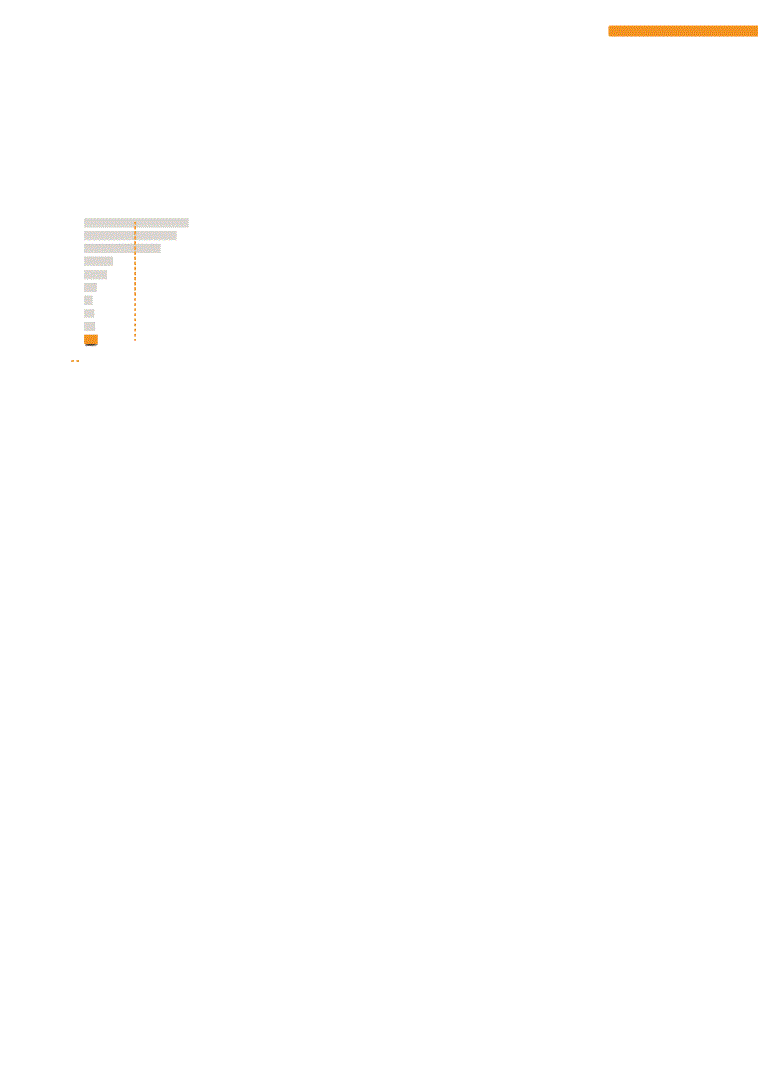
Health
Health statistics in the region have improved significantly. One of the region’s major health
challenges, occupational lung diseases (OLD), particularly silicosis, are managed primarily by
reducing the level of exposure of employees to silica-bearing dust. During 2014, implementation
continued of multi-stage filtration systems at ore transfer points as well as footwall treatment
to prevent the infiltration of dust into working areas. The progressive introduction of improved
controls has led to reduced exposure by South African employees to silica-bearing dust – 201
new cases were diagnosed in 2014 compared to 293 in 2013. Given the legacy of silicosis in
the industry as a whole, AngloGold Ashanti, together with four South African mining companies,
embarked on a joint collaboration to establish a process together with other stakeholders –
government, labour, employees – to address related compensation and medical care in the
South African gold mining industry.
The incidence of pulmonary tuberculosis (TB), another OLD, which has decreased substantially
over the past 10 years, has begun to plateau (see the >SDR for further details): 1.57% for
2014 compared to 1.50% in 2013 and a national average of 1%. Over the past decade, the
incidence of TB has improved by around 60%. Initiatives to combat TB, which apply to both
employees and contractors, are aimed at addressing the wide range of underlying contributing
factors to the disease and are being extended to communities around operations to further
underpin their effectiveness.
Noise-induced hearing loss (NIHL) is prevented by the silencing of equipment, the wearing of
hearing protection by employees and administrative controls. The incidence of NIHL continued
to decline in South Africa, with 30 cases diagnosed in 2014 (2013: 38 cases).
Environment
There was only one reportable environmental incident in 2014 – a threefold improvement
year-on-year. This performance exemplifies the ongoing operational improvements in process
water containment, stormwater control and tailings pipeline management over the last five
years. Also commendable is the work done at MWS in response to in-plant spillages and their
containment, as well as the incorporation of MWS into the environmental management system
of the South Africa region’s Surface Operations.
The risk of inter-mine flooding and the associated costs remains a high priority:
•
The Vaal River operations continue to monitor closely and pursue all avenues to reduce the
potential financial burden of the intended closure of neighbouring mines in the Vaal River
area. AngloGold Ashanti continues to use excess water from underground at its Vaal River
operations for hydraulic tailings reclamation at MWS.
PERFORMANCE REVIEW
05
06
07
08
09
10
11
12
13
06
07
08
09
10
11
12
13
14
Milestone compliance
Silica dust in samples
(%)
10.17
9.00
7.40
2.80
2.20
1.20
0.74
0.92
1.00
1.31
75

REGIONAL REVIEWS continued
South Africa
•
The West Wits operations continue to pump and discharge water at Blyvooruitzicht mine’s
4 and 6 shafts. Currently, the pumping of water is being conducted in terms of a directive to
pump and discharge water pending the final issuing of a water use licence, the application
of which has been submitted to the regulatory authorities.
Since a carbon tax on greenhouse gas emissions for South Africa was first proposed in 2010,
AngloGold Ashanti has actively engaged with government, industry partners and other experts
to ensure that when introduced, the tax is appropriately tailored to the South African business
context. Our financial models have been revised to include the potential impact of such a tax,
currently scheduled to be introduced from the beginning of 2016. Almost 98% of AngloGold
Ashanti’s emissions in South Africa are Scope 2 emissions, that is emissions resulting from the
purchase of electricity from Eskom, the national power utility, which uses coal in its energy-
generation process.
In the interim, the focus remains on reducing energy usage at our energy intensive, deep-level
South African operations, from the perspective of both cost and emissions. These operations
account for approximately 65% of the group’s greenhouse gas emissions and 36% of its energy
usage. For more detail on the proposed carbon tax, see the >SDR.
The region’s strategic environmental focus areas remain integrated water management,
closure planning, waste management, knowledge management, legal compliance and the
dust mitigation programme for tailings storage facilities.
Stakeholder engagement and communities
The delivery of community development projects is informed by the Social and Labour Plans
(SLPs) compiled in accordance with the requirement of the South African Mining Charter and
its accompanying scorecard targets. The initial SLPs were for the period 2010 – 2014 and the
company’s performance against these plans and the targets set was audited during the course
of 2014. The Moloto audit, concluded in November 2013, confirmed that by the end of 2014
AngloGold Ashanti would have met all its targets as required. Indeed, by December 2014 we
had met all the Mining Charter Targets and exceeded some.
The second set of SLPs, for the period 2015 – 2019, has been submitted to the DMR and
is available on our website under the Sustainability tab, (www.anglogoldashanti.com/en/
sustainability/MiningCharter/Pages/default.aspx). The community development projects and
targets detailed in these plans were compiled and agreed in discussions and negotiations with
the communities involved and other significant stakeholders. The initial SLPs included board-
approved commitments amounting to $46.4m (R418m) for local economic and enterprise
development and community and human resources projects.
In 2014, $6.5m (R71.3m) was spent completing local economic development and on
community and human resources projects. The region delivered several such projects in
INTEGRATED REPORT 2014
76

2014 which were officially launched in Merafong, including a library and a science laboratory
for schools in the Matlosana municipality as well another science laboratory for a school in
Lusikisiki, one of our labour-sending areas.
In addition to these infrastructure projects, income-generating local-economic development
projects began with the implementation of the social and labour plans (SLPs) for the Vaal
River and West Wits operations. One of these projects, the Merafong Agricultural Project,
employs 20 people and has already planted sugar bins on 2ha of land. This project is a
partnership between AngloGold Ashanti, which funded the project, and the Merafong Local
Municipality, which donated the land. Other partners are the departments of Agriculture and of
Social Services. This is a true demonstration of how public-private partnerships can contribute
meaningfully to local economic development and towards poverty reduction by creating and
supporting sustainable livelihoods.
During the year work continued in the labour-sending areas in remote villages of the Eastern
Cape. Employment was created through the support of a sheep-shearing project in Mthata, a
cattle farm in Lusikisiki, and piggeries in Libode and Ngqeleni. These projects are run by co-
operatives and the women in these villages who have unlocked value in the agriculture and
farming fertile Eastern Cape to generate income and derive disposable income.
Two youth business hubs in Merafong, also funded by AngloGold Ashanti, became operational
in the reporting period. The hub located in Matlosana created 35 jobs almost immediately. The
hubs were modelled around formalising what are traditionally informal businesses, such as hair
salons and car washes, among others, and situating them in one central, high-traffic location.
The Social and Institutional Development Fund, which finances approved projects requested
by communities and NGOs which are beyond the scope of the SLPs and our Mining Charter
commitments, addresses social challenges relating to the Millennium Development Goals such
as helping to eradicate poverty, promote gender equality and sponsor youth development,
among others. This fund spent a total of $1.3m in 2014 (2013: $1.4m), bringing the total spent
to date to $4.4m, of which $1.5m was spent in labour-sending areas.
Illegal mining is of growing concern, particularly at the operations close by to those where
mining has been suspended. See the section in this report entitled Analysis of our external
environment for discussion on this.
External communication has also been improved with the This is Gold initiative, (www.
thisisgold.co.za) which has been undertaken in collaboration with three other South African
gold producers. This initiative provides insight into the local gold industry, its history, processes,
its contribution to the South African economy and its role globally, as well as the work being
done by the industry and the plans in place to improve its future prospects.
PERFORMANCE REVIEW
OUTLOOK
The emphasis in 2015 will remain
on cost containment, including the
consolidation of regional and mine
services, with benefits expected
to be derived from reduced capital
expenditure, labour rationalisation
and efficiency improvements,
among others.
on cost containment, including the
consolidation of regional and mine
services, with benefits expected
to be derived from reduced capital
expenditure, labour rationalisation
and efficiency improvements,
among others.
In 2015, attributable production
from the South Africa region is
expected to be between 1.18Moz
and 1.27Moz at a total cash cost
of between $797/oz and $849/oz
(all-in sustaining cost of between
$1,024/oz and $1,075/oz).
Capital expenditure of $272m to
$299m is estimated.
from the South Africa region is
expected to be between 1.18Moz
and 1.27Moz at a total cash cost
of between $797/oz and $849/oz
(all-in sustaining cost of between
$1,024/oz and $1,075/oz).
Capital expenditure of $272m to
$299m is estimated.
77

REGIONAL REVIEWS continued
Continental Africa
AngloGold Ashanti has six producing mines and processing operations
– of which the group manages four – in five countries in the Continental
Africa region, following much activity in 2014 with the sale of the
Navachab mine in Namibia, the transition to limited mining at Obuasi in
Ghana and the cessation of mining at Yatela in Mali.
– of which the group manages four – in five countries in the Continental
Africa region, following much activity in 2014 with the sale of the
Navachab mine in Namibia, the transition to limited mining at Obuasi in
Ghana and the cessation of mining at Yatela in Mali.
Democratic Republic of the Congo
•
Kibali, which began commercial production in October 2013 is steadily ramping up
production. The mine is adjacent to the town of Doko and 180km from Arua on the Ugandan
border. The project is co-owned by AngloGold Ashanti (45%), Randgold Resources Limited
(45%) and Société Minière de Kilo-Moto (SOKIMO) (10%), a state-owned gold mining
company. Randgold Resources manages and operates the mine. It is expected that Kibali
will be one of the largest mines of its kind in Africa.
Ghana
•
Iduapriem, which comprises the Iduapriem and Teberebie properties in a 110km2
concession, is located in the Western Region of Ghana, some 70km north of the coastal city
of Takoradi and 10km southwest of the Tarkwa mine. Iduapriem is an open-pit mine and its
processing facilities include a carbon-in-pulp (CIP) plant.
•
Obuasi is located in the Ashanti Region, approximately 60km south of Kumasi. Mining
operations have primarily been underground, to a depth of 1,500m. Following a two-year
review of operational efficiencies, mining operations were significantly curtailed. A feasibility
study investigating options to modernise and improve the life-of-mine plan is underway.
The focus of the study is not only on the economic and technical aspects but also security,
environmental obligations and community relations.
Guinea
•
Siguiri is a multiple open-pit oxide gold mine in the relatively remote district of Siguiri, around
850km northeast of the country’s capital, Conakry. The area has significant potential for
gold mining and has long been an area of traditional artisanal mining. The gold processing
plant treats about 30,000t daily. AngloGold Ashanti holds an 85% interest in Siguiri, with the
remaining 15% held in trust for the nation by the Government of Guinea.
Mali
•
Morila is a joint venture between AngloGold Ashanti and Randgold Resources, which
manages the mine, and in which each has a 40% interest. The Government of Mali owns
the remaining 20%. Morila is situated 180km southeast of Bamako, the country’s capital.
The operation ceased mining operations in 2009 and currently treats low-grade stockpiles
and marginal waste. The plant, which incorporates a conventional carbon-in-leach
process with an up-front gravity section to extract the free gold, has an annual throughput
capacity of 4.3Mt. In 2014, 18.4Mt of material from the pit and 3.2Mt of stockpile material
were processed.
•
Sadiola is a joint venture between AngloGold Ashanti (41%) and IAMGOLD (41%). The
Government of Mali owns the remaining 18%. The Sadiola mine is situated in south-western
Mali, some 77km south-southwest of the regional capital Kayes. Mining takes place in five
open-pits. On-site surface infrastructure includes a 4.9Mt per annum carbon-in-leach (CIL)
gold plant where the ore is eluted and smelted.
Contribution to regional production
by country – 2014
by country – 2014
•
Tanzania
30
•
Ghana
26
•
Guinea
18
•
DRC
15
•
Mali
9
•
Namibia
2
%
Contribution to group production – 2014
•
Continental Africa
36
• Rest of AngloGold Ashanti
64
%
INTEGRATED REPORT
2014
78
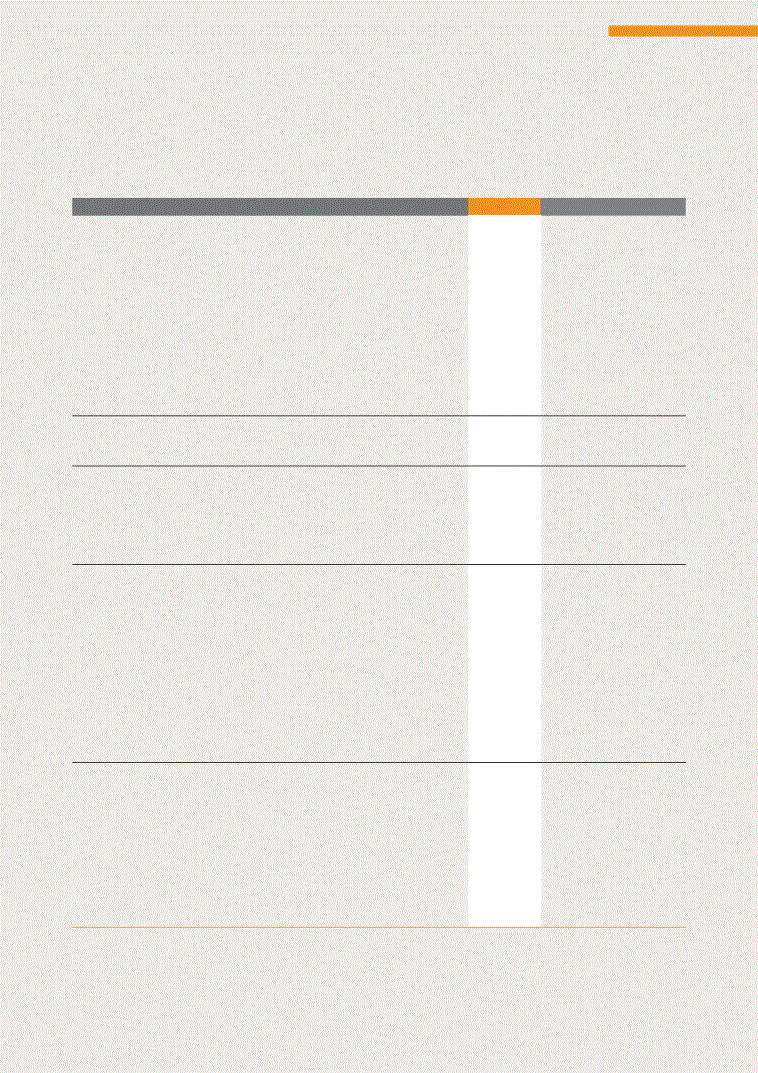
Key statistics
Units
2014
2013
2012
Operational performance
Tonnes treated/milled
Mt
29.9
26.9
27.8
Pay limit
oz/t
0.039
0.049
0.041
g/t
1.345
1.669
1.273
Recovered grade
oz/t
0.054
0.054
0.055
g/t
1.66
1.69
1.70
Gold production (attributable)
000oz
1,597
1,460
1,521
Total cash costs
$/oz
783
869
830
Total production costs
$/oz
977
1,086
1,060
All-in sustaining costs
(1)
$/oz
968
1,202
1,235
Capital expenditure
$m
454
839
925
Productivity
oz/TEC
14.36
9.97
10.97
Safety
Number of fatalities
0
2
5
AIFR
per million hours worked
1.56
1.97
2.26
People
Average no of employees: Total
16,070
16,625
16,621
– Permanent employees
8,739
10,778
10,014
– Contractors
7,331
5,847
6,607
Employee turnover
(2)
%
64
11
5
Training and development expenditure
$m
2
11
NR
Environment
Total water consumption
ML
17,582
21,031
(3)
19,132
Total water use per tonne treated
kL/t
0.56
0.67
0.60
Total energy usage
PJ
8.95
12.01
12.13
Total energy usage per tonne treated
GJ/t
0.29
0.38
0.38
Total greenhouse gas (GHG) emissions
000t CO
2
e
785
969
978
Total GHG emissions per tonne treated
t CO
2
e/t
0.03
0.03
0.03
Cyanide used
t
10,549
13,720
14,065
No. of reportable environmental incidents
4
5
5
Total rehabilitation liabilities:
$m
463.2
411.0
427.5
– restoration
$m
291.9
273.3
275.1
– decommissioning
$m
171.3
137.7
152.4
Community and government
Community expenditure
$m
3.9
13.3
13.3
Payments to government
$m
306
320
552
– Dividends
$m
16
21
(4)
51
– Taxation
$m
79
72
239
– Withholding tax (royalties, etc.)
$m
108
106
149
– Other indirect taxes and duties
$m
27
46
38
– Employee taxes and other contributions
$m
69
64
59
– Property tax
$m
1
5
6
– Other (includes skills development)
$m
6
6
10
(1)
Excludes stockpile write-offs.
(2)
Includes the retrenchment of the entire workforce at Obuasi.
(3)
Annual water usage data restated to exclude domestic water consumption.
(4)
Adjusted for Ghana – additional 2012 dividend.
NR = not reported
PERFORMANCE REVIEW
CONTINENTAL AFRICA
79
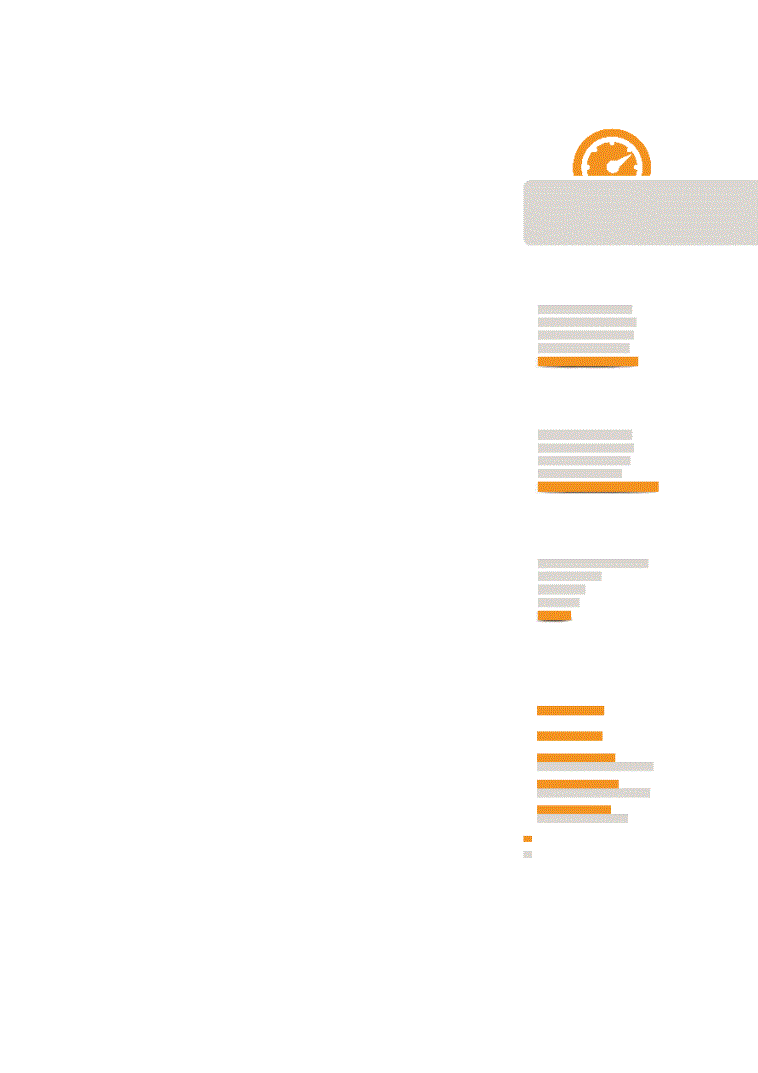
REGIONAL REVIEWS continued
Continental Africa
•
Yatela is 80% owned by the Sadiola Exploration Company Limited, a joint venture between
AngloGold Ashanti and IAMGOLD, giving each a 40% stake. The balance of 20% is owned
by the Government of Mali. Yatela is situated 25km north of Sadiola. Mining excavation
activities have been suspended. Processing of the heap leach pads and ore already mined
will continue until the end of 2016. Ore extraction in most of the open pits has been
completed and the mine has begun closure and rehabilitation procedures.
Tanzania
•
Geita, one of our flagship mines in the Continental Africa region, is located in northwestern
Tanzania, in the Lake Victoria goldfields of the Mwanza Region, about 120km from Mwanza
and 4km west of the town of Geita. The Geita gold deposit, which is currently mined as a
multiple open-pit operation, has underground potential and is currently serviced by a 5.2Mt
per annum carbon-in-leach (CIL) processing plant. While Geita generates its own power, the
operation of its power generating facility is outsourced and fuel is delivered by road.
OPERATIONAL PERFORMANCE
Production
The ramp up and first full year of production at Kibali more than offset the decline at Yatela
and the half-year contribution from Navachab which was sold in June 2014. The region’s
attributable production increased by 9%.
Kibali produced its first gold in 2013, ahead of schedule, and delivered 527,000oz in
2014, of which 45% was attributable to AngloGold Ashanti. Over the first 12 years of
operation – underground and open-pit – Kibali is expected to produce an annual average
of 600,000oz. These are high-margin ounces produced at a cost that is lower than the
group average.
During 2014, production at Kibali came largely from the open pit, while significant development
of underground workings was carried out. Underground mining commenced following the
start of blasting of the first stope in the latter of the year. The oxide plant was successfully
ramped up in early 2014 with the sulphide plant commissioned in the second half. Kibali’s
Ore Reserve is currently estimated at around 11Moz (attributable: 4.94Moz), accounting for
26% of the Continental Africa region’s Ore Reserve. Given the mine’s current life expectancy,
operations should be sustained until 2031.
Our largest operations in the region, Geita and Siguiri, recorded strong performances for the
year. At Geita, tonnes of hard sulphide ore milled surpassed 5Mt for the first time, a result
of better mill running time and fragmentation control. This followed improvements in blast
fragmentation, the installation of a secondary crusher and improved carbon management
systems in the leach circuit. These improvements offset grade declines at the Star & Comet
pit; the failure of the pit wall at Nyankanga Cut 7; and delays at Geita Hill East pit.
During the fourth quarter, an evaluation of the merits of switching from owner to contractor
operations at Geita was initiated. A change could reduce costs, which would align with the
group strategy of enhancing operational cash flows. Investigations into the feasibility of mining
and processing harder ore have begun, with a view to potentially extending the mine’s life.
At Siguiri, tonnes treated remained stable with a higher-than-expected improvement in
recovered grades contributing to an increase in production. The grades, however, declined in
the latter part of the year as higher-grade ore resources were depleted.
In Mali, production decreased overall as the mines continued to wind down, treating lower-
grade waste tonnes.
At Obuasi, while output increased marginally year-on-year, underground production was halted
in the fourth quarter. Processing of tailings and aboveground stockpiles is continuing. This
KEY PERFORMANCE
INDICATORS
Production
(000oz)
10
11
12
13
11
12
13
14
1,492
1,570
1,521
1,460
1,597
Productivity
(oz/TEC)
10
11
12
13
11
12
13
14
11.24
11.41
10.97
9.97
14.36
AIFR
(per million hours worked)
10
11
12
13
11
12
13
14
5.26
3.03
2.26
1.97
1.56
Total cash costs
All-in sustaining costs
(excluding stockpile write-offs)
(excluding stockpile write-offs)
Total cash costs and all-in
sustaining costs
sustaining costs
($/oz)
712
1,235
1,202
783
968
698
830
869
10
11
12
13
14
INTEGRATED REPORT
2014
80

was in line with the initiative to downscale the operation temporarily while a feasibility study is
undertaken to explore options for its long-term sustainability.
Tailings retreatment continued during the year, contributing to an improvement of close to
2% in ounces produced year-on-year, as we continued to fulfil environmental responsibilities.
Development of a decline from surface to the existing underground mining blocks continued in
2014. The decline will allow development of the appropriate infrastructure to enable mechanised
operations and de-bottleneck the mine, which was constrained by an outmoded, labour-
intensive mining method and also ageing and sub-optimal vertical hoisting infrastructure.
By year-end Obuasi had successfully transitioned to limited operations and the entire
workforce had been retrenched. A limited number of employees was recruited on a one-year
fixed-term contract while the feasibility study is underway. The study is due to be completed
in 2015.
Costs
Project 500 gained significant traction in the region, with noteworthy gains made in several
areas. In looking to improve process recoveries, an initiative to optimise dissolved oxygen
levels improved recoveries across all major operating sites, particularly at Geita, Siguiri and
Iduapriem. Mine plans were optimised, with low-margin or loss-making ounces removed,
while labour efficiencies were realised across the region. The expatriate contingent was
reduced and consultant services curtailed. At Geita, mining efficiencies resulted in greater
tonnages moved with no additions to the fleet, helping reduce unit mining costs. Work
was done to realise benefit of a more favourable environment for buyers of contract mining
services due to excess capacity across the globe. Competitive bidding processes for mining
and related contracts were held at Siguiri, Geita, Sadiola and Iduapriem, with all resulting
in new contractors or more favourable contracts agreed. Considerable effort was also
directed at reducing working capital through the optimisation of consumable stores across
the regional portfolio, and engagement with governments in Tanzania and Guinea to reduce
indirect tax lock-ups.
The region as a whole also continued to realise the benefit of more consistent operating
performance with tight management of all costs and capital. The region benefited from the
inclusion of the first full-year’s production from the Kibali mine, which contributed production
at lower-than-average cash cost. The sharply lower fuel price in the fourth quarter also aided
cost control efforts, particularly for open pits mines which operate large truck and shovel
fleets and generate all or part of their own power from diesel or heavy fuel oil, like the major
mines in the region Geita, Kibali and Siguiri. As with the rest of the group, the focus on strict
capital allocation and a more concentrated exploration programme was also a strong feature
in Continental Africa. The net result of these initiatives was a 19% reduction in all-in-sustaining
costs to $968/oz, the lowest in the group.
Growth and improvement
Our emphasis has been on improving operational and cost efficiencies in response to gold’s
decline. Kibali’s cost-efficient production ramp up has already contributed substantially to
overall production and a containment of overall costs per ounce. The production ramp up at
Kibali will further contribute additional ounces at a cost that is lower than the group average.
The focus for 2015 will be completion of the paste plant and the second hydro-power station
– Ambarau. The sinking of the vertical shaft remained ahead of schedule with a shaft depth of
720m at the end of the year with only 40m remaining.
In Guinea, despite indications of promising new developments, greenfields exploration teams
had to be withdrawn during the latter part of the year as a precaution against the outbreak of
the Ebola virus disease.
Capital expenditure
With completion of much of the
work to establish operations at
Kibali, capital expenditure for
Continental Africa dropped to
$454m in 2014 from 2013’s
$839m and a further fall is
anticipated in 2015, with the
construction of the sulphide
plant largely complete. Capital
expenditure was reduced
almost entirely at Obuasi, which
was placed on limited mining.
work to establish operations at
Kibali, capital expenditure for
Continental Africa dropped to
$454m in 2014 from 2013’s
$839m and a further fall is
anticipated in 2015, with the
construction of the sulphide
plant largely complete. Capital
expenditure was reduced
almost entirely at Obuasi, which
was placed on limited mining.
“
Kibali produces
high-margin ounces
at a cost significantly
lower than the
group average.
at a cost significantly
lower than the
group average.
”
PERFORMANCE REVIEW
81

REGIONAL REVIEWS continued
Continental Africa
SUSTAINABILITY PERFORMANCE
People
The average number of people in the workforce in the region declined, largely a result of
the retrenchment undertaken at Obuasi, to an average of 16,070 in 2014 from 16,625 in
2013. Regional productivity improved significantly to 14.36oz/TEC. Most retrenchments were
undertaken toward the end of the year.
Overall, the labour relations climate remained relatively positive and stable. At Obuasi, labour
relations were peaceful and the relationship with the Ghana Mineworkers Union (GMWU) was
constructive throughout the retrenchment process and the transition period, during which
production was downscaled. Refer to page 40 for additional information.
Separate wage negotiations were conducted at Iduapriem where the existence of four different
unions representing different categories of employees presents a dynamic and challenging
labour relations environment. Although negotiations covering the 2014 period were protracted
and took several months to finalise, a mutually beneficial settlement agreement was reached
without loss of production.
At Siguiri, the annual 2014 wage negotiations were concluded amicably as they were at
Yatela and Sadiola. As part of the Yatela mine closure, a life skills training programme for
employees facing retrenchment was completed in November 2014. Maiden annual wage
negotiations were successfully concluded with the Tanzanian Mines Energy Construction and
Allied Workers Union (TAMICO) which entered into a full recognition agreement following the
union’s achievement of the majority status required for the purposes of collective bargaining.
A joint capacity building workshop for both management and union representatives was
successfully conducted.
Health
Occupational health remains a top priority for Continental Africa, as with all our operations. The
main focus of the regional occupational health strategy is to combat noise-induced hearing loss
(NIHL), to reduce the incidence of silicosis at underground operations in Ghana and fight malaria.
In 2014, a total of 152 cases of NIHL were reported in all (the high number due to exit medical
examinations of employees following their retrenchment) and nine cases of silicosis in Ghana.
The introduction of improved reporting systems in the Africa region highlighted the incidence of
NIHL. These will be addressed by the introduction of engineering and administrative controls,
including the use of personalised hearing protection which offers greater protection and a
greater level of comfort.
One of the most significant community health risks in the region is malaria, which occurs
particularly in Ghana, Guinea, Mali, and Tanzania. The malaria intervention programmes in and
around our operations in these countries continued as did its roll-out in 25 districts in Ghana
under the auspices of the Global Fund project.
With the outbreak of the Ebola virus disease in West Africa, this became a serious health risk
in Guinea in particular and to a lesser extent in Mali. Measures were put in place to ensure
the company was prepared for any potential impact. By year-end, there had been no such
impact on our operations, although exploration activities in Guinea were suspended as a
precautionary measure.
Mineral Resource and
Ore Reserve
Ore Reserve
On 31 December 2014, the
region’s total attributable
Mineral Resource (inclusive of
the Ore Reserve) was 64.29Moz
(2013: 69.06Moz) and the
attributable Ore Reserve,
18.93Moz (2013: 24.41Moz).
This is equivalent to some 28%
and 33% of the group’s Mineral
Resource and Ore Reserve
respectively.
region’s total attributable
Mineral Resource (inclusive of
the Ore Reserve) was 64.29Moz
(2013: 69.06Moz) and the
attributable Ore Reserve,
18.93Moz (2013: 24.41Moz).
This is equivalent to some 28%
and 33% of the group’s Mineral
Resource and Ore Reserve
respectively.
Safety
Overall safety performance in
the Continental Africa region
continued to improve. There
were no fatalities during the year
and the all injury frequency rate
improved to 1.56 per million
hours worked (2013: 1.97).
the Continental Africa region
continued to improve. There
were no fatalities during the year
and the all injury frequency rate
improved to 1.56 per million
hours worked (2013: 1.97).
INTEGRATED REPORT
2014
82

Environment
Mining activities at the Yatela mine in Mali halted on 30 September 2013 and rehabilitation is
planned for completion in early 2019, with final relinquishment of mining rights expected to be
in 2020. Read more detail about closure preparations at Yatela in the
>SDR
.
In addition to the operational challenges faced at Obuasi, AngloGold Ashanti faces a range
of socio-economic and environmental challenges at both of its operations in Ghana. Most
environmental issues in this region relate to the management of water, waste and tailings,
rehabilitation and pollution. Hand-in-hand with the downscaling of operations at Obuasi, a
major undertaking during the year was continued work to resolve the environmental legacy
issues at the mine. A 15-month environmental management plan (EMP) covering the period
from October 2014 to December 2015 was submitted to the Environmental Protection Agency
(EPA) in July, and a formal response is awaited. A full EMP (2016 to 2019) will be developed as
part of the feasibility study for submission to the EPA in 2015. For further detail, see the
>SDR
.
Stakeholder engagement and communities
Current work regarding artisanal and small-scale mining (ASM) is focused on developing more
comprehensive baseline information on the nature and scale of ASM activity surrounding our
operations. A database of relevant information on ASM activity is being compiled to support our
engagement with government. Based on this information, a multi-stakeholder partnership was
established that includes other large-scale miners, regulators and ASM associations. Funding
by the World Bank led to the formation of a management advisory group focusing on a pilot
best practice operation in the village of Lwamgasa, near Geita in Tanzania. This project, which
is supported by AngloGold Ashanti, aims to formalise ASM by facilitating the construction of
a small-scale mine and providing training on safer, more efficient and environmentally friendly
mining and processing methods.
Resettlement processes were concluded successfully at Geita and at Iduapriem. At Geita, 18
households which had been living in temporary shelter were relocated to new housing in Tarzan
Valley and at Iduapriem, a 70-household community was resettled close by at Mankessim, an
area which is closer to amenities.
A limited relocation action plan (RAP) was completed for the Mofu satellite pit near Kibali.
The Gorumbwa RAP is expected to begin during 2015 with completion planned for 2016.
Human rights
An ambassador for human rights has been nominated at each site in the region to advance
human rights programmes and monitor compliance. Human rights audits are included in
combined assurance processes to identify potential human rights risks. Where security
incidents occur, they are dealt with in terms of the Voluntary Principles on Security and Human
Rights (VPSHR). These principles, together with our human rights policy, drive our approach to
human rights. During 2014, two VPSHR incidents occurred in the region.
At Geita mine the use of technology in conjunction with the deployment of skilled rapid reaction
teams, has been used to good effect to overcome the challenge of securing company property.
The mine, which covers an area of approximately 196.5km
2
, has been broken down into
geographical sectors using high-tech thermal surveillance cameras to detect potentially illegal
activity. The use of technology removes security personnel from situations of potential conflict
and ensures that response teams are furnished with the equipment and required information
to respond to situations if they occur.
OUTLOOK
In 2015, attributable production
from Continental Africa is expected
to be between 1.25Moz and
1.35Moz at a total cash cost of
between $788/oz and $839/oz
(all-in sustaining cost of $963/oz
– $1,011/oz).
from Continental Africa is expected
to be between 1.25Moz and
1.35Moz at a total cash cost of
between $788/oz and $839/oz
(all-in sustaining cost of $963/oz
– $1,011/oz).
Capital expenditure of around
$313m to $345m is planned.
$313m to $345m is planned.
As in the previous year, cost
containment and enhanced
productivity will remain priorities.
containment and enhanced
productivity will remain priorities.
PERFORMANCE REVIEW
83

REGIONAL REVIEWS continued
Australasia
AngloGold Ashanti’s operations in the Australasia region include
Tropicana, one of our two newest mines. Tropicana completed its first
full year of production in 2014.
Tropicana, one of our two newest mines. Tropicana completed its first
full year of production in 2014.
The two AngloGold Ashanti operations in the region are:
•
Sunrise Dam, which is wholly-owned, is located 220km northeast of Kalgoorlie and
55km south of Laverton in Western Australia. Mining of the Crown Pillar at the base
of the 490m deep pit was completed in early 2014. By year-end, underground mining,
which is conducted by a contract mining company, was the primary source of ore. Ore
is treated via conventional gravity and carbon-in-leach (CIL) processing plant which is
owner-managed.
•
Tropicana, a joint venture between AngloGold Ashanti (70% and manager) and Independence
Group NL (30%), is located 200km east of Sunrise Dam and 330km east-northeast of
Kalgoorlie. First gold was poured ahead of schedule and on budget in September 2013,
following development approval in November 2010. The open pit operation features a large
scale, modern processing plant which uses conventional carbon-in-leach technology and
includes high-pressure grinding rolls for energy-efficient comminution. Mining is carried out
by a contract mining company and the plant is owner-managed.
OPERATIONAL PERFORMANCE
Production
With the ramp up in production at Tropicana during the course of 2014, the mine’s first full year
of operation, and considerably increased levels of output at Sunrise Dam, total production for
the Australasia region was 81% higher.
At Sunrise Dam, the underground mine transitioned to become the primary source of mill
feed in 2014, delivering 2.43Mt of ore to the mill for the year. Stockpiled intermediate grade
ore (average 1.45g/t) was blended with the underground ore to meet the processing plant
capacity, which saw throughput reach 3.8Mt in 2014, a 10% improvement on 2013 despite
the higher proportion of harder underground ore treated. Plant performance improved due to
the focus on engineering reliability, which significantly reduced plant down time.
An intensive two-year project on planning systems and operational efficiencies resulted in
substantial productivity improvements in the underground mine, culminating in a record
675,503t of underground ore being mined in the December quarter – equivalent to an
annualised rate of 2.7Mt. This mining rate is expected to be maintained in 2015. The multi-
pronged productivity improvement strategy included an innovative approach to grade control
based on reverse circulation (RC) drilling that emulated the highly successful grade control
process in the open pit. The change to RC drilling combined with productivity improvements
gained in the underground mine drove mining costs down by more than 50% over the two-
year period.
Tropicana, which was officially opened in March 2014 by the Western Australian Minister
for Mines, the Hon. Bill Marmion, completed its first full year of operation. In total, the mine
produced 511,000oz of which AngloGold Ashanti’s share was 358,000oz. Open pit mining
focused on the Havana and Tropicana pits in 2014. During the year additional mining fleet
was brought to the site to counteract a decrease in mining rates caused by poor equipment
availability and lower-than-planned productivity. Mining productivity improved in the fourth
quarter and it is anticipated that productivity rates will be back on target in the first quarter
of 2015. Despite these challenges, feed to the processing plant was on budget, enabling
treatment of 5.7Mt for the year at a head grade of 3.06g/t and metallurgical recovery of
90%. Mine-to-mill reconciliation, in terms of both tonnes and grade, aligned extremely well,
providing confidence in production forecasts going forward.
Contribution to group production – 2014
•
Australasia
14
• Rest of AngloGold Ashanti
86
%
Contribution to regional production
by mine – 2014
by mine – 2014
•
Sunrise Dam
42
• Tropicana
58
%
COSTS
Total cash costs for the region
declined by 23% and all-in
sustaining costs by 28%. Costs
for the Australasian region
were positively affected by the
ramp-up to full production at
Tropicana, and productivity
improvements at Sunrise Dam.
However, at Tropicana these unit
cost reductions were impacted
by higher mining costs resulting
from fleet productivity issues and
increased plant maintenance
costs. These cost increases
however, were offset by savings
in other areas resulting in the
operation delivering on the cost
performance anticipated in the
feasibility study, consistent with
market guidance.
declined by 23% and all-in
sustaining costs by 28%. Costs
for the Australasian region
were positively affected by the
ramp-up to full production at
Tropicana, and productivity
improvements at Sunrise Dam.
However, at Tropicana these unit
cost reductions were impacted
by higher mining costs resulting
from fleet productivity issues and
increased plant maintenance
costs. These cost increases
however, were offset by savings
in other areas resulting in the
operation delivering on the cost
performance anticipated in the
feasibility study, consistent with
market guidance.
INTEGRATED REPORT
2014
84
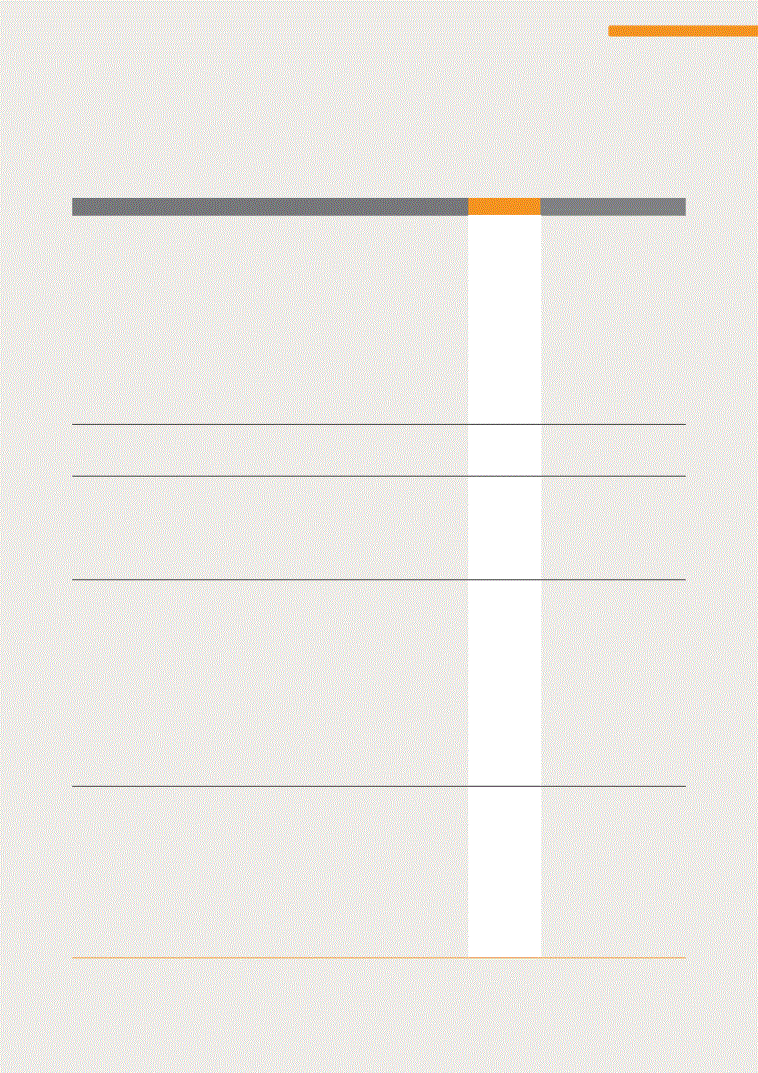
Key statistics
Units
2014
2013
2012
Operational performance
Tonnes treated/milled
Mt
7.8
4.3
3.4
Pay limit
oz/t
0.07
0.09
0.08
g/t
2.29
2.82
2.42
Recovered grade
oz/t
0.072
0.072
0.070
g/t
2.45
2.45
2.39
Gold production (attributable)
000oz
620
342
258
Total cash costs
$/oz
804
1,047
1,211
Total production costs
$/oz
1,070
1,333
1,358
All-in sustaining costs
(1)
$/oz
986
1,376
1,680
Capital expenditure
$m
91
285
369
Productivity
oz/TEC
62.00
49.64
43.46
Safety
Number of fatalities
0
0
0
AIFR
per million hours worked
10.73
(2)
7.91
6.33
People
Average no of employees: Total
832
925
494
– Permanent employees
194
281
110
– Contractors
638
644
384
Employee turnover
%
15
22
14
Training and development expenditure
$m
1
2
1
Environment
Total water consumption
ML
8,011
4,828
3,104
Total water use per tonne treated
kL/t
0.84
1.03
0.92
Total energy usage
PJ
5.52
2.81
2.08
Total energy usage per tonne treated
GJ/t
0.58
0.60
0.62
Total greenhouse gas (GHG) emissions
000t CO
2
e
359
174
125
Total GHG emissions per tonne treated
t CO
2
e/t
0.04
0.04
0.04
Cyanide used
t
4,398
1,658
1,331
No. of reportable environmental incidents
0
2
1
Total rehabilitation liabilities:
$m
65.5
53.1
61.5
– restoration
$m
32.0
21.9
26.8
– decommissioning
$m
33.5
31.2
34.7
Community and government
Community expenditure
$m
0.2
0.5
0.5
Payments to government
$m
67
49
88
– Dividends
$m
–
–
–
– Taxation
$m
8
7
47
– Withholding tax (royalties, etc.)
$m
19
16
11
– Other indirect taxes and duties
$m
–
–
–
– Employee taxes and other contributions
$m
40
26
30
– Property tax
$m
–
–
–
– Other
$m
–
–
–
(1)
Excludes stockpile write-offs.
(2)
Restated owing to injury reclassification and/or progression of injury severity.
PERFORMANCE REVIEW
AUSTRALASIA
85
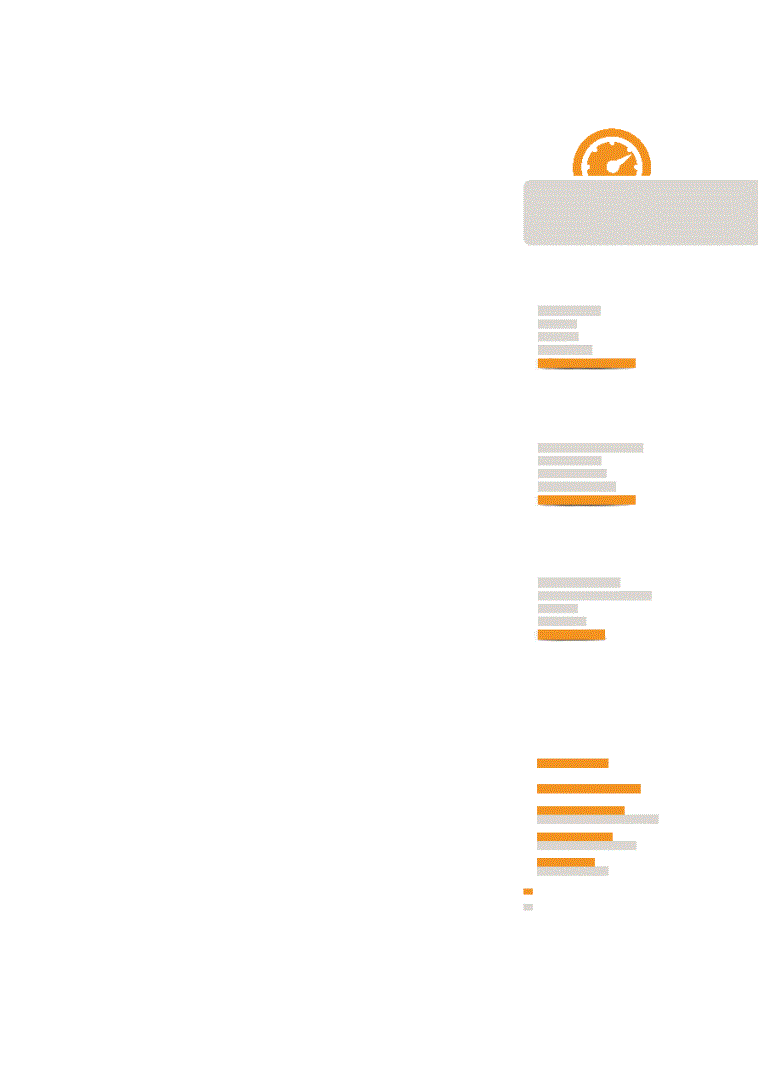
REGIONAL REVIEWS continued
Australasia
Growth and improvement
At Tropicana, additional maintenance and engineering work was carried out in the processing
plant during the year to close out construction work following commissioning and to optimise
sections of the plant with a view to lifting throughput beyond nameplate capacity in 2015. At
year-end regulatory approvals were received to complete an expansion of the process water
supply borefield that provides water to the operation. By the end of the first quarter in 2015,
an additional 27 bores will have been installed and commissioned to take the number of bores
servicing the plant to 51 and capacity from approximately 750t of water per hour (tph) to more
than 1,000tph.
Analysis of data from a 3D seismic survey which was conducted across the Tropicana
ore bodies is expected to be completed in the first half of 2015. This analysis will enable
more accurate and more cost effective targeting of deep drill holes to test for extensions
of mineralisation beneath the current open pit. This drilling data will augment work already
carried out on the Havana Deeps study to determine if the down plunge extensions to
the ore bodies continue to the north below Tropicana and Boston Shaker. Ultimately, this
information will determine whether these ore bodies could be mined via a large open pit or
by underground methods.
In July 2014, AngloGold Ashanti signed agreements with a natural gas infrastructure
company for the transportation of natural gas to Sunrise Dam and Tropicana. It is expected
that this will provide continuity of fuel supply, reduce exposure to diesel price volatility
and significantly reduce the number of trucks on the site access roads. This will yield
important safety benefits and will help in reducing road maintenance costs. Construction is
scheduled to start in the first quarter of 2015 with first gas due to be available at Tropicana
in January 2016. The power stations at both mines will be modified to run on 100% natural
gas. Backup diesel capability will be retained for emergencies. Gas power generation is
expected to reduce cash operating costs.
Mineral Resource and Ore Reserve
At 31 December 2014, the total attributable Mineral Resource (inclusive of the Ore Reserve)
for the Australasia region was 9.58Moz (2013: 8.63Moz) and the attributable Ore Reserve,
3.53Moz (2013: 3.81Moz). This is equivalent to around 4% and 6% of the group’s attributable
Mineral Resource and Ore Reserve respectively.
SUSTAINABILITY PERFORMANCE
People
The workforce in the Australasia region averaged 832 – 194 full-time employees and 638
contractors. Productivity remained high, with the Australasia region reporting 62.00oz/TEC in
2014 (2013: 49.64oz/TEC), again the highest in the group.
Safety
No fatalities were reported in the region and the 2014 AIFR was 10.73 per million hours worked
(2013: 7.91 – restated). The deterioration in safety performance was due to the reduced number
of hours worked as construction at Tropicana was completed. Sunrise Dam has retained its
independently verified OHSAS 18001 rating with Tropicana scheduled for its first OHSAS 81001
certification audit in 2015.
Diesel particulate exposure has recently been identified as a potential health risk in Australia.
Efforts to mitigate this potential impact are at an early stage.
Environment
Environmental management in the Australasian region has seen more prescriptive regulations
and an increasing requirement to provide greater transparency, more inclusive consultation and
more detailed public reporting on performance. Both Tropicana and Sunrise Dam continued
KEY PERFORMANCE
INDICATORS
Production
(000oz)
10
11
12
13
11
12
13
14
396
246
258
342
620
Productivity
(oz/TEC)
10
11
12
13
11
12
13
14
66.77
40.29
43.46
49.64
62.00
AIFR
(per million hours worked)
10
11
12
13
11
12
13
14
13.10
18.11
6.33
7.91*
10.73
* Restated owing to injury reclassifications
Total cash costs
All-in sustaining costs
(excluding stockpile write-offs)
(excluding stockpile write-offs)
Total cash costs and all-in
sustaining costs
sustaining costs
(S/oz)
982
1,680
1,376
804
986
1,431
1,211
1,047
10
11
12
13
14
INTEGRATED REPORT
2014
86

to perform well in terms of the management of environmental incidents as they focus on their
three-year safety and environmental management plans, which include key performance
indicators on reportable incidents.
Water management is a focus area, mainly due to the arid environment in the Western Australian
goldfields where the only available ground water is highly saline. Short-term water supply
constraints at Tropicana are being addressed with the expansion of borehole infrastructure to
increase the capacity of the water abstraction and delivery system, as discussed above under
growth and improvement. Potable water used in the accommodation villages at both Sunrise
Dam and Tropicana is desalinated using a reverse osmosis process and waste water from the
Tropicana village is in turn used in the processing plant where low salinity water is required,
such as in the gold elution circuit.
Biodiversity is another feature of the safety and environmental management plan and
this was an integral part of the development of Tropicana. As part of the operation’s
biodiversity offsets strategy in its approved environmental management plan, the Great
Victoria Desert Biodiversity Trust was established. A condition of the Federal Environmental
Protection and Biodiversity Conversation Act approval for the mine, the trust reflects
the Tropicana Joint Venture partners’ recognition of the need to base environmental
management decisions on robust science. The trust, in a model unique to the Western
Australian mining and environmental landscape, will fund research on the remote Great
Victoria Desert, where the mine is located. An independent trustee is accountable for
the trust’s financial management and the trust is being administered by a management
panel comprising an independent chairman, and representatives of Western Australia’s
Department of Parks and Wildlife and the company. Technical advisory panels will guide
scientific decisions and provide third party reviews and input into the research and on-
ground conservation work. The trust’s aim is to promote knowledge and understanding
of the Great Victoria Desert region and its biodiversity so as to benefit conservation and
scientific knowledge.
The Australian government withdrew its proposed carbon tax legislation during the course of
the year.
Stakeholder engagement and communities
In Australia, a ‘Think Local, Buy Local, Employ Local’ strategy has been adopted at both
the Australian operations to promote the growth of local supply networks. In terms of
the ‘Buy Local’ programme, where capability exists and where there is a competitive
value proposition, goods and services are procured from local vendors in preference to
those from outside the region. Procurement spend in the Goldfields-Esperance region, in
which AngloGold Ashanti’s operations are located, is currently 18% of total spend, with
procurement from businesses in the rest of the state of Western Australia making up a
further 78% of the total.
AngloGold Ashanti has also played a leading role in developing indigenous-owned businesses.
An indigenous business development programme offers structured business coaching and
mentoring and five indigenous-owned businesses are currently supplying goods and services
to operations in Australia. For more information, see the
>SDR
.
Youth development programmes which aim to create opportunities for young indigenous
people are also a priority, especially given the remote and isolated location of our operations
in Australia, which is characterised by limited community resources, poor education
and health, minimal opportunities for work and high unemployment. Work readiness
programmes seek to support the transition of indigenous, female and disadvantaged youth
to the workplace through training and work experience which can lead to employment in
the mining industry.
OUTLOOK
Production at both operations is
expected to be marginally lower in
2015, with Tropicana maintaining
steady production from the ramp
up stage.
Further productivity and
production improvements at
Sunrise Dam are expected to
result in lower overall costs for
the region as a whole. Attributable
gold production in 2015 is
targeted at between 0.56Moz and
0.61Moz ounces at a total cash
cost of between $794/oz and
$845/oz (all-in sustaining costs of
between $953/oz and $1,001/oz).
Capital expenditure is budgeted at
between $71m and $78m.
Capital expenditure
Capital expenditure for
Australasia reduced
significantly to $91m in
2014 (2013: $285m) with
the completion of much of
the construction at Tropicana
as well as completion of the
transition at Sunrise Dam
from open-pit to underground
mining. Capital expenditure at
Tropicana fell to $59m from
$241m in 2013 while at Sunrise
Dam expenditure was $31m
against $39m the previous year.
Australasia reduced
significantly to $91m in
2014 (2013: $285m) with
the completion of much of
the construction at Tropicana
as well as completion of the
transition at Sunrise Dam
from open-pit to underground
mining. Capital expenditure at
Tropicana fell to $59m from
$241m in 2013 while at Sunrise
Dam expenditure was $31m
against $39m the previous year.
87

REGIONAL REVIEWS continued
Americas
AngloGold Ashanti has four mining operations – both open pit and deep
level mining – in the Americas region. In addition, there is an active
greenfields exploration programme underway in Colombia.
level mining – in the Americas region. In addition, there is an active
greenfields exploration programme underway in Colombia.
Argentina
•
Cerro Vanguardia, in which AngloGold Ashanti has a 92.5% stake, is the company’s sole
operation in Argentina. Fomicruz, a state company operating in the province of Santa Cruz,
owns the remaining 7.5%. Located to the northwest of Puerto San Julián in the province of
Santa Cruz, Cerro Vanguardia operates multiple small open pits with high stripping ratios
and multiple narrow-vein underground mines. The metallurgical plant has a daily capacity of
3,000t and includes a cyanide recovery facility.
Brazil
•
AngloGold Ashanti Córrego do Sítio Mineração (AGA Mineração), which is wholly owned,
comprises two operational complexes located in the state of Minas Gerais, close to the city
of Belo Horizonte:
•
The Cuiabá complex includes the Cuiabá and Lamego mines and the Cuiabá and
Queiroz plant complexes. Cuiabá has been in operation for 29 years while Lamego is a
more recently developed underground mine. Ore from the Cuiabá and Lamego mines is
processed at the Cuiabá gold plant. The concentrate produced is transported 15km by
aerial ropeway to the Queiroz plant for processing and refining. Total annual capacity of
the complete Cuiabá circuit is 1.7Mt. The Queiroz hydrometallurgical plant also produces
around 200,000t of sulphuric acid as a by-product, which is sold commercially on local
Brazilian markets. The Cuiabá complex is changing its mining method from cut-and-
fill to sub-level stoping so as to increase the contribution of narrow-vein ore bodies to
production (from 15% to 40%) and to improve rock engineering controls.
•
The Córrego do Sítio complex comprises one surface (oxide) and two underground
(sulphide) mines, as well as a heap leach pad and sulphide plant.
•
Serra Grande, which is wholly owned by AngloGold Ashanti, is located in central Brazil in the
state of Goiás, about 5km from the city of Crixás. It comprises three mechanised underground
mines: Mina III (the ore body IV), Mina Nova (the Pequizão ore body) and Palmeiras – and an
open pit in the outcrop of the Mina III ore body. One dedicated metallurgical plant treats all
ore mined. Annual plant capacity is 1.3Mt. The mine has enhanced the group’s production,
Ore Reserve and Mineral Resource profiles through the 100% ownership, making a positive
contribution toward AngloGold Ashanti’s near-term gold production profile in Brazil.
United States
•
AngloGold Ashanti holds a 100% interest in the Cripple Creek & Victor (CC&V) Gold Mining
Company’s Cresson mine, located in the state of Colorado. A surface mining operation
provides oxidised ore to a crusher and valley leach facility, one of the largest in the world.
Higher-grade ore with more sulphidic properties will be processed in a carbon-in-pulp (CIP)
mill to achieve better recoveries. A two-phase mine-life-extension (MLE) project is well
underway and is expected to increase production significantly from 2015.
Colombia
•
Two advanced major exploration projects, La Colosa and Gramalote, are currently
underway in Colombia. Extensive exploration activities are also being conducted in the
region, across a reduced mineral tenement portfolio, by either AngloGold Ashanti teams or
together with joint venture partners. A significant portion of the year was devoted to a third
noteworthy Quebradona project area, releasing the maiden resource for Nuevo Chaquiro
deposit. Refer to the section entitled Planning for the future on page 111 for further details.
Contribution to group production – 2014
•
Americas
22
• Rest of AngloGold Ashanti
78
%
Contribution to regional production
by country – 2014
by country – 2014
•
Argentina
25
• Brazil
54
•
United States
21
%
INTEGRATED REPORT
2014
88
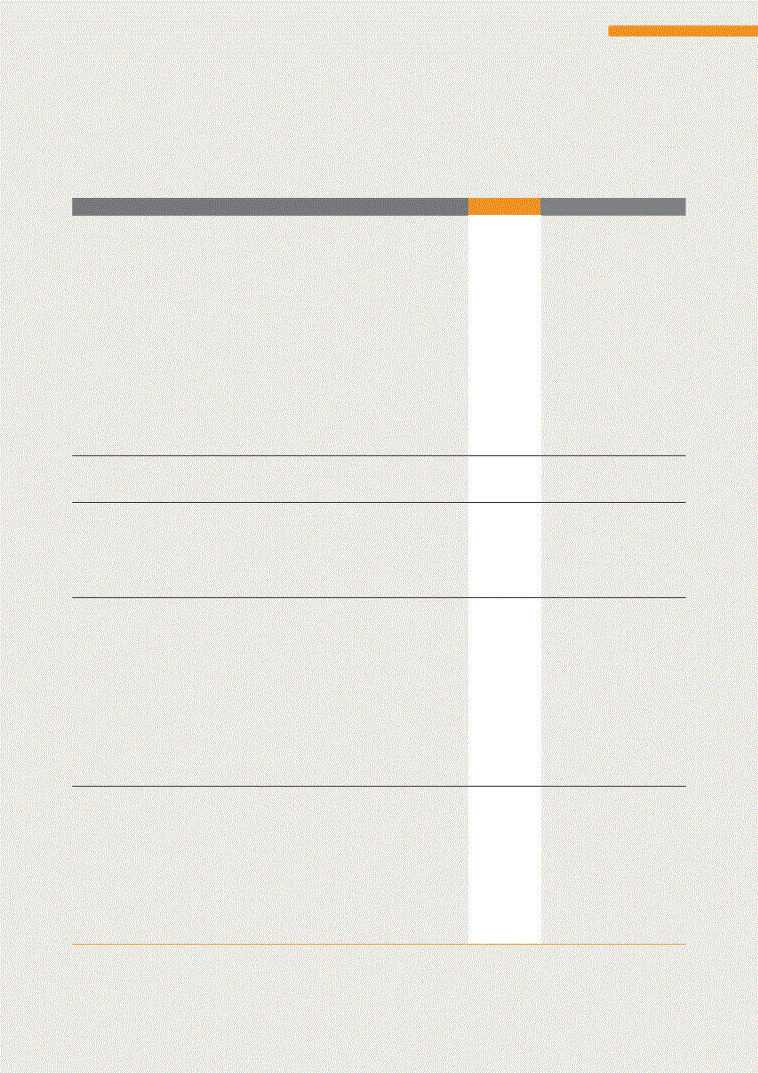
Key statistics
Units
2014
2013
2012
Operational performance
Tonnes treated/milled
Mt
26.1
26.7
25.7
Pay limit
oz/t
0.034
0.026
0.024
g/t
1.156
0.897
0.822
Recovered grade
oz/t
0.035
0.036
0.034
g/t
1.13
1.20
1.16
Gold production (attributable)
000oz
996
1,001
953
Silver (attributable)
Moz
3.1
3.3
2.4
Total cash costs
$/oz
709
671
669
Total production costs
$/oz
942
886
907
All-in sustaining costs
(1)
$/oz
1,010
970
1,006
Capital expenditure (100% basis)
$m
394
410
409
– Attributable (including Colombia)
$m
390
405
395
– Attributable (excluding Colombia)
$m
388
391
387
Productivity
oz/TEC
16.35
16.63
17.47
Safety
Number of fatalities
2
0
1
AIFR
per million hours worked
3.81
(2)
4.74
(2)
5.20
People
Average no of employees: Total
(3)
8,588
8,374
7,896
– Permanent employees
5,944
5,979
5,509
– Contractors
2,644
2,395
2,387
Employee turnover
%
13
14
11
Training and development expenditure (excluding Colombia)
$m
2
3
6
Environment (excludes Colombia)
Total water consumption
ML
12,170
11,732
7,456
Total water use per tonne treated
kL/t
0.45
0.44
0.29
Energy usage
PJ
6.05
6.06
5.88
Total energy usage per tonne treated
GJ/t
0.23
0.23
0.23
Total greenhouse gas (GHG) emissions
000t CO
2
e
449
399
389
Total GHG emissions per tonne treated
t CO
2
e/t
0.017
0.013
0.015
Cyanide
(2)
used
t
6,428
6,203
5,807
No. of reportable environmental incidents
0
0
0
Total rehabilitation liabilities (includes Colombia):
$m
272.8
236.6
249.5
– restoration
$m
221.9
194.3
211.9
– decommissioning
$m
50.9
42.3
37.6
Community and government (includes Colombia)
Community expenditure
$m
3.7
5.7
5.1
Payments to government
$m
261
314
356
– Dividends
$m
–
8
10
– Taxation
$m
69
103
146
– Withholding tax (royalties, etc.)
$m
38
47
44
– Other indirect taxes and duties
$m
8
8
10
– Employee taxes and other contributions
$m
97
100
94
– Property tax
$m
2
3
3
– Other
$m
47
45
49
(1)
Excludes stockpile write-offs.
(2)
Restated owing to injury reclassification and/or progression of injury severity.
(3)
100% basis and excluding Colombia and Denver regional office.
PERFORMANCE REVIEW
AMERICAS
89
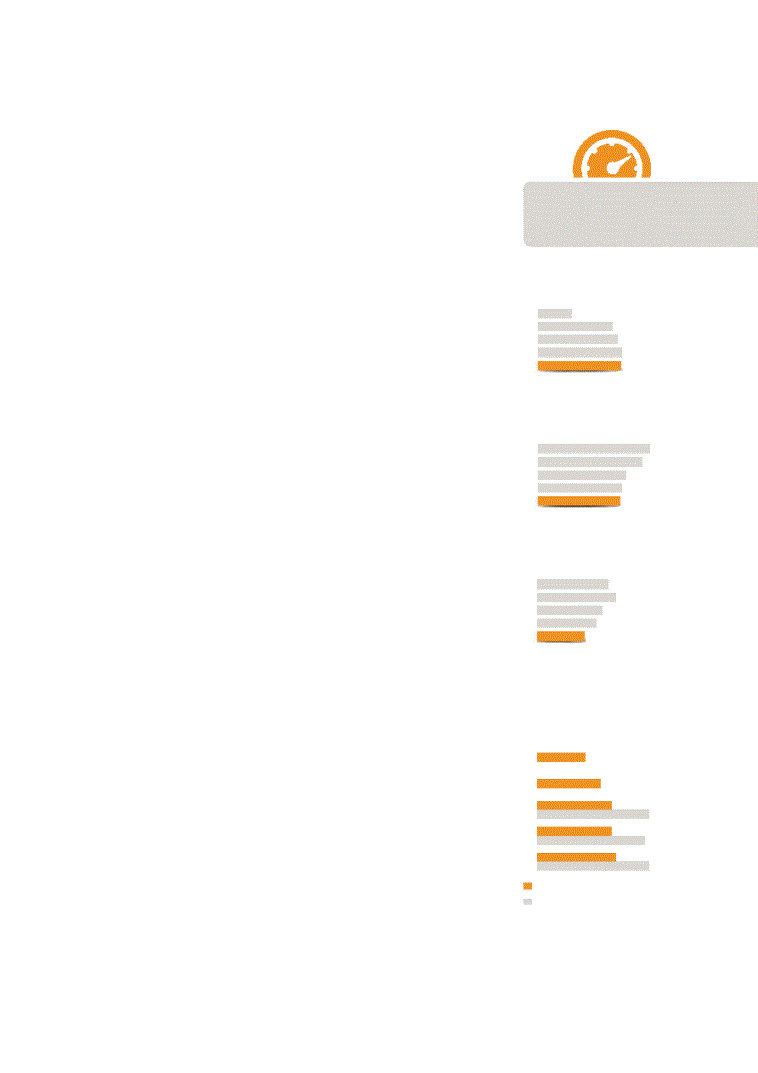
OPERATIONAL PERFORMANCE
Production
The year was a challenging one overall for the Americas operations and overall production from
the region declined marginally. Higher production from AGA Mineração and Cerro Vanguardia
failed to offset declines at CC&V and Serra Grande. Production was somewhat hampered by
lower grades for some mines as well as negative stockpile movements. Cerro Vanguardia’s
production for 2014 was the highest in 11 years, due mainly to improved heap-leach production.
AGA Mineração continued to deliver a strong performance with increased tonnage and feed
grades at both the Cuiabá and Córrego do Sítio complexes. Development here exceeded
expectations and production began from the new ore body at Córrego do Sítio (Sulphide II) and
full production rates were achieved at the underground Mine I.
At CC&V, production was negatively affected by several factors including increased amounts
of clay in the ore that resulted in reduced volumes and lower-grade ore being supplied to the
crusher. Certification delays for an exposed liner necessitated modifications to the heap-leach
stacking plan, leading to deferred production in the early part of 2014.
The Americas region’s contribution to group attributable production declined to 22% due to
growth in Australia and Continental Africa. In addition, the region produced 3.5Moz (attributable)
of silver as a by-product.
Costs
Despite the intense focus on limiting cost increases over the past year, regional costs increased
by around 5%, due largely to inflationary pressures in the South American countries. The
higher levels of production at AGA Mineração and Cerro Vanguardia unfortunately failed
to offset increased costs at Serra Grande and CC&V. Although overall costs increased at
Cerro Vanguardia due to deferred stripping adjustments, the negative impact of stockpile
movement and inflationary pressures and wage increases, these were partially countered by
the increased production and weaker exchange rates. The depreciation of both the Brazilian
real and Argentinian peso helped to limit cost increases in those countries, as did various
cost management initiatives. Operating challenges resulted in regional all-in sustaining costs
increasing by 4%.
Taxation and royalty payments were lower at all operations, in line with subdued gold and
silver prices.
In line with the group cost optimisation drive, the focus of savings initiatives in the Americas
region was on labour, contractors, energy, consumables, and working and stay-in-business
capital. Various initiatives aimed at efficiency and production improvements (underground
mine-design optimisation, tyre-life extension, and the optimisation and stabilisation of CIL and
regeneration circuits), continued.
Cost-savings initiatives at CC&V focused on improving efficiencies derived from consumables
and tyres, and better fleet time management. This enhanced crusher throughput and resulted
in savings of $4m.
In Brazil, potential savings identified in 2013 were addressed by initiatives implemented in 2014.
These cost and cash management programmes involved productivity improvements, process
optimisation, and reductions in power costs, materials pricing and administrative expenses.
REGIONAL REVIEWS continued
Americas
KEY PERFORMANCE
INDICATORS
Production
(000oz)
10
11
12
13
11
12
13
14
842
891
953
1,001
996
Productivity
(oz/TEC)
10
11
12
13
11
12
13
14
22.44
20.70
17.47
16.63
16.35
AIFR
(per million hours worked)
10
11
12
13
11
12
13
14
5.66
6.33
5.20*
4.74*
3.81
* Restated owing to injury reclassifications
Total cash costs
All-in sustaining costs
(excluding stockpile write-offs)
(excluding stockpile write-offs)
Total cash costs and all-in
sustaining costs
sustaining costs
($/oz)
432
1,006
970
709
1,010
569
669
671
10
11
12
13
14
INTEGRATED REPORT
2014
90

Growth and improvement
Various growth programmes are underway at all operations in the region, the most significant
of which is CC&V’s expansion project. The first part of the two-phase MLE project began
production in 2011 and is expected to continue until 2016. MLE2 will expand the operation
to include a second valley heap-leach facility (VLF), a CIP mill to process sulphide material
and an associated gold recovery plant. This MLE project is expected to significantly increase
production for CC&V while reducing operating costs. The mill began commissioning at the end
of 2014 and production is scheduled to begin in the first half of 2015. The second VLF is due
to start production in the second half of 2016.
At Cerro Vanguardia, an underground mining expansion project is being undertaken to improve
efficiencies and productivity through underground mine design optimisation and optimisation
and stabilisation of the CIP and regeneration circuits.
At the Brazilian operations, the focus was principally on optimisation initiatives to improve
operational efficiencies. At AGA Mineração’s Córrego do Sítio complex, full production rates
were improved at both the sulphide and oxide mines. The brownfields drilling programme at
Córrego do Sítio continued and identified satellite ore bodies close to existing infrastructure.
These exploration successes will potentially improve production both in the short term and
over the life of mine.
Colombia remains a key area of focus for the exploration programme and continues to
yield promising results. A particular success was the release of the maiden Inferred Mineral
Resource estimate for Nuevo Chaquiro, which is part of the Quebradona greenfields exploration
programme. Studies and engagement with the local communities continue.
Mineral Resource and Ore Reserve
As at 31 December 2014, the total attributable Mineral Resource (inclusive of the Ore Reserve)
for the Americas region was 72.48Moz (2013: 61.06Moz) and the attributable Ore Reserve,
7.56Moz (2013: 8.82Moz). This is equivalent to around 31% and 13% of the group’s attributable
Mineral Resource and Ore Reserve respectively.
SUSTAINABILITY PERFORMANCE
People
On average, the workforce in the Americas region totalled 8,588 people for the year – 5,944
full-time employees and 2,644 contractors – as compared to 8,374 in 2013. Productivity for
the region was 16.35oz/TEC as compared to 16.63oz/TEC in 2013.
Although the decline in commodity prices and the slowdown in the Brazilian economy will
potentially affect the unemployment rate and possibly reduce the competition for employment
in Brazil, it is not certain that this will eliminate the skills shortfall.
Safety
Two fatalities were reported in the Americas region (2013: 0). Two contractor employees
lost their lives in an incident at AGA Mineração’s Cuiabá mine during the renovation of the
ventilation shaft when the braking mechanism for a rope holding a suspended platform in
place failed. The AIFR for the region was 3.81 per million hours worked in 2014 (2013: 4.74
– restated).
PERFORMANCE REVIEW
Capital expenditure
In line with the continuing
group-wide cost and strategic
review, capital expenditure of
$394m in the Americas region
for 2014 was 4% less than the
previous year. Of this, $145m
was spent on the MLE project
at CC&V. Additional expenditure
was on ore development and
general stay-in-business
activities at all operations.
group-wide cost and strategic
review, capital expenditure of
$394m in the Americas region
for 2014 was 4% less than the
previous year. Of this, $145m
was spent on the MLE project
at CC&V. Additional expenditure
was on ore development and
general stay-in-business
activities at all operations.
91

REGIONAL REVIEWS continued
Americas
In Brazil, where there was renewed emphasis on safety, the Consequences policy was
launched, which is based on ten key rules that are to be followed by all employees and
contractors. This policy standardises and makes more transparent the recognition of positive
safety behaviour and safe mining practice. This is intended to develop and build on AngloGold
Ashanti’s preventative safety, health and environment policies.
Health
CC&V’s health programme continues to be successful through ongoing noise testing and
monitoring as well as continued dust sampling and training. To ensure a drug- and alcohol-
free workplace, random drug testing continued throughout the year as did third-party post-
accident and reasonable suspicion testing. At Cerro Vanguardia, trainings sessions and
employee medical examinations continued.
In Brazil, along with occupational screening tests, the company continued with the quality of
life programmes, such as Mais Viver (Live More). This programme encourages employees to
eat more healthily (with professional nutritional guidance) and to participate in sport (walking
and running groups have been formed). Preventive campaigns focused on breast and prostate
cancer, and HIV/Aids.
While it is a potential risk at underground operations, silicosis has been eradicated at our Brazilian
operations, a result of mechanisation, improved ventilation, dust suppression, personal preventative
measures and statutory limitations on the length of service of underground employees.
Environment
No significant environmental incidents were reported during the year. All the Americas
operations remain ISO 14001-compliant and have been certified in terms of the international
cyanide management code.
In 2014, the Brazilian operations obtained all relevant licencing for the Cuiába dam-raising and
for the consolidation of the Córrego do Sítio complex. The underground water recirculation
project implemented at the Cuiába mine was among the top five finalists among 99 projects
competing for the national prize for Best Practices in Water Management, organised by the
federal government’s National Water Agency (ANA).
Colombia is one of the most bio-diverse countries in the world and there is thus a high level
of environmental awareness and of the need to limit the adverse impact on the environment.
AngloGold Ashanti, recognising this from the start of mineral exploration activities in 2006,
has made every effort to minimise the impact of its activities and to implement any mitigation
plans if necessary. During 2014, there were no reportable environmental incidents (high, major
or extreme) at La Colosa, Gramalote or other explorations areas. Greenfields exploration
drilling was conducted in a manner designed to limit surface disturbance, re-circulate drill
water and restore drilling locations to their pre-existing condition.
INTEGRATED REPORT
2014
92

Stakeholder engagement and communities
AngloGold Ashanti Colombia first “coined” the phrase “social political enablement” in 2013
as a reference point to the necessity of obtaining the critical social acceptance and social
licence to operate its business. Social political enablement spans a broad spectrum of activity
and, in 2014, this activity centred on working closely in those communities that are directly
and indirectly affected by AngloGold Ashanti’s exploration work. Primary delivery consisted
of projects and programmes of social infrastructure, education, support and institutional
strengthening. All of this work was developed in alignment with the communities engaged, with
the support of various levels of government, and it has allowed for the creation of ownership
and sustainability among communities.
CC&V continues to implement its engagement strategy which is primarily focused on creating
and maintaining open communication with communities and stakeholders regarding mining
operations with an emphasis on MLE2.
In Argentina, successful local socio-economic development was undertaken around the Cerro
Vanguardia mine where we have engaged closely with the community of San Julián since the
start of operations more than 20 years ago. This strategy is based on permanent and continuous
dialogue with all local institutions and organisations as well as the local and provincial authorities.
A development agency was established in 2004, a collaboration between the mine, the local and
provincial authorities, the local university, the rural association and the Chamber of Commerce,
which has been financed by the mine since its inception. An important achievement in 2014 was
to successfully bring into operation a fish processing plant, a project that has created new jobs
and opened up the possibility of a very important viable economic activity that does not depend
on mining.
In Brazil, the community strategy is based on projects that promote jobs, generate income, and
improve the quality of health and education in the communities that surround our operations.
The most significant challenge is to structure socio-economic projects so that the community
or government, as appropriate, takes ownership of the public infrastructure and services
supplied through community investment. A portfolio of projects is developed to achieve the
wide range of community targets, which include among others, the Supplier Development
Programme; Entrepreneur Award Friend of Sports for the development of and participation
in sporting activities; a volunteer programme that was established in 2004 and which has
benefited about 24,000 people, 51 social institutions and involved the participation of 1,723
volunteers over the past 10 years.
In the Americas, our engagements with the ASM in the Gramalote concession have included
establishing alternative means of livelihoods and creating employment through a co-existence
initiative. As in the Continental Africa region, the aim will be to formalise ASM activities and
promote the use of improved technology for the artisanal extraction of gold, allowing for
higher yields and lower impacts on the environment, as well as the integral development of
the value chain.
PERFORMANCE REVIEW
OUTLOOK
In 2015, attributable production
from the Americas is expected
to be between 1.01Moz and
1.08Moz at a total cash cost of
between $703/oz and $748/oz
(all-in sustaining cost of $957/oz
– $1,005/oz). Capital expenditure
of between $340m and $374m
is expected and will be spent
mostly on the expansion project
at CC&V, ore reserve development
and asset integrity. As in 2014,
cost containment and enhanced
productivity remain priorities.
from the Americas is expected
to be between 1.01Moz and
1.08Moz at a total cash cost of
between $703/oz and $748/oz
(all-in sustaining cost of $957/oz
– $1,005/oz). Capital expenditure
of between $340m and $374m
is expected and will be spent
mostly on the expansion project
at CC&V, ore reserve development
and asset integrity. As in 2014,
cost containment and enhanced
productivity remain priorities.
93

MINERAL RESOURCE AND ORE RESERVE OVERVIEW
The AngloGold Ashanti Mineral Resource and Ore Reserve are reported in
accordance with the minimum standards described by the Australasian
Code for Reporting of Exploration Results, Mineral Resources and Ore
Reserves (JORC Code, 2012 Edition), and also conform to the standards
set out in the South African Code for the Reporting of Exploration
Results, Mineral Resources and Mineral Reserves (The SAMREC Code,
2007 edition and amended July 2009).
accordance with the minimum standards described by the Australasian
Code for Reporting of Exploration Results, Mineral Resources and Ore
Reserves (JORC Code, 2012 Edition), and also conform to the standards
set out in the South African Code for the Reporting of Exploration
Results, Mineral Resources and Mineral Reserves (The SAMREC Code,
2007 edition and amended July 2009).
The Mineral Resource is inclusive of the Ore Reserve component unless otherwise stated. In
complying with revisions to the JORC Code, changes to AngloGold Ashanti’s Mineral Resource
and Ore Reserve have been reviewed and it was concluded that none of the changes are
material to the overall valuation of the company. AngloGold Ashanti has therefore once again
resolved not to provide the detailed reporting as defined in Table 1 of the code. The company
will however continue to provide the high level of detail it has in previous years in order to
comply with the transparency requirements of the code.
AngloGold Ashanti strives to actively create value by growing its major asset, the Mineral
Resource and Ore Reserve. This drive is based on active, well-defined brownfields and
greenfields exploration programmes, innovation in both geological modelling and mine
planning, and continual optimisation of its asset portfolio.
GOLD PRICE
The following local prices of gold were used as a basis for estimation in the December 2014
declaration:
Local prices of gold
South Africa
Australia
Brazil
Argentina
$/oz
ZAR/kg
AUD/oz
BRL/oz
ARS/oz
2014 Ore Reserve
1,100
398,452
1,261
2,801
8,979
2014 Mineral Resource
1,600
429,803
1,566
3,184
12,319
The JORC and SAMREC Codes require the use of reasonable economic assumptions.
These include long-range commodity price forecasts which are prepared in-house.
INTEGRATED REPORT
2014
94
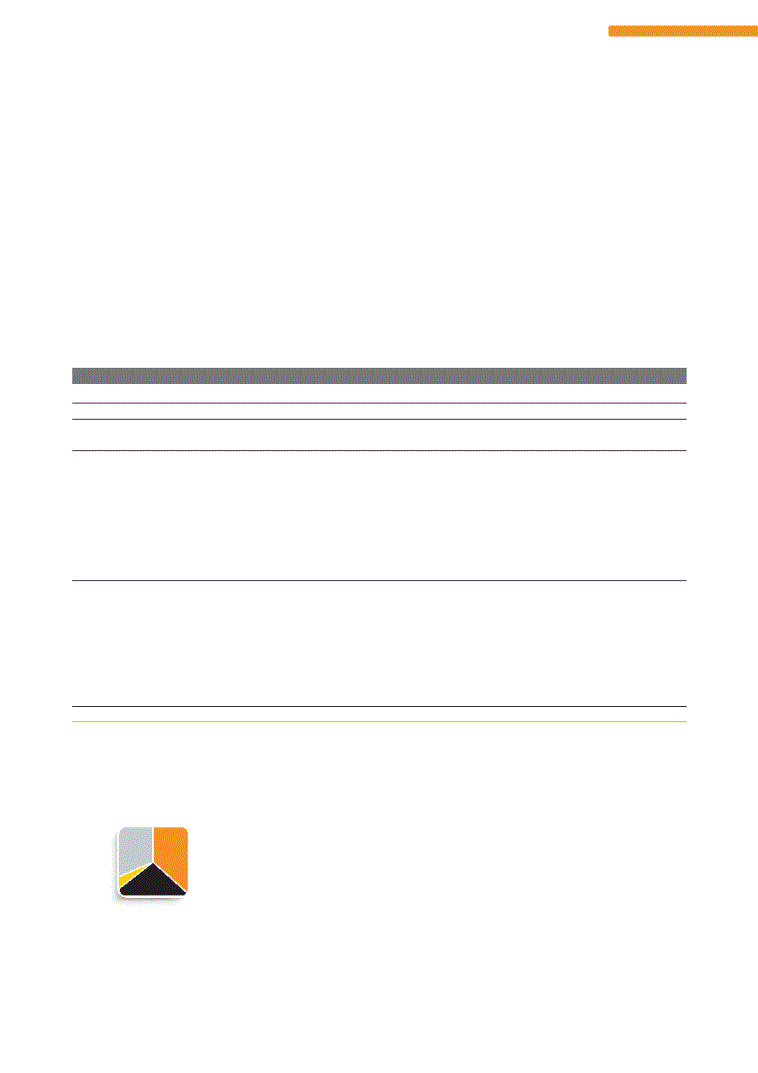
MINERAL RESOURCE
The total Mineral Resource decreased from 233.0Moz in December 2013 to 232.0Moz in
December 2014. A gross annual increase of 8.7Moz occurred before depletion and disposals,
while the net decrease after allowing for depletion and disposals was 1.0Moz. Changes in
economic assumptions from December 2013 to December 2014 resulted in a 6.4Moz decrease
in the Mineral Resource, while exploration and modelling resulted in an increase of 14.4Moz.
Depletion from the Mineral Resource for the year totalled 5.9Moz and the reduction from the
sale of Navachab, 3.8Moz. The Mineral Resource was estimated at a gold price of US$1,600/oz
(2013: US$1,600/oz).
Mineral Resource
Moz
As at 31 December 2013
233.0
Disposal – Navachab
(3.8)
Sub-total
229.2
Depletion
(5.9)
Sub-total
223.3
Additions
Quebradona
Nuevo Chaquiro Maiden Mineral Resource declaration
5.5
La Colosa
Mineral Resource growth due to exploration success
5.1
AGA Mineração
Exploration success at all three operations
2.1
Sunrise Dam
Revisions to the modelling approach
1.6
Siguiri
Hard rock exploration additions from three deposits
1.5
Other
Additions less than 0.5Moz
1.5
Sub-total
240.6
Reductions
Mponeng
Data driven revision to models and Mineral Resource clean up
(3.4)
Kopanang
Mineral Resource clean-up of uneconomic and inaccessible areas
(1.8)
Moab Khotsong
(including Great Noligwa)
Exploration-driven revisions to models
(1.4)
Geita
Increased costs resulting in reduced pit size
(0.9)
Other
Reductions less than 0.5Moz
(1.1)
As at 31 December 2014
Total
232.0
Rounding of numbers may result in computational discrepancies.
PERFORMANCE REVIEW
Attributable Mineral Resource
by region
by region
(Moz)
•
South Africa
85.6
• Continental Africa
64.3
•
Australasia
9.6
•
Americas
72.5
Group Mineral
Resource:
Resource:
232.0Moz
95
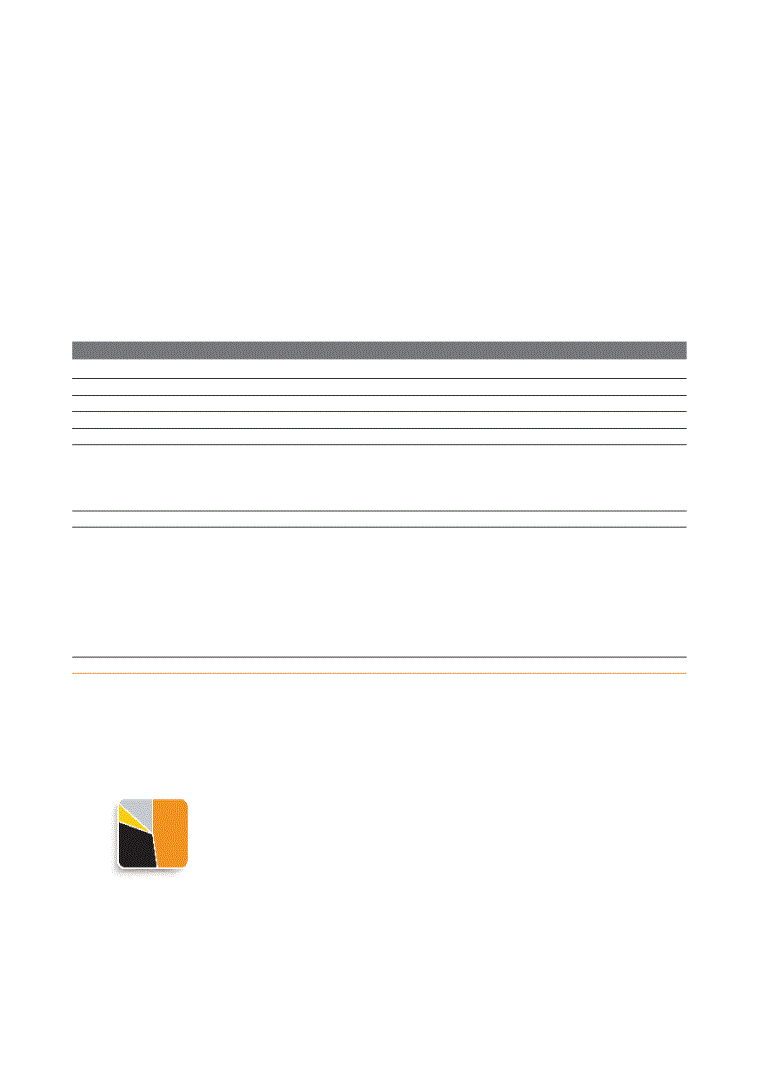
MINERAL RESOURCE AND ORE RESERVE OVERVIEW continued
ORE RESERVE
The AngloGold Ashanti Ore Reserve reduced from 67.9Moz in December 2013 to 57.5Moz in
December 2014. This gross annual decrease of 10.5Moz includes depletion of 4.9Moz and the
sale of Navachab of 1.9Moz. The remaining reduction of 3.7Moz in the Ore Reserve resulted
from changes to the economic assumptions between 2013 and 2014 which resulted in a
reduction of 3.0Moz to the Ore Reserve, while exploration and modelling changes led to a further
decrease of 0.7Moz. The Ore Reserve has been estimated using a gold price of US$1,100/oz
(2013: US$1,100/oz).
Ore Reserve
Moz
As at 31 December 2013
67.9
Disposal – Navachab
(1.9)
Sub-total
66.1
Depletion
(4.9)
Sub-total
61.1
Additions
Siguiri
Inclusion of fresh rock from the Kami deposit
0.6
Sunrise Dam
Exploration success at Vogue
0.4
Other
Additions less than 0.3Moz
1.0
Sub-total
63.1
Reductions
Obuasi
Initial results of feasibility study
(2.6)
Mponeng
Revisions to the CLR and VCR models due to new exploration and
development data
(1.3)
Moab Khotsong
(including Great Noligwa)
New surface exploration data led to revision of the project Zaaiplaats models
(0.8)
CC&V
Increased costs and reduction in sub marginal ounces
(0.4)
Other
Reductions less than 0.3Moz
(0.5)
As at 31 December 2014
Total
57.5
Rounding of numbers may result in computational discrepancies.
Attributable Ore Reserve –
by region
by region
(Moz)
•
South Africa
27.5
• Continental Africa
18.9
•
Australasia
3.5
•
Americas
7.6
Group Ore
Reserve:
Reserve:
57.5Moz
INTEGRATED REPORT
2014
96

BY-PRODUCTS
Several by-products are recovered in the processing of the gold Ore Reserve. The AngloGold
Ashanti Ore Reserve includes 55,600t of uranium oxide at the South African operations,
0.32Mt of sulphur in Brazil and 25.1Moz of silver in Argentina.
The maiden publication of the Nuevo Chaquiro Mineral Resource added 3.55Mt of copper,
76.5Moz of silver and 62,908t of molybdenum to the group’s total Mineral Resource.
COMPETENT PERSONS
The information in this report relating to exploration results, Mineral Resources and Ore
Reserves is based on information compiled by or under the supervision of the Competent
Persons as defined in the JORC or SAMREC Codes. All Competent Persons are employed by
AngloGold Ashanti, unless stated otherwise, and have sufficient experience relevant to the style
of mineralisation and type of deposit under consideration and to the activity being undertaking.
The Competent Persons consent to the inclusion of exploration results, Mineral Resource and
Ore Reserve information in this report, in the form and context in which it appears. The legal
tenure of each operation and project has been verified to the satisfaction of the accountable
Competent Person.
During the past decade, the company has developed and implemented a rigorous system
of internal and external reviews aimed at providing assurance in respect of Ore Reserve and
Mineral Resource estimates. The Mineral Resource and Ore Reserve at the following operations
were subject to an external review, in line with the policy that each operation or project will be
reviewed by an independent third party on average once every three years:
•
Mponeng
•
Moab Khotsong
•
Iduapriem
•
Sunrise Dam
•
Cerro Vanguardia
•
Serra Grande
•
Obuasi
The external reviews were conducted by the following companies: The Mineral Corporation
(Mponeng and Moab Khotsong), Coffey Mining (Iduapriem), Snowden (Sunrise Dam), Optiro
(Cerro Vanguardia and Serra Grande), AMEC (Obuasi – Mineral Resource) and SRK (Obuasi
– Mineral Resource and Ore Reserve). Certificates of sign-off have been received from all
companies conducting the external reviews to state that the Mineral Resource and/or Ore
Reserve at each operation complies with the JORC Code and the SAMREC Code.
Numerous internal Mineral Resource and Ore Reserve process reviews were completed by
suitably qualified Competent Persons from within AngloGold Ashanti. A documented chain of
responsibility exists from the Competent Persons at the operation to the company’s Mineral
Resource and Ore Reserve Steering Committee. Accordingly, the Chairman of the AngloGold
Ashanti Mineral Resource and Ore Reserve Steering Committee, VA Chamberlain, MSc
(Mining Engineering), BSc (Hons) (Geology), MGSSA, FAusIMM, assumes responsibility for the
Mineral Resource and Ore Reserve processes for AngloGold Ashanti and is satisfied that the
Competent Persons have fulfilled their responsibilities.
A detailed breakdown of Mineral Resource and Ore Reserve and backup detail is provided on
the AngloGold Ashanti website, www.anglogoldashanti.com and www.aga-reports.com.
PERFORMANCE REVIEW
“
AngloGold Ashanti
has developed and
implemented a rigorous
system of internal and
external reviews to
provide assurance of
its Mineral Resource
and Ore Reserve
estimates.
implemented a rigorous
system of internal and
external reviews to
provide assurance of
its Mineral Resource
and Ore Reserve
estimates.
”
97

Mineral Resource by region inclusive of Ore Reserve (attributable)
Tonnes
Grade
Contained gold
As at 31 December 2014
Category
million
g/t
Tonnes
Moz
South Africa
Measured
147.19
2.35
345.91
11.12
Indicated
946.99
1.93
1,829.48
58.82
Inferred
47.34
10.31
487.87
15.69
Total
1,141.52
2.33
2,663.26
85.63
Continental Africa
Measured
79.94
3.07
245.06
7.88
Indicated
419.68
2.59
1,086.73
34.94
Inferred
277.85
2.40
667.86
21.47
Total
777.47
2.57
1,999.66
64.29
Australasia
Measured
31.77
1.43
45.46
1.46
Indicated
83.83
2.25
188.70
6.07
Inferred
23.35
2.73
63.84
2.05
Total
138.95
2.14
298.00
9.58
Americas
Measured
284.50
1.15
326.31
10.49
Indicated
1,195.53
0.94
1,128.97
36.30
Inferred
1,076.04
0.74
799.23
25.70
Total
2,556.07
0.88
2,254.52
72.48
AngloGold Ashanti total
Measured
543.41
1.77
962.74
30.95
Indicated
2,646.03
1.60
4,233.89
136.12
Inferred
1,424.57
1.42
2,018.80
64.91
Total
4,614.01
1.56
7,215.43
231.98
Rounding of figures may result in computational discrepancies.
MINERAL RESOURCE AND ORE RESERVE OVERVIEW continued
INTEGRATED REPORT
2014
98
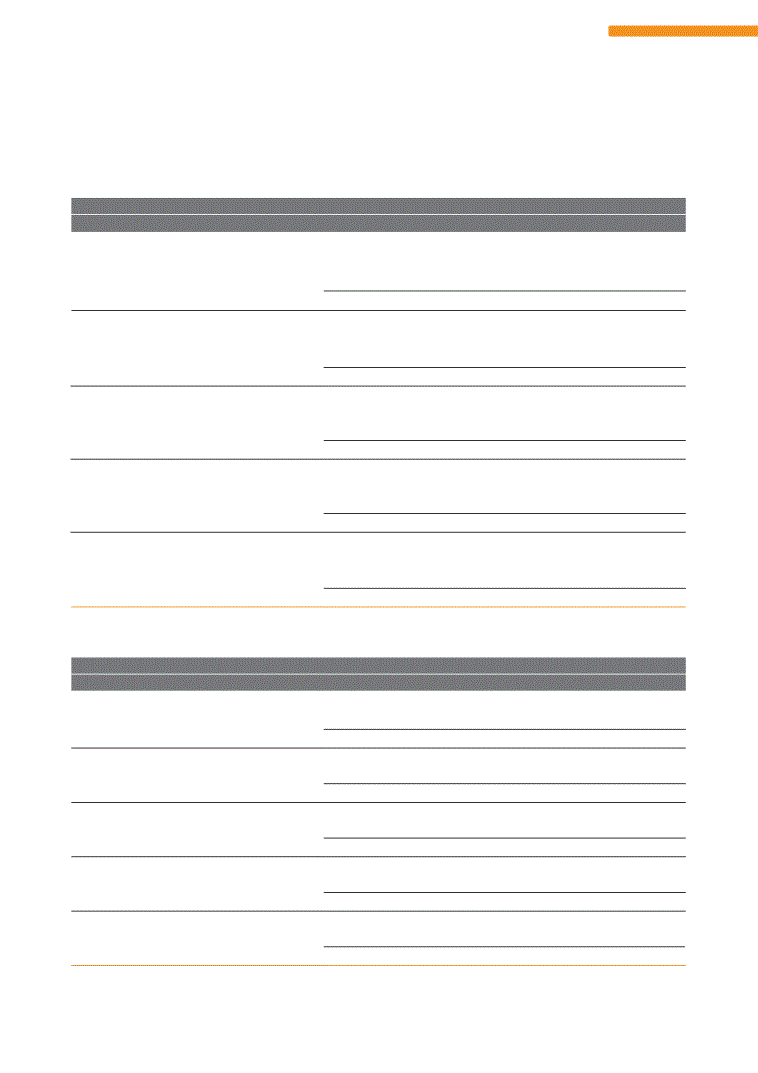
PERFORMANCE REVIEW
Mineral Resource by region exclusive of Ore Reserve (attributable)
Tonnes
Grade
Contained gold
As at 31 December 2014
Category
million
g/t
Tonnes
Moz
South Africa
Measured
15.75
15.17
239.06
7.69
Indicated
251.24
3.49
877.25
28.20
Inferred
13.43
18.32
246.09
7.91
Total
280.43
4.86
1,362.39
43.80
Continental Africa
Measured
36.80
4.89
179.78
5.78
Indicated
215.36
2.58
556.29
17.89
Inferred
276.82
2.39
661.34
21.26
Total
528.97
2.64
1,397.41
44.93
Australasia
Measured
3.50
0.83
2.89
0.09
Indicated
55.33
2.18
120.88
3.89
Inferred
23.35
2.73
63.84
2.05
Total
82.18
2.28
187.62
6.03
Americas
Measured
157.88
1.15
181.18
5.83
Indicated
1,126.20
0.90
1,017.56
32.72
Inferred
1,064.18
0.74
784.22
25.21
Total
2,348.27
0.84
1,982.97
63.75
AngloGold Ashanti total
Measured
213.94
2.82
602.91
19.38
Indicated
1,648.14
1.56
2,571.98
82.69
Inferred
1,377.77
1.27
1,755.49
56.44
Total
3,239.84
1.52
4,930.39
158.52
Ore Reserve by region (attributable)
Tonnes
Grade
Contained gold
As at 31 December 2014
Category
million
g/t
Tonnes
Moz
South Africa
Proved
133.45
0.64
85.20
2.74
Probable
713.99
1.08
768.72
24.71
Total
847.45
1.01
853.92
27.45
Continental Africa
Proved
44.95
1.52
68.12
2.19
Probable
203.84
2.55
520.67
16.74
Total
248.78
2.37
588.79
18.93
Australasia
Proved
28.27
1.51
42.57
1.37
Probable
28.19
2.38
67.09
2.16
Total
56.46
1.94
109.66
3.53
Americas
Proved
124.64
1.01
126.14
4.06
Probable
72.87
1.50
109.03
3.51
Total
197.51
1.19
235.17
7.56
AngloGold Ashanti total
Proved
331.30
0.97
322.03
10.35
Probable
1,018.90
1.44
1,465.51
47.12
Total
1,350.20
1.32
1,787.54
57.47
Rounding of figures may result in computational discrepancies.
99
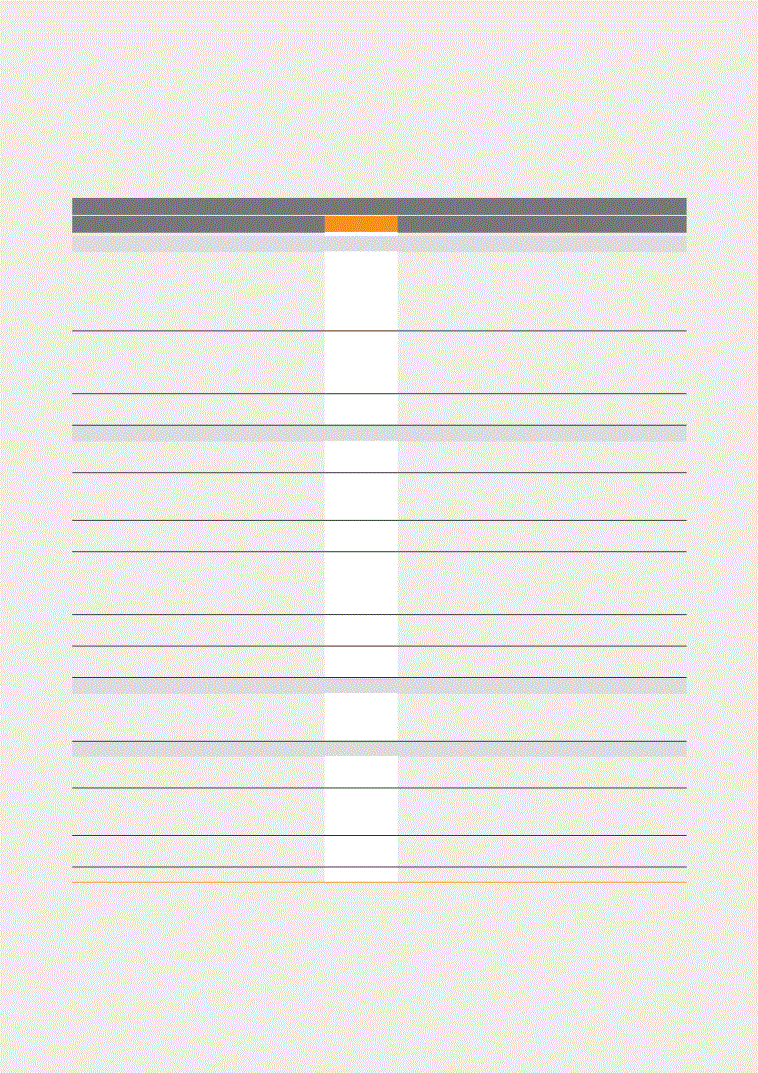
FIVE-YEAR STATISTICS: BY OPERATION
Operational, financial and sustainability statistics
Production volumes
Attributable tonnes treated/milled (Mt)
2014
2013
2012
2011
2010
South Africa
38.4
39.2
22.2
16.4
17.1
Vaal River
Great Noligwa
(1)
0.4
0.4
0.5
0.5
0.7
Kopanang
0.8
1.0
0.9
1.5
1.6
Moab Khotsong
0.7
0.7
0.6
0.9
1.0
Tau Lekoa
(2)
0.6
West Wits
Mponeng
1.1
1.6
1.3
1.6
1.8
Savuka
(3)
0.2
0.2
0.1
TauTona
(3)
0.9
1.0
0.8
1.0
1.1
Surface Operations
Surface Operations
(4)
34.5
34.5
17.9
10.7
10.2
Continental Africa
29.9
26.9
27.8
26.3
25.7
DRC
Kibali (45%)
(5)
2.5
0.4
Ghana
Iduapriem
4.9
4.8
4.6
4.3
3.4
Obuasi
2.2
1.7
2.1
2.0
2.6
Guinea
Siguiri (85%)
10.1
10.2
10.1
9.7
8.8
Mali
Morila (40%)
1.3
1.4
1.8
1.8
1.7
Sadiola (41%)
2.1
2.0
1.9
2.0
1.8
Yatela (40%)
0.9
1.0
1.1
1.1
1.2
Namibia
Navachab
(6)
0.7
1.4
1.4
1.5
1.5
Tanzania
Geita
5.2
4.0
4.8
3.9
4.7
Australasia
7.8
4.3
3.4
3.6
3.6
Australia
Sunrise Dam
3.8
3.5
3.4
3.6
3.6
Tropicana (70%)
(5)
4.0
0.9
Americas
26.1
26.7
25.7
23.6
23.8
Argentina
Cerro Vanguardia (92.5%)
3.0
2.3
1.7
1.0
1.0
Brazil
AGA Mineração
2.5
2.3
2.2
1.7
1.6
Serra Grande
(7)
1.3
1.3
0.9
0.6
0.6
United States
Cripple Creek & Victor
19.3
20.8
20.9
20.3
20.6
AngloGold Ashanti
102.2
97.1
79.1
69.9
70.2
(1)
The process of integrating Great Noligwa into Moab Khotsong began in 2014 and these operations will be treated as one cash-generating unit from
1 January 2015.
1 January 2015.
(2)
Sold in August 2010.
(3)
In 2013, Savuka and TauTona were combined under TauTona as one cash generating unit.
(4)
For the purposes of this report, Surface Operations includes MWS, which is operated and managed as a separate cash generating unit.
(5)
Kibali and Tropicana began production in the fourth quarter of 2013.
(6)
Sold effective 30 June 2014.
(7)
AngloGold Ashanti’s holding increased to 100% (from 50%) from 1 July 2012.
INTEGRATED REPORT
2014
100
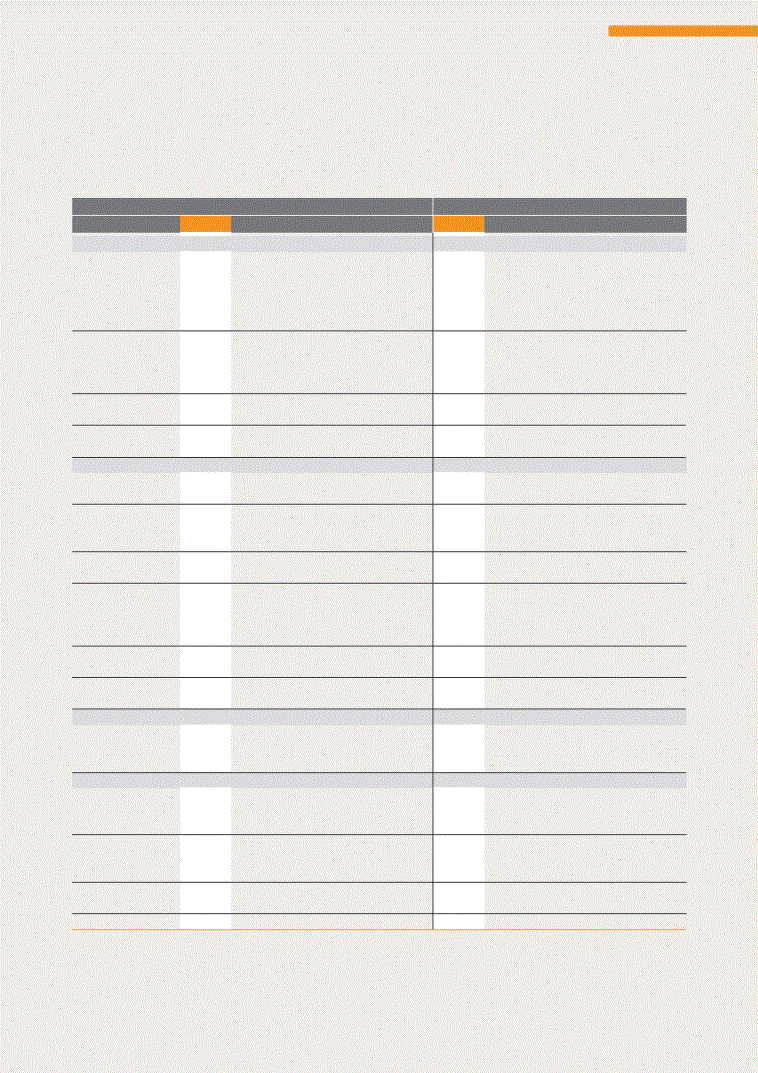
Production volumes (continued)
Average grade recovered (g/t)
Attributable gold production (000oz)
2014
2013
2012
2011
2010
2014
2013
2012
2011
2010
South Africa
1,223
1,302
1,212
1,624
1,785
Vaal River
Great Noligwa
(1)
6.44
6.15
5.72
5.58
5.99
78
83
84
94
132
Kopanang
5.55
5.23
5.40
6.47
6.13
140
178
164
307
305
Moab Khotsong
11.04
9.47
8.16
9.39
9.03
234
212
162
266
292
Tau Lekoa
(2)
3.32
63
West Wits
Mponeng
8.99
7.10
9.40
9.71
9.48
313
354
405
500
532
Savuka
(3)
6.09
6.69
5.30
37
49
22
TauTona
(3)
8.21
7.34
7.63
7.55
7.01
232
235
189
244
259
Surface Operations
Surface Operations
(4)
0.20
0.22
0.30
0.48
0.54
223
240
172
164
179
Technology
Technology
3
Continental Africa
1,597
1,460
1,521
1,570
1,492
DRC
Kibali (45%)
(5)
2.95
3.41
237
40
Ghana
Iduapriem
1.13
1.43
1.22
1.44
1.70
177
221
180
199
185
Obuasi
(6)
4.67
4.94
4.79
4.82
5.16
243
239
280
313
317
Guinea
Siguiri (85%)
0.89
0.82
0.76
0.79
0.97
290
268
247
249
273
Mali
Morila (40%)
1.06
1.23
1.41
1.70
1.70
44
57
81
99
95
Sadiola (41%)
1.28
1.34
1.64
1.90
2.04
85
86
100
121
118
Yatela (40%)
0.59
0.93
1.06
1.04
1.23
11
27
29
29
60
Namibia
Navachab
(7)
1.44
1.39
1.59
1.46
1.80
33
63
74
66
86
Tanzania
Geita
2.86
3.54
3.47
3.98
2.36
477
459
531
494
357
Australasia
620
342
258
246
396
Australia
Sunrise Dam
2.13
2.46
2.39
2.16
3.40
262
276
258
246
396
Tropicana (70%)
(5)
2.78
2.40
358
66
Americas
996
1,001
953
891
842
Argentina
Cerro Vanguardia
(92.5%)
6.08
6.58
6.48
6.23
6.11
246
241
219
196
194
Brazil
AGA Mineração
(6)
5.65
5.70
6.07
7.43
7.21
403
391
388
361
338
Serra Grande
(8)
3.28
3.42
3.36
3.59
4.05
136
138
98
67
77
United States
Cripple Creek & Victor
0.32
0.34
0.40
0.39
0.43
211
231
247
267
233
AngloGold Ashanti
4,436
4,105
3,944
4,331
4,515
(1)
The process of integrating Great Noligwa into Moab Khotsong began in 2014 and these operations will be treated as one cash-generating unit
from 1 January 2015.
from 1 January 2015.
(2)
Sold in August 2010.
(3)
In 2013, Savuka and TauTona were combined under TauTona as one cash generating unit.
(4)
For the purposes of this report, Surface Operations includes MWS, which is operated and managed as a separate cash generating unit.
(5)
Kibali and Tropicana began production in the fourth quarter of 2013.
(6)
The grades from Obuasi and AGA Mineração represent those for their underground operations.
(7)
Sold effective 30 June 2014.
(8)
AngloGold Ashanti’s holding increased to 100% (from 50%) from 1 July 2012.
PERFORMANCE REVIEW
101
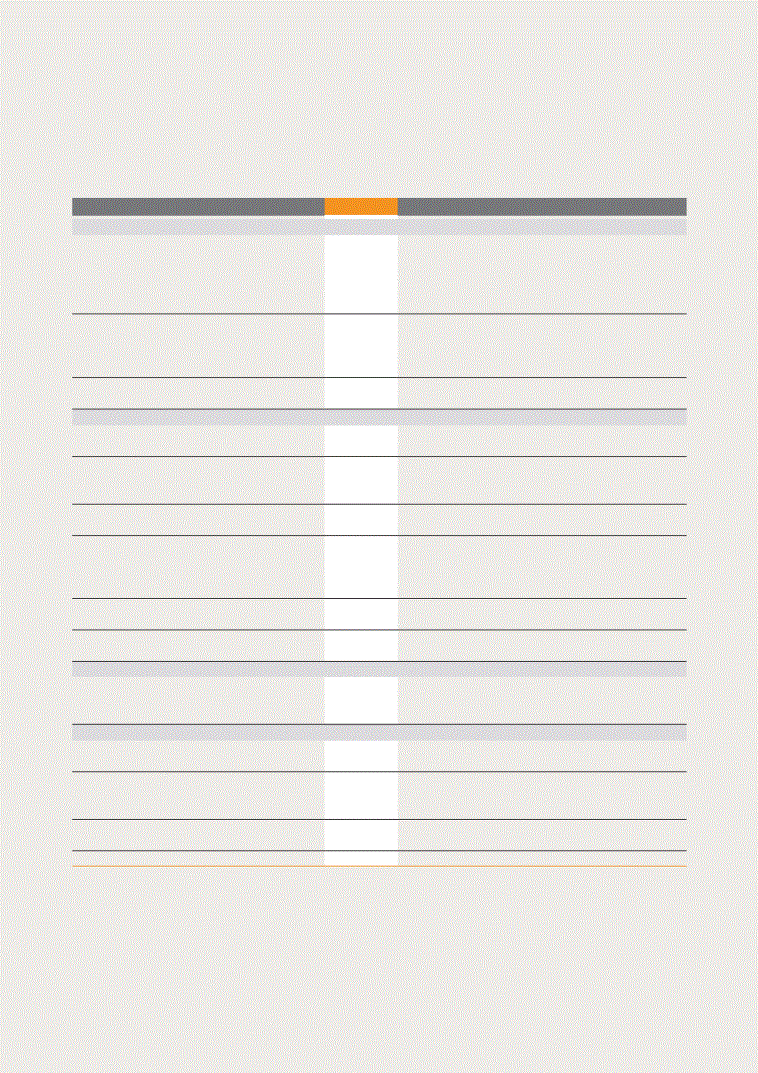
FIVE-YEAR STATISTICS: BY OPERATION continued
Operational, financial and sustainability statistics
Productivity (oz/TEC)
2014
2013
2012
2011
2010
South Africa
4.40
4.47
4.19
5.85
5.63
Vaal River
Great Noligwa
(1)
2.69
2.51
2.34
2.72
3.35
Kopanang
2.68
3.11
2.61
4.79
4.67
Moab Khotsong
4.74
4.22
3.05
5.03
5.61
Tau Lekoa
(2)
1.92
West Wits
Mponeng
4.74
5.33
6.33
8.38
8.72
Savuka
(3)
3.98
4.83
1.68
TauTona
(3)
4.17
4.01
4.03
5.13
5.34
Surface Operations
Surface Operations
(4)
8.95
9.35
9.86
21.32
39.80
Continental Africa
14.36
9.97
10.97
11.41
11.24
DRC
Kibali (45%)
(5)
68.50
83.56
Ghana
Iduapriem
20.14
18.41
15.61
16.97
16.44
Obuasi
6.10
4.10
5.19
5.68
5.61
Guinea
Siguiri (85%)
15.64
12.88
12.10
12.03
14.75
Mali
Morila (40%)
10.13
17.88
35.72
42.00
36.04
Sadiola (41%)
14.23
10.56
12.27
15.53
15.82
Yatela (40%)
10.73
10.21
8.82
8.89
20.39
Namibia
Navachab
(6)
6.97
5.63
6.43
7.00
10.46
Tanzania
Geita
19.50
15.55
19.20
18.11
14.14
Australasia
62.00
49.64
43.46
40.29
66.77
Australia
Sunrise Dam
58.29
50.22
43.46
40.29
66.77
Tropicana (70%)
(5)
65.03
47.37
Americas
16.35
16.63
17.47
20.70
22.44
Argentina
Cerro Vanguardia (92.5%)
21.14
20.89
18.21
17.64
20.64
Brazil
AGA Mineração
13.03
12.97
14.22
17.41
18.32
Serra Grande
(7)
11.32
11.19
11.45
12.98
15.88
United States
Cripple Creek & Victor
33.33
37.45
37.46
44.31
42.40
AngloGold Ashanti
9.64
8.14
8.07
9.32
9.15
(1)
The process of integrating Great Noligwa into Moab Khotsong began in 2014 and these operations will be treated as one cash-generating unit from
1 January 2015.
1 January 2015.
(2)
Sold in August 2010.
(3)
In 2013, Savuka and TauTona were combined under TauTona as one cash generating unit.
(4)
For the purposes of this report, Surface Operations includes MWS, which is operated and managed as a separate cash generating unit.
(5)
Kibali and Tropicana began production in the fourth quarter of 2013.
(6)
Sold effective 30 June 2014.
(7)
AngloGold Ashanti’s holding increased to 100% (from 50%) from 1 July 2012.
INTEGRATED REPORT
2014
102
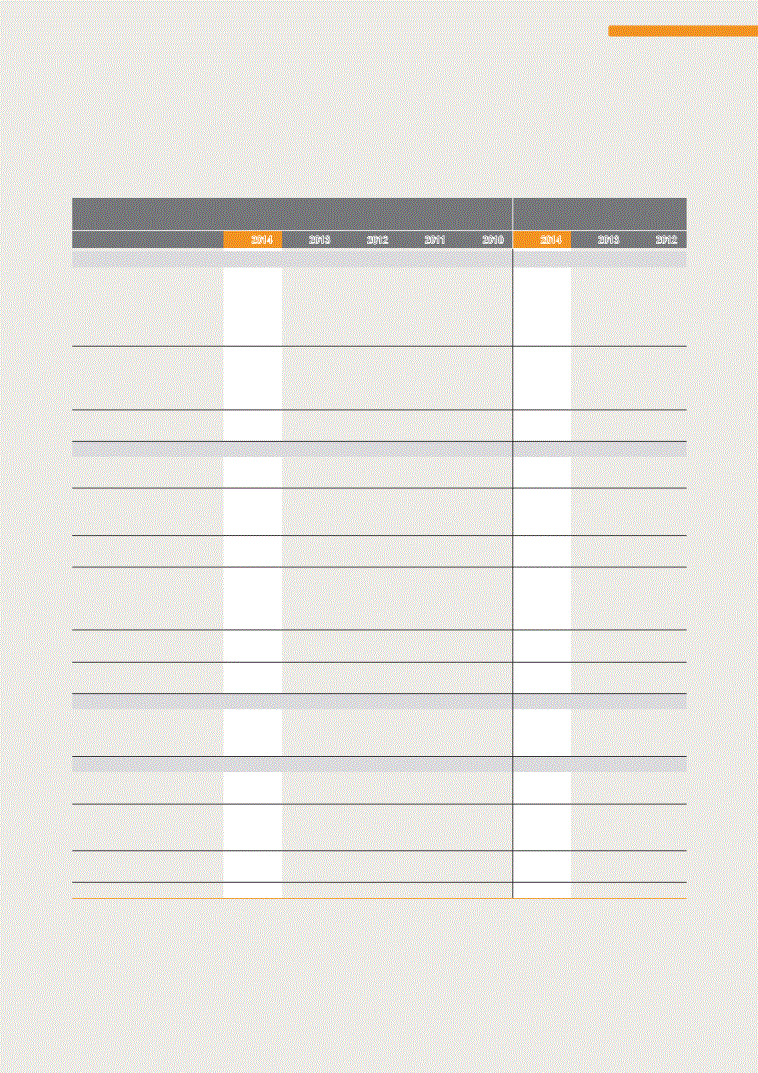
PERFORMANCE REVIEW
Costs
Total cash costs
($/oz produced)
All-in sustaining costs
(2)
($/oz sold)
2014
2013
2012
2011
2010
2014
2013
2012
South Africa
849
850
873
694
598
1,064
1,120
1,189
Vaal River
Great Noligwa
(1)
1,074
1,100
1,226
1,194
884
1,185
1,305
1,530
Kopanang
1,023
918
1,015
681
613
1,256
1,255
1,497
Moab Khotsong
685
797
1,040
689
588
903
1,223
1,634
Tau Lekoa
(3)
921
West Wits
Mponeng
746
719
639
546
453
981
1,016
883
Savuka
(4)
1,041
864
1,100
1,607
TauTona
(4)
882
920
924
818
700
1,059
1,149
1,316
Surface Operations
Surface Operations
(5)
941
883
943
660
485
1,153
969
754
Continental Africa
783
869
830
698
712
968
1,202
1,235
DRC
Kibali (45%)
(6)
578
471
588
529
Ghana
Iduapriem
865
861
955
800
666
1,020
1,025
1,437
Obuasi
1,086
1,406
1,187
862
744
1,374
2,214
2,201
Guinea
Siguiri (85%)
799
918
938
849
643
917
1,085
1,105
Mali
Morila (40%)
1,162
773
767
810
715
1,298
1,051
765
Sadiola (41%)
1,028
1,334
1,169
816
650
1,133
1,510
1,249
Yatela (40%)
1,438
1,530
1,758
1,530
807
1,795
1,653
1,888
Namibia
Navachab
(7)
752
691
1,036
1,012
727
719
781
1,329
Tanzania
Geita
599
515
427
350
777
890
833
816
Australasia
804
1,047
1,211
1,431
982
986
1,376
1,680
Australia
Sunrise Dam
1,105
1,110
1,126
1,367
957
1,214
1,321
1,470
Tropicana (70%)
(6)
545
568
752
1,113
Americas
709
671
669
569
432
1,010
970
1,006
Argentina
Cerro Vanguardia (92.5%)
692
622
576
368
366
938
912
935
Brazil
AGA Mineração
644
646
696
529
407
966
1,023
1,114
Serra Grande
748
719
821
768
481
1,062
970
1,168
United States
Cripple Creek & Victor
829
732
638
564
493
1,147
927
817
AngloGold Ashanti
787
830
829
703
638
1,026
1,174
1,251
(1)
The process of integrating Great Noligwa into Moab Khotsong began in 2014 and these operations will be treated as one cash-generating unit from 1 January 2015.
(2)
All-in sustaining costs are available from 2012 only.
(3)
Sold in August 2010.
(4)
In 2013, Savuka and TauTona were combined under TauTona as one cash generating unit.
(5)
For the purposes of this report, Surface Operations includes MWS, which is operated and managed as a separate cash generating unit.
(6)
Kibali and Tropicana began production in the fourth quarter of 2013.
(7)
Sold effective 30 June 2014.
103
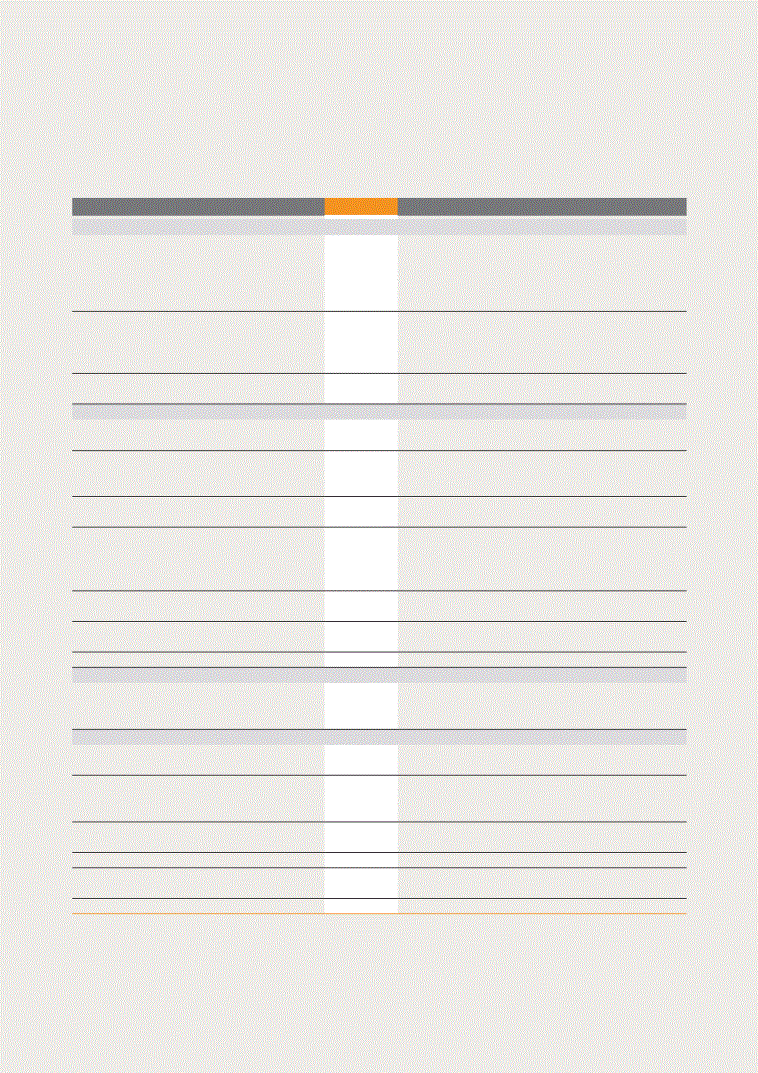
FIVE-YEAR STATISTICS: BY OPERATION continued
Operational, financial and sustainability statistics
Financial performance
Gold income ($m)
2014
2013
2012
2011
2010
South Africa
1,527
1,810
2,013
2,560
2,207
Vaal River
Great Noligwa
(1)
99
118
139
148
163
Kopanang
179
252
273
483
376
Moab Khotsong
296
294
270
418
360
Tau Lekoa
(2)
72
West Wits
Mponeng
398
501
674
790
663
Savuka
(3)
61
78
28
TauTona
(3)
294
331
315
387
322
Surface Operations
Surface Operations
(4)
261
314
281
256
223
Continental Africa
2,105
2,111
2,609
2,530
1,868
DRC
Kibali (45%)
(5)
293
49
Ghana
Iduapriem
234
301
304
308
218
Obuasi
313
341
468
493
348
Guinea
Siguiri (85%)
373
385
388
407
313
Mali
Morila (40%)
55
80
135
157
117
Sadiola (41%)
107
121
169
189
143
Yatela (40%)
14
40
48
46
71
Namibia
Navachab
(6)
44
88
123
104
101
Tanzania
Geita
605
640
906
753
501
Non-controlling interests
67
66
68
73
56
Australasia
785
441
426
385
466
Australia
Sunrise Dam
343
368
426
385
466
Tropicana (70%)
(5)
442
73
Americas
1,270
1,425
1,656
1,487
1,124
Argentina
Cerro Vanguardia (92.5%)
297
316
366
275
214
Brazil
AGA Mineração
510
559
635
565
405
Serra Grande
(7)
174
199
162
101
97
United States
Cripple Creek & Victor
266
325
409
423
293
Non-controlling interests
23
26
84
123
115
Sub-total
5,687
5,787
6,704
6,962
5,665
Equity-accounted investments
(469)
(290)
(351)
(392)
(331)
AngloGold Ashanti
5,218
5,497
6,353
6,570
5,334
(1)
The process of integrating Great Noligwa into Moab Khotsong began in 2014 and these operations will be treated as one cash-generating unit from
1 January 2015.
1 January 2015.
(2)
Sold in August 2010.
(3)
In 2013, Savuka and TauTona were combined under TauTona as one cash generating unit.
(4)
For the purposes of this report, Surface Operations includes MWS, which is operated and managed as a separate cash generating unit.
(5)
Kibali and Tropicana began production in the fourth quarter of 2013.
(6)
Sold effective 30 June 2014.
(7)
AngloGold Ashanti’s holding increased to 100% (from 50%) from 1 July 2012.
INTEGRATED REPORT
2014
104
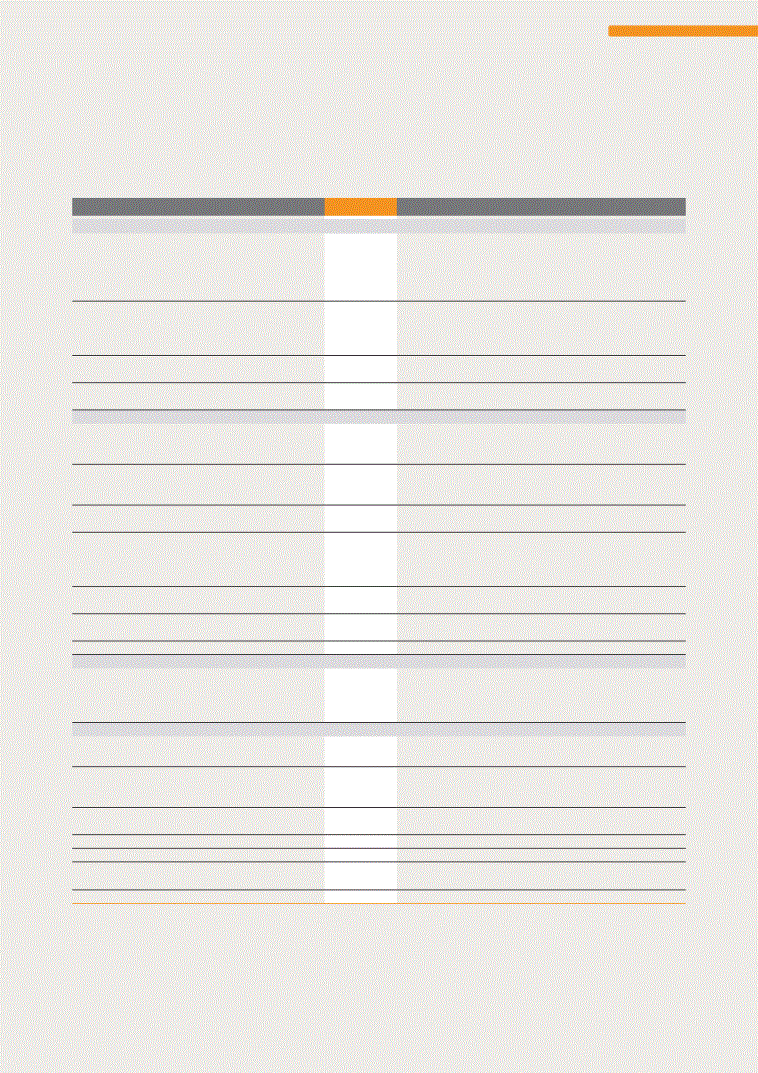
PERFORMANCE REVIEW
Capital expenditure ($m)
2014
2013
(1)
2012
(1)
2011
2010
South Africa
264
451
583
532
424
Vaal River
Great Noligwa
(1)
7
13
27
29
24
Kopanang
26
52
94
92
61
Moab Khotsong
45
117
159
147
120
Tau Lekoa
(2)
10
West Wits
Mponeng
97
171
195
172
122
Savuka
(3)
20
8
9
TauTona
(3)
35
59
73
79
75
Surface Operations
Surface Operations
(4)
46
39
15
5
3
Technology
Technology
8
Continental Africa
454
839
925
569
234
DRC
Kibali (45%)
(5)
179
341
263
73
30
Mongbwalu (86.22%)
77
1
Ghana
Iduapriem
21
28
95
73
17
Obuasi
82
196
185
132
109
Guinea
Siguiri (85%)
26
25
28
15
10
Mali
Morila (40%)
6
13
1
1
1
Sadiola (41%)
6
42
37
14
8
Yatela (40%)
–
3
2
1
2
Namibia
Navachab
(6)
1
5
15
48
14
Tanzania
Geita
129
154
216
206
38
Other and non-controlling interests
4
32
6
5
5
Australasia
91
285
369
102
40
Australia
Sunrise Dam
31
39
49
27
29
Tropicana (70%)
(5)
59
241
315
73
10
Other
1
5
5
2
1
Americas
394
410
409
466
311
Argentina
Cerro Vanguardia (92.5%)
54
64
88
81
38
Brazil
AGA Mineração
127
123
162
261
142
Serra Grande
(7)
38
40
33
22
26
United States
Cripple Creek & Victor
169
157
100
67
73
Other and non-controlling interests
6
26
26
35
32
Other
6
8
36
17
6
Sub-total
1,209
1,993
2,322
1,686
1,015
Equity-accounted investments
(191)
(411)
(303)
(89)
(42)
AngloGold Ashanti
1,018
1,582
2,019
1,597
973
(1)
The process of integrating Great Noligwa into Moab Khotsong began in 2014 and these operations will be treated as one cash-generating unit from 1 January 2015.
(2)
Sold in August 2010.
(3)
In 2013, Savuka and TauTona were combined under TauTona as one cash generating unit.
(4)
For the purposes of this report, Surface Operations includes MWS, which is operated and managed as a separate cash generating unit.
(5)
Kibali and Tropicana began production in the fourth quarter of 2013.
(6)
Sold effective 30 June 2014.
(7)
AngloGold Ashanti’s holding increased to 100% (from 50%) from 1 July 2012.
105
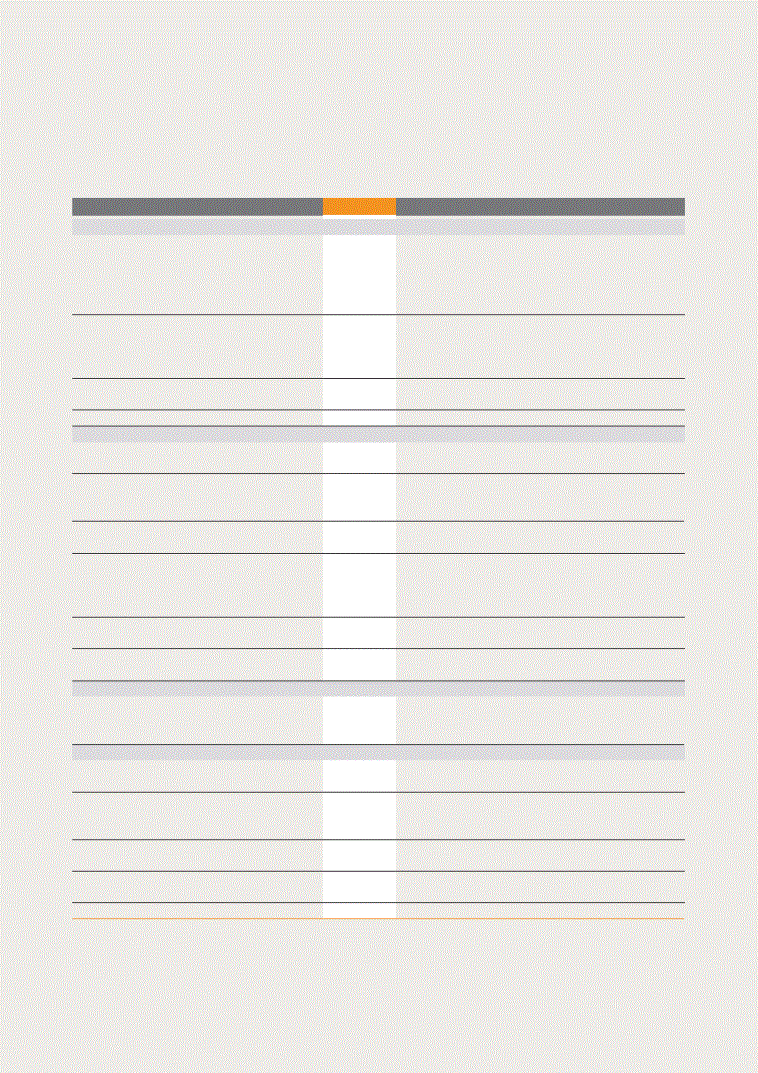
FIVE-YEAR STATISTICS: BY OPERATION
continued
Operational, financial and sustainability statistics
Average no. of employees (permanent and contractor employees)
2014
2013
2012
2011
2010
South Africa
29,511
32,406
34,186
32,082
35,660
Vaal River
Great Noligwa
(1)
2,207
2,731
3,063
2,967
3,315
Kopanang
4,424
5,365
6,014
5,892
5,938
Moab Khotsong
4,573
5,692
6,645
6,581
6,452
Tau Lekoa
(2)
2,737
West Wits
Mponeng
6,737
6,516
6,262
5,788
5,778
Savuka
(3)
1,157
815
981
TauTona
(3)
4,712
5,256
4,472
4,507
4,609
Surface Operations
Surface Operations
(4)
3,058
2,142
1,874
745
374
Other
3,800
4,704
4,699
4,787
5,476
Continental Africa
16,070
16,625
16,621
16,539
15,761
DRC
Kibali (45%)
(5)
2,245
158
Ghana
Iduapriem
1,352
1,590
1,549
1,543
1,483
Obuasi
3,541
5,194
5,373
5,538
5,722
Guinea
Siguiri
3,494
3,673
3,643
3,666
3,170
Mali
Morila (40%)
500
390
319
328
356
Sadiola (41%)
654
810
783
756
726
Yatela (40%)
226
367
407
377
352
Namibia
Navachab
(6)
793
938
953
790
687
Tanzania
Geita
3,265
3,504
3,594
3,541
3,265
Australasia
832
925
494
509
494
Australia
Sunrise Dam
374
457
494
509
494
Tropicana (70%)
(5)
458
468
Americas
8,588
8,374
7,896
7,389
6,582
Argentina
Cerro Vanguardia
1,640
1,696
1,884
1,644
1,242
Brazil
AGA Mineração
4,398
4,377
4,239
3,825
3,426
Serra Grande
1,403
1,469
1,081
1,339
1,268
United States
Cripple Creek & Victor
1,147
832
692
581
646
Other, including corporate and non-gold
producing subsidiaries
3,056
(7)
8,104
6,625
4,723
3,549
AngloGold Ashanti
58,057
66,434
65,822
61,242
62,046
(1)
The process of integrating Great Noligwa into Moab Khotsong began in 2014 and these operations will be treated as one cash-generating unit from 1 January 2015.
(2)
Sold in August 2010.
(3)
In 2013, Savuka and TauTona were combined under TauTona as one cash generating unit.
(4)
For the purposes of this report, Surface Operations includes MWS, which is operated and managed as a separate cash generating unit.
(5)
Kibali and Tropicana began production in the fourth quarter of 2013.
(6)
Sold effective 30 June 2014.
(7)
Includes 3,249 employees at Kibali who are working on projects.
INTEGRATED REPORT
2014
106
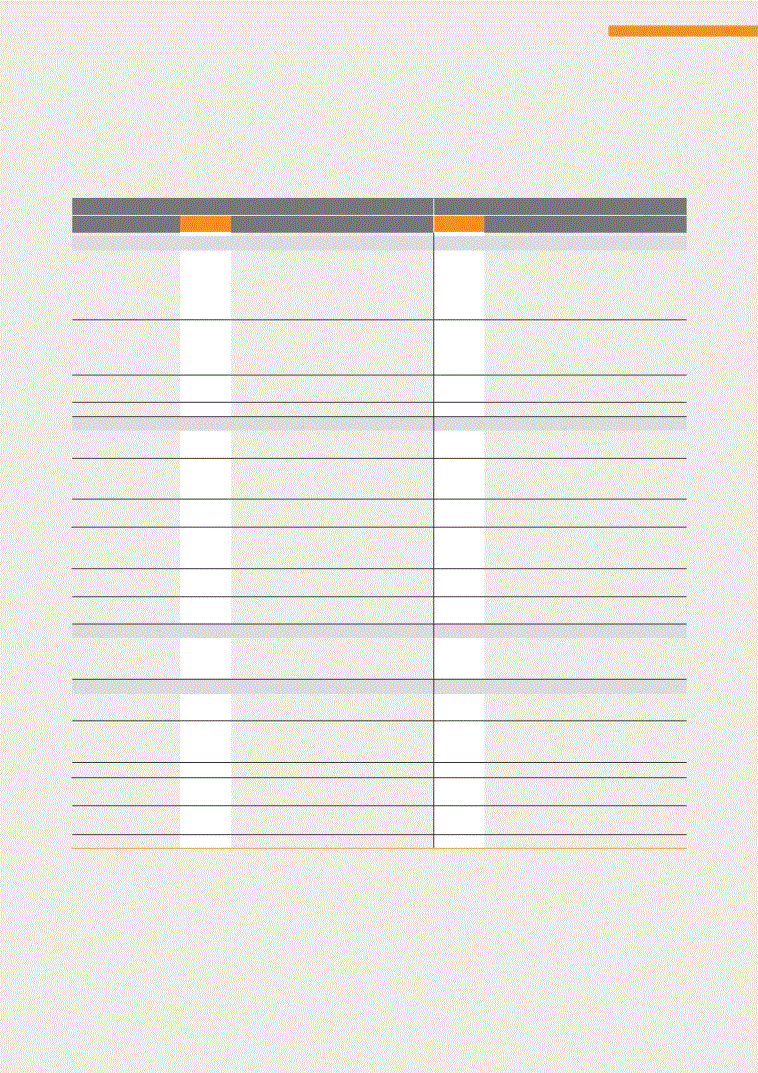
PERFORMANCE REVIEW
Safety
All injury frequency rate
(1)
Number of fatalities
2014
2013
2012
2011
2010
2014
2013
2012
2011
2010
South Africa
11.85
12.63
13.24
15.57
16.69
4
6
11
9
10
Vaal River
Great Noligwa
(2)
15.44
12.06
17.72
23.92
21.63
0
0
1
1
0
Kopanang
13.56
17.58
19.92
23.18
21.86
1
0
0
4
2
Moab Khotsong
18.62
16.35
17.14
20.48
19.72
0
1
2
1
2
Tau Lekoa
(3)
32.41
2
West Wits
Mponeng
16.33
17.86
14.49
15.39
15.93
3
3
3
2
2
Savuka
(4)
21.23
8.39
7.69
0
0
2
0
0
TauTona
(4)
12.60
14.16
10.63
13.36
19.03
0
1
3
0
2
Surface Operations
Surface Operations
(5)
5.42
5.08
6.71
6.44
5.99
0
0
0
0
0
Other
0
1
0
1
0
Continental Africa
1.56
1.97
2.26
3.03
5.26
0
2
5
3
5
DRC
Mongbwalu
1.98
6.15
4.47
11.04
21.77
0
0
1
0
1
Ghana
Iduapriem
1.06
1.98
3.08
6.61
9.73
0
1
1
0
0
Obuasi
3.01
2.39
2.13
2.37
2.86
0
1
2
3
0
Guinea
Siguiri
0.39
0.64
1.09
1.27
6.15
0
0
0
0
1
Mali
Sadiola
0.50
1.28
2.21
2.44
1.65
0
0
0
0
1
Yatela
0.00
0.00
0.36
1.52
2.28
0
0
0
0
0
Namibia
Navachab
(6)
6.39
5.58
8.22
2.00
25.60
0
0
0
0
0
Tanzania
Geita
0.51
0.98
1.62
3.60
5.38
0
0
1
0
2
Australasia
10.73
(7)
7.91
6.33
18.11
13.10
0
0
0
0
0
Australia
Sunrise Dam
12.54
(7)
11.19
5.46
19.40
13.65
0
0
0
0
0
Tropicana
(8)
9.96
8.60
15.75
0
0
0
Americas
3.81
(7)
4.74
(7)
5.20
6.33
5.66
2
0
1
2
0
Argentina
Cerro Vanguardia
1.40
0.58
1.72
1.59
8.08
0
0
1
0
0
Brazil
AGA Mineração
4.26
(7)
5.94
(7)
5.82
4.05
2.62
2
0
0
1
0
Serra Grande
4.53
(7)
6.10
(7)
5.15
3.48
7.22
0
0
0
0
0
Colombia
0.32
2.51
4.43
16.84
10.83
0
0
0
1
0
United States
Cripple Creek & Victor
9.54
(7)
9.89
12.75
19.80
12.26
0
0
0
0
0
Greenfield
exploration
3.57
4.20
6.76
19.83
16.99
0
0
1
1
0
AngloGold Ashanti
(9)
7.36
(7)
7.48
(7)
7.83
9.76
11.50
6
8
18
15
15
(1)
Per million hours worked.
(2)
The process of integrating Great Noligwa into Moab Khotsong began in 2014 and these operations will be treated as one cash-generating unit from 1 January 2015.
(3)
Sold in August 2010.
(4)
In 2013, Savuka and TauTona were combined under TauTona as one cash generating unit.
(5)
For the purposes of this report, Surface Operations includes MWS, which is operated and managed as a separate cash generating unit.
(6)
Sold effective 30 June 2014.
(7)
Restated owing to injury reclassification and/or progression of injury severity at Sunrise Dam, Cripple Creek & Victor and the Brazilian operations,
which impacted regional and group data.
which impacted regional and group data.
(8)
Tropicana began production in the fourth quarter of 2013.
(9)
All injury frequency rate for the group adjusted for the earthquake impact is 7.15.
107

FIVE-YEAR STATISTICS: BY OPERATION
continued
Operational, financial and sustainability statistics
Environmental performance
(1)
Energy usage (PJ)
Water usage (ML)
2014
2013
2012
2011
2010
2014
2013
2012
2011
2010
South Africa
11.31
11.80
11.65
11.68
12.37
27,219
27,228
23,813
18,821
20,896
Vaal River
(2)
5.31
5.63
5.87
6.09
6.76
13,402
14,331
14,748
13,572
15,587
West Wits
(2)
5.24
5.55
5.57
5.59
5.61
2,626
3,160
4,501
5,249
5,309
Mine Waste Solutions
0.76
0.62
0.21
11,191
9,737
4,564
Continental Africa
8.95
12.01
12.13
11.51
11.30
17,582
21,031
19,132
20,203
19,235
Ghana
Iduapriem
0.62
1.25
1.00
0.98
1.03
342
795
582
408
99
Obuasi
(3)
1.46
1.77
1.74
1.52
1.53
3,696
3,685
3,820
4,047
4,607
Guinea
Siguiri
1.97
2.31
2.34
2.43
2.37
5,375
6,478
4,650
6,097
5,265
Mali
Sadiola
(3)
1.45
2.10
2.17
2.00
1.84
4,051
4,330
3,837
3,602
4,340
Yatela
0.24
0.52
0.70
0.62
0.53
17
254
1,578
1,036
744
Namibia
Navachab
(4)
0.74
0.75
0.59
0.54
1,005
990
1,043
1,080
Tanzania
Geita
3.21
3.32
3.43
3.37
3.46
4,101
4,484
3,675
3,970
3,101
Australasia
5.52
2.81
2.08
2.15
2.31
8,011
4,828
3,104
4,059
3,485
Australia
Sunrise Dam
2.29
2.07
2.08
2.15
2.31
3,128
2,781
3,104
4,059
3,485
Tropicana
(6)
3.23
0.74
4,883
(5)
2,097
Americas
6.04
6.06
5.88
5.25
4.69
12,170
11,732
7,456
6,749
5,817
Argentina
Cerro Vanguardia
1.71
1.72
1.59
1.48
1.37
1,079
964
923
939
1,057
Brazil
AGA Mineração
1.48
1.41
1.35
1.18
1.04
6,233
6,346
4,213
3,174
2,691
Serra Grande
0.48
0.51
0.48
0.45
0.44
1,921
1,380
459
429
393
United States
Cripple Creek & Victor
2.37
2.42
2.46
2.14
1.83
2,937
3,042
1,860
2,207
1,676
AngloGold Ashanti
31.81
32.68
31.74
30.59
30.67
64,983
64,819
53,505
49,832
49,434
(1)
Refer to the Sustainable Development Report 2014 for definitions of these environmental indicators.
(2)
These include consumption by Surface Operations’ facilities located in these areas.
(3)
Water usage data for Obuasi and Sadiola for the years 2009-2012 have been adjusted to exclude domestic water consumption from the calculation.
(4)
Sold effective 30 June 2014.
(5)
Excludes pre-production water use at Tropicana.
(6)
Tropicana began production in the fourth quarter of 2013.
INTEGRATED REPORT
2014
108
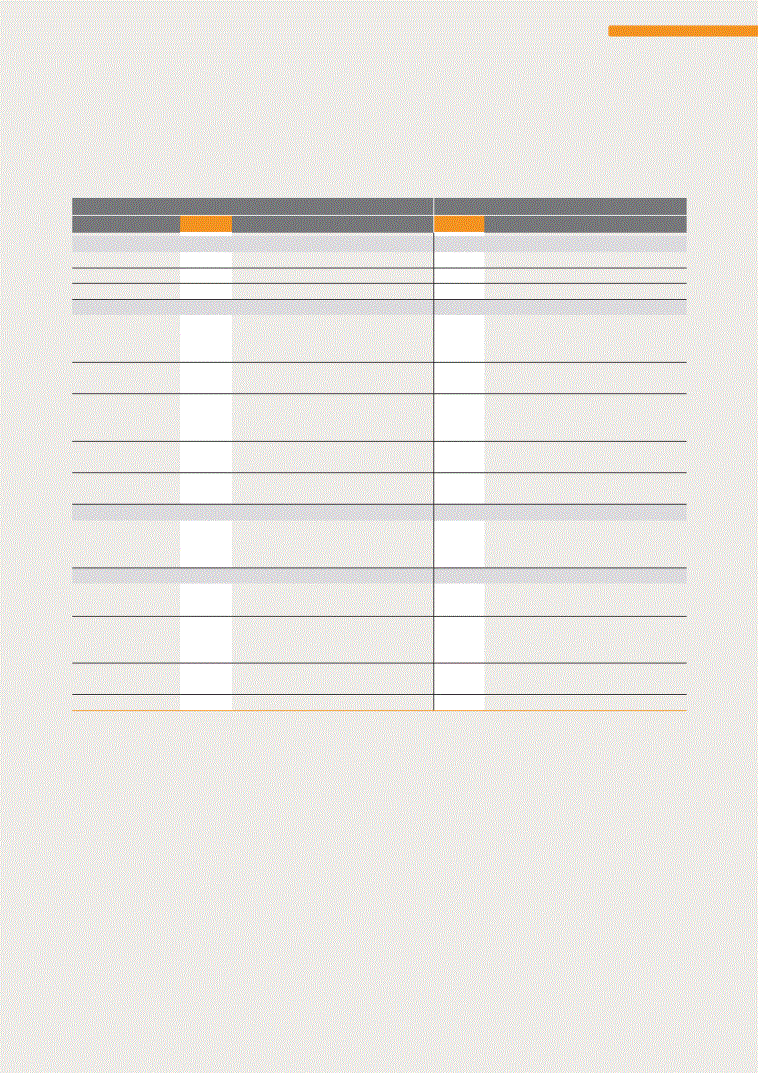
PERFORMANCE REVIEW
Environmental performance
(1)
(continued)
GHG emissions (000t CO
2
e)
No. of reportable environmental incidents
2014
2013
2012
2011
2010
2014
2013
2012
2011
2010
South Africa
2,981
(2)
3,025
(2)
3,009
(2)
2,930
3,422
1
3
10
12
10
Vaal River
(3)
1,360
1,415
(2)
1,482
(2)
1,498
1,812
0
0
3
10
1
West Wits
(3)
1,420
1,445
(2)
1,473
(2)
1,432
1,610
0
0
0
2
9
Mine Waste Solutions
201
165
(2)
54
–
–
1
3
7
0
0
Continental Africa
785
969
978
938
950
4
5
5
14
16
Ghana
Iduapriem
74
113
94
89
95
0
1
2
0
5
Obuasi
198
199
197
187
211
1
3
1
14
6
Guinea
Siguiri
150
175
177
184
179
0
0
0
0
3
Mali
Sadiola
107
156
161
148
137
0
0
1
0
1
Yatela
18
38
52
46
39
0
0
0
0
0
Namibia
Navachab
(4)
42
43
31
28
0
0
0
0
0
Tanzania
Geita
238
246
254
253
261
3
1
1
0
1
Australasia
359
174
125
130
139
0
2
1
1
0
Australia
Sunrise Dam
135
123
125
130
139
0
0
1
1
0
Tropicana
(5)
224
51
0
2
Americas
449
399
389
348
314
0
0
0
0
1
Argentina
Cerro Vanguardia
118
119
111
103
95
0
0
0
0
1
Brazil
AGA Mineração
36
32
29
25
23
0
0
0
0
0
Serra Grande
14
15
14
13
15
0
0
0
0
0
United States
Cripple Creek & Victor
281
233
235
207
181
0
0
0
0
0
AngloGold Ashanti
4,574
4,567
4,501
4,343
4,825
5
10
16
27
27
(1)
Refer to the Sustainable Development Report 2014 for definitions of these environmental indicators.
(2)
In South Africa, the Eskom grid emission factor was revised by the National Business Initiative in consultation with Eskom, leading to a change in the electricity-related emissions reported for 2012 and 2013. The figure reported for 2012 included Nufcor.
(3)
These include consumption by Surface Operations’ facilities located in these areas.
(4)
Sold effective 30 June 2014.
(5)
Tropicana began production in the fourth quarter of 2013.
109
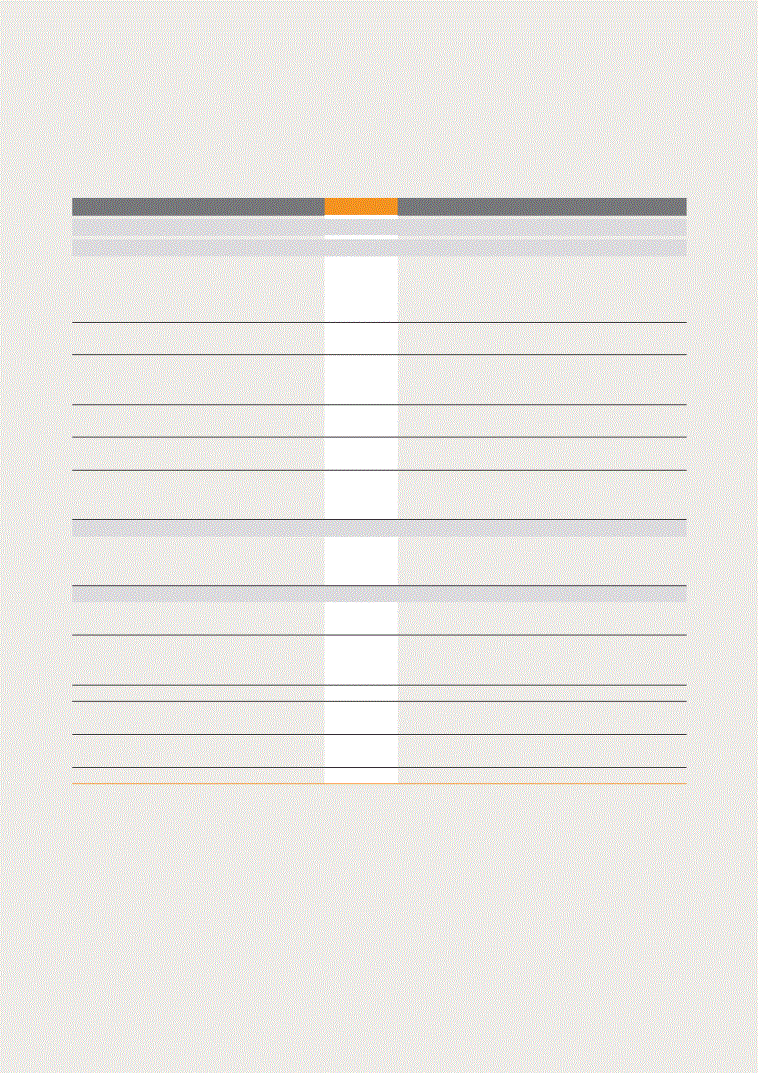
FIVE-YEAR STATISTICS: BY OPERATION
continued
Operational, financial and sustainability statistics
Social performance
(1)
Community investment ($000)
2014
2013
2012
2011
2010
South Africa
(2)
8,073
8,391
7,700
3,670
3,242
Continental Africa
3,933
13,279
13,341
13,502
8,047
Ghana
Iduapriem
148
302
465
513
404
Obuasi
208
1,197
2,007
2,704
2,100
Corporate office
–
–
70
47
1,300
Guinea
Siguiri (85%)
220
1,326
1,083
772
556
Mali
Morila (40%)
81
56
198
48
214
Sadiola (41%) and Yatela (40%)
175
126
572
429
442
Namibia
Navachab
(3)
44
59
201
54
133
Tanzania
Geita
1,973
5,489
4,834
4,302
1,016
DRC
Kibali (45%)
(4)
654
4,140
976
1,299
489
Mongbwalu (86.22%)
430
584
2,935
3,335
1,393
Australasia
247
463
464
276
456
Australia
Sunrise Dam
247
301
464
276
456
Tropicana
(4)
–
125
Americas
3,659
5,761
5,148
4,939
5,480
Argentina
Cerro Vanguardia (92.5%)
1,223
1,096
1,520
2,067
1,602
Brazil
AGA Mineração
712
1,297
813
791
791
Serra Grande
(5)
153
472
719
268
831
Colombia
993
1,905
1,188
1,210
1,557
United States
Cripple Creek & Victor
(6)
578
991
908
603
699
Sub-total
15,912
27,894
26,653
22,387
17,225
Equity-accounted investments
(1,113)
(5,358)
(1,746)
(1,775)
(1,145)
AngloGold Ashanti
14,799
22,536
24,907
20,612
16,080
(1)
Refer to the Sustainable Development Report 2014 for the definition of this social indicator.
(2)
Community investment at the South African operations is aggregated and is overseen via the corporate entity and includes corporate community investment.
(3)
Sold effective 30 June 2014.
(4)
Kibali and Tropicana began production in the fourth quarter of 2013.
(5)
AngloGold Ashanti’s holding increased to 100% (from 50%) from 1 July 2012.
(6)
Includes the Denver office.
INTEGRATED REPORT
2014
110
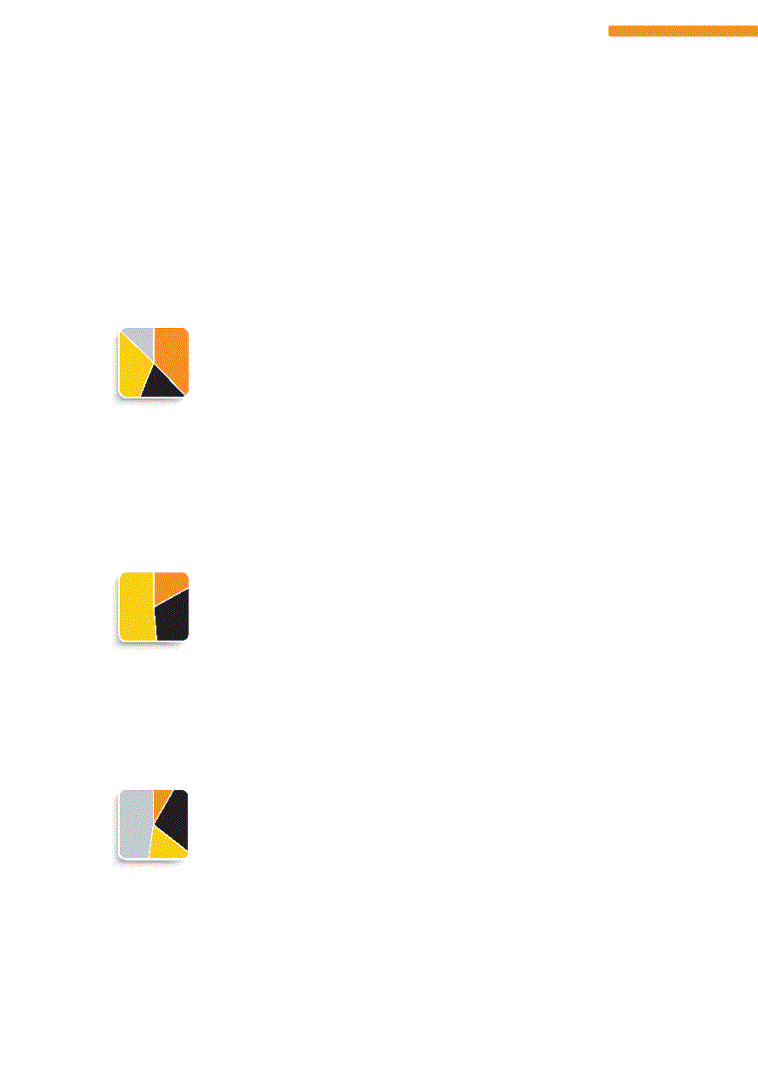
Planning to ensure the long-term sustainability of our business is guided by our financial and non-financial strategic objectives. In particular, it is based on exploration that develops a project pipeline of resources and reserves.
In parallel with our exploration work, our planning includes investing in the skills and
technological developments needed to access, safely and efficiently, the extensive deep-level
reserves at our South African operations.
In addition, our planning takes into consideration the remediation and social obligations that
come with the cessation of mining and the closure of mining operations.
EXPLORATION
Our exploration programme covers greenfields and brownfields projects. The first steps of this
programme are to identify prospective gold deposit targets, which undergo further intensive
evaluation once identified as being worthwhile.
•
Greenfields exploration aims to discover large, high-value gold deposits that can provide
a pipeline of further high-quality and rigorously prioritised exploration projects, which in turn
lead to the development of new mines.
•
Brownfields exploration focuses on delivering value through incremental additions to
reserves in existing mines as well as new discoveries in defined areas around existing
operations. Brownfields exploration actively drives the creation of value by growing our
Mineral Resource and Ore Reserve, our major asset. The brownfields exploration programme
is based on innovation in geological modelling and mine planning, and continual optimisation
of our asset portfolio.
Greenfields exploration
AngloGold Ashanti’s greenfields exploration team has a proven track record that includes
the world-class discoveries of La Colosa, Gramalote, Tropicana, and Quebradona (Nuevo
Chaquiro). These discoveries are attributed to our committed and professional team of
geologists working on a portfolio of highly prospective and strategic ground holdings.
In 2014, the greenfields exploration business unit delivered exploration successes while
simultaneously reducing costs. It has been highly successful in delivering new quality gold
ounces and, now, copper tonnes into our resource inventory. The maiden copper-gold Mineral
Resource for Nuevo Chaquiro in Colombia exemplifies the unit’s success. This is a significant
copper-gold porphyry-style mineralised system, one of five known porphyry centres on the
property – see www.anglogoldashanti.com for specific details on this deposit, including the
exploration location maps.
During the year, greenfields activities became more focused, helped by rationalising
tenements in Colombia and Australia. In 2014, realised expenditure was $41m. AngloGold
Ashanti remains committed to its core greenfields projects and has over 13,000km2
of highly-
prospective ground in Australia, Colombia, and Guinea along with small ground positions in
Argentina and Brazil. Advanced greenfields exploration activities were conducted in four
countries with the completion of over 100,000m of diamond, reverse circulation and aircore
drilling. Drilling programmes aimed to test new high-priority targets in Australia and further
delineate existing discoveries in Colombia, Guinea and Brazil.
PLANNING FOR THE FUTURE
PERFORMANCE REVIEW
•
Continental Africa
7
• Australasia
13
•
Americas
21
Greenfields spend by region
($m)
•
South Africa
7
• Continental Africa
23
•
Australasia
14
•
Americas
40
Brownfields spend by region
($m)
•
Brownfields*
84
• Greenfields
41
•
Prefeasibility studies
69
•
Other
28
Breakdown of exploration spendby activity
($m)
* Capitalised and expensed
111

Colombia: Exploration success continued at the Nuevo Chaquiro deposit, which is part
of the Quebradona project, in joint venture with B2Gold (AngloGold Ashanti 89.75%). In
November, AngloGold Ashanti announced a maiden Inferred Mineral Resource estimate for
Nuevo Chaquiro of 604Mt at an average grade of 0.65% copper, 0.32g/t gold, 4.38g/t silver
and 116ppm molybdenum for a contained metal content of 3.95Mt copper, 6.13Moz gold,
85.2Moz silver and 70,000t molybdenum*. The discovery represents a realistic inventory
of mineralisation within a conceptual underground mine design, based on two lifts using
a combination of block caving and panel caving. Results from the latest Mineral Resource
drilling in December 2014 continue to return multiple consistently mineralised intersections
in the high-grade (>0.6% Cu) intrusive phase within the declared Mineral Resource. Drilling
is now aimed at better defining and extending the high-grade (>0.6% Cu) zone and bringing
this to indicated status.
Brazil: Exploration progressed on the Graben project, in joint venture with Graben Mineração
(AngloGold Ashanti 51%). Following the completion of high-resolution ground magnetics
surveying and 3D inversion modelling, approximately 1,100m of diamond drilling were
completed in December on priority targets within the highly prospective Juruena Belt. These
holes targeted de-magnetised intrusive rocks associated with alteration and possible sulphide
mineralisation. The holes successfully intersected altered and mineralised rocks.
Guinea: Exploration work continued in Siguiri Blocks 2, 3 and 4 (AngloGold Ashanti 85.0%) until
20 July, after which work was suspended due to the outbreak of the Ebola virus disease in the
immediate region. On the Kounkoun trend located within 50km of the Siguiri mine, in Block 3,
7,259m of reverse circulation drilling was completed to test the continuation of mineralisation
between KK1 and KK2. IP and drill testing of other targets in the region delivered negative results.
In December, the greenfields exploration unit withdrew from Guinea and transferred responsibility
for Siguiri Blocks 2-4 to the Siguiri brownfields unit.
Australia: In Western Australia, exploration activities on the Tropicana project, in joint venture
with Independence Group NL (AngloGold Ashanti 70%), progressed solidly through the year
with more than 60,000m of aircore, 1,800m of reverse circulation and 500m of diamond drilling
being completed. Encouraging results were returned from Madras prospect approximately
25km south of the Tropicana Gold Mine. The Strawbridge Project (AngloGold Ashanti 100%) in
Western Australia was added to the portfolio late in the year. In New South Wales at the Mullion
Project (AngloGold Ashanti 100%), significant geophysical surveying was completed.
Brownfields exploration
Brownfields exploration was carried out in 11 countries, in and around our operations. A total
of 389,900m of diamond and reverse circulation drilling was completed during the year.
South Africa: Five surface holes were drilled during the year – four at the West Wits operations
at Mponeng’s Western Ultra Deep Levels (WUDLs) and one at the Vaal River operations –
achieving a total length of 6,923m.
Argentina: Mineral Resource expansion and exploration continued at Cerro Vanguardia with
follow-up drilling for vein extensions along strike and at depth, identifying additional mill ore.
Mapping, trenching and channel sampling work defined new exploration targets.
Brazil: Mineral Resource development drilling continued at the Cuiabá and Lamego mines to
support long-term planning and Mineral Resource definition ahead of mining. Surface drilling at
the Córrego do Sítio mine continued to infill and expand the oxide Mineral Resource. Regional
exploration tested near-mine satellite projects. At Serra Grande, exploration drilling continued
PLANNING FOR THE FUTURE
continued
“
The Nuevo Chaquiro maiden Mineral Resource is another significant discovery by AngloGold Ashanti, this time a large, high-grade polymetallic
porphry.”
*
See the AngloGold Ashanti 2014 quarterly reports and market releases on exploration activities for full details.
INTEGRATED REPORT
2014
112

to delineate the Inga mineralised structure. Geophysical surveys and soil sampling campaigns
were completed as part of the target generation programmes in the district.
Colombia: Exploration in the Gramalote area focused on infill drilling to support the updated
Mineral Resource estimate for the Gramalote Central deposit. Drilling was also directed at
expanding the nearby Monjas West target. At La Colosa, Mineral Resource development
drilling continued at a slower pace compared to previous years with other drilling expanded to
support geotechnical, hydrological and site infrastructure studies. The geological model was
updated with expansion of the deposit to the northwest and at depth.
United States: Mineral Resource development drilling continued at Cripple Creek and Victor
and was directed toward identifying expansion opportunities for the current open pit operations
through high wall laybacks. Selective drilling also tested deeper targets below or adjacent to
planned open pit designs.
Tanzania: Focus has largely been on infill drilling within Geita’s current open pits (Geita
Hill, Nyankanga and Star & Comet) and their extensions. Limited reconnaissance drilling
programmes were undertaken to test the underground potential at Star & Comet Deeps.
A total of 111 holes (20,220m) was completed.
Guinea: At Siguiri, 17,823m of reverse circulation and diamond drilling were done across
six projects in Block 1. These included reconnaissance, Mineral Resource delineation, and
infill projects for oxide and fresh rock mineralisation. The Ebola virus epidemic in West Africa
led to significant disruptions, particularly with field mapping and geophysics and the work
programme was suspended in the second half of the year.
Ghana: Underground exploration at Obuasi focused on a portion of the Red Zone 6 (Block 9)
area above 50 level with the aim of upgrading the block’s Inferred Mineral Resource. At Iduapriem,
the main focus in early-2014 was the logging, sampling and analysis of core from 2013’s Block
7&8 infill drilling. Several new targets were produced from the existing regional magnetic data
over the Iduapriem concession. Analysis of a distinct magnetic anomaly in an area west of the
Teberebie warehouse, which is also being exploited by artisanal and small-scale miners, led to
the identification of hydrothermal, vein-hosted, mineralisation. Initial sampling results show some
promise and a detailed follow-up will begin in 2015.
Democratic Republic of the Congo: Drilling at Kibali totalled 19,018m, with an additional
1,666m drilled on regional projects. The aim is to add material to the Ore Reserve at above
run-of-mine grade, to find gap fillers where required, or to add sufficient new material
(3-5Moz) to justify a step change to the operation. At Gorumbwa, three phases of infill drilling
were completed during the year. A revised Mineral Resource estimation was completed in
November and showed 470,500oz from 4.56Mt @ 3.21g/t (within the $1500 shell at 0.5g/t
cut-off), with 22% of the Mineral Resource remaining Inferred.
Mali: A number of key oxide targets were identified at Sadiola. Research by the Centre for
Exploration Targetting continued during the year and a structural framework for mineralisation
was defined for Tambali and the FE complex. The most promising target, FE2S, shows
potential for low-grade, wide ore zones over a 1.2km strike length. Some results remain
outstanding for drilling along the Sadiola northern extension. Limited fresh rock exploration
was conducted in the FE3 and FE4 pits with positive results at both. A scoping study was done
for the newly generated Tambali Mineral Resource. Drilling targets were defined for a possible
infill programme. Field mapping and sampling continued over the lease area and the geological
map has been refined with new information from most target area.
PERFORMANCE REVIEW
“
Long-term planning for the sustainability of our business is based on exploration that develops a pipeline of resources and reserves.
”
113

Australia: A 3D seismic survey to image the mineralised zone down dip of Tropicana was
designed and completed during the year. Its dataset is high quality and is being interpreted
to create a structural model that will be used to help plan drill holes in 2015. At Sunrise Dam
all mine exploration was focused on Mineral Resource definition and extension to support the
underground mine. Drilling totalled 53,100m for the year – 67% diamond core and 33% UG-
RC. Drilling in 2014 targeted the Vogue/Dolly area (42%); Cosmo East (23%); Sunrise Shear
(22%) and GQ South (13%). Drilling in Vogue/Dolly defined an Indicated Mineral Resource
above the 1,700mRL, in line with the plan to start mining stopes in the upper part of Vogue/
Dolly area in 2015. In Cosmo East, the mining area has now been upgraded to an Indicated
Mineral Resource down to the ~1,500mRL, enabling planned mining below the current
1,625mRL level. The 2015 programme is on more extensional drilling and defining new areas
to replenish the Inferred Mineral Resource.
More detail on the company’s exploration work for the year is included under the Exploration
updates on the website at www.anglogoldashanti.com.
TECHNOLOGY AND INNOVATION
Towards a new mining method for ultra-deep South African mines
The long-term future of our South African mining operations lies in extracting ore from
depths never before achieved and where safety and cost considerations preclude the use of
conventional mining practices. Safety is paramount, and at AngloGold Ashanti our approach to
addressing the challenges of depth is to design and develop innovative mechanised methods
that remove miners from hazardous and unhealthy working places.
To overcome the challenges of depth we established the AngloGold Ashanti Technology
Innovation Consortium (ATIC) charged with investigating and devising ways of safely
mining all of the gold, all of the time and at greater depths than those at which we currently
operate. The key component of the new mining method under development is the use of
mechanical boring techniques targeting the gold reefs alone, thereby minimising dilution,
while reducing or even eliminating seismicity risks.
An initial test site was established at TauTona mine in South Africa where reef-boring applications
are being tested along with that of ultra-high strength backfill (UHSB). The success of this
technology will enable the wider deployment of small-scale prototype units, initially targeting
mining opportunities not currently available using conventional practices.
In 2014, ATIC which includes a group of original-equipment manufacturers, made significant
progress in advancing and differentiating the profiles of the individual key technology projects.
Progress on developing technologies for safe, automated mining for selective use at our deep-
level mines is as follows:
Ore body knowledge and exploration – geological drilling
Geological drilling is a key area of development for the new mining method. ATIC determined
that a solution for fast and accurate geological information of the complex vein structures
will be required to ensure that only the gold is being mined during the reef boring process.
During 2014, significant progress was made in achieving targeted drilling rates with no loss
in accuracy. An overall 294m depth (drill string length available) was reached in line with the
set target of 8m/hour and depths of between 270m-300m. Reverse circulation is currently
undergoing technical development to convert it into an underground application that can
operate efficiently.
PLANNING FOR THE FUTURE
continued
“
A new mining method is being developed to safely mine all of the gold, only the gold, all of the time.
”
INTEGRATED REPORT
2014
114

Reef boring
The developments of the reef boring technologies have progressed beyond initial trials and
are in the preliminary stages of producing ore from trial sites. Reef boring machines in three
different sizes have been commissioned in an attempt to address the variable reef channel
widths that reside in the deep underground mining environment of AngloGold Ashanti’s assets.
These machines have been commissioned and, in many cases, deployed to the operating
environment for testing and further improvement. The biggest challenges were found in areas
with softer footwall conditions, typically associated with the C-reef ground. The commissioning,
application and development of reef boring machines will continue at various prototype sites.
Work teams will continue to focus on improving technical and work management aspects of
machine performance toward design expectations.
•
Machine manufacturing: Four medium-reef (width 400-800mm) machines and two small-
reef (width 0-400mm) machines were manufactured and delivered. Final design of the MK4
machine was approved and manufacturing is in progress. Delivery is expected in the second
quarter of 2015 for the extension test site at TauTona mine.
•
TauTona – test site: 30 holes were drilled during the year at diameters of between
660mm and 720mm to address changing reef channel. Improvement in the drilling
theory remains a focus area and different reamer cutter configurations were tested.
Due to the reef channel increasing, more holes will be drilled and the further information
obtained will allow us to evaluate the extent to which the reamers can be deployed at
the prototype sites.
•
TauTona mine – prototype site: Three medium-reef (width 400mm-800mm) Atlantis
machines were commissioned at TauTona and were progressively deployed at
different prototype sites on 97 Level where a total of 28 holes were drilled. Industrial
and mechanical engineers assisted with support on technical and work management
aspects to improve machine performance to reach design expectations. One machine
was modified to allow it to operate in raise-boring mode, whereby the machine is set
up on an upper level and connected for drilling downwards.
•
Great Noligwa and Kopanang: Testing started using the new hydro-power equipment,
the narrow-reef (0-400mm) machine. Nine holes were drilled. This drilling method requires a
double-pass drilling sequence where an initial pilot or direction hole is drilled, followed by a
larger diameter cutter that reams the initial hole to a greater width. Drilling of the 115mm pilot
holes succeeded in delivering acceptable drilling rates and directions. However, reaming
with 250mm and 350mm reamers remains a challenge as the softer footwall conditions
associated with the C-reef ground caused the cutter head to diverge from the direction hole
into the barren rock below the reef. It was decided to test the technology in the Vaal Reef
where footwall conditions are more consistent, and the machine was moved to Kopanang.
Thermal spalling which has shown encouraging results in initial tests at Kopanang will be
considered for extracting the narrow C-reef vein at Great Noligwa.
•
Site equipping: In 2014 equipping of the prototype sites was completed and work continues
on equipping sites for 2015.
Ultra high-strength backfill (UHSB)
The successful development of the UHSB product, together with the reef-boring
technology for use in mining applications as a support medium, creates the potential for
the earlier-than-planned mining of shaft pillars, the pre-extraction of planned stabilising
pillars and post-extraction of existing stabilising pillars.
PERFORMANCE REVIEW
“
We have progressed beyond initial trials and are in the preliminary stages of producing from trial sites as we work to develop an optimal methodology for high-stress pillar environments.”
115

PLANNING FOR THE FUTURE
continued
During the year, alterations were made to the underground backfill plant at TauTona mine to
enhance the efficiency of the system. All available reef-bored holes in the prototype production
block and test site have been filled. A data-logging software system was installed and
commissioned in the prototype production site and a tailings dry plant has been commissioned
on surface.
Surface testing to increase the mixing volume from 4m³/hour to 8m³/hour produced positive
results. Alternative mixing methodologies were developed with a laboratory-scale mixer in
Germany. A full-scale prototype mixer was manufactured, delivered and commissioned. Initial
trials gave positive results, now the mixing trials are focused on increasing the volume per mix
as well as to reduce the mixing times.
REHABILITATION AND CLOSURE
Preparations for rehabilitation and closure are integral to mine planning and development, and
evolve from the start of exploration to the end of mining activity. Closure planning, which takes
into account community livelihoods and land rehabilitation, continues throughout the life of
the mine and is integrated into daily business activities, beginning at the very start of projects
and operations. Integration takes into account the end use of land and, where applicable,
open pits. Waste rock dumps are designed and constructed to maximise opportunities for
progressive rehabilitation. In addition sustainable livelihood developments are incorporated into
each operation’s community investment programmes.
This being an integral part of every operation’s life cycle, includes the assessment of associated
liability costs and the assurance of adequate financial provision to cover these costs, as well as
optimised planning to ensure closure costs are minimised.
Mining operations may be halted permanently or temporarily before a mine’s Mineral Resource
or Ore Reserve are fully depleted. This may be for a multitude of individual or combined reasons
than can include a decline in the gold price, excessive cost inflation, labour issues, political risk,
safety or environmental issues. AngloGold Ashanti takes these possibilities into account to
ensure that its responsibilities to rehabilitation and commitment to leaving a positive legacy
once mining has ceased are fulfilled.
Our remediation obligations are integral to the environmental management plans (EMPs) of
each of our operations and comply fully with the requirements of the regulatory authorities. And
while we prepare for the physical liabilities we also prepare for their costs.
Our closure, decommissioning and restoration liabilities are appraised each year – both their
costs and the work that will be involved. The likely quantum of costs and their timing can
be estimated within reasonable limits based on our current knowledge of the effects mining
has had on the environment. Costs can also be estimated based on expectations of the
technologies likely to be available when remediation takes place, on likely future legal and
regulatory enactments and on previous experience of remediation.
In making these estimates we use conventional financial methodologies to calculate the
present value of the financial settlement obligations and their timing. Future cash flows
are based on current prices and discounted at a pre-tax rate that reflects current market
assessments of the time value of money. Our estimate of the group’s rehabilitation obligation
increased to $851.0m at the end of 2014, from $728.4m at the end of 2013 as a consequence
of a number of factors. The year-on-year increase in rehabilitation liabilities is due to the
annual revision in the life-of-mine plans, changes in assumptions such as the discount and
inflation rates and an increase in cost estimates.
We are confident that our provisions are adequate and that we shall be able to honour our
remediation obligations as and when our operations approach closure.
“
Closure planning continues throughout the duration of a project and the life of mine.
”
INTEGRATED REPORT
2014
116
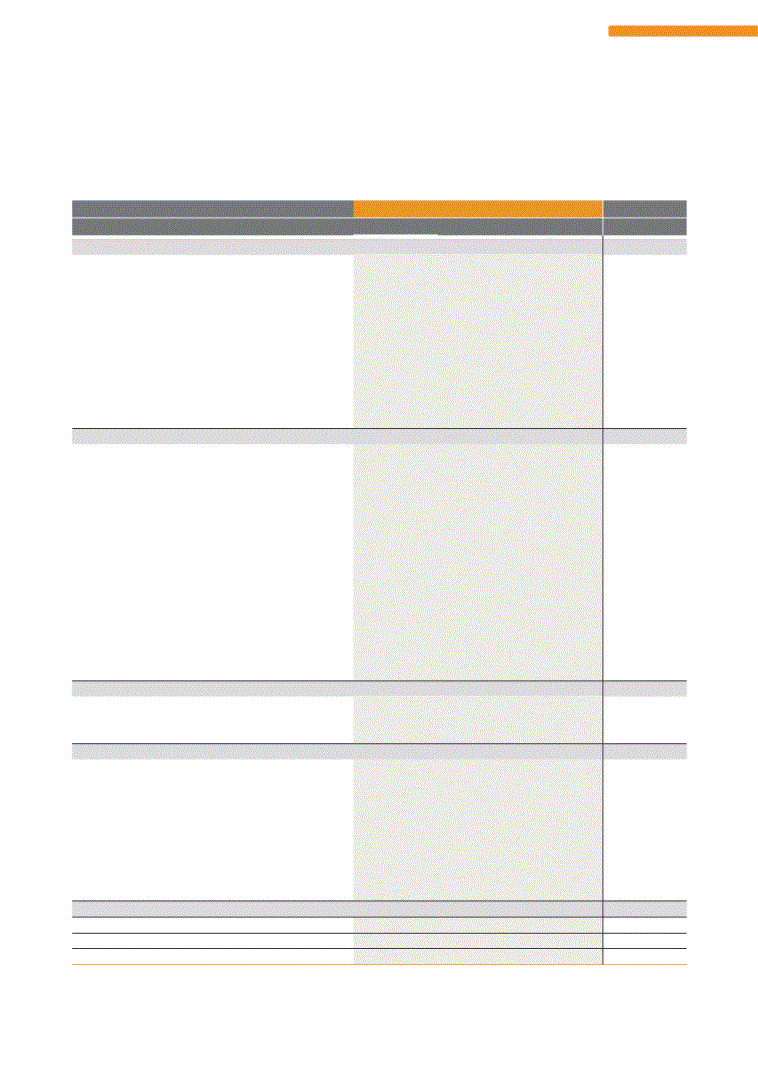
Rehabilitation liabilities per operation ($ million)
2014
2013
Operation
Restoration Decommissioning
Total
Total
South Africa
12.2
71.3
83.5
78.1
Great Noligwa
0.2
2.3
2.5
7.0
Kopanang
1.1
11.0
12.1
10.6
Moab Khotsong
4.2
19.0
23.2
18.8
TauTona
(1)
2.7
10.3
13.0
10.7
Mponeng
1.1
1.7
2.8
1.2
Legacy projects
– Vaal River
–
7.4
7.4
6.8
– West Wits
–
3.5
3.5
4.5
– Other
0.4
–
0.4
0.5
Mine Waste Solutions
2.5
15.4
17.9
17.4
Nufcor SA
–
0.7
0.7
0.6
Continental Africa
291.9
171.3
463.2
411.0
Ghana
Iduapriem
34.8
8.3
43.1
37.2
Obuasi
153.7
63.6
217.3
183.5
Mpasatia (Bibiani pit)
10.0
–
10.0
9.6
Guinea
Siguiri
36.4
38.8
75.2
69.9
Mali
(2)
Morila
3.8
1.2
5.0
4.8
Sadiola
13.6
12.5
26.1
27.3
Yatela
6.1
10.1
16.2
14.6
DRC
Mongbwalu
2.8
1.8
4.6
7.2
Kibali
(2)
–
6.9
6.9
3.7
Tanzania
Geita
30.7
28.1
58.8
53.2
Australasia
32.0
33.5
65.5
53.1
Australia
Sunrise Dam
21.1
11.3
32.4
29.3
Tropicana
10.9
22.2
33.1
23.8
Americas
221.9
50.9
272.8
236.6
Argentina
Cerro Vanguardia
42.0
15.5
57.5
47.3
Brazil
AngloGold Ashanti Mineração
55.8
19.6
75.4
86.5
Serra Grande
14.8
6.6
21.4
22.4
United States of America
Cripple Creek & Victor
103.6
9.2
112.8
78.7
Colombia
La Colosa
5.7
–
5.7
1.7
Other
4
–
4
–
562.0
327.0
889.0
778.8
Less equity-accounted investments included above
(2)
(7.3)
(30.7)
(38.0)
(50.4)
554.7
296.3
851.0
728.4
(1)
Includes Savuka.
(2)
The equity-accounted investments refer to the Mali assets and Kibali in the DRC.
PERFORMANCE REVIEW
117

KEY GROUP FORECASTS:
Production
4.0Moz – 4.3Moz
All-in sustaining costs
$1,000/oz – $1,050/oz
Capital expenditure
$1.0bn – $1.1bn
ONE-YEAR OUTLOOK
Forecasts of expected production, costs and capital expenditure for 2015
Production
Total cash
costs
All-in
sustaining
costs**
Capital
expenditure
Non-
sustaining
sustaining
capital
Sustaining
capital
For the year ending 31 December 2015
(000)oz
$/oz
$/oz
$m
$m
$m
South Africa
1,180 – 1,268
797 – 849
1,024 – 1,075
272 – 299
43 – 48
229 – 251
South Africa
1,180 – 1,268
797 – 849
1,024 – 1,075
272 – 299
43 – 48
229 – 251
Continental Africa
1,252 – 1,346
788 – 839
963 – 1,011
313 – 345
122 – 134
191 – 211
Ghana
193 – 207
1,054 – 1,122
1,292 – 1,357
62 – 68
22 – 25
40 – 43
Guinea
240 – 257
914 – 973
1,125 – 1,181
45 – 49
–
45 – 49
Mali
101 – 109
1,017 – 1,083
1,112 – 1,168
9 – 10
–
9 – 10
Tanzania
461 – 496
681 – 725
902 – 947
85 – 94
–
85 – 94
DRC
257 – 277
573 – 610
617 – 648
112 – 124
100 – 109
12 – 15
Americas
1,006 – 1,080
703 – 748
957 – 1,005
340 – 374
95 – 106
245 – 268
Argentina
248 – 266
666 – 709
927 – 973
61 – 67
–
61 – 67
Brazil
503 – 540
692 – 737
1,018 – 1,069
157 – 173
–
157 – 173
Colombia
–
–
–
10 – 11
–
10 – 11
United States of America
255 – 274
759 – 809
866 – 910
112 – 123
95 – 106
17 – 17
Australasia
562 – 606
794 – 845
953 – 1,001
71 – 78
71 – 78
Australia
562 – 606
794 – 845
953 – 1,001
71 – 78
–
71 – 78
Other
–
–
–
4 – 4
–
4 – 4
AngloGold Ashanti
4,000 – 4,300
770 – 820
1,000 – 1,050
1,000 – 1,100
260 – 288
740 – 812
Based on the following assumptions: R11.6/$, $/A$0.85, BRL2.60/$; AP9.50/$; Brent crude at $70 per barrel.
** Group level all-in sustaining cost guidance includes corporate and marketing costs.
Other illustrative estimates
$m
Outlook 2015
Depreciation and amortisation
860
Corporate and marketing costs
95 – 110
Expensed exploration and evaluation costs (including equity-accounted investments)
155 – 175
Interest and finance costs (income statement)
270
Interest and finance costs (cash flow)
240
The forecasts provided for 2015 take into account current market
conditions, the outlook for commodity prices, particularly that of oil, and
the outlook for global economic growth*.
conditions, the outlook for commodity prices, particularly that of oil, and
the outlook for global economic growth*.
*
Production and cost estimates
do not take into account the
impacts of any unforeseen
operational disruptions, changes
to the projects or changes to the
asset portfolio/operating mines.
do not take into account the
impacts of any unforeseen
operational disruptions, changes
to the projects or changes to the
asset portfolio/operating mines.
INTEGRATED REPORT
2014
118
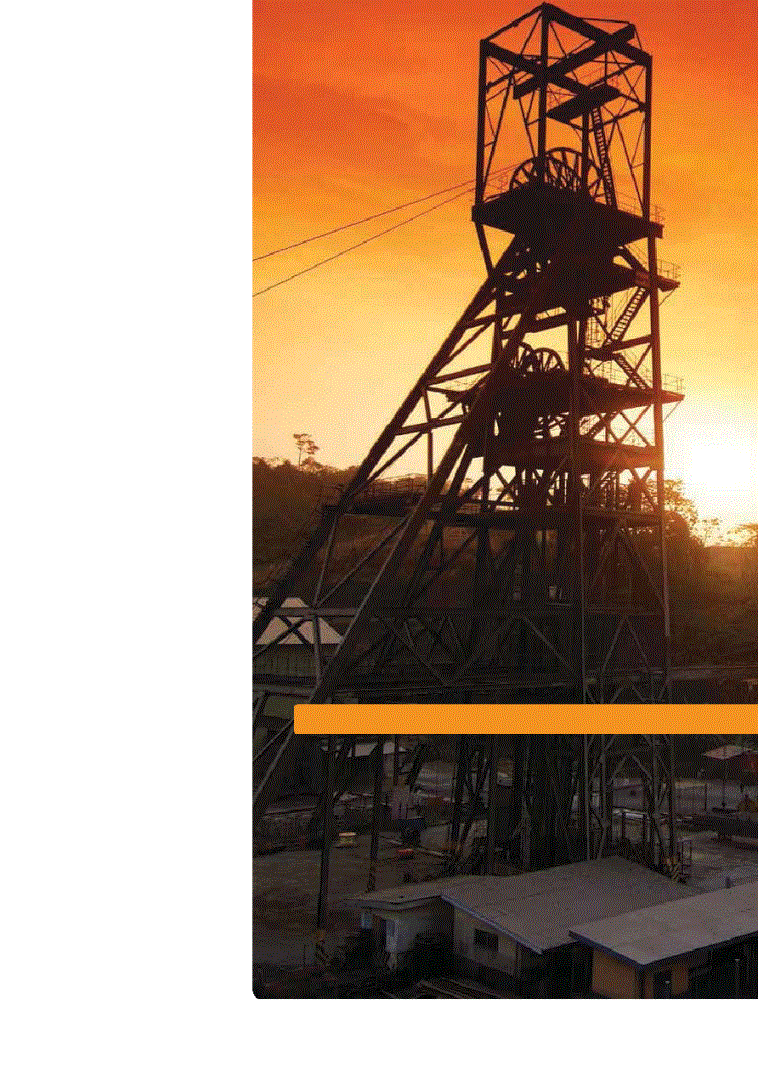
ACCOUNTABILITY
P119-136
120
Corporate governance
130
Remuneration and performance
136
Approvals and assurances
WE ARE ACCOUNTABLE TO ALL STAKEHOLDERS
This section presents information on those functions which underpin our business, namely, governance, remuneration and assurance.
ACCOUNTABILITY
119

Good corporate governance is an integral part of the group’s sustainability. Adherence to the standards and recommendations set out in the King III Report and other relevant laws and regulations is vital to achieving our strategic priorities.
Corporate governance forms an overarching framework in which our business operates and
we are committed to promoting good governance and ethics within all areas of our business.
To achieve this, the group continues to enhance and align its governance structures, policies
and procedures to support its operating environment and strategy.
Application of King III principles
The application and adherence to the King III principles continues to be a key focus. AngloGold
Ashanti reviewed its application of the King III principles against the JSE Listings Requirements
through the Governance Assessment Instrument tool of the Institute of Directors Southern
Africa and is satisfied that it has substantially applied the King III principles. A detailed analysis
of the company’s compliance with Chapter 2 of the King Code of Governance for South Africa,
dated March 2015, is available on the company’s website, www.anglogoldashanti.com.
GOVERNANCE REVIEW
The company is governed by a unitary board of directors, the composition of which promotes
the balance of power and of authority and precludes any one director from dominating
decision-making. Our board membership at year-end comprised nine directors, seven
independent non-executive directors and two executive directors. Each year, one-third of
AngloGold Ashanti’s directors retire and their re-election is subject to the approval of the
shareholders at the annual general meeting.
The reappointment of non-executive directors is subject to eligibility and performance. The
board is supported by its committees and has delegated certain functions to these committees
without abdicating any of its own responsibilities. This process of formal delegation involves
approved and documented terms of reference, which are reviewed annually.
It is the responsibility of our board to exercise oversight of governance throughout the
organisation. We acknowledge that sound governance principles and practices underpin the
creation of value and the sustainability of our business, and are thus crucial to the achievement
of our business objectives. We also recognise that strategy, performance, sustainability and
risk are inseparable. Our value-driven culture and code of ethics underpin AngloGold Ashanti’s
governance structures and processes, committing the company to high standards of business
integrity, and ethics in all its activities.
The governance of the company is guided by internal policies and external laws, rules,
regulations and best practice guidelines, details of which are available on the company’s
website at www.anglogoldashanti.com/sustainability. Our governance structures and processes
are reviewed regularly and adapted to accommodate internal developments and reflect national
and international best practices.
CORPORATE GOVERNANCE
“
AngloGold Ashanti has a unitary board that comprised nine directors in all at year-end 2014. Post year-end, the appointment of an additional two directors became effective.”
INTEGRATED REPORT
2014
120

THE BOARD
Role of the board
The overriding role of the board is to ensure our long-term sustainability and success, for the
mutual benefit of all stakeholders. Its overall role is one of strategic leadership. This includes
the setting, monitoring and review of strategic targets and objectives, the approval of capital
expenditure, acquisitions and disposals, and oversight of governance, internal controls and
risk management. The duties, responsibilities and powers of the board, the delegation of
authority and matters reserved for the board’s authority are all set out in the board charter,
which is available on the company’s website, www.anglogoldashanti.com.
Board proceedings
The board meets six times a year, with additional meetings arranged when necessary. The
strategies of AngloGold Ashanti are discussed and agreed on with executive management in
an annual strategy session.
Role of the lead independent director and deputy chairman
In February 2014, given the then non-independence of the newly-appointed Chairman
and in line with the recommendations of King III, the board appointed Prof Nkuhlu as lead
independent director and from March 2014 as deputy chairman. The principal role of the
lead independent director and deputy chairman is to act when the board Chairman is not
present or is unable to perform his duties for any other reason, and to serve as liaison
between the non-executive directors and the board Chairman.
Role of the Chief Executive Officer and the Executive Committee
The group’s Chief Executive Officer is responsible for the execution of the company’s
strategy and reports to the board. He chairs the Executive Committee that comprises nine
members, who is responsible for the day to day management of the group’s affairs. The
committee’s work is supported by country and regional management teams as well as group
corporate functions.
Chief Financial Officer
Christine Ramon was appointed Chief Financial Officer on 1 October 2014 following the resignation
of Richard Duffy as Chief Financial Officer on 30 September 2014. As required by the JSE Listing
Requirements, the Audit and Risk Committee, at its various meetings during the course of 2014,
considered and expressed its satisfaction at the level of expertise and experience of Christine
Ramon and Richard Duffy as Chief Financial Officers of AngloGold Ashanti during 2014.
The Audit and Risk Committee concluded that, they, together with other members of the
financial management team, had effectively and efficiently managed the group’s financial affairs
during the period under review as detailed in the Chief Financial Officer’s report included in
the
>AFS
.
ACCOUNTABILITY
Role of the chairman
The roles and responsibilities of the Chairman are documented and approved by the board and are separate from those of the Chief Executive Officer (CEO). The Chairman leads the board and is responsible for ensuring its effectiveness in discharging its duties. The Chairman is re-appointed annually in accordance with King III and the results of the annual performance evaluation guide this process.
“
The role of the board is for the mutual benefit of all stakeholders... [which] includes the setting, monitoring and review of strategic targets and objectives [for the company].”
121

CORPORATE GOVERNANCE
continued
Appointment and rotation of directors
Several factors including the requirements of relevant legislation, best practice recommendations,
qualifications and skills of a prospective board member and the requirements of the Director’s
Fit and Proper Standards of the company, as well as regional demographics are considered in
appointing board members. New directors are appointed pursuant to the recommendations of
the Nominations Committee, which conducts a rigorous assessment of the credentials of each
candidate. Newly appointed directors are elected at the next annual general meeting following
their appointment and stand for approval by shareholders.
In terms of the company’s Memorandum of Incorporation (MOI), one third of the directors are
required to retire at each annual general meeting and if they are eligible and available for re-
election, will be put forward for re-election by the shareholders. The board has determined that
the directors to stand for re-election are Nozipho January-Bardill, Professor Wiseman Nkuhlu and
Rodney Ruston.
The summary of the background and qualifications of each director are set out under the
section on the Board of Directors and on Executive Management from page 53 of this report.
Remuneration of directors
Non-executive directors receive fees for their services as directors including fees for their
membership of committees and an allowance for travelling internationally to attend meetings.
These fees and allowances are fixed by shareholders at the Annual General Meeting. Following
the review carried out and on the recommendation of the Remuneration and Human Resources
Committee, the non-executive directors unanimously agreed that they were appropriately
remunerated and rejected an increase in remuneration.
Further details of the executive and non-executive directors’ remuneration and fees are
included in group note 35 to the >AFS
.
Directors’ interests
Directors are required to declare their interests annually and to disclose any conflicts of interest,
if and when they arise, to determine whether there are any that conflict with their duties at
AngloGold Ashanti. Once a conflict has been disclosed, it is managed appropriately by the
board. A Declaration of Interest Register is updated by the company secretary and circulated
at each board meeting.
Directors’ dealings in shares and closed periods
The Company Secretary informs the board and AngloGold Ashanti’s employees of its closed
and prohibited periods, during which trade in AngloGold Ashanti shares by executive directors,
senior divisional management and restricted participants in the company’s various share
incentive schemes is prohibited. The closed and prohibited periods remain in force until the
publication of the final and quarterly results. Any period where the company is trading under
cautionary announcement is also classified as a closed and prohibited period. All directors’
dealings require the prior approval of the Chairman and the Company Secretary who retains a
record of all such share dealings.
“
The principles of King III are applied to ensure the effectiveness of corporate governance practices.”
INTEGRATED REPORT 2014
122

Independence of directors
King III provides that assessment of the independence and performance of directors who have
been serving on the board for more than nine consecutive years should be more rigorous than
for those who have been appointed more recently. As at 31 December 2014, none of the
company’s independent directors had served for that length of time.
Determination of independence of directors is guided by King III, the Companies Act, the
requirements of the JSE and the NYSE independence test, the company’s internal policy
on independence, as well as best practice. All directors were found to be independent in
terms of character and judgement and the chairman of the board became independent in
November 2014.
Performance evaluation 2014
The board of AngloGold Ashanti requested the assistance of a facilitator to manage an
evaluation of the performance of:
•
The board
•
The board chairman
•
The lead independent director
•
Deputy chairman
•
Individual directors
•
The Company Secretary
•
Board committees
The board further requested an evaluation of the independence of board members. The
evaluation is carried out every third year by an external party and the other two years the
Company Secretary facilitates the process.
The results were discussed by the Nominations Committee and the board in February 2015
and an action plan was being developed for areas of refinement.
Company Secretary
The Company Secretary, Ria Sanz, is responsible for developing, implementing and maintaining
effective processes and procedures to support the board and its committees in the discharge
of their duties and responsibilities. She advises the board and individual directors on their
fiduciary duties and on corporate governance requirements and best practices.
In line with the JSE Listings Requirements, the board evaluated the qualifications, competence
and experience of the company secretary in December 2014 and was satisfied that Ria Sanz
is qualified to serve as company secretary. The board also confirmed her independence and
her arms-length relations with the board, noting that she is not a director of the company and
has no personal connections with any of the directors. Her qualifications and experience can
be viewed in the sections entitled Board of Directors and Executive Management in this report
and on the website, www.anglogoldashanti.com.
Post year-end events – changes to board of directors
Maria Richter and Albert Garner were appointed independent non-executive directors of the
company, with effect from 1 January 2015.
“
Key activities of the board and committees are aimed at promoting the economic stability of our business.
”
ACCOUNTABILITY
123

BOARD COMMITTEES
Restructuring
Following the restructuring of the committees of the board during 2014, the committees have
achieved the anticipated expectation to cut cost, reduce meeting days and improve efficiency.
The functioning of the committees is guided by their terms of references which were approved
by the board during 2014 and are reviewed annually or as required.
The committees in place as at 31 December 2014 were as follows:
Audit and Risk Committee
Social, Ethics and Sustainability Committee
Remuneration and Human Resources Committee
Nominations Committee
Investment Committee
Audit and Risk Committee
Brief summary of responsibilities:
The Audit and Risk Committee oversees the integrity of financial reporting, the
existence of proper internal controls, the integrity of the Integrated Report and risk
management processes and assesses the company’s continuing ability to operate as
a going concern. It will assist the board overseeing IT governance, risk management
and the implementation of a group ethics and regulatory compliance programme. It
will ensure the company has qualified external auditors and internal auditors. It will
also assess the experience of the finance function and the Chief Financial Officer. More detailed information on the committee’s achievements is available in the committee chairman’s report on page 41 >AFS
.
The latest approved Audit and Risk Committee Terms of Reference, containing detailed
information regarding the committee’s responsibilities and mandate, is available on the
company’s website, www.anglogoldashanti.com/en/About-Us/corporategovernance/Pages/
default.aspx
Social, Ethics and Sustainability Committee
Brief summary of responsibilities:
The key responsibility of the committee is to assist the board in monitoring matters relating to safety, health and the environment, ethical conduct and to ensure that the company develops and behaves as a responsible corporate citizen. It will ensure that the sustainability strategy positions the company as a leader in mining and that the objectives are effectively integrated into the business. More information on the committee’s achievements is available in a podcast interview with this committee’s chairman, which can be accessed in the >SDR at www.aga-reports.com/14/sdr /#messages/chairperson.
The latest approved Social, Ethics and Sustainability Committee Terms of Reference, containing
detailed information regarding the committee’s responsibilities and mandate, is available on the
company’s website, www.anglogoldashanti.com/en/sustainability/policies/Pages/default.aspx.
CORPORATE GOVERNANCE
continued
“
It is also the board’s responsibility to
ensure that AngloGold
Ashanti is and is seen
to be a responsible
corporate citizen.
ensure that AngloGold
Ashanti is and is seen
to be a responsible
corporate citizen.
”
INTEGRATED REPORT
2014
124

Remuneration and Human Resources Committee
Brief summary of responsibilities:
This committee assists the board in ensuring that AngloGold Ashanti’s remuneration policies
are in its long-term interest. It will ensure that in terms of the decisions made, non-executive
directors, executive directors, senior management and all other employees are fairly and
responsibly remunerated and that shareholder value is delivered. It will assist the board in
the development of the company’s human resources environment. More information on the
achievements of the committee is available in the Remuneration Report on page 27 >AFS.
The latest approved Remuneration and Human Resources Committee Terms of Reference,
containing detailed information regarding the committee’s responsibilities and mandate, is
available on the company’s website, www.anglogoldashanti.com/en/About-Us/corporate
governance/Pages/default.aspx
Nominations Committee
Brief summary of responsibilities:
This committee consists of three independent directors and is chaired by the Chairman
of the board. The committee develops processes to identify, assess and recommend
board candidates for appointment as executive and non-executive directors, including
the chairman, deputy chairman, lead independent director, chief executive officer, senior
management and the company secretary, and at the same time gives full consideration
to succession planning and leadership in the group. It reviews the board, including the
balance of skills, experience and independence. It develops and implements annual
evaluation processes, whether internally or externally.
The latest approved Nominations Committee Terms of Reference, containing detailed
information regarding the committee’s responsibilities, mandate and policy on appointments to
the board, is available on the company’s website, www.anglogoldashanti.com/en/About-Us/
corporategovernance/Pages/default.aspx
Investment Committee
Brief summary of responsibilities:
This committee assesses individual capital projects and investment and divestment
opportunities to ensure that investments, divestments and financing proposals are in
accordance with AngloGold Ashanti’s primary objective of creating shareholder value on a
sustainable long-term basis.
The latest approved Investment Committee Terms of Reference, containing detailed information
regarding the committee’s responsibilities and mandate, is available on the company’s website,
www.anglogoldashanti.com/en/sustainability/policies/Pages/default.aspx.
ACCOUNTABILITY
“
The functioning of the committees is guided by the terms of references... which are reviewed annually or as required.”
125
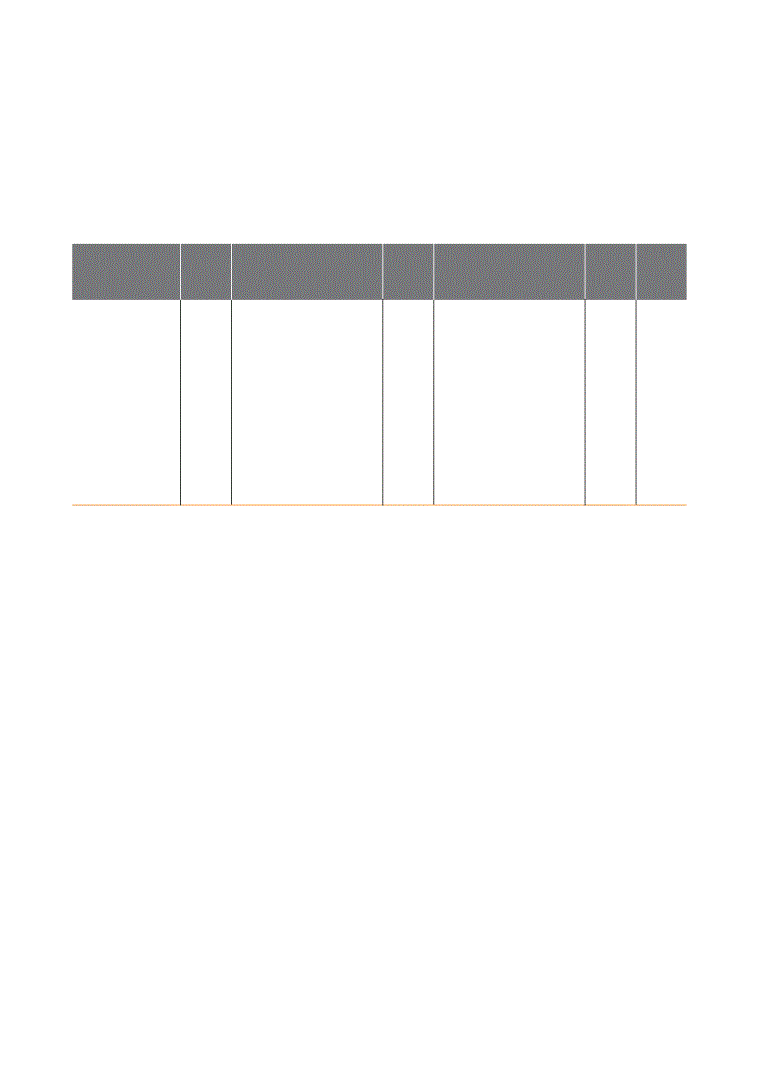
CORPORATE GOVERNANCE
continued
ETHICAL LEADERSHIP AND RESPONSIBLE CORPORATE CITIZEN
The board ensures at all times that the company is, and is seen to be, a responsible corporate
citizen. The board not only considers the financial performance of the company, but also strives
to enhance and invest in the economic life of the communities in which it operates, society
in general and the environment. The Executive Committee is responsible for ensuring these
values are adhered to. The board’s Social, Ethics and Sustainability Committee ensures the
application of these principles.
BOARD AND COMMITTEE MEETING ATTENDANCE
The composition of the board and committees at the date of this report and attendance at
meetings during 2014 are disclosed in the table below:
Name of director
Board
Audit
and
and
Risk
(12)
Audit
Corporate
Governance
(12)
Risk
and
Information
Integrity
Remun-
eration
and Human
Resources
Social,
Ethics and
Sustain-
ability
(13)
Social,
Ethics and
Transfor-
mation
(13)
Safety,
Health
and
Environment
Nomination
Investment
SM Pityana
1
8/8
1/1
4/4
3/3
2/2
1/1
7/7
1/1
RN Duffy
2
6/6
2/2
R Gasant
3
8/8
3/3
3/3
1/1
3/3
4/4
DL Hodgson
4
6/6
3/3
3/3
NP January-Bardill
5
7/8
2/3
3/3
3/3
2/2
1/1
3/3
MJ Kirkwood
6
8/8
3/3
3/3
4/4
1/2
7/7
1/1
Prof LW Nkuhlu
7
8/8
3/3
3/3
1/1
4/4
2/2
1/1
6/7
2/2
KC Ramon
8
2/2
RJ Ruston
9
8/8
3/3
1/1
1/1
2/2
1/1
3/3
4/4
TT Mboweni
10
2/3
2/2
2/3
1/2
S Venkatakrishnan
11
8/8
1/1
3/3
1/1
1
Sipho Pityana who was a non-executive director of the board since 2007, was appointed Non-Executive Chairman of the board of directors on
17 February 2014. Following a re-assessment during November 2014, he was declared independent. He stepped down as a member of the
Investment Committee on 1 May 2014.
17 February 2014. Following a re-assessment during November 2014, he was declared independent. He stepped down as a member of the
Investment Committee on 1 May 2014.
2
Richard Duffy resigned effective 30 September 2014 as Chief Financial Officer and executive director. He became a member of the Investment
Committee on 1 May 2014.
Committee on 1 May 2014.
3
Rhidwaan Gasant stepped down as a member of the Nominations Committee on 1 May 2014.
4
Dave Hodgson was appointed as an independent non-executive director on 24 April 2014. He became a member of the Investment Committee as
well as the Social, Ethics and Sustainability Committee on 1 May 2014.
well as the Social, Ethics and Sustainability Committee on 1 May 2014.
5
Nozipho January Bardill was appointed a member of the Remuneration and Human Resources Committee on 1 May 2014. She stepped down as a
member of the Nominations Committee and the Audit and Risk Committee on 1 May 2014.
member of the Nominations Committee and the Audit and Risk Committee on 1 May 2014.
6
Michael Kirkwood was appointed a member of the Audit and Risk Committee on 1 May 2014. He stepped down as a member of the Investment
Committee on 1 May 2014.
Committee on 1 May 2014.
7
Prof Wiseman Nkuhlu was appointed Lead Independent Director in terms of the recommendations of King III with effect from 17 February 2014. With
effect from March 2014, Prof Wiseman Nkuhlu was appointed Deputy Chairman. He became a member of the Investment Committee on 7 July 2014.
effect from March 2014, Prof Wiseman Nkuhlu was appointed Deputy Chairman. He became a member of the Investment Committee on 7 July 2014.
8
Christine Ramon was appointed Chief Financial Officer and executive director on 1 October 2014 and a member of the Investment Committee on
1 November 2014.
1 November 2014.
9
Rodney Ruston stepped down as a member of the Remuneration and Human Resources Committee and the Nominations Committee on 1 May 2014.
10
Tito Mboweni stood down as independent non-executive chairman of the board on 17 February 2014, and announced on the same day that he
would not be standing for re-election as a director of the company at the annual general meeting on 14 May 2014. He stepped down as a member
of the Nomination Committee on 1 May 2014.
would not be standing for re-election as a director of the company at the annual general meeting on 14 May 2014. He stepped down as a member
of the Nomination Committee on 1 May 2014.
11
Srinivasan Venkatakrishnan stepped down from the Investment Committee on 1 May 2014.
12
These two committees were dissolved in May 2014 as part of the restructuring and combined into the Audit and Risk Committee.
13
These two committees were dissolved in May 2014 as part of the restructuring and combined into the Social, Ethics and Sustainability Committee.
INTEGRATED REPORT
2014
126

The Code of Business Principles and Ethics (Our Code), launched in 2010, is the defining
document on AngloGold Ashanti’s values and ethics. The board and management recognise
the importance of ethical behaviour by all employees, directors and related parties at all times
as we strive to generate competitive shareholder returns and create value for all stakeholders.
The principles of King III facilitate the monitoring of the company’s performance from the
perspective of ethics.
Our Code provides a framework and sets requirements for the implementation of key corporate
policies and guidelines. Among other areas it addresses fraud, bribery and corruption,
conflict of interests, gifts, hospitality and sponsorships, use of company assets, privacy and
confidentiality, disclosures and insider trading.
Our Code has been translated into four languages and is available on the corporate website,
www.anglogoldashanti.com, the intranet and DVD.
AngloGold Ashanti holds all employees, directors and officers accountable for complying with
Our Code and policies, in addition to applicable laws, regulations, standards and contractual
obligations in the countries in which AngloGold Ashanti does business. Failure to live up to
Our Code may result in disciplinary action being taken, up to and including dismissal. No
employee, director or officer will be disciplined or otherwise victimised for raising a concern
in good faith.
We have promoted our whistle-blowing communication channels that include hotlines, text
messaging, email and web facilities, which are administered by a third party. Use of these
facilities is promoted by means of posters at all locations. Employees, directors, officers
and external parties may use the hotlines, anonymously if they wish, to report concerns. All
concerns are carefully investigated and, wherever possible, feedback is provided to the person
raising the concern upon request.
Sustainability is an integral part of how AngloGold Ashanti does business. Our commitment to
achieving operational excellence in a safe and responsible way benefits all our stakeholders,
including our employees, Government and the communities in which we operate. Our efficient
use of resources, together with the provision of a safe and healthy working environment,
contributes to the sustainability of our business and the environment.
The Serious Concerns Committee
The Serious Concerns Committee (SCC) is an internal oversight governance committee that
became active in early 2014. Its primary responsibility is to discuss, review and engage with
(as appropriate) allegations and investigations of unethical behaviour concerning senior-
level employees across the group. The SCC will ensure that all individuals are accountable
for violations of Our Code and related policies regardless of seniority or position. The SCC
will also review reports related to the compliance programme (including whistleblowing,
compliance training, gift declarations and conflicts of interest).
Membership of the SCC currently includes the Vice President – Group Legal, Ethics and
Compliance (chairperson), the Senior Vice President – Group Internal Audit, the Chief Financial
Officer, the Executive Vice President – Legal, Commercial and Governance and Company
Secretary, and the Executive Vice President – People and Organisational Development. The
SCC meet quarterly and on an ad hoc basis as appropriate.
ACCOUNTABILITY
“
The Serious Concerns Committee has been constituted to monitor and oversee governance internally at a senior level across the group.
”
127

CORPORATE GOVERNANCE continued
LEGAL, ETHICAL AND REGULATORY COMPLIANCE
The group’s geographical spread makes its legal and regulatory environment diverse and
complex. Given the critical importance of compliance in building a sustainable business, group
compliance plays an essential role in co-ordinating compliance with laws and regulations,
standards and contractual obligations and in assisting and advising the board and management
on designing and implementing appropriate compliance policies and procedures.
During 2014, group compliance activities aimed at enhancing the company’s governance. Key
among these activities were:
•
the continued global roll-out of awareness training on Our Code by means of both online training,
DVD training for those without computer access, and “in person” training on key risk areas
•
continued development of a compliance programme aligned with “best practice” principles
identified by, among others, bodies responsible for the prosecution of violations of key extra-
territorial legislation like the Foreign Corrupt Practices Act, and adaptable on an operational
level to enhance the effectiveness of the compliance framework
•
development and adoption of a global supplier code of conduct and the implementation of
a risk-based third party due-diligence process for both suppliers and agents/intermediaries
•
development and utilisation of a methodology for continuous improvement in compliance and
a review of compliance policies as well as the use of compliance metrics in internal audits
•
the continued roll-out of online anti-bribery and anti-corruption training, as well as “in person”
training at various operations
•
revision and issuance of new policies and procedures, including the development of an
investigation reporting standard for the company and central database for recording
incidents across disciplines (including legal, whistleblowing, security and group forensics)
•
assessment of the automated group gifts, hospitality and sponsorship and conflicts of
interest registers
•
enhanced communication of compliance initiatives across the group through, among other
channels, monthly newsletters and other corporate communications
•
additional efforts to provide automated access to track and monitor compliance with laws
and regulations, including self-certification processes and legal register, by country.
External and internal standards and voluntary codes
AngloGold Ashanti adheres strictly to legislative and regulatory compliance, including several
external standards and voluntary standards which are listed below.
We are a member of and a signatory to the:
•
International Council on Mining and Metals (ICMM)
•
Principles of the United Nations Global Compact (UNGC)
•
Extractive Industries Transparency Initiative (EITI)
•
United Nations Guiding Principles on Business and Human Rights
INTEGRATED REPORT 2014
128

•
Voluntary Principles on Security and Human Rights (VPSHR)
•
World Gold Council’s Conflict-Free Gold Standard (WGC CFGS)
We are committed to complying with the following standards:
•
Universal Declaration on Human Rights
•
International Bill of Human Rights
•
International Labour Organisation (ILO) standards
In addition, we have group policies and charters to which we adhere.
Increasingly, customers and consumers want assurance that the gold they are purchasing has
not contributed to conflict or human rights abuse. This has resulted in a number of measures
being introduced by industry-related organisations to prevent gold and other commodities
being used to fund conflict and other violations of human rights.
AngloGold Ashanti’s shares are registered with the Securities and Exchange Commission
(SEC) in the United States and therefore the company is subject to the various laws regarding
securities that are applicable in that country.
South African Employment Equity Act 55 of 1998
In compliance with Section 21 of the Employment Equity Act 55 of 1998, the company is
obliged to file with the Department of Labour, the employment equity statistics for its South
African workforce. A report was filed with the Department of Labour on 10 December 2014,
covering the period 1 August 2013 to 31 July 2014. A copy of the report is available on the
AngloGold Ashanti website, www.anglogoldashanti.com/sustainability, in the section entitled
“Employment Equity Reports”.
Governance – supply chain management and procurement policies
Supply chain management is about more than just procuring the right product, at the right time
and in the right quantities. Effective supply chain management, undertaken with integrity and
in line with our values and governance principles, can add value to our business by improving
efficiency, relationships and reputation and, ultimately, affect our long-term sustainability. As
a global company operating on most of the world’s continents, responsible management of
the supply chain is an increasingly important ethical and human rights consideration for our
business. External ratings agencies and customers are ever more aware of the implications
and importance of ethical conduct in the supply chain.
Responsible supply chain management has the potential to add value to communities, local
governments and society as a whole, and particularly in the case of developing countries.
We have adopted a cross-functional approach to supply chain management to ensure best
practice while complying with international human rights and labour standards and ensuring
the economic participation of local stakeholders.
ACCOUNTABILITY
129

REMUNERATION PHILOSOPHY
At an executive level, AngloGold Ashanti’s policy is designed to assist us in competing in a
global market. Particular focus is placed on ensuring that the market remains relevant with a
full review of market comparators having taken place in 2014. Regional and local remuneration
benchmarking practices are applied when reviewing lower management levels and non-
managerial staff in the organisation.
global market. Particular focus is placed on ensuring that the market remains relevant with a
full review of market comparators having taken place in 2014. Regional and local remuneration
benchmarking practices are applied when reviewing lower management levels and non-
managerial staff in the organisation.
Remuneration is comprised of guaranteed and “at risk” or variable elements which vary in
quantum and design, based on the organisational level and the area in which employees
operate. All these remuneration elements are, however, directed at retaining our employees.
Our remuneration policy therefore focuses on:
quantum and design, based on the organisational level and the area in which employees
operate. All these remuneration elements are, however, directed at retaining our employees.
Our remuneration policy therefore focuses on:
•
Remunerating in such a way that the behaviours and performance of our employees
and executives are aligned, bringing together the strategic goals of the organisation,
shareholders and employees
and executives are aligned, bringing together the strategic goals of the organisation,
shareholders and employees
•
Ensuring that the performance metrics are demanding, sustainable and cover all aspects of
the business including both the key financial and non-financial drivers
the business including both the key financial and non-financial drivers
•
Structuring remuneration ensuring that our values are maintained and the correct governance
frameworks are applied across our remuneration decisions and practices
frameworks are applied across our remuneration decisions and practices
•
Applying the appropriate remuneration benchmarks
•
Providing competitive rewards to attract, motivate and retain highly skilled executives and staff.
Board remuneration
With the appointment of a new Chairman in 2014, a review of the board structure and meeting
attendance was conducted. This led to a revision of the sub-committees and their terms of
reference. These sub-committees were consolidated from seven into five, and the role of the
Lead Independent Director and Deputy Chairman was introduced. These changes resulted in
a review of board and sub-committee fees and a change in their market positioning.
attendance was conducted. This led to a revision of the sub-committees and their terms of
reference. These sub-committees were consolidated from seven into five, and the role of the
Lead Independent Director and Deputy Chairman was introduced. These changes resulted in
a review of board and sub-committee fees and a change in their market positioning.
Benchmark data for director fees is provided to AngloGold Ashanti by the bespoke survey
conducted by Mercer Consulting (South Africa) Pty Limited and the annual PwC survey of non-
executive directors’ fees and practices.
conducted by Mercer Consulting (South Africa) Pty Limited and the annual PwC survey of non-
executive directors’ fees and practices.
Non-executive board members at AngloGold Ashanti do not participate in any incentive
schemes nor do they receive share allocations. The full details of non-executive pay for 2014
schemes nor do they receive share allocations. The full details of non-executive pay for 2014
can be viewed in the >AFS from page 35.
REMUNERATION AND PERFORMANCE
AngloGold Ashanti’s core leadership philosophy of “People are the
business …. Our business is people” drives our remuneration approach
to ensure an ongoing focus on retaining our employees in turbulent
times through fair, transparent and competitive remuneration in the
appropriate market.
business …. Our business is people” drives our remuneration approach
to ensure an ongoing focus on retaining our employees in turbulent
times through fair, transparent and competitive remuneration in the
appropriate market.
“
Our policy is to
align remuneration
and rewards with our
strategic goals.”
and rewards with our
strategic goals.”
INTEGRATED REPORT 2014
130

ANGLOGOLD ASHANTI EMPLOYEE REMUNERATION
The following table provides an overview of benchmarking and the components of employee remuneration from the executive team
through to non-managerial staff:
CEO, CFO (executive directors)
and Executive Committee
members
Managers
Non-managerial employees
Market benchmarking
Global comparator group
benchmark for both fixed and
variable pay (bespoke bench-
marking survey conducted
by Mercer Consulting (South
Africa) Pty Limited). The newly
introduced comparator group
consists of an increased
group of 14 companies which
is aligned with AngloGold
Ashanti in terms of size and
geographic spread.
Global, regional or local
market benchmark, depending
on the scope of the role and
whether or not there is a skills
shortage.
Local market pay, determined
mostly through bargaining
units’ collective agreements
and wage negotiations.
Market positioning
Targeted at the market
median; where there is a
shortage of skills and/or key
technical skills, pay is higher
than the benchmark and
targeted at the 75th percentile.
Targeted at the market
median; where there is a
shortage of skills and/or key
technical skills, pay is higher
than the benchmark and
targeted at the 75th percentile.
Pay determined either
through collective bargaining
or targeted at the market
median; where there is a
shortage of skills and/or key
technical skills, pay is higher
than the benchmark and
targeted at the 75th percentile.
Base salary
A competitive salary provided
to executives to ensure that
their experience, contribution
and appropriate market
comparisons are fairly
reflected.
A competitive salary provided
to employees to ensure that
their experience, contribution
and appropriate market
comparisons are fairly
reflected.
Collective bargaining agreed
pay and/or competitive pay to
attract and retain employees.
Performance-based where
not aligned under collective
bargaining agreements, and
aligned both to internal and
external markets.
Benefits (medical aid,
retirement, annual leave,
tax support, etc.)
Legislatively compliant, aligned
with applicable global and
local benchmarks.
Used to enhance the
employee value proposition.
Legislatively compliant, aligned
with applicable global and
local benchmarks.
Used to enhance the
employee value proposition.
Legislatively compliant, aligned
with applicable regional and
local benchmarks.
Used to enhance the
employee value proposition.
ACCOUNTABILITY
131
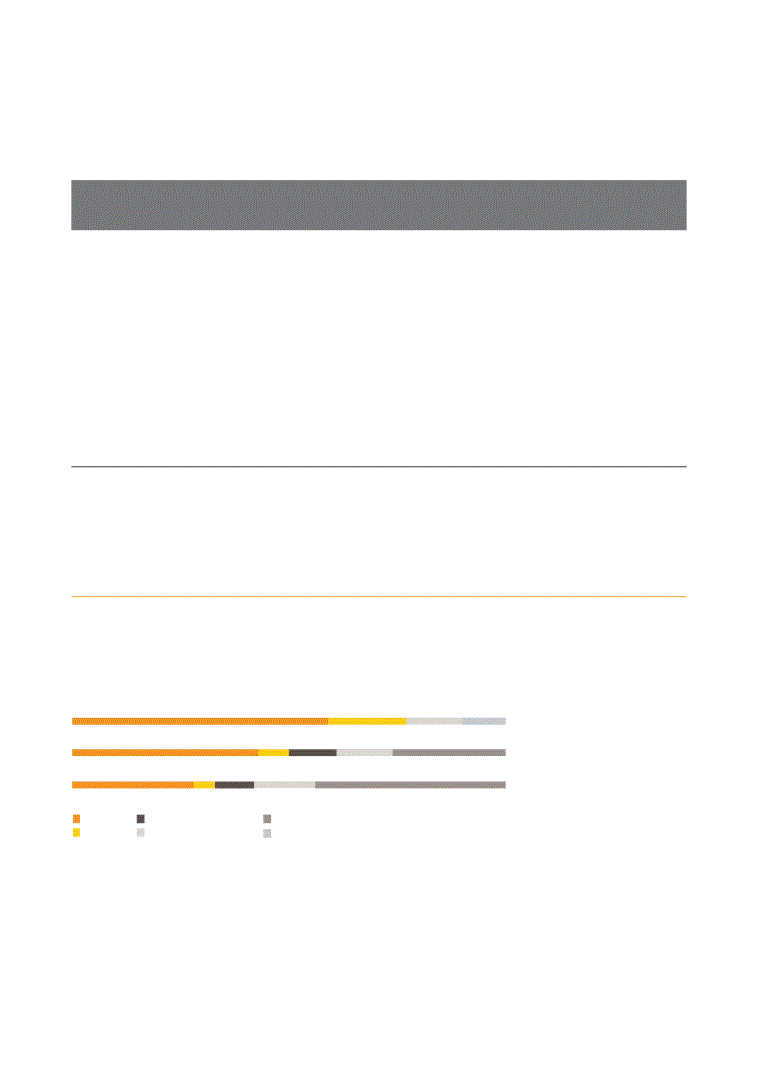
REMUNERATION AND PERFORMANCE continued
CEO, CFO (executive directors)
and Executive Committee
members
Managers
Non-managerial employees
Short-term incentives
The Bonus Share Plan (BSP)
is AngloGold Ashanti’s short-
term incentive initiative. It is
a measurement of company,
individual and business unit
performances and takes into
account financial and non-
financial metrics. The BSP is
awarded as a percentage of
pay and is delivered as a cash
bonus and deferred shares
which vest over a two-year
period (50% on the first
anniversary of the cash award
and 50% on the second).
Managers can receive either
the BSP – as described
for directors or executive
committee members (at
a lower percentage) – or
cash bonuses in the form of
production bonuses. These
production bonuses are
typically paid quarterly and
reflect safety and production
performance. Managers who
receive cash payments as
production bonuses will still
qualify for an award of deferred
shares under the BSP.
Non-managerial employees
receive production bonuses
that are linked to safety and
production at the sites and
are awarded accordingly
(either monthly or quarterly
depending on level). Non-
managerial employees in
corporate functions will receive
the cash element of the BSP.
No shares are awarded at this
level. There remain instances
where a limited number of
employees qualify for shares
on historic grounds.
Long-term incentives
The Long Term Incentive Plan
(LTIP) for AngloGold Ashanti is
designed for executives and
senior managers. It is a grant
of shares with a three-year
cliff vesting and is subject
to company performance
conditions.
Senior managers can
qualify for the LTIP – this
is determined by their job
grading (Stratum) level.
There is no LTIP for non-
managerial employees.
The graph below illustrates the remuneration mix of all Executive Committee members,
management and non-managerial employees.
Notes:
•
Executive management includes the CEO and CFO.
•
Non-manager mix is illustrated by an example of all Paterson C level and below employees in the South
Africa region.
Africa region.
•
Manager mix is an average of Paterson E band employees.
•
BSP deferred shares are at 150% of BSP cash bonus for executive management and 120% of BSP cash
bonus for managers.
bonus for managers.
•
LTIP shares are calculated on an estimated company performance achievement of 38.57% (average for
the last three years).
the last three years).
Average remuneration mix
(%) The percentages are with reference to the base salary
Base salary
Benefits
Cash bonus (BSP or production)
BSP shares
LTIP shares
Allowances
Non-managers
Managers
Executive management
31
22
17
16
25
30
60
16
32
48
156
INTEGRATED REPORT 2014
132

LINKING STRATEGY, PERFORMANCE AND REMUNERATION
The individual executive key performance indicators (KPIs) used to determine the individual
portion of short-term incentives are aligned with the company’s strategic focus areas through
the following deliverables:
1
Focus on people, safety and sustainability – Safety: Improve safety performance
and reduce fatalities; People: Develop and retain the people who are the business;
and Sustainability: ensure that the we retain our social licences to operate
2
Ensure financial flexibility – Being prudent and proactive in balance sheet
management by improving earnings, returns and free cash flow; ensuring liquidity
and headroom; and by mitigating refinancing risks
3
Optimise overhead, costs and capital expenditure – Reduce direct operating
costs, overheads and indirect spend and optimise annual total capital spend
4
Improve portfolio quality – A strong focus on selecting only key projects that add
value to the portfolio
5
Maintain long-term optionality, albeit at a reasonable cost – Ramp-up the greenfield
exploration programmes at selected international sites
These metrics are defined and further broken down into their specific elements of, for example,
safety and health, environment, communities, people, production and costs in the personal
KPIs for each executive, along with company targets under the BSP and LTIP. These company
remuneration metrics have been reviewed for 2015 and are detailed on page 38 in >AFS.
The individual performance metrics for executives will be cascaded through the business to
management and other staff who do not participate in production bonuses.
REMUNERATION IN 2014
In 2014, Venkat declared that, in an attempt to reduce the pay gap between the highest and the
lowest paid employees and to create stronger levels of trust with employees and stakeholders, he
would not take either a salary increase or an annual cash incentive bonus. In order to continue with this
sentiment and in recognition of the retrenchments that have taken place in AngloGold Ashanti during
2014, Venkat has again indicated that for 2015 he will not be accepting an annual salary increase.
Retention of the executive team at the time of transition from Mark Cutifani to Venkat was a key
concern. Retention bonuses in the form of cash and shares were awarded to key members of the
executive team at the time of Venkat’s appointment as CEO. These were realised with a payout
following on from the end of the 18-month retention period in August 2014. The company extended
the payout period for the CEO to March 2015.
Changes in the executive team in 2014 included the appointment of the new CFO, Christine
Ramon, in October. Christine’s pay was set at a level similar to that of her predecessor Richard
Duffy. The executive team was further optimised in number with the consolidation of the role of
the Executive Vice President: Corporate Affairs into another executive officer’s portfolio and the
departure of Yedwa Simelane.
The performance of the short-term incentive in the 2014 financial year was very positive owing to
successes achieved across our safety and sustainability disciplines, production growth, delivery of
new projects as well as the significant cost savings achieved.
Performance of the long-term incentive reflects the company’s performance over the past three years
and the impact of the gold price, which declined markedly in 2012, no additions to the Ore Reserve
and Mineral Resource, given the decline in price, lower share price and consequential impact on total
shareholder return. The overall result was that the payout for this incentive was below target for 2014
at 37.4% of the targets set in 2012.
ACCOUNTABILITY
“
Performance
of the short-term
incentive targets
was very positive
in 2014.”
incentive targets
was very positive
in 2014.”
133

REMUNERATION AND PERFORMANCE continued
REMUNERATION OF GLOBALLY MOBILE EMPLOYEES
In remote areas or where there is a high demand for skills that are not available locally,
AngloGold Ashanti deploys globally-mobile employees to fill roles on a short- to medium-
term basis. Included in the job description of these expatriate employees, is the development
of the required skills locally (localisation). Throughout 2014 there was a concerted effort to
reduce the number of these globally mobile employees through localisation, repatriation,
retrenchment and other initiatives.
Globally mobile employees are compensated in terms of AngloGold Ashanti’s expatriate
remuneration policy which provides for benefits such as housing, schooling, international
medical aid, international pension provisions, cost of living allowances and home leave trips.
Where provided, these benefits may be delivered in the form of an allowance, depending on
the location and the duration of the assignment.
COLLECTIVE BARGAINING AT ANGLOGOLD ASHANTI
During 2014, we continued to work with organised labour representatives to engage them
more meaningfully in dialogue on business issues. In particular, we have engaged with them
on the economics of our industry, the gold market and on the legal and statutory framework
regulating industrial relations in South Africa. All unions participate and are fully integrated into
all statutory labour and ad hoc committees. We have identified and secured agreement for a
core leadership team across all unions representing the workforce to undertake an entry-level
fundamental management programme at a South African university during 2015. The aim
of this initiative is to change the nature of the discourse with organised labour and to move
closer to a relationship where we can identify joint business and labour aspirations and chart a
pathway to achieving them. Formal recognition agreements are in place with AMCU, Solidarity
and UASA while long-standing procedural agreements are in place regarding the NUM.
Towards the middle of 2015, under the auspices of the Chamber of Mines, we in the gold
industry will begin biennial wage negotiations with our representative unions. The current
labour environment differs markedly from that of 2013, and these negotiations will take place
in an environment that has been influenced by a protracted five-month strike in the platinum
sector, ongoing inter-union rivalry and competition for dominance and members between the
NUM and AMCU.
In the Continental Africa region, union negotiations in Tanzania, Guinea and Mali during 2014
all continued normally with final wage agreements achieved in all locations. In Ghana, there
were a large number of negotiations around Obuasi, which are addressed in the restructuring
section below.
The Australasian and United States operations do not have collective bargaining agreements
in place. Argentina and Brazil both have unions and, as in the Continental Africa region,
successfully concluded wage negotiations in 2014.
“
In South Africa, we
have engaged with
the unions on the
economics of the
gold mining industry,
the gold market and
the industrial relations
statutory framework.”
the unions on the
economics of the
gold mining industry,
the gold market and
the industrial relations
statutory framework.”
INTEGRATED REPORT 2014
134

ACCOUNTABILITY
RESTRUCTURING OF MINING OPERATIONS IN 2014
While there were limited retrenchments in most areas across AngloGold Ashanti in 2014
as compared with 2013, a significant retrenchment process was undertaken at the Obuasi
operation in Ghana. In accordance with AngloGold Ashanti’s Amendment to the Programme
of Mining Operations submission to the Ministry of Lands and Natural Resources, which was
duly approved, agreement was entered into with the Ghana Mineworkers Union (GMWU)
and approved by the Ministry of Labour to retrench the entire workforce of 4,312 full-time
AngloGold Ashanti employees at a cost of $210m.
In addition to the agreements and approvals pertaining to the retrenchment and the payment
of severance benefits to employees before the end of the fourth quarter, agreements were
also entered into with the GMWU regarding the recruitment of some 650 fixed-term contract
employees to fulfil roles and activities of the 2015/6 limited operating phase. These agreements
provide for a fixed-term contract approach to employment, with salaries continuing to be
indexed to the US dollar and increasing in line with US inflation at year-end. Furthermore, the
organisational structure at Obuasi has been simplified. Unnecessary supervisory levels have
been removed and salary ranges have replaced the previously rigid, multi-leveled salary scales
and automatic annual service increments.
In the South Africa region, voluntary retrenchment was offered to employees at managerial and
official level. In all, 531 employees applied for voluntary separation which has left labour costs
below budget.
EMPLOYEE SHARE OWNERSHIP PLAN IN SOUTH AFRICA
The Bokamoso Employee Share Ownership Plan (ESOP) was launched in December 2006, in
partnership with the unions represented at the time: the NUM, Solidarity and UASA. The ESOP
was implemented to create an opportunity for AngloGold Ashanti and the unions to ensure
closer alignment of the interests of South African-based employees and the company, and the
seeking of shared growth solutions to build partnerships in areas of common interests.
Participation in the ESOP was restricted to those employees not eligible to participate in any
other AngloGold Ashanti share incentive plan. The ESOP came to an end in November 2014
when the last distribution was made to members. From the December 2006 launch date until
completion, a total of $42.97m* was paid to members of the ESOP. Of this $2.32m was paid
in dividends, $34.8m as a consequence of the vesting of free and loan shares and $5.85m was
due to the proceeds of a rights issue in 2008.
Currently, an extension to the Bokamoso ESOP is not being considered.
*
Converted at the average
annual exchange rate for
2014 of R10.83/$.
annual exchange rate for
2014 of R10.83/$.
135

AngloGold Ashanti’s annual reports for the 2014 financial year have
been approved and assured as follows:
been approved and assured as follows:
INTEGRATED REPORT 2014
The Integrated Report for the year ended 31 December 2014, which was recommended
by the Audit and Risk Committee for approval by the board, was approved by the board of
directors on 19 March 2015.
ANNUAL FINANCIAL STATEMENTS 2014
The Annual Financial Statements for the year ended 31 December 2014 were approved
by the board of directors on 19 March 2015. The financial statements have been prepared
by the corporate reporting staff of AngloGold Ashanti Limited, headed by John Edwin
Staples, the group’s Chief Accounting Officer. This process was supervised by Christine
Ramon, the group’s Chief Financial Officer, and Srinivasan Venkatakrishnan, the group’s
Chief Executive Officer.
In accordance with the Companies Act, No. 71 of 2008, as amended, the Annual Financial
Statements for AngloGold Ashanti Limited, for the year ended 31 December 2014, have
been audited by Ernst & Young Inc., the company’s independent external auditors, whose
unqualified audit report can be found in the Annual Financial Statements 2014.
MINERAL RESOURCE AND ORE RESERVE REPORT 2014
The Mineral Resource and Ore Reserve information as included in the Integrated Report was
approved by the board of directors on 19 March 2015.
The chairman of the Mineral Resource and Ore Reserve Steering Committee assumes
responsibility for the Mineral Resource and Ore Reserve Report 2014.
SUSTAINABLE DEVELOPMENT REPORT 2014
The Sustainable Development Report 2014 was approved by the board of directors on
19 March 2015. Independent combined reasonable and limited assurance of this report was
provided by Ernst & Young Inc.
APPROVALS AND ASSURANCES
INTEGRATED REPORT
2014
136
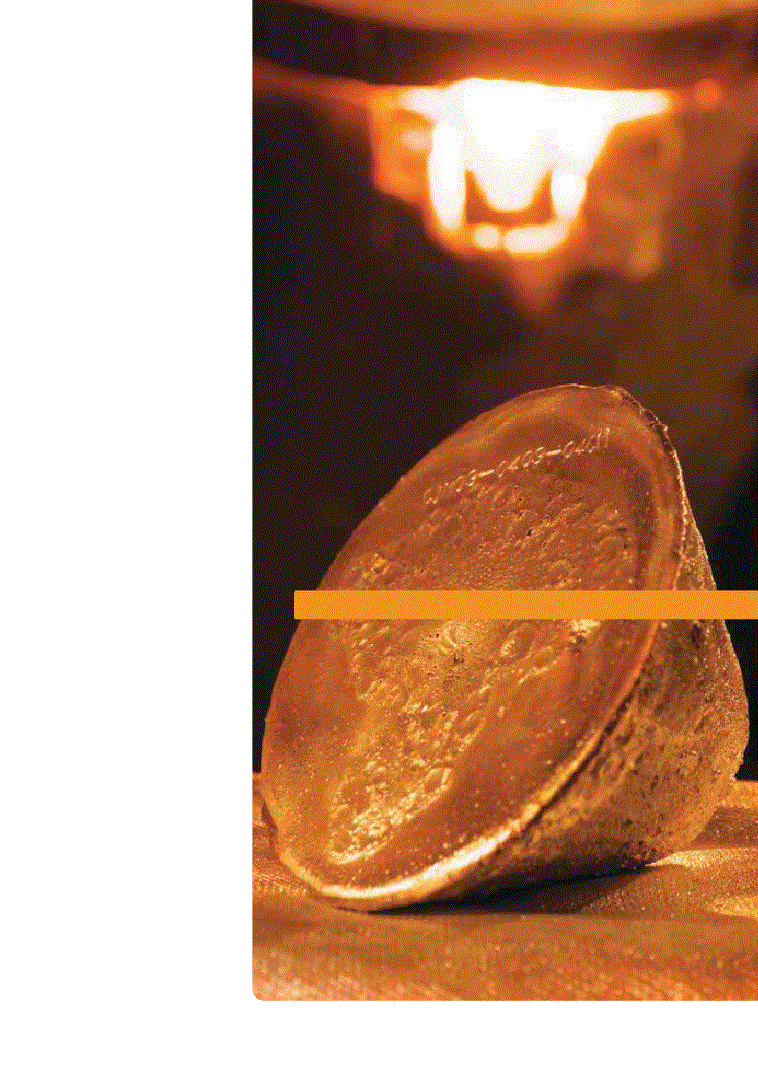
P137-145
138
Shareholder information
142
Glossary of terms and
abbreviations
abbreviations
144
Forward-looking statements
145
Administration
PROVIDING A
TRANSPARENT
PLATFORM OF
INFORMATION
TO ALL
STAKEHOLDERS
TRANSPARENT
PLATFORM OF
INFORMATION
TO ALL
STAKEHOLDERS
This section provides
useful information on
the terms used in this
report as well as details
of how to contact us
should you require further
information.
useful information on
the terms used in this
report as well as details
of how to contact us
should you require further
information.
SHAREHOLDER AND CORPORATE INFORMATION
137

COMPANY HISTORY – IN BRIEF
AngloGold Limited was founded in June 1998 with the consolidation of the gold mining
interests of Anglo American. The company, AngloGold Ashanti as it is now, was formed in
April 2004 following the business combination of AngloGold Limited (AngloGold) with Ashanti
Goldfields Company Limited (Ashanti).
STOCK EXCHANGE LISTINGS
AngloGold Ashanti is an independent gold producer with a diverse spread of shareholders
comprising the world’s largest financial institutions.
At the end of December 2014, AngloGold Ashanti had 404,010,360 ordinary shares in issue
and a market capitalisation of $3.51bn (2013: $4.73bn). As at 19 March 2015, the date of this
report, the market capitalisation was $3.80bn.
The primary listing of the company’s ordinary shares is on the JSE in South Africa. Its ordinary
shares are also listed on stock exchanges in New York (NYSE), in the form of American
Depositary Shares (ADSs), in Australia, in the form of Clearing House Electronic Sub-register
System (CHESS) Depositary Interests (CDIs) and in Ghana, in the form of Ghanaian Depositary
Shares (GhDSs).
In September 2014, the company delisted from the London Stock Exchange and terminated
the related depositary interest programme with effect from 15 October 2014. Any depositary
interests held on the company’s UK depositary interest register will be replaced with the
equivalent number of fully paid ordinary shares in the company and such holdings will be
entered onto the company’s Jersey register.
The Jersey register will remain open for approximately 12 months from the date of delisting.
Holders of ordinary shares on the Jersey register will be able to trade their shares on any of the
exchanges on which the company is listed until the date of closure of the Jersey register. The
most liquid exchanges for the company’s stock are the JSE and the NYSE.
SHAREHOLDER DIARY
Financial year end:
31 December
Suite of 2014 annual reports published:
31 March 2015
Annual general meeting:
6 May 2015
CHANGE OF DETAILS
Shareholders are reminded that the onus is on them to keep the company, through their nominated
share registrars, apprised of any change in their postal address and personal particulars. Similarly,
where shareholders receive dividend payments electronically (EFT), they should ensure that the
banking details which the share registrars and/or CSDPs have on file are correct.
ANNUAL REPORTS
The 2014 suite of annual reports is available on the corporate reporting website, www.aga-
reports.com.
SHAREHOLDER INFORMATION
AngloGold Ashanti Limited (Registration number 1944/017354/06) was
incorporated in the Republic of South Africa in 1944 and operates under
the South African Companies Act No. 71 of 2008, as amended, with a
primary listing on the JSE in South Africa.
incorporated in the Republic of South Africa in 1944 and operates under
the South African Companies Act No. 71 of 2008, as amended, with a
primary listing on the JSE in South Africa.
Geographic distribution of shareholders
as at 31 December 2014
•
United States
49
•
South Africa
25
•
United Kingdom
9
•
Rest of Europe
5
•
Singapore
2
•
Ghana
2
•
Australia
1
•
Rest of world
7
%
INTEGRATED REPORT
2014
138
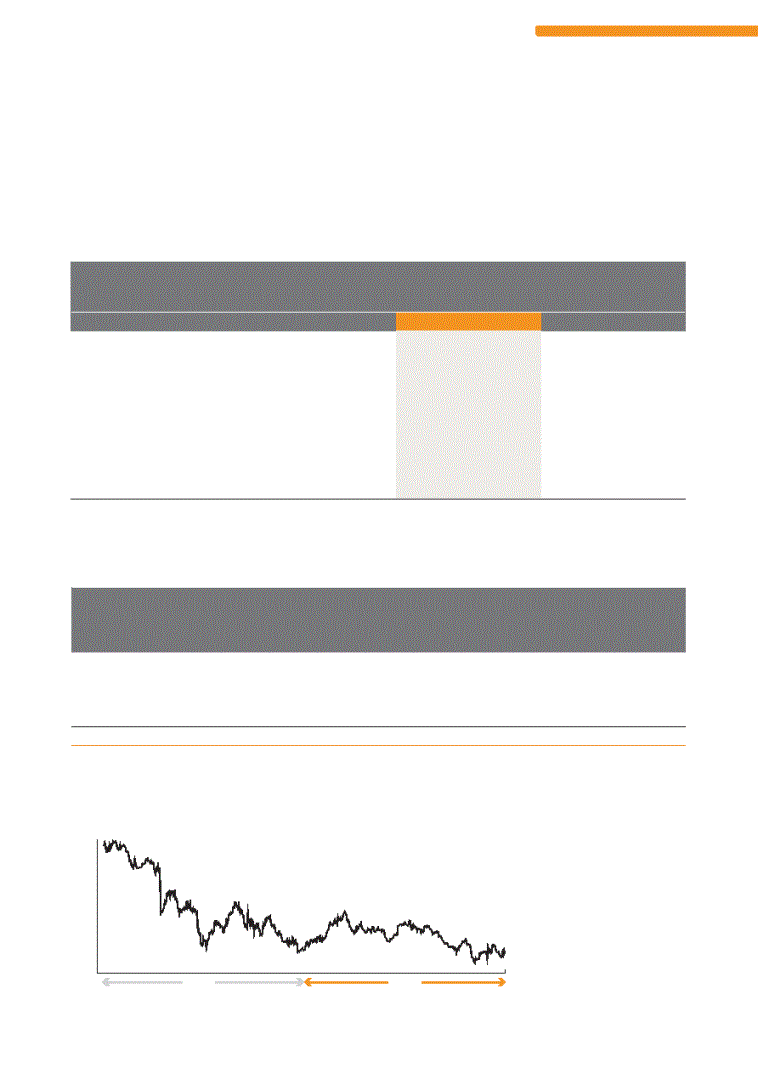
SHAREHOLDER AND CORPORATE INFORMATION
SHAREHOLDINGS
The top 10 shareholders together own 48.35% of the shares in issue. There are five shareholders with holdings exceeding 5% of the
total ordinary issued share capital. A comparison of the top 10 shareholders and their holdings is as follows:
As at 31 December 2014, the top 10 shareholders in AngloGold Ashanti were:
Number of
shares
held
% of total
shares in
issue
Number of
shares
held
% of total
shares in
issue
2014
2013
1
Public Investment Corp. of South Africa
31,854,515
7.88
30,166,288
7.48
2
First Eagle Investment Management LLC
31,746,875
7.86
32,782,600
8.13
3
Investec Asset Management Pty Limited (South Africa)
28,576,916
7.07
35,614,617
8.83
4
Paulson & Co., Inc.
26,205,400
6.49
31,413,135
7.79
5
Van Eck Global
24,759,780
6.13
21,842,177
5.42
6
Dimensional Fund Advisors, Inc.
13,465,261
3.33
9,386,030
2.33
7
The Vanguard Group, Inc.
11,611,514
2.87
10,686,432
2.65
8
BlackRock Fund Advisors
9,792,348
2.42
9,706,291
2.41
9
First State Investment Management (UK) Ltd
8,837,947
2.19
8,139,776
2.02
10
Deutsche Bank AG (Broker)
8,526,235
2.11
0
0
The Bank of New York Mellon holds 194,944,027 shares, being a holding of 48,25% (2013: 185,581,840 shares, a holding of
46,09%), through various custodians in respect of AngloGold Ashanti’s American Depositary Shares Programme on the NYSE.
2013
2014
1,700
1.550
1,400
1,250
1,100
Share price – NYSE ($/share)
(2013 and 2014)
PRICE MOVEMENTS AND STOCK EXCHANGE INFORMATION
Shareholder spread as at 31 December 2014:
Class of shareholder
Number of
ordinary
shares
held
% of total
shares in
issue
Number of
shareholders
% of
shareholders
Public shareholders
397,464,965
98.38
8,470
99.85
Non-public
Directors
171,745
0.04
12
0.14
Strategic holdings (Government of Ghana)
6,373,650
1.58
1
0.01
Total
404,010,360
100.0
8,483
100.00
139
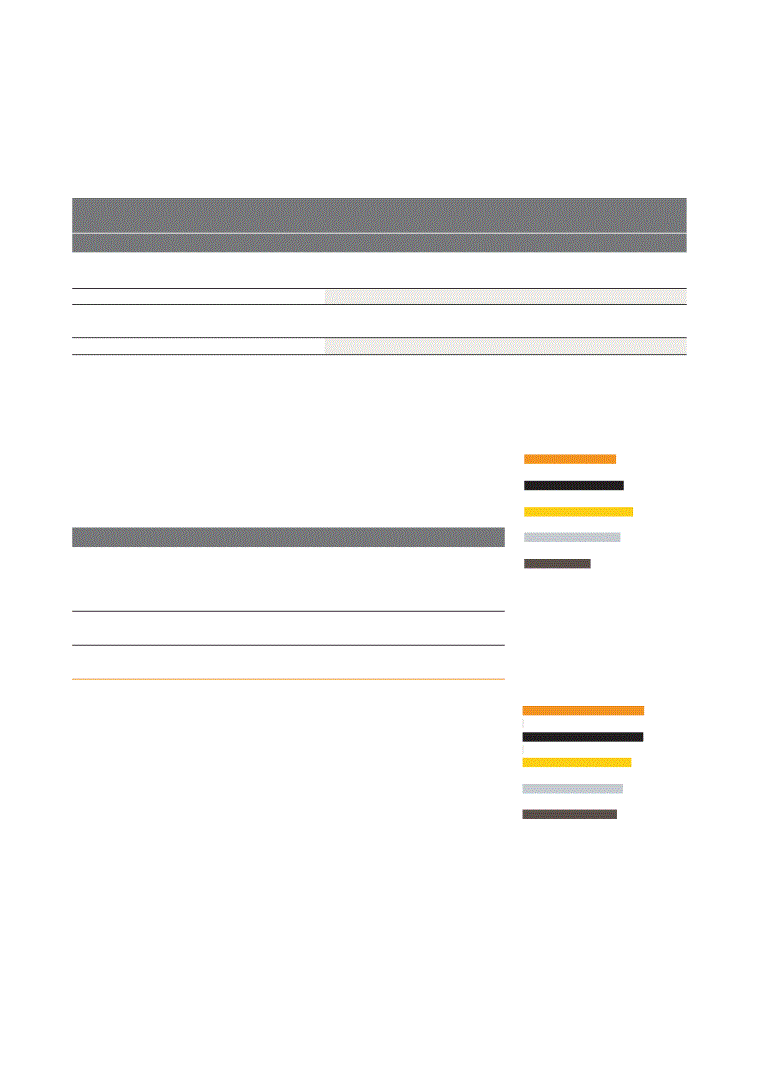
SHAREHOLDER INFORMATION
continued
BEE shareholding
In line with the Mining Charter’s requirement that, by the end of 2014, mining companies
should have achieved ownership of 26% by historically disadvantaged South Africans (HDSAs)
(also referred to as BEE ownership) in the attributable units of production of a company’s South
African assets.
In compliance, AngloGold Ashanti has enabled HDSA ownership of 26.8% of its South African
assets, broken down as follows:
Shareholding
Context
20.8%
ARMGold, this follows on the three transactions involving certain
Vaal Reefs shafts, an initial sale of Free State mines followed by
a second transaction involving the sale of AngloGold Ashanti’s
remaining Free State assets to an ARMGold
4.5%
The Bokamoso Employee Share Ownership Plan (ESOP)
1.5%
Izingwe Holdings (Pty) Limited (Izingwe)
The level of interest in the South African assets was determined by using the South African
proportion of AngloGold Ashanti’s total production at the time of the application for new order
mining rights. The transaction date for ARMGold was about May 2004, and for the Bokamoso
ESOP and Izingwe the date was December 2006. Both the Bokamoso ESOP and Izingwe
were issued E ordinary shares which could be converted into ordinary shares, upon meeting
certain terms and conditions. All the E ordinary shares have vested and were cancelled in
exchange for ordinary shares in accordance with the amended cancellation formula during the
2014 financial year. As at 31 December 2014, there were no E ordinary shares in issue.
Stock exchange data
High
Low
Average
Volume traded
Ave monthly
volume traded
(R or $/share)
(R or $/share)
(R or $/share)
(000)
(000)
JSE
2013
265.00
114.01
155.22
421,884
35,157
2014
209.52
88.36
152.27
280,288
23,357
NYSE
2013
31.88
11.14
15.07
799,353
66,613
2014
19.53
7.45
13.90
749,358
62,447
Source: Bloomberg
PIC
First Eagle
Investec
Paulson
Van Eck
Annual comparison of holdings of
five largest shareholders for 2013
five largest shareholders for 2013
(%)
7.48
8.13
8.83
7.79
5.42
PIC
First Eagle
Investec
Paulson
Van Eck
Annual comparison of holdings of
five largest shareholders for 2014
five largest shareholders for 2014
(%)
7.88
7.86
7.07
6.49
6.13
INTEGRATED REPORT 2014
140

SHAREHOLDER AND CORPORATE INFORMATION
DIVIDEND POLICY
Dividends are proposed by, and approved by the board of directors of AngloGold Ashanti,
based on the company’s financial performance. It is to be noted that no dividends have
been declared since the first quarter in 2013. AngloGold Ashanti expects to resume paying
dividends, although there can be no assurance that dividends will be paid in the future or as
to the particular amounts that will be paid from year to year. The payment of future dividends
will depend upon the board’s ongoing assessment of AngloGold Ashanti’s earnings, after
providing for long-term growth, cash/debt resources, compliance with the solvency and
liquidity requirements of the Companies Act the amount of reserves available for a dividend
based on the going-concern assessment, and restrictions (if any) placed by the conditions of
debt facilities, protection of the investment grade credit rating and other factors.
Withholding tax
On 1 April 2012, the South African government imposed a 15% withholding tax on dividends
and other distributions payable to shareholders.
ANNUAL GENERAL MEETING
Shareholders on the South African register who have dematerialised their shares in the
company (other than those shareholders whose shareholding is recorded in their own names in
the sub-register maintained by their CSDP) and who wish to attend the annual general meeting
to be held on 6 May 2015 in person, will need to request their CSDP or broker to provide them
with the necessary authority in terms of the custody agreement entered into between them
and the CSDP or broker.
Voting rights
The Companies Act provides that if voting is by a show of hands, any person present and
entitled to exercise voting rights has one vote, irrespective of the number of voting rights that
person would otherwise be entitled to. If voting is taken by way of poll, any shareholder who
is present at the meeting, whether in person or by duly appointed proxy, shall have one vote
for every share held.
There are no limitations on the right of non-South African shareholders to hold or exercise
voting rights attaching to any shares of the company. CDI holders are not entitled to vote in
person at meetings, but may vote by way of proxy.
Options granted in terms of the share incentive scheme do not carry rights to vote.
141

GLOSSARY OF TERMS AND ABBREVIATIONS
Adjusted gross profit (loss):
Gross profit (loss) excluding
unrealised non-hedge derivatives and other commodity contracts.
Adjusted headline earnings (loss):
Headline earnings
(loss) excluding unrealised non-hedge derivatives, fair value
adjustments on the mandatory convertible bonds and the
option component of the convertible bonds, adjustments to
other commodity contracts and deferred tax thereon.
All injury frequency rate:
The total number of injuries and
fatalities that occurs per million hours worked.
All-in costs:
All-in costs are all-in sustaining costs plus additional
non-sustaining costs which reflect the varying costs of producing
gold over the life-cycle of a mine. Non-sustaining costs are
those costs incurred at new operations and costs related to
‘major projects’ at existing operations where these projects will
materially increase production.
All-in costs in dollars per ounce is arrived at by dividing the
dollar value of the sum of these cost metrics by the ounces of
gold sold.
All-in sustaining costs:
During June 2013 the World Gold
Council (WGC), an industry body, published a Guidance Note
on “all-in sustaining costs” metric, which gold mining companies
can use to supplement their overall non-GAAP disclosure.
“All-in sustaining costs” is an extension of the existing “cash
cost” metric and incorporates all costs related to sustaining
production and in particular recognising the sustaining capital
expenditure associated with developing and maintaining gold
mines. In addition, this metric associated with developing and
maintaining gold mines. In addition, this metric includes the
cost associated with corporate office structures that support
these operations, the community and rehabilitation costs
attendant with responsible mining and any exploration and
evaluation costs associated with sustaining current operations.
All-in sustaining $/oz is arrived at by dividing the dollar value
of the sum of these cost metrics, by the ounces of gold sold.
By-products:
Any products that emanate from the core process
of producing gold, including silver, uranium and sulphuric acid.
Capital expenditure:
Total capital expenditure on tangible
and intangible assets which includes stay-in-business and
project capital.
Adjusted
EBITDA: Operating profit (loss) before amortisation
of tangible and intangible assets, retrenchment costs at the
operations, impairment and derecognition of goodwill, tangible
and intangible assets, impairment of investments, profit (loss)
on disposal and derecognition of assets and investments, gain
(loss) on unrealised non-hedge derivatives and other commodity
contracts, write-off of stockpile and heap leach inventories to
net realisable value plus the share of associates’ EBITDA, less
profit (loss) from discontinued operations.
The adjusted EBITDA calculation is based on the formula
included in the revolving credit agreements for compliance with
the debt covenant formula as specified in the revolving credit
agreements.
Effective tax rate:
Current and deferred taxation as a
percentage of profit before taxation.
Equity:
Total equity plus the mandatory convertible bonds.
Where average equity is referred to, this is calculated by
averaging the figures at the beginning and the end of the
financial year.
Gain (loss) on non-hedge derivatives and other commodity
contracts:
Fair value changes on derivatives that are neither
designated as meeting the normal sale exemption under IAS 39, nor
designated as cash flow hedges and other commodity contracts.
Gold produced:
Refined gold in a saleable form derived from
the mining process.
Net debt:
Borrowings (excluding the Turbine Square Two
(Proprietary) Limited lease and the mandatory convertible
bonds; adjusted for the unamortised portion of the convertible
and rated bonds; and the fair value adjustment on the $1.25bn
bond) less cash.
Net capital employed:
Total equity adjusted for other
comprehensive income, actuarial gain (loss) and deferred
taxation plus interest-bearing borrowings, less cash and cash
equivalents and adjusted for capital expenditure incurred
on assets not yet in production. Where average net capital
employed is referred to, this is the average of the figures at the
beginning and the end of the financial year.
Net operating assets:
Tangible assets, current and non-
current portion of inventories, current and non-current trade
and other receivables (excluding recoverable tax, rebates,
levies and duties), less current and non-current trade, other
payables and deferred income (excluding unearned premiums
on normal sale extended contracts).
Operating cash flow:
Net cash inflow from operating activities
less stay-in-business capital expenditure.
Productivity:
An expression of labour productivity based on
the ratio of ounces of gold produced per month to the total
number of employees in mining operations.
Project capital:
Capital expenditure to either bring a new
operation into production; to materially increase production
capacity; or to materially extend the productive life of an asset.
INTEGRATED REPORT
2014
142

SHAREHOLDER AND CORPORATE INFORMATION
Region:
Defines the operational management divisions within
AngloGold Ashanti Limited, namely South Africa, Continental
Africa (Democratic Republic of the Congo, Ghana, Guinea, Mali,
Namibia and Tanzania), Australasia (Australia and surrounding
areas), and the Americas (Argentina, Brazil and United States
of America).
Rehabilitation:
The process of reclaiming land disturbed by
mining to allow an appropriate post-mining use. Rehabilitation
standards are defined by country-specific laws, including but not
limited to the South African Department of Mineral Resources,
the US Bureau of Land Management, the US Forest Service, and
the relevant Australian mining authorities, and address among
other issues, ground and surface water, topsoil, final slope
gradient, waste handling and re-vegetation issues.
Return on equity:
Adjusted headline earnings before finance
costs on the mandatory convertible bonds and hedge buy-
back costs expressed as a percentage of average equity.
Stay-in-business capital:
Capital expenditure to extend useful
lives of existing production assets. This includes replacement
of vehicles, plant and machinery, Ore Reserve development,
deferred stripping and capital expenditure related to financial
benefit initiatives, safety, health and the environment.
Stripping ratio:
The ratio of waste tonnes to ore tonnes mined
calculated as total tonnes mined less ore tonnes mined divided
by ore tonnes mined.
Sustaining capital:
Total capital expenditure less any capital
expenditure that relates to project capital expenditure and new
investment/projects at all of our mines, whether they are in
production or development stage.
Total cash costs:
Total cash costs include site costs for all
mining, processing and administration, reduced by contributions
from by-products and are inclusive of royalties and production
taxes. Amortisation, rehabilitation, corporate administration,
retrenchment, capital and exploration costs are excluded.
Total cash costs per ounce are the attributable total cash costs
divided by the attributable ounces of gold produced.
Total employee
costed:
This takes account of all employees
and contractors directly employed in and associated with the
production process.
Weighted average number of ordinary shares:
The number
of ordinary shares in issue at the beginning of the year, increased
by shares issued during the year, weighted on a time basis for
the period during which they have participated in the income
of the group, and increased by share options that are virtually
certain to be exercised.
$
United States dollars
A$ or AUD
Australian dollars
ADS
American Depositary Share
ADR
American Depositary Receipt
AIFR
All injury frequency rate
AiSC
All-in sustaining costs
AMCU
Association of Mineworkers and Construction Union
ARS
Argentinean peso
ASM
Artisanal and small-scale mining
ASX
Australian Securities Exchange
Au
Contained gold
BEE
Black economic empowerment
BRL
Brazilian real
bn
Billion
CDI
CHESS Depositary Interests
CHESS
Clearing House Electronic Settlement System
DMTNP
Domestic medium-term notes programme
GhDS
Ghanaian Depositary Share
GhSE
Ghana Stock Exchange
IASB
International Accounting Standards Board
IFRS
International Financial Reporting Standards
JSE
JSE Limited
King Code
King Report on Governance for South Africa
2009 (King III)
LSE
London Stock Exchange
M or m
Metre or million, depending on the context
Moz
Million ounces
MPRDA
Mineral and Petroleum Resources Development Act
NUM
National Union of Mineworkers
NYSE
New York Stock Exchange
OLD
Occupational lung disease
oz
Ounces (troy)
R, ZAR or
Rand
South African rands
SEC
United States Securities and Exchange
Commission
Companies
Act
The South African Companies Act, No. 71 of
2008, as amended
t
Tons (short) or tonnes (metric)
TEC
Total employee costed
TSX
Toronto Stock Exchange
UASA
United Association of South Africa
US/USA/
United
States
United States of America
143

ADMINISTRATION
FORWARD-LOOKING
STATEMENTS
STATEMENTS
ANGLOGOLD ASHANTI LIMITED
Registration No. 1944/017354/06
Incorporated in the Republic of South Africa
Share codes:
ISIN:
ZAE000043485
JSE:
ANG
NYSE:
AU
ASX:
AGG
GhSE (Shares):
AGA
GhSE (GhDS):
AAD
JSE Sponsor:
Deutsche Securities (SA) Proprietary Limited
Auditors:
Ernst & Young Inc.
Offices:
Registered and Corporate
76 Jeppe Street, Newtown 2001, South Africa
(PO Box 62117, Marshalltown 2107, South Africa)
Telephone:
+27 11 637 6000
Fax:
+27 11 637 6624
Australia
Level 13,
St Martins Tower
44 St George’s Terrace
Perth, WA 6000
(PO Box Z5046, Perth WA 6831)
Australia
Telephone:
+61 8 9425 4600
Fax:
+61 8 9425 4650
Ghana
Gold House
Patrice Lumumba Road
(PO Box 2665)
Accra
Ghana
Telephone:
+233 303 772190
Fax:
+233 303 778155
United Kingdom Secretaries
(As AngloGold Ashanti delisted from the LSE on 22 September 2014,
this information is provided for administration purposes only until
September 2015.)
St James’s Corporate Services Limited
Suite 31, Second floor, 107 Cheapside
London EC2V 6DN
England
Telephone:
+44 20 7796 8644
Fax:
+44 20 7796 8645
E-mail:
Certain statements contained in this document, other than statements
of historical fact, including, without limitation, those concerning
the economic outlook for the gold mining industry, expectations
regarding gold prices, production, cash costs, all-in sustaining
costs, all-in costs, cost savings and other operating results, return
on equity, productivity improvements, growth prospects and outlook
of AngloGold Ashanti’s operations, individually or in the aggregate,
including the achievement of project milestones, commencement
and completion of commercial operations of certain of AngloGold
Ashanti’s exploration and production projects and the completion
of acquisitions, dispositions or joint venture transactions, AngloGold
Ashanti’s liquidity and capital resources and capital expenditures and
the outcome and consequence of any potential or pending litigation or
regulatory proceedings or environmental health and safety issues, are
forward-looking statements regarding AngloGold Ashanti’s operations,
economic performance and financial condition. These forward-
looking statements or forecasts involve known and unknown risks,
uncertainties and other factors that may cause AngloGold Ashanti’s
actual results, performance or achievements to differ materially from
the anticipated results, performance or achievements expressed or
implied in these forward-looking statements. Although AngloGold
Ashanti believes that the expectations reflected in such forward-looking
statements and forecasts are reasonable, no assurance can be given
that such expectations will prove to have been correct. Accordingly,
results could differ materially from those set out in the forward-looking
statements as a result of, among other factors, changes in economic,
social and political and market conditions, the success of business and
operating initiatives, changes in the regulatory environment and other
government actions, including environmental approvals, fluctuations
in gold prices and exchange rates, the outcome of pending or future
litigation proceedings, and business and operational risk management.
For a discussion of such risk factors, refer to AngloGold Ashanti’s
annual reports on Form 20-F which was filed with the United States
Securities and Exchange Commission. These factors are not necessarily
all of the important factors that could cause AngloGold Ashanti’s actual
results to differ materially from those expressed in any forward-looking
statements. Other unknown or unpredictable factors could also have
material adverse effects on future results. Consequently, readers are
cautioned not to place undue reliance on forward-looking statements.
AngloGold Ashanti undertakes no obligation to update publicly or release
any revisions to these forward-looking statements to reflect events
or circumstances after the date hereof or to reflect the occurrence of
unanticipated events, except to the extent required by applicable law.
All subsequent written or oral forward-looking statements attributable to
AngloGold Ashanti or any person acting on its behalf are qualified by the
cautionary statements herein.
This communication may contain certain “Non-GAAP” financial
measures. AngloGold Ashanti utilises certain Non-GAAP performance
measures and ratios in managing its business. Non-GAAP financial
measures should be viewed in addition to, and not as an alternative
for, the reported operating results or cash flow from operations or any
other measures of performance prepared in accordance with IFRS. In
addition, the presentation of these measures may not be comparable
to similarly titled measures other companies may use. AngloGold
Ashanti posts information that is important to investors on the main
page of its website at www.anglogoldashanti.com and under the
“Investors” tab on the main page. This information is updated regularly.
Investors should visit this website to obtain important information
about AngloGold Ashanti.
INTEGRATED REPORT
2014
144

SHAREHOLDER AND CORPORATE INFORMATION
SHARE REGISTRARS
South Africa
Computershare Investor Services (Pty) Limited
Ground Floor, 70 Marshall Street
Johannesburg 2001
(PO Box 61051, Marshalltown 2107)
South Africa
Telephone:
Ground Floor, 70 Marshall Street
Johannesburg 2001
(PO Box 61051, Marshalltown 2107)
South Africa
Telephone:
0861 100 950 (in SA)
Fax:
+27 11 688 5218
Website:
[email protected]
Australia
Computershare Investor Services Pty Limited
Level 2, 45 St George’s Terrace
Perth, WA 6000
(GPO Box D182 Perth, WA 6840)
Australia
Telephone:
Level 2, 45 St George’s Terrace
Perth, WA 6000
(GPO Box D182 Perth, WA 6840)
Australia
Telephone:
+61 8 9323 2000
Telephone:
1300 55 2949 (in Australia)
Fax:
+61 8 9323 2033
Ghana
NTHC Limited
Martco House
Off Kwame Nkrumah Avenue
PO Box K1A 9563 Airport
Accra
Ghana
Telephone:
Martco House
Off Kwame Nkrumah Avenue
PO Box K1A 9563 Airport
Accra
Ghana
Telephone:
+233 302 229664
Fax:
+233 302 229975
ADR Depositary
BNY Mellon (BoNY)
BNY Shareowner Services
PO Box 358016
Pittsburgh, PA 15252-8016
United States of America
Telephone:
BNY Shareowner Services
PO Box 358016
Pittsburgh, PA 15252-8016
United States of America
Telephone:
+1 800 522 6645 (Toll free in USA) or
+1 201 680 6578 (outside USA)
+1 201 680 6578 (outside USA)
E-mail:
Website:
www.bnymellon.com.com\shareowner
Global BuyDIRECTSM
BoNY maintains a direct share purchase and dividend reinvestment
plan for AngloGold Ashanti.
Telephone:
plan for AngloGold Ashanti.
Telephone:
+1-888-BNY-ADRS
United Kingdom
(As AngloGold Ashanti delisted from the London Stock Exchange on
22 September 2014, this information is provided for administration
purposes only until September 2015.)
22 September 2014, this information is provided for administration
purposes only until September 2015.)
Shares
Computershare Investor Services (Jersey) Ltd
Queensway House
Hilgrove Street
St Helier
Jersey JE1 1ES
Telephone:
Queensway House
Hilgrove Street
St Helier
Jersey JE1 1ES
Telephone:
+44 (0) 870 889 3177
Fax:
+44 (0) 870 873 5851
Depository Interests
Computershare Investor Services PLC
The Pavilions
Bridgwater Road
Bristol BS99 6ZY
England
Telephone:
The Pavilions
Bridgwater Road
Bristol BS99 6ZY
England
Telephone:
+44 (0) 870 702 0000
Fax:
+44 (0) 870 703 6119
DIRECTORS
Executive
S Venkatakrishnan (Chief Executive Officer)
§*
KC Ramon (Chief Financial Officer)
^
Non-executive
SM Pityana (Chairman)
^
Prof LW Nkuhlu
(Deputy Chairman/Lead Independent Director)
(Deputy Chairman/Lead Independent Director)
^
A Garner
#
R Gasant
^
DL Hodgson
^
NP January-Bardill
^
MJ Kirkwood
*
M Richter
#
RJ Ruston
~
*
British
§ Indian
# American
~ Australian
^ South African
Officers
Executive Vice President – Legal, Commercial and
Governance and Company Secretary
ME Sanz Perez
Governance and Company Secretary
ME Sanz Perez
Investor relations contacts:
Stewart Bailey
Telephone:
Telephone:
+27 11 637 6031
Mobile:
+27 81 032 2563
E-Mail:
Fundisa Mgidi
Telephone:
Telephone:
+27 11 637 6763
Mobile:
+27 82 821 5322
E-mail:
Sabrina Brockman
Telephone:
Telephone:
+1 212 858 7702
Mobile:
+1 646 379 2555
E-mail:
General e-mail enquiries:
AngloGold Ashanti website:
www.anglogoldashanti.com
Company secretarial e-mail:
AngloGold Ashanti posts information that is important to investors
on the main page of its website at www.anglogoldashanti.com
and under the “Investors” tab on the main page. This information
is updated regularly. Investors should visit this website to obtain
important information about AngloGold Ashanti.
on the main page of its website at www.anglogoldashanti.com
and under the “Investors” tab on the main page. This information
is updated regularly. Investors should visit this website to obtain
important information about AngloGold Ashanti.
145

WWW.ANGLOGOLDASHANTI.COM
A TRULY
GLOBAL
PRODUCER OF GOLD

SIGNATURES
Pursuant to the requirements of the Securities Exchange Act of 1934, the registrant has duly
caused this report to be signed on its behalf by the undersigned, thereunto duly authorized.
caused this report to be signed on its behalf by the undersigned, thereunto duly authorized.
AngloGold Ashanti Limited
Date: March 31, 2015
By:
/s/ M E SANZ PEREZ
Name:
M E Sanz Perez
Title: Group General Counsel and Company
Title: Group General Counsel and Company
Serious News for Serious Traders! Try StreetInsider.com Premium Free!
You May Also Be Interested In
- AngloGold Ashanti Files Its 2023 Annual Report on Form 20-F and Amended Half-Year 2023 Form 6-K With the SEC
- Aterian Sets Date for First Quarter 2024 Earnings Announcement & Investor Conference Call
- ENDEAVOR ALERT: Bragar Eagel & Squire, P.C. Investigates Merger of EDR and Encourages Investors to Contact the Firm
Create E-mail Alert Related Categories
SEC FilingsSign up for StreetInsider Free!
Receive full access to all new and archived articles, unlimited portfolio tracking, e-mail alerts, custom newswires and RSS feeds - and more!




 Tweet
Tweet Share
Share